ExoMars (Exobiology on Mars - 2016 Mission)
Non-EO
ESA
ROSKOSMOS
Exploration
Quick facts
Overview
| Mission type | Non-EO |
| Agency | ESA, ROSKOSMOS |
| Launch date | 14 Mar 2016 |
ExoMars (Exobiology on Mars - 2016 Mission)
Spacecraft Launch Mission Status Sensor Complement Arriving At Mars References
Background
Establishing whether life ever existed, or is still active on Mars today, is one of the outstanding scientific questions of our time. The ExoMars Program seeks to timely address this and other important scientific goals, and to demonstrate key flight and in situ enabling technologies underpinning European and Russian ambitions for future exploration missions. The ExoMars Program is a cooperative undertaking between ESA (European Space Agency) and the Russian federal space agency, Roscosmos. 1)
Within ESA, ExoMars is an element of the Aurora Exploration Program, an optional program executed under the supervision of the Program Board for Human Spaceflight, Microgravity and Exploration (PBHME). However, the ESA Science Program also participates to ExoMars. The objective of the Aurora Program is to explore Solar System objects having a high potential for the emergence of life. Aurora aims to develop technologies and address scientific questions in a step-wise fashion, seeking to advance the level of technical and scientific readiness with each successive mission.
Within Roscosmos, ExoMars is part of the Russian federal space program and is supported by RAS (Russian Academy of Sciences).
To prepare for future exploration missions and to support the Program’s scientific objectives, ExoMars will achieve the following technology objectives:
• EDL (Entry, Descent, and Landing) of a payload on the surface of Mars
• Surface mobility with a Rover
• Access to the subsurface to acquire samples
• Sample acquisition, preparation, distribution, and analysis.
In addition to these technology objectives already agreed in the Aurora Declaration, the following new technology objectives result from the cooperation with Roscosmos:
• Qualification of Russian ground-based means for deep-space communications in cooperation with ESA’s ESTRACK
• Adaptation of Russian on-board computer for deep space missions and ExoMars landed operations
• Development and qualification of throttleable braking engines for prospective planetary landing missions.
The scientific objectives of ExoMars are:
• To search for signs of past and present life on Mars
• To investigate the water/geochemical environment as a function of depth in the shallow subsurface
• To study martian atmospheric trace gases and their sources.
In addition to these science objectives already agreed in the Aurora Declaration, the following new scientific objective results from the cooperation with Roscosmos:
• To characterise the surface environment.
The ExoMars Program consists of two missions, in 2016 and 2018. ESA and Roscosmos have agreed a well-balanced sharing of responsibilities for the various mission elements. 2)
Second ExoMars Mission Moves to Next Launch Opportunity in 2020 3)
The second ExoMars mission involves a Russian-led surface platform and a European-led rover, also to be launched on a Proton from Baikonur. Russian and European experts made their best efforts to meet the 2018 launch schedule for the mission, and in late 2015, a dedicated ESA-Roscosmos Tiger Team, also including Russian and European industries, initiated an analysis of all possible solutions to recover schedule delays and accommodate schedule contingencies.
The Tiger Team presented its final report during a meeting of the Joint ExoMars Steering Board (JESB) held in Moscow. Having assessed the possible ways to ensure successful mission implementation, the JESB concluded that, taking into account the delays in European and Russian industrial activities and deliveries of the scientific payload, a launch in 2020 would be the best solution.
ESA Director General Johann-Dietrich Woerner and Roscosmos Director General Igor Komarov discussed the ExoMars 2018 situation. After considering the Tiger Team report and the JESB recommendations, they jointly decided to move the launch to the next available Mars launch window in July 2020, and tasked their project teams to develop, in cooperation with the industrial contactors, a new baseline schedule aiming towards a 2020 launch. Additional measures will also be taken to maintain close control over the activities on both sides up to launch.
The successful implementation of both ExoMars missions will allow Russia and Europe to jointly validate cutting-edge technologies for Mars entry, descent, and landing, for the control of surface assets, to develop new engineering concepts and service systems that can be used by other Solar System exploration missions, and to carry out novel science at Mars.
The ExoMars 2016 mission will be launched on a Roscosmos-provided Proton rocket. It includes the TGO (Trace Gas Orbiter) and the EDM (Entry, descent and landing Demonstrator Module), both contributed by ESA. The TGO will carry European and Russian scientific instruments for remote observations, while the EDM will have a European payload for in situ measurements during descent and on the martian surface.
In November 2013, ESA named the EDM Schiaparelli in honor the 19th century Italian astronomer Giovanni Schiaparelli (1835-1910). He observed bright and dark straight-line surface features on Mars which he called ‘canali’. This term was mistakenly translated into English as ‘canal’ instead of ‘channel’, conjuring up images of vast irrigation networks constructed by intelligent beings living on Mars. The controversy ended in the early 20th century, thanks to better telescopes offering a clearer view of the planet. — The name was suggested by a group of Italian scientists to the president of the Italian space agency, ASI, who then proposed it to ESA. Italy is the largest European contributor to the ExoMars program. 4)
The ExoMars 2018 mission will land a Rover, provided by ESA, making use of a DM (Descent Module) contributed by Roscosmos. The DM will travel to Mars on an ESA-provided CM (Carrier Module). Roscosmos will launch the spacecraft composite on a Proton rocket. The Rover will be equipped with a European and Russian suite of instruments, and with Russian RHUs (Radioisotope Heating Units). The Rover will also include a 2 m drill for subsurface sampling and a SPDS (Sample Preparation and Distribution System), supporting the suite of geology and life seeking experiments in the Rover’s ALD (Analytical Laboratory Drawer). The Russian SP (Surface Platform) will contain a further suite of instruments, mainly concentrating on environmental and geophysical investigations. 5)
NASA will also deliver important elements to ExoMars: The Electra UHF (Ultra-High Frequency) radio package on TGO for Mars surface proximity link communications with landed assets (such as the Rover and Surface Platform); engineering support to EDM; and a major part of MOMA (Mars Organic Molecule Analyzer), the organic molecule characterization instrument on the Rover.
Overview of Some Mars Parameters 6)
Diameter: 6794 km (about half the diameter of Earth)
Surface area: 145 million km2 (about the same as the land area of Earth)
Gravity: 3.711 m s-2 (about one third of Earth’s gravity)
Density: 3.93 g cm-3 (Earth: 5.51 g cm-3)
Average distance from the Sun: 227,940,000 km (1.52 times that of Earth)
Martian day (a ‘sol’): 24 hours 37 minutes
Martian year: 669 sols or 687 Earth days
Average temperature: –55ºC (from –133ºC at the winter pole to +27ºC during summer)
Atmosphere: 95.32% carbon dioxide, 2.7% nitrogen, 1.6% argon, 0.13% oxygen
Atmospheric pressure at the surface: 6.35 mbar (less than one hundredth of Earth’s atmospheric pressure)
Moons: Phobos: 27 x 22 x 18 km; ~6000 km from the surface; Deimos: 15 x 12 x 11 km; ~20,000 km from the surface
Spacecraft
The ExoMars mission is the first ESA-led robotic mission of the Aurora Program and combines technology development with investigations of major scientific interest. The main objectives of this mission are to search for evidence of methane and other trace atmospheric gases that could be signatures of active biological or geological processes and to test key technologies in preparation for ESA's contribution to subsequent missions to Mars. 7)
The ExoMars 2016 mission spacecraft includes the following elements, all developed under the leadership of the prime contractor TAS-I (Thales Alenia Space-Italia). 8)
• TGO (Trace Gas Orbiter), developed by Thales Alenia Space, France
• EDM, developed directly by TAS-I
• MSA (Main Separation Assembly), developed by RUAG.
The TGO accommodates scientific instrumentation for the detection of atmospheric trace gases and the study of their temporal and spatial evolution. In addition, it will provide telecommunications support for the 2016 mission, for the 2018 mission and possible other assets until 2022.
Objectives of the ExoMars 2016 Mission
1) Validate landing on the planet Mars with a demonstration capsule weighing about 600 kg, using a control system based on a radar altimeter, and with a carbon fiber shock absorber to attenuate the hard contact with the surface.
2) Gather as much information as possible during entry into the Martian atmosphere.
3) Carry out scientific sampling on the surface for a short period.
4) Observe the Martian atmosphere and surface for two years from the orbiter at an altitude of 400 km.
5) Provide the telecommunication support needed by the rover for the 2018 mission.
The EDM is mainly conceived to demonstrate EDL (Entry Descent and Landing) technologies for future planetary exploration missions. The following technologies are foreseen to be demonstrated:
• TPS (Thermal Protection System)
• PAS (Supersonic Parachute System)
• Radar technologies for ground relative altitude and velocity measurements
• Propulsion technologies for attitude control and braked landing
• Crushable material for impact load attenuation.
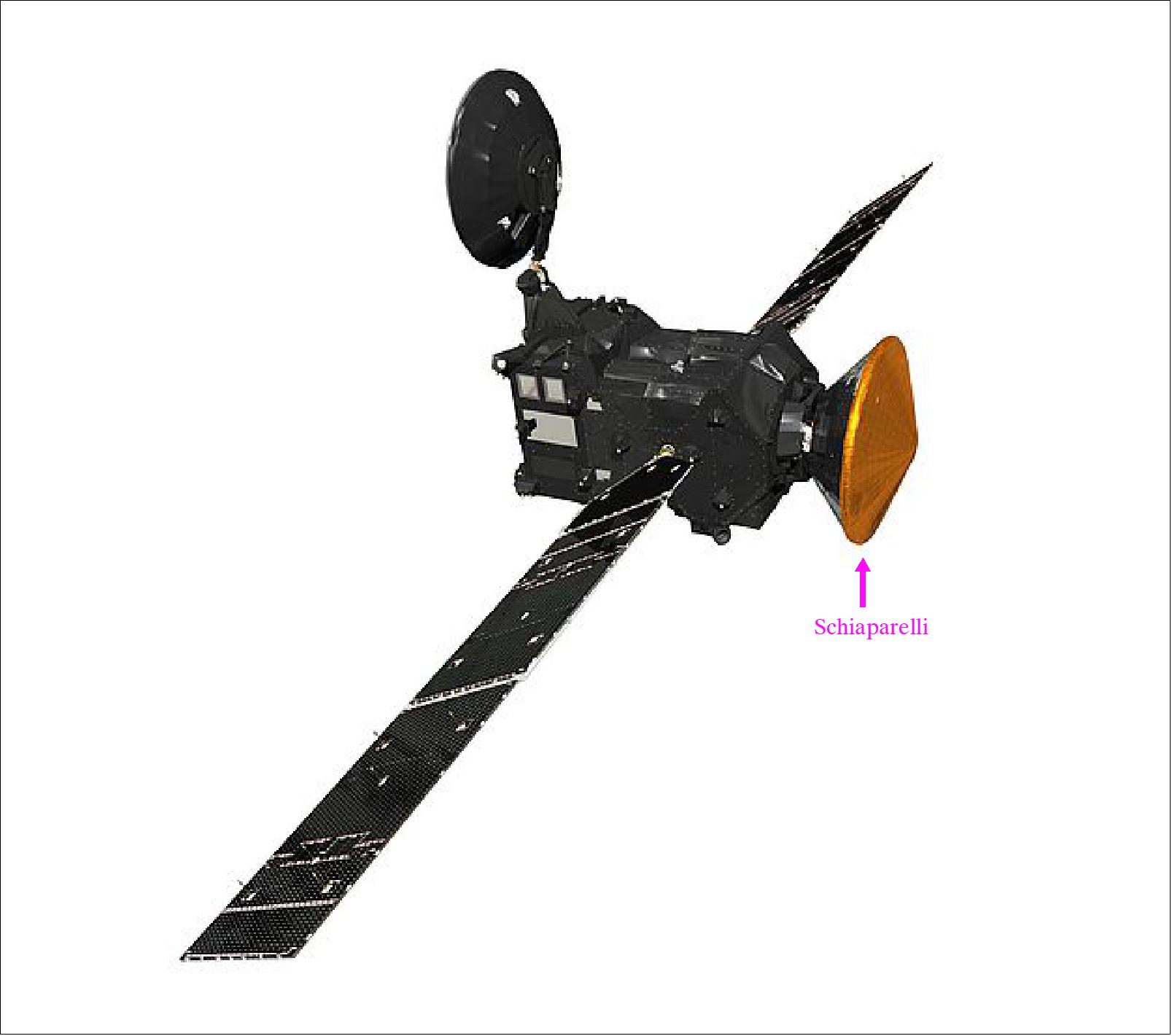
TGO (Trace Gas Orbiter)
The technical team behind the ExoMars spacecraft involves companies across more than 20 countries. The prime contractor, Thales Alenia Space Italia, is leading the industrial team building the spacecraft (Ref. 6). As a part of the European industrial team, OHB System AG was responsible for developing the core module of the TGO, which comprises the structure as well as the thermal and propulsion system for the 2016 mission. OHB as member of the core industrial team, is responsible for the major German contribution to ExoMars.
Spacecraft | 3.2 m x 2 m x 2 m with solar wings (20 m2) spanning 17.5 m tip-to-tip providing approximately 2000 W of power |
Launch mass | 4332 kg (including 112 kg of science payload and 600 kg Schiaparelli) |
Propulsion | Bipropellant, with a 424 N main engine for Mars orbit insertion and major maneuvers |
Power | In addition to power generated by the solar wings, 2 lithium-ion batteries will be used to cover eclipses, with ~ 5100 Wh total capacity |
Communication | 65 W X-band system with 2.2 m diameter high-gain antenna and 3 low-gain antennas for communication with Earth; Electra UHF-band transceivers (provided by NASA) with a single helix antenna for communication with surface rovers and landers |
Science instrument package | ACS (Atmospheric Chemistry Suite); CaSSIS (Color and Stereo Surface Imaging System); FREND (Fine Resolution Epithermal Neutron Detector); NOMAD (Nadir and Occultation for Mars Discovery) |
Nominal mission end | 2022 |
NASA's participation in the 2016 ExoMars Trace Gas Orbiter includes two "Electra" telecommunication radios. Used successfully on NASA's Mars Reconnaissance Orbiter, Electra acts as a communications relay and navigation aid for Mars spacecraft. Electra's UHF radios support navigation, command, and data-return needs. 9)
TGO's Electra radios use a design from NASA/JPL with special features for relaying data from a rover or stationary lander to an orbiter passing overhead. Relay of information from Mars-surface craft to Mars orbiters, then from Mars orbit to Earth, enables receiving much more data from the surface missions than would otherwise be possible.
As an example of Electra capabilities, during a relay session between an Electra on the surface and one on an orbiter, the radios can maximize data volume by actively adjusting the data rate to be slower when the orbiter is near the horizon from the surface robot's perspective, faster when it is overhead.
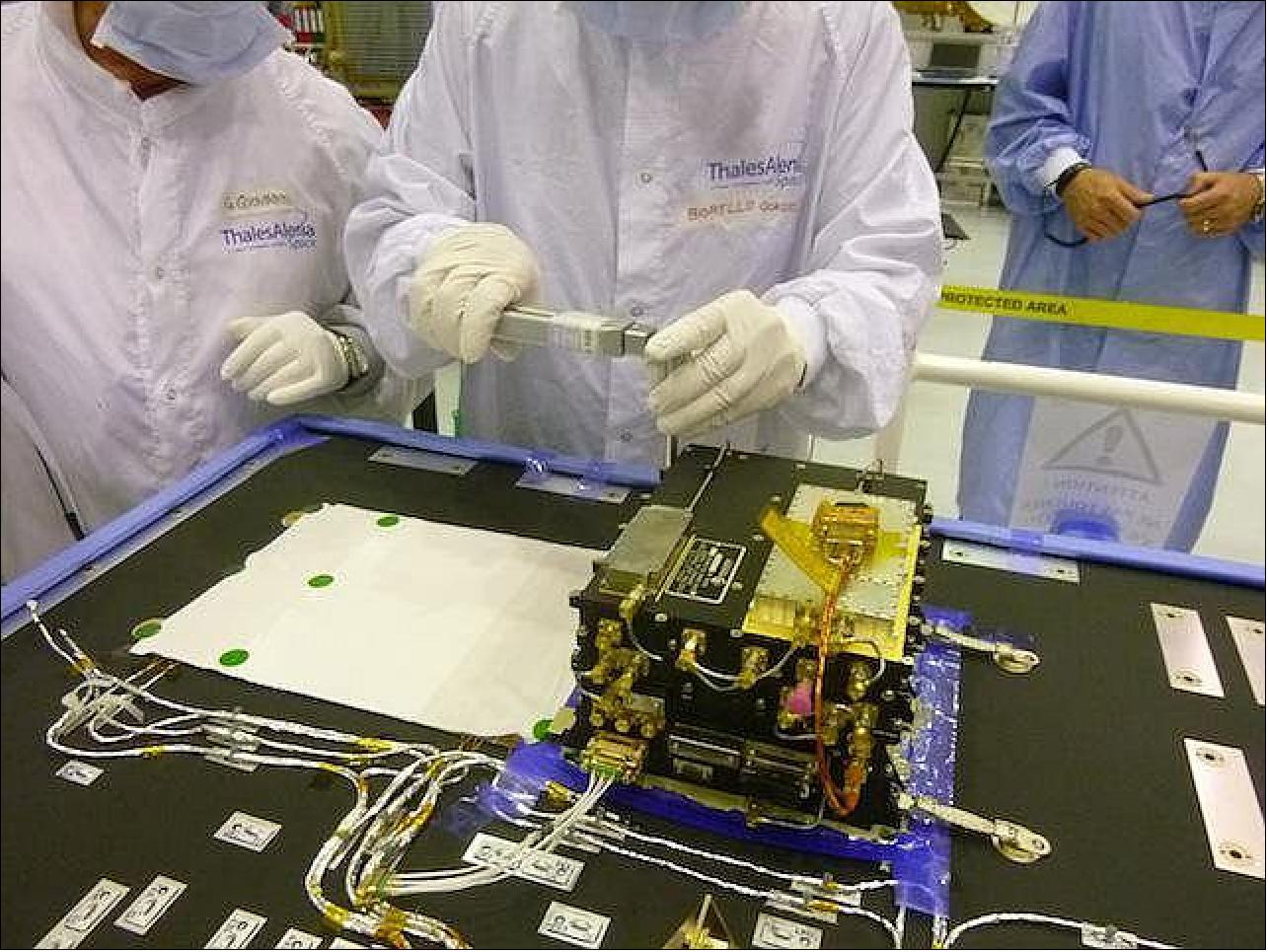
RCS (Reaction Control System): TGO requires a challenging propulsion subsystem. The TGO RCS will provide the thrust to the spacecraft for all initial trajectory corrections, DSMs (Deep Space Maneuvers) during the cruise phase to Mars and also the high thrust necessary for the final MOI (Mars Orbit Insertion) maneuver. Subsequently, it shall perform 3-axis attitude control of the TGO once in orbit around Mars for the remainder of its seven year lifetime. 11)
The selected RCS is a helium-pressurized bi-propellant propulsion system utilizing MMH (Monomethylhydrazine) as the fuel and mixed oxides of nitrogen (MON-1) as the oxidizer. The architecture is derived from previous flight proven European applications, however the detailed layout is unique and driven by the specific configuration of the TGO spacecraft and the redundancy needs of the ExoMars 2016 mission.
All RCS architecture and engineering activities have been performed by OHB-System (including all subsystem analyses), while Airbus Defence and Space has responsibility for the mechanical configuration, procurement and manufacturing of equipment, integration and acceptance test to ensure that the system requirements defined by TAS-F are satisfied. The subsystem test program has been defined by OHB-System and performed by Airbus DS at the Airbus DS, OHB-System and TAS facilities. Out of the 92 components comprising the flight RCS, 67 are manufactured by Airbus DS including all tanks and thrusters.
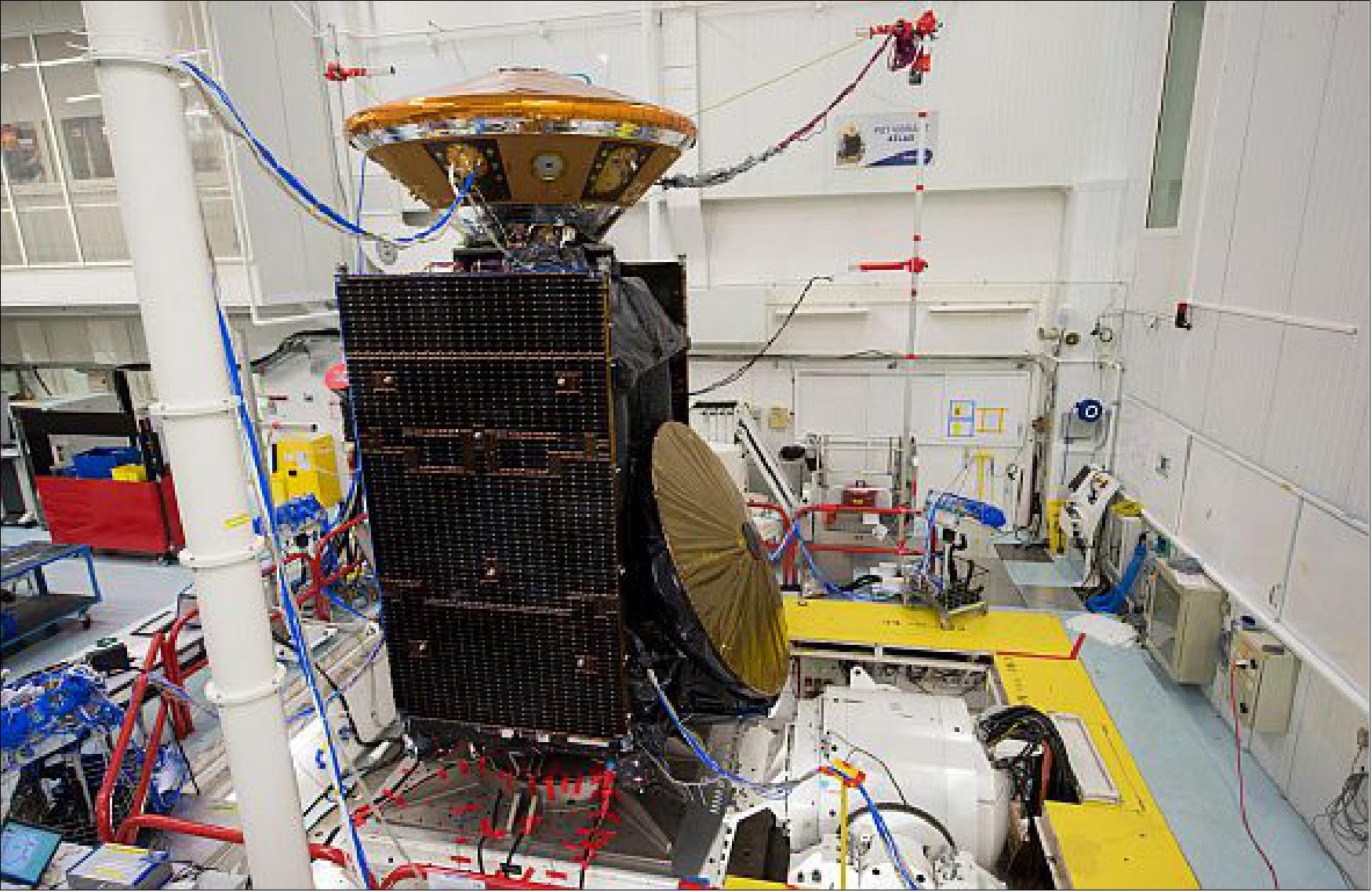
Schiaparelli / EDM (Entry, Descent and Landing Demonstrator Module)
Landing on Mars: Despite a number of prominent US successes since the 1970s, landing on Mars remains a significant challenge. As part of the ExoMars program, a range of technologies has been developed to enable a controlled landing. These include a special material for thermal protection, a parachute system, a radar altimeter system, and a final braking system controlled by liquid-propellant retrorockets. Schiaparelli is designed to test and demonstrate these technologies, in preparation for future missions (Ref. 6).
Three days before reaching Mars, Schiaparelli will separate from TGO and coast towards the planet in hibernation mode, to reduce its power consumption. It will be activated a few hours before entering the atmosphere at an altitude of 122.5 km and at a speed of 21 000 km/h. An aerodynamic heatshield will slow the lander down such that at an altitude of about 11 km, when the parachute is deployed, it will be travelling at around 1650 km/h.
Schiaparelli will release its front heat shield at an altitude of about 7 km and turn on its radar altimeter, which can measure the distance to the ground and its velocity across the surface. This information is used to activate and command the liquid propulsion system once the rear heatshield and parachute has been jettisoned 1.3 km above the surface. At this point, Schiaparelli will still be travelling at nearly 270 km/h, but the engines will slow it to less than 2 km/h by the time it is 2 m above the surface. At that moment, the engines will be switched off and Schiaparelli will freefall to the ground, where the final impact, at just under 11 km/h, will be cushioned by a crushable structure on the base of the lander.
Although Schiaparelli will target the plain known as Meridiani Planum in a controlled landing, it is not guided, and the module has no obstacle-avoidance capability. It has, however, been designed to cope with landing on a terrain with rocks as tall as 40 cm and slopes as steep as 12.5º.
Because Schiaparelli is primarily demonstrating technologies needed for landing, it does not have a long scientific mission lifetime: it is intended to survive on the surface for just a few days by using the excess energy capacity of its batteries. However, a set of scientific sensors will analyse the local environment during descent and after landing, including performing the first measurements of atmospheric particle charging effects, to help understand how global dust storms get started on Mars. A communication link with TGO will provide realtime transmission of the most important operational data measured by Schiaparelli during its descent. Shortly after Schiaparelli lands, TGO will start a main engine burn and will return over the landing site only four sols later. In the meantime, the remainder of the entry, descent and landing data, along with some of the science instrument data, will be sent to Earth via ESA’s Mars Express and NASA satellites already at Mars.
Schiaparelli Design
Schiaparelli builds on a heritage of designs that have been evaluated and tested by ESA during earlier ExoMars studies. The module accommodates a series of sensors that will monitor the behaviour of all key technologies during the mission. These technologies include a special material for thermal protection, a parachute system, a radar Doppler altimeter system, and a braking system controlled by liquid propulsion. The data will be sent back to Earth for post-flight reconstruction in support of future European missions to Mars.
Diameter | 2.4 m in diameter with heatshield, 1.65 m without heatshield |
Mass | 600 kg |
Heat shield material | Norcoat Liege |
Structure | Aluminum sandwich with CFRP (Carbon Fiber Reinforced Polymer) skins |
Parachute | Disk-Gap-Band canopy, 12 m diameter |
Propulsion | 3 clusters of 3 hydrazine engines (400 N each), operated in pulse-modulation |
Power | Batteries |
Communication | UHF link with the ExoMars Orbiter (with 2 antennas) |
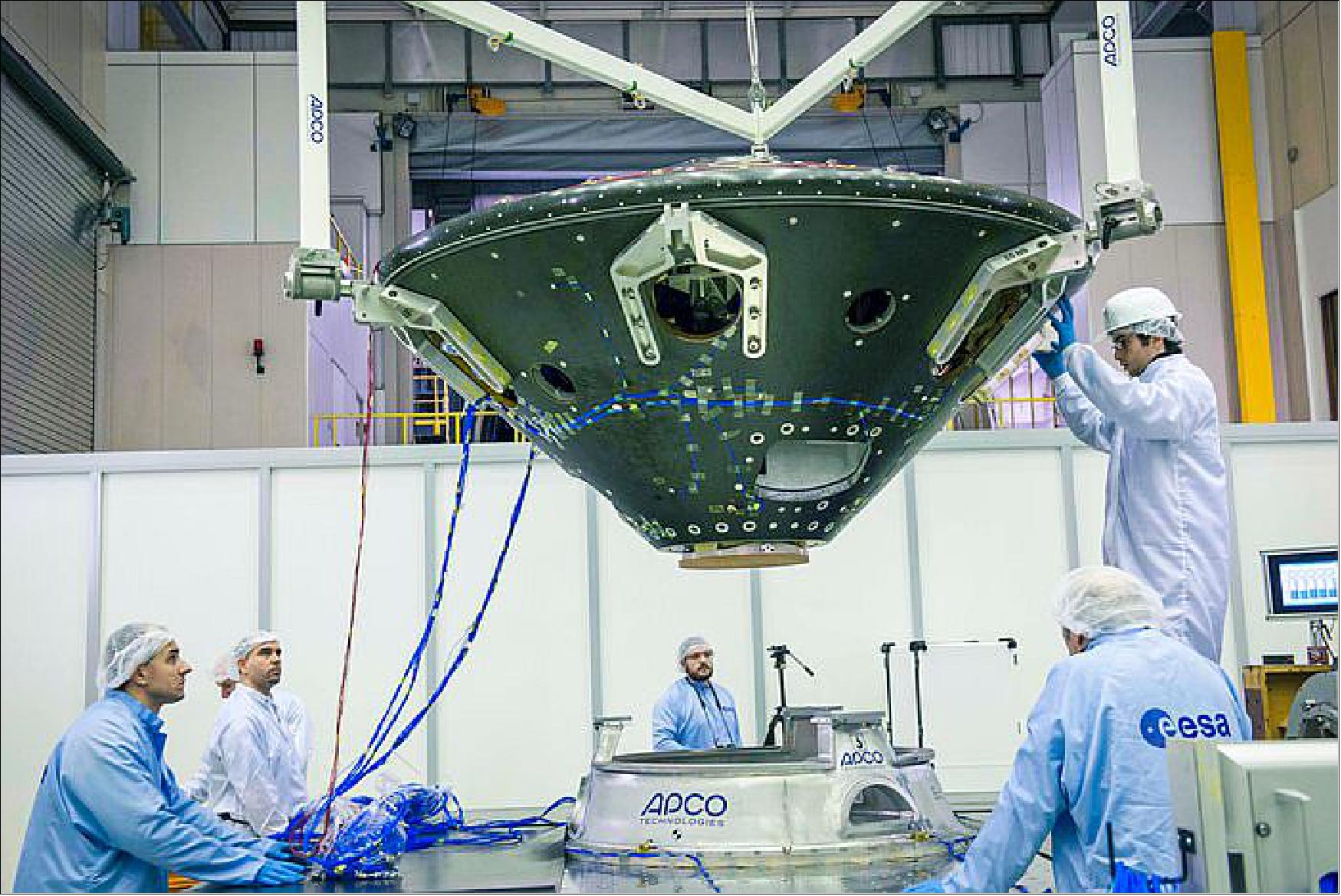
Launch Preparations
In late December 2015, the ExoMars 2016 Trace Gas Orbiter and Schiaparelli (the entry, descent and landing demonstrator module) travelled aboard two Antonov 124 cargo jets from Turin, Italy, to the Baikonur Cosmodrome in Kazakhstan to be readied for launch in March. 12)
Since then, engineering teams, totaling about 65 people, from Thales Alenia Space (Italy and France), the ExoMars project team, instrument teams, and specialists from the Baikonur Cosmodrome have been steadily working through an intensive and painstaking program of final testing and preparation of the two spacecraft, which at 4.300 kg will be the heaviest spacecraft composite ever to be sent to Mars.
All this has to be completed in time for a launch scheduled for 14 March at the beginning of the 12-day launch window for this mission.
Central to the launch campaign activities is the cleanroom. Almost everything in the cleanroom has been transported from Europe for this launch campaign – hence the need for a third Antonov flight. In addition to the specialist lifting equipment and the ground support trolleys needed to move the two spacecraft, the teams have also had to prepare a dedicated ISO 7 environment cleanroom tent, within the "normal" ISO 8 cleanroom environment, for handling Schiaparelli which, being a Mars lander, must be regularly sampled to check that it satisfies the planetary protection regulations. For analysis of these samples a dedicated microbiological laboratory was brought from Turin and installed close to the cleanroom area.
The readying of the TGO (Trace Gas Orbiter) has included a series of system health checks, such as checking that signals could be sent to all spacecraft units and that they responded. The health of the payload – the four science instruments, ACS, CaSSIS, FREND and NOMAD – was checked in a similar manner by verifying that commands could be sent to them and that these commands were carried out. The flight model of FREND was swapped for the flight spare model.
Another important test that has been completed was with the Trace Gas Orbiter and the launch vehicle adapter. Mechanical fit checks and separation tests had already been done in Cannes last year. Here in Baikonur, the team checked the mechanical connections, and also verified that all electrical circuits were completed.
In parallel, Schiaparelli is also being prepared for launch and is subject to tests similar to those performed on the orbiter. The instruments, sensors (DREAMS and COMARS+) and systems have all been thoroughly checked. A leak test has been carried out. Engineers have uploaded the final software and charged the batteries - since Schiaparelli has no solar panels the fully charged batteries are essential for the surface operations. 13)
The mating of the TGO (Trace Gas Orbiter) and Schiaparelli began on 12 February, 2016 with the two spacecraft having been transferred into the fuelling area, where a mounting platform surrounding the orbiter facilitates the activities that need to be done about 4 m off the ground.
TGO and Schiaparelli are mechanically linked with the MSA (Main Separation Assembly), which attaches to TGO with 27 screws. The MSA holds onto Schiaparelli with three separation mechanisms comprising compressed and angled springs that are held by NEAs (Non-Explosive Actuators). When the NEAs are released on 16 October, as the spacecraft approaches Mars, Schiaparelli will be gently pushed away from TGO, at the same time being imparted with a rotation that will serve to stabilize its atmospheric entry.
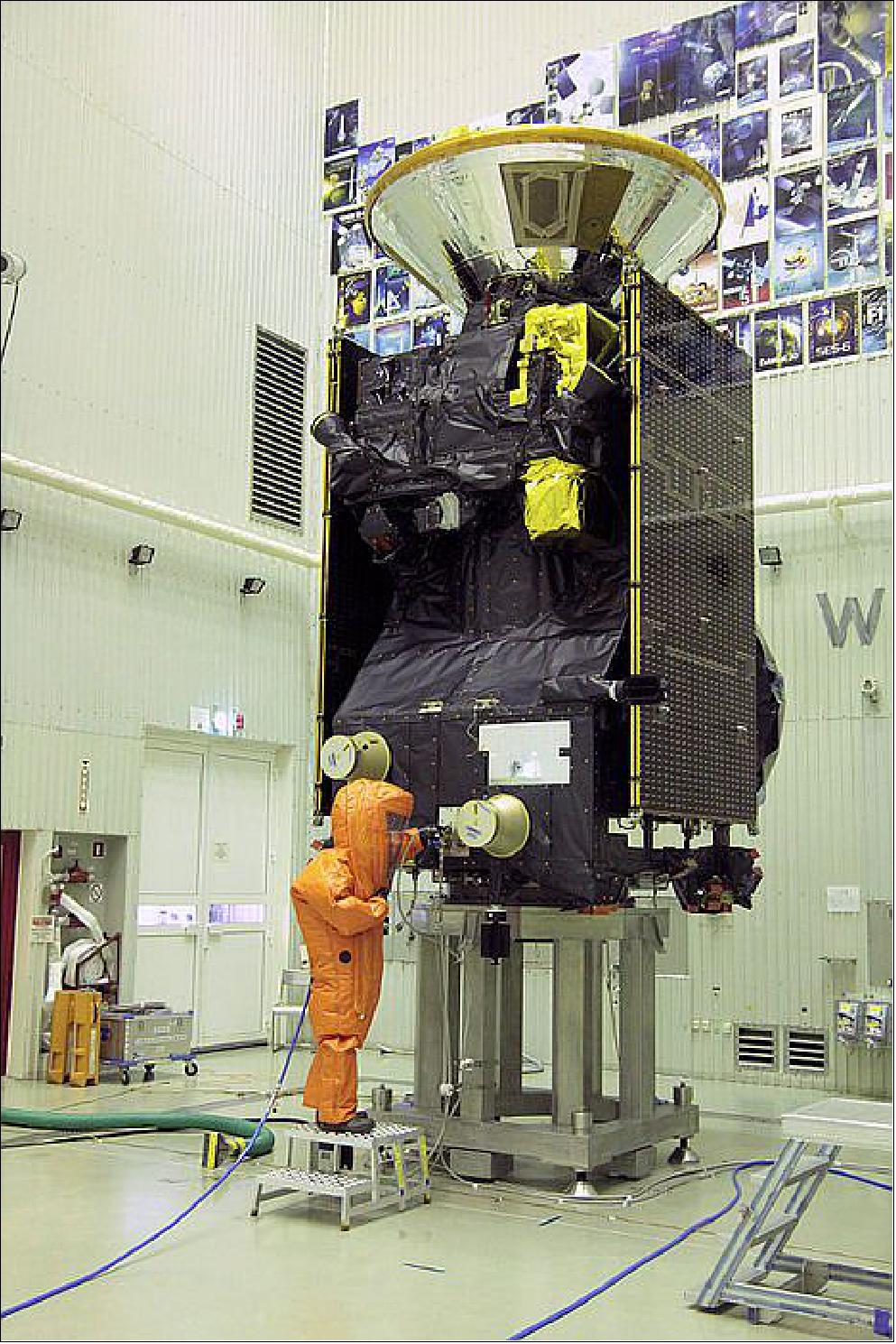
Legend to Figure 5: This spacecraft has one fuel tank and one oxidizer tank, each with a capacity of 1207 liter. When fuelling is complete, the tanks will contain about 1.5 ton of MON (mixed oxides of nitrogen) and 1 ton of MMH (monomethylhydrazine). The propellant is needed for the main engine and the 10 thrusters (plus 10 backup thrusters) that are used for fine targeting and critical maneuvers.
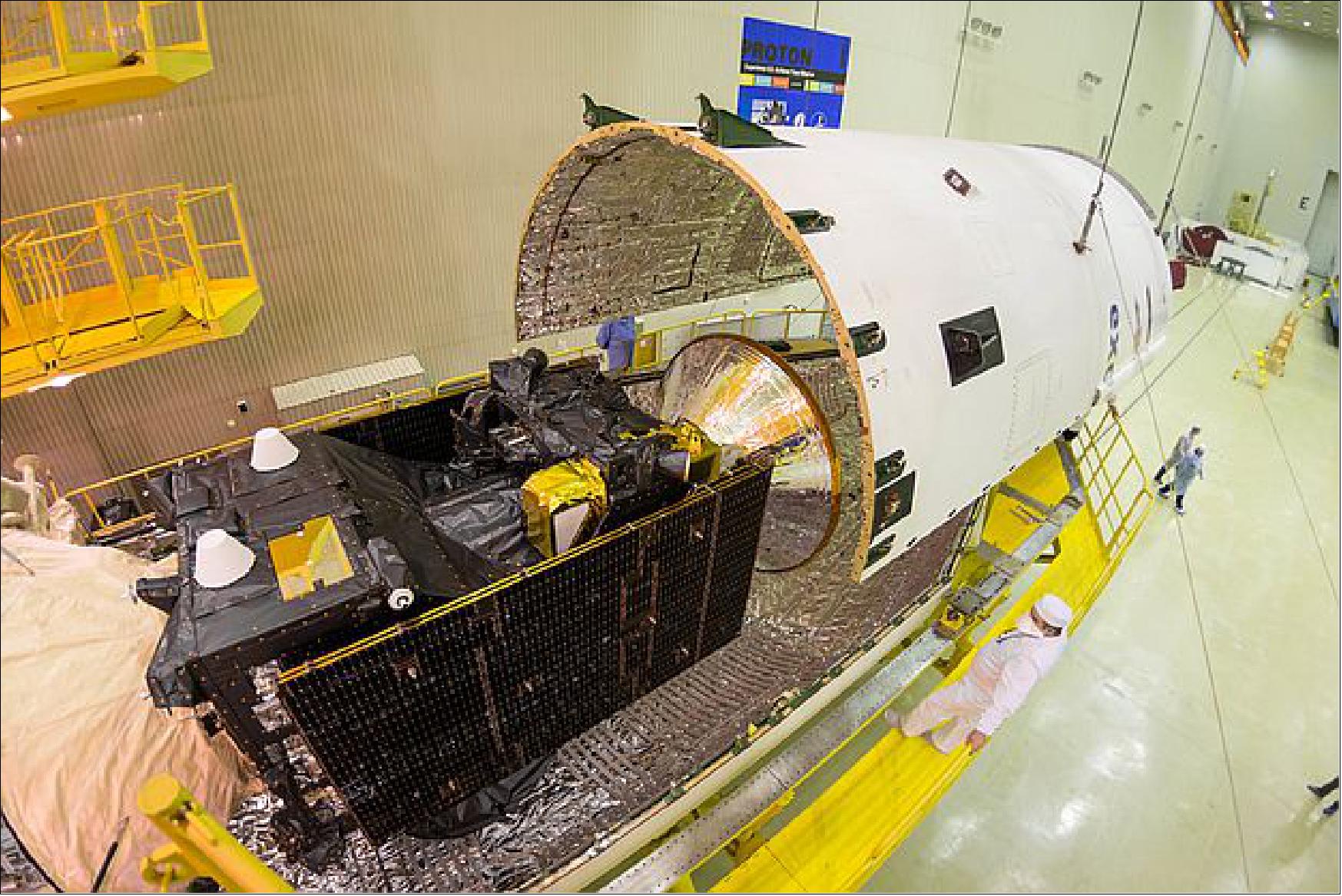
Legend to Figure 6: On March 2, 2016, the Breeze upper stage and spacecraft were encapsulated together within the two fairing halves. Prior to the encapsulation, they were tilted horizontally and the first fairing half was rolled underneath the spacecraft and Breeze, on a track inside the cleanroom. The second fairing half was then lowered into place by means of an overhead crane, encapsulating the payload.
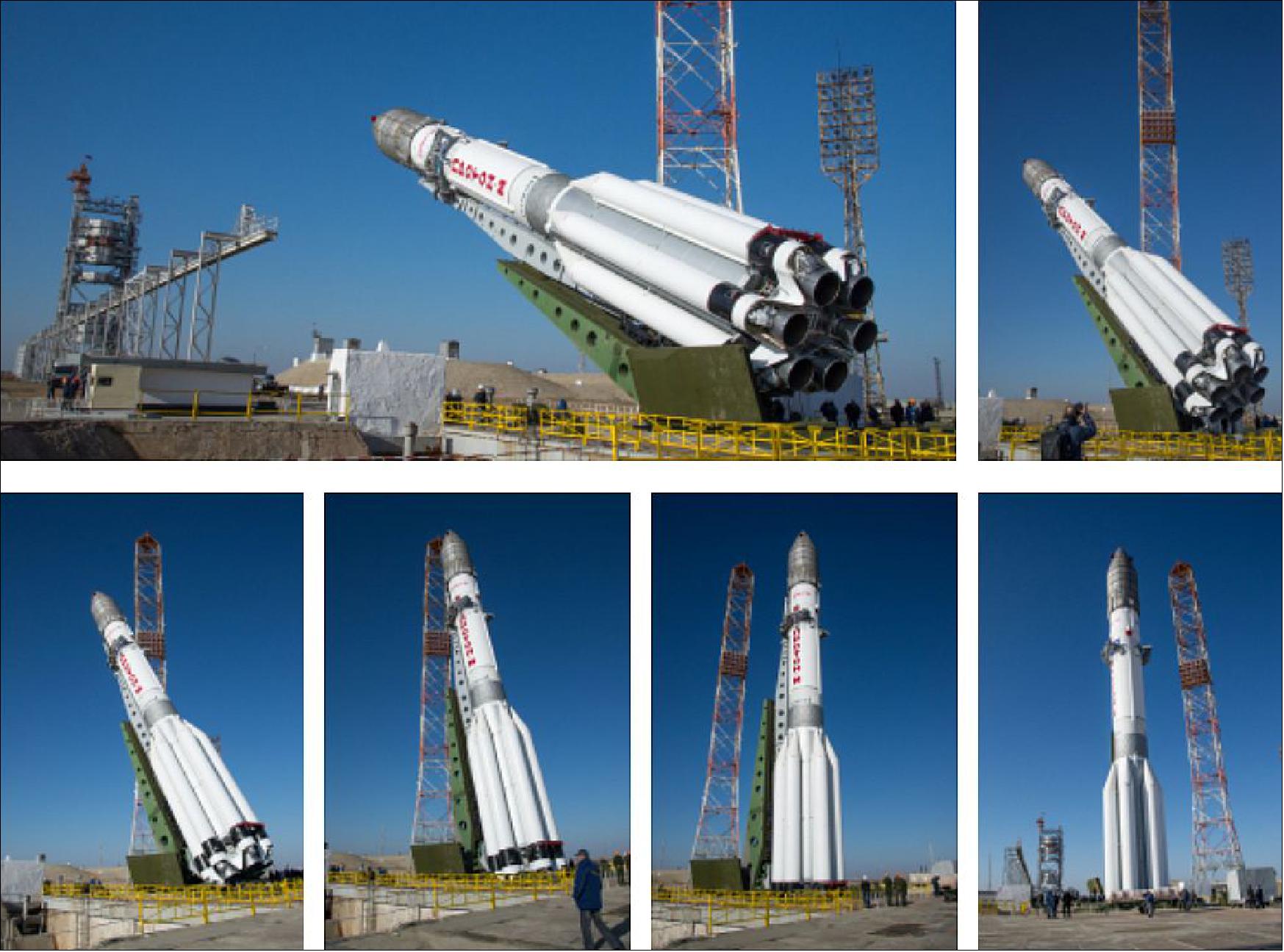
Launch
The European-Russian ExoMars (TGO and the EDM Schiaparelli lander) satellite was launched on March 14, 2016 (09:31 GMT) on a Proton-M/Briz vehicle from the Baikonur Cosmodrome, Kazakhstan. The launch provider was ILS (International Launch Services) KhSC (Khrunichev State Research and Production Space Center). 18) 19) 20)
Orbit
The SCC (ExoMars Spacecraft Composite) will be inserted into a T-2 transfer trajectory to Mars. The arrival on Mars is planned on Oct. 19, 2016 after a 9-month cruise phase.
During the cruise phase, the TGO will support all necessary operations and communications with Earth, and will provide the EDM (Schiaparelli) with the required power/energy. During this period, the EDM will be mostly in hibernation mode to minimize the TGO energy consumption, and nominally will be switched on only for three checkouts: the EDM commissioning checkout few days after the launch, the mid-cruise checkout to verify the EDM health status after the DSM (Deep Space Maneuver), and the preseparation checkout few hours before the separation from the TGO.
The EDM will be released by the TGO three days before the arrival at Mars (i.e. on Oct. 16th, 2016) by means of a 3-points spin-up separation mechanism (MSA). The separation provides a relative velocity higher than 0.3 m/s and a spin rate of 2.5 rpm. The spin rate will allow the EDM for maintaining the attitude needed to reach the Mars atmosphere EIP (Entry Interface Point) with a null angle of attack. The duration of the EDM coast phase (3 days), driven by the TGO need to have enough time to correct its orbit after the EDM separation and prepare the critical MOI ()Mars Orbit Injection) maneuver, is challenging for the EDM as the dispersions, coming from the navigation and from the separation mechanism, will propagate for quite a long time, by increasing the trajectory dispersions at Mars EIP.
During the coast phase, the EDM will be mainly in hibernation mode, to minimize the energy consumption from its batteries. Shortly before the arrival at the Mars EIP, the EDM will wake up from the hibernation to prepare the EDL phase.
The ExoMars Orbiter, TGO, will be inserted into an elliptical orbit around Mars and then sweep through the atmosphere to finally settle into a circular, approximately 400 km altitude orbit ready to conduct its scientific mission; inclination = 74º, period of ~2 hours.
TGO will also serve as a data relay for the second ExoMars mission, comprising a rover and a surface science platform, planned for launch in 2018. It will also provide data relay for NASA rovers.
Legend to Figure 8: The Schiaparelli lander collected almost all of its expected data before its unexpected crash landing on the Martian surface. Crucial lessons will be learnt from this for the recently approved 2020 ExoMars mission, which will put Europe’s first rover on Mars.
The precise cause of the lander loss is still being investigated but preliminary technical investigations have found that the atmospheric entry and slowing down in the early phases went exactly as planned.
In all, since its launch in March 2016, the ExoMars mission has been a mixture of successes and one unexpected set back. Looking ahead, the Trace Gas Orbiter will start aerobraking in March 2017 to gradually slow down over the following months. By the end of 2017, the orbiter will be in a lower, near circular orbit of 400 km and ExoMars’ primary science mission can begin.
Mission Status
• February 11, 2022: Chaotic mounds, wind-sculpted ripples and dust devil tracks: this image shows a fascinating and otherworldly landscape near Hooke Crater in Mars’ southern highlands. 21)

- This type of scenery is similar to ‘chaotic terrain’: a kind of broken, disrupted terrain seen across Mars where haphazard groups of variously sized and shaped rocks – irregular knobs, conical mounds, ridges, flat-topped hills known as mesas – clump together, often enclosed within depressions. There are around 30 regions of chaotic terrain defined on Mars (see ESA Mars Express views of Ariadnes Colles, Pyrrhae Regio, and Iani Chaos for just a small sample); while this small patch has not been defined as one of these, its appearance is certainly chaotic.
- Perhaps the most striking feature here is the wispy, snaking tendrils stretching out across the frame. These dark traces of past activity were caused by dust devils, whirlwinds of dust that occur on both Mars and Earth when warm air rises quickly into cooler air. These devils leave tracks on a planet’s surface as they travel through dusty landscapes. The tracks here appear to have a north-south orientation, indicating a possible local wind pattern.
- The bluish tinge to the dust devil tracks seen here is a result of the three filters that were combined to create this image; while not representative of what an observer would see with the naked eye, these filters produce a colour infrared image with greater sensitivity to variations in surface mineralogy.
- TGO arrived at Mars in 2016 and began its full science mission in 2018. The spacecraft is not only returning spectacular images like this one, but also providing the best ever inventory of the planet’s atmospheric gases, and mapping the planet’s surface for water-rich locations. It will also provide data relay services for the second ExoMars mission, comprising the Rosalind Franklin rover and Kazachok platform, when it arrives on Mars in 2023.
• January 28, 2022: This feature could easily be mistaken for a tree stump with characteristic concentric rings. It’s actually an impressive birds-eye view into an ice-rich impact crater on Mars. Tree rings provide snapshots of Earth’s past climate and, although formed in a very different way, the patterns inside this crater reveal details of the Red Planet’s history, too. 22)
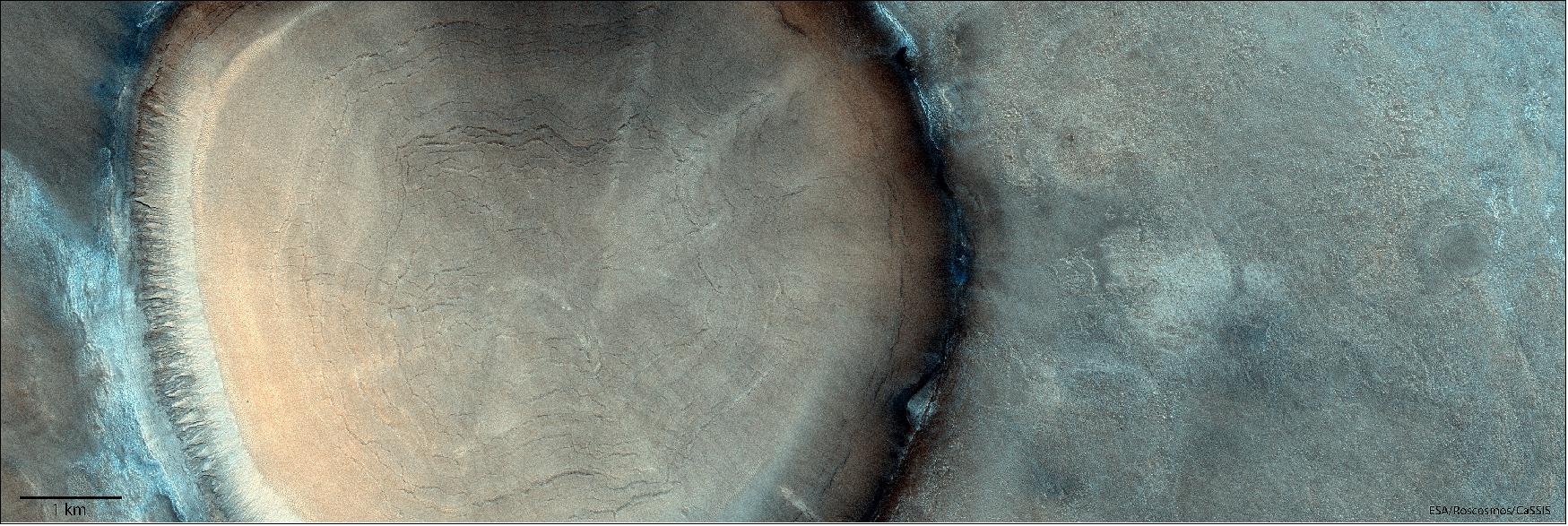
- The interior of the crater is filled with deposits that are probably water-ice rich. It is thought that these deposits were laid down during an earlier time in Mars’ history when the inclination of the planet’s spin axis allowed water-ice deposits to form at lower latitudes than it does today. Just like on Earth, Mars’ tilt gives rises to seasons, but unlike Earth its tilt has changed dramatically over long periods of time.
- One of the notable features in the crater deposits is the presence of quasi-circular and polygonal patterns of fractures. These features are likely a result of seasonal changes in temperature that cause cycles of expansion and contraction of the ice-rich material, eventually leading to the development of fractures.
- Understanding the history of water on Mars and if this once allowed life to flourish is at the heart of ESA’s ExoMars missions. TGO arrived at Mars in 2016 and began its full science mission in 2018. The spacecraft is not only returning spectacular images, but also providing the best ever inventory of the planet’s atmospheric gases with a particular emphasis on geologically and biologically important gases, and mapping the planet’s surface for water-rich locations. It will also provide data relay services for the second ExoMars mission comprising the Rosalind Franklin rover and Kazachok platform, when it arrives on Mars in 2023. The rover will explore a region of Mars thought once to have hosted an ancient ocean, and will search underground for signs of life.
• January 14, 2022: There’s more to this image of Mars than first meets the eye: nestled in the detail of the cliff face that cuts through this scene are signs of geology in motion. Zooming in reveals several boulders that have fallen from the cliff edge, leaving small dimples in the soft material as they tumbled down-slope. 23)

- Elsewhere in this image and in particular towards the right-hand side are patches of linear ripples that have been shaped by the wind. A few small impact craters also pockmark the scene.
- The image was taken over the easternmost part of Noctis Labyrinthus at 265.8°E/8.70°S in the Phoenicis Lacus Quadrangle, near the intersection with Lus Chasma of Valles Marineris – the ‘grand canyon’ of Mars.
- TGO arrived at Mars in 2016 and began its full science mission in 2018. The spacecraft is not only returning spectacular images, but also providing the best ever inventory of the planet’s atmospheric gases, and mapping the planet’s surface for water-rich locations. It will also provide data relay services for the second ExoMars mission comprising the Rosalind Franklin rover and Kazachok platform, when it arrives on Mars in 2023.
• December 24, 2021: Like a sprinkle of powdered sugar on a rich red velvet cake, this scene from the ESA/Roscosmos ExoMars Trace Gas Orbiter captures the contrasting colors of bright white water-ice against the rusty red martian soil. 24)
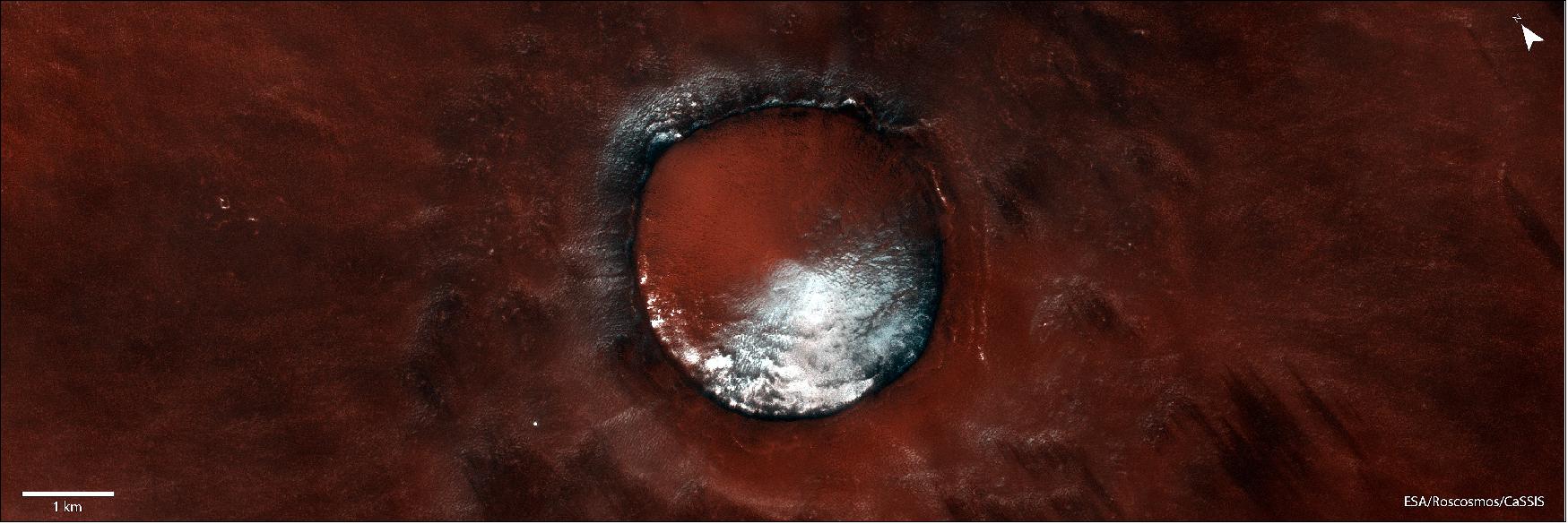
- TGO arrived at Mars in 2016 and began its full science mission in 2018. The spacecraft is not only returning spectacular images, but also providing the best ever inventory of the planet’s atmospheric gases, and mapping the planet’s surface for water-rich locations. It will also provide data relay services for the second ExoMars mission comprising the Rosalind Franklin rover and Kazachok platform, when it arrives on Mars in 2023.
• December 15, 2021: The ESA-Roscosmos ExoMars Trace Gas Orbiter has spotted significant amounts of water at the heart of Mars’ dramatic canyon system, Valles Marineris. 25)
- The water, which is hidden beneath Mars’ surface, was found by the Trace Gas Orbiter (TGO)’s FREND instrument, which is mapping the hydrogen – a measure of water content – in the uppermost metre of Mars’ soil.
- While water is known to exist on Mars, most is found in the planet’s cold polar regions as ice. Water ice is not found exposed at the surface near the equator, as temperatures here are not cold enough for exposed water ice to be stable.
- Missions including ESA’s Mars Express have hunted for near-surface water – as ice covering dust grains in the soil, or locked up in minerals – at lower latitudes of Mars, and found small amounts. However, such studies have only explored the very surface of the planet; deeper water stores could exist, covered by dust.
- “With TGO we can look down to one metre below this dusty layer and see what’s really going on below Mars’ surface – and, crucially, locate water-rich ‘oases’ that couldn’t be detected with previous instruments,” says Igor Mitrofanov of the Space Research Institute of the Russian Academy of Sciences in Moscow, Russia; lead author of the new study; and principal investigator of the FREND (Fine Resolution Epithermal Neutron Detector) neutron telescope.
- “FREND revealed an area with an unusually large amount of hydrogen in the colossal Valles Marineris canyon system: assuming the hydrogen we see is bound into water molecules, as much as 40% of the near-surface material in this region appears to be water.”
- The water-rich area is about the size of the Netherlands and overlaps with the deep valleys of Candor Chaos, part of the canyon system considered promising in our hunt for water on Mars.
Tracking Neutrons
- Igor and colleagues analysed FREND observations ranging from May 2018 to February 2021, which mapped the hydrogen content of Mars’ soil by detecting neutrons rather than light.
- “Neutrons are produced when highly energetic particles known as ‘galactic cosmic rays’ strike Mars; drier soils emit more neutrons than wetter ones, and so we can deduce how much water is in a soil by looking at the neutrons it emits,” adds co-author Alexey Malakhov, also of the Space Research Institute of the Russian Academy of Sciences. “FREND’s unique observing technique brings far higher spatial resolution than previous measurements of this type, enabling us to now see water features that weren’t spotted before.
- “We found a central part of Valles Marineris to be packed full of water – far more water than we expected. This is very much like Earth’s permafrost regions, where water ice permanently persists under dry soil because of the constant low temperatures.”
- This water could be in the form of ice, or water that is chemically bound to other minerals in the soil. However, other observations tell us that minerals seen in this part of Mars typically contain only a few percent water, much less than is evidenced by these new observations. “Overall, we think this water more likely exists in the form of ice,” says Alexey.
- Water ice usually evaporates in this region of Mars due to the temperature and pressure conditions near the equator. The same applies to chemically bound water: the right combination of temperature, pressure and hydration must be there to keep minerals from losing water. This suggests that some special, as-yet-unclear mix of conditions must be present in Valles Marineris to preserve the water – or that it is somehow being replenished.
- “This finding is an amazing first step, but we need more observations to know for sure what form of water we’re dealing with,” adds study co-author Håkan Svedhem of ESA’s ESTEC in the Netherlands, and former ESA project scientist for the ExoMars Trace Gas Orbiter.
- “Regardless of the outcome, the finding demonstrates the unrivalled abilities of TGO’s instruments in enabling us to ‘see’ below Mars’ surface – and reveals a large, not-too-deep, easily exploitable reservoir of water in this region of Mars.”
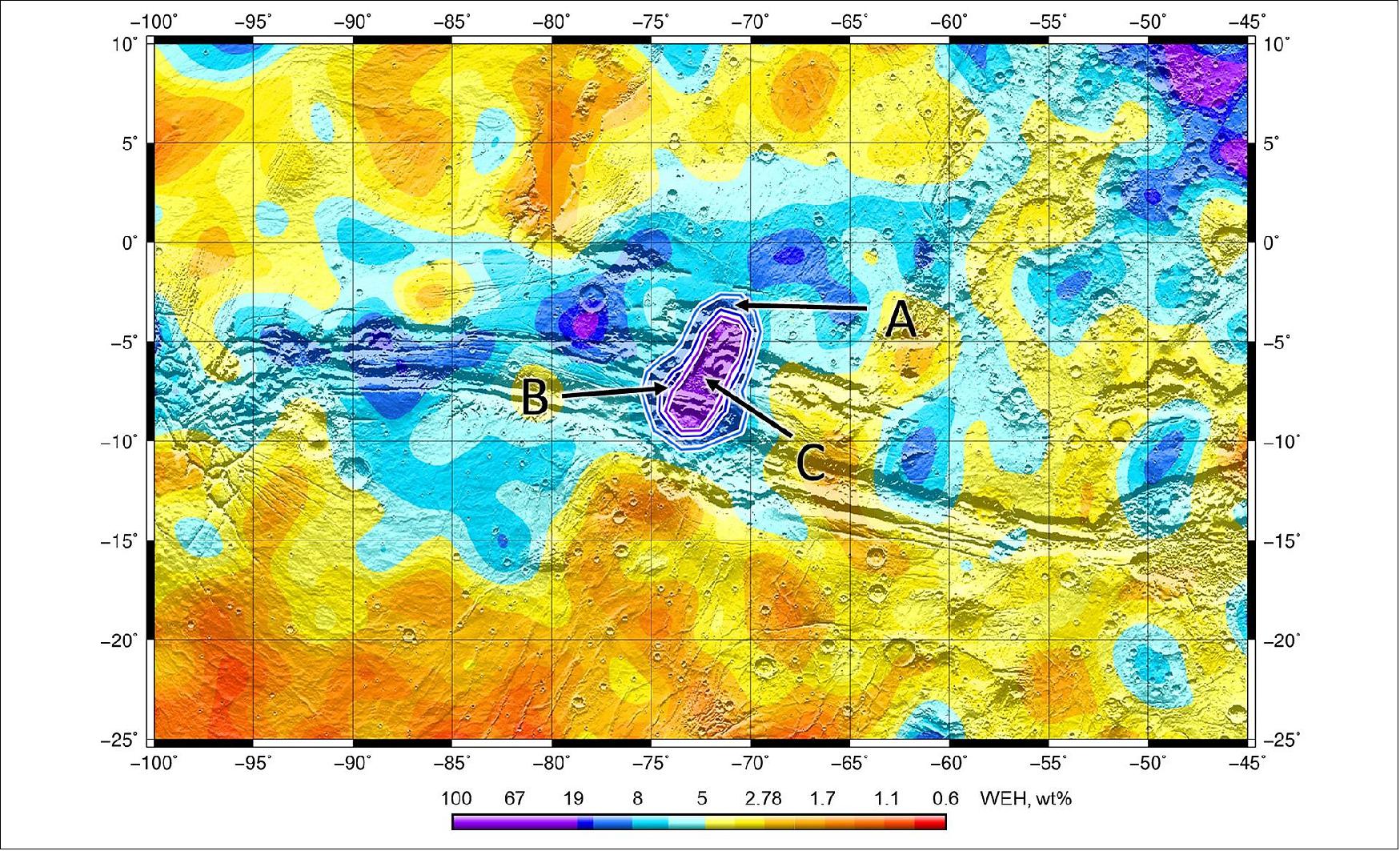
Future Exploration
- As most future missions to Mars plan to land at lower latitudes, locating such a reservoir of water here is an exciting prospect for future exploration.
- While Mars Express has found hints of water deeper underground in Mars’ mid-latitudes, alongside deep pools of liquid water under Mars’ south pole, these potential stores lie up to a few kilometres below ground, making them less exploitable and accessible to exploration than any found just below the surface.
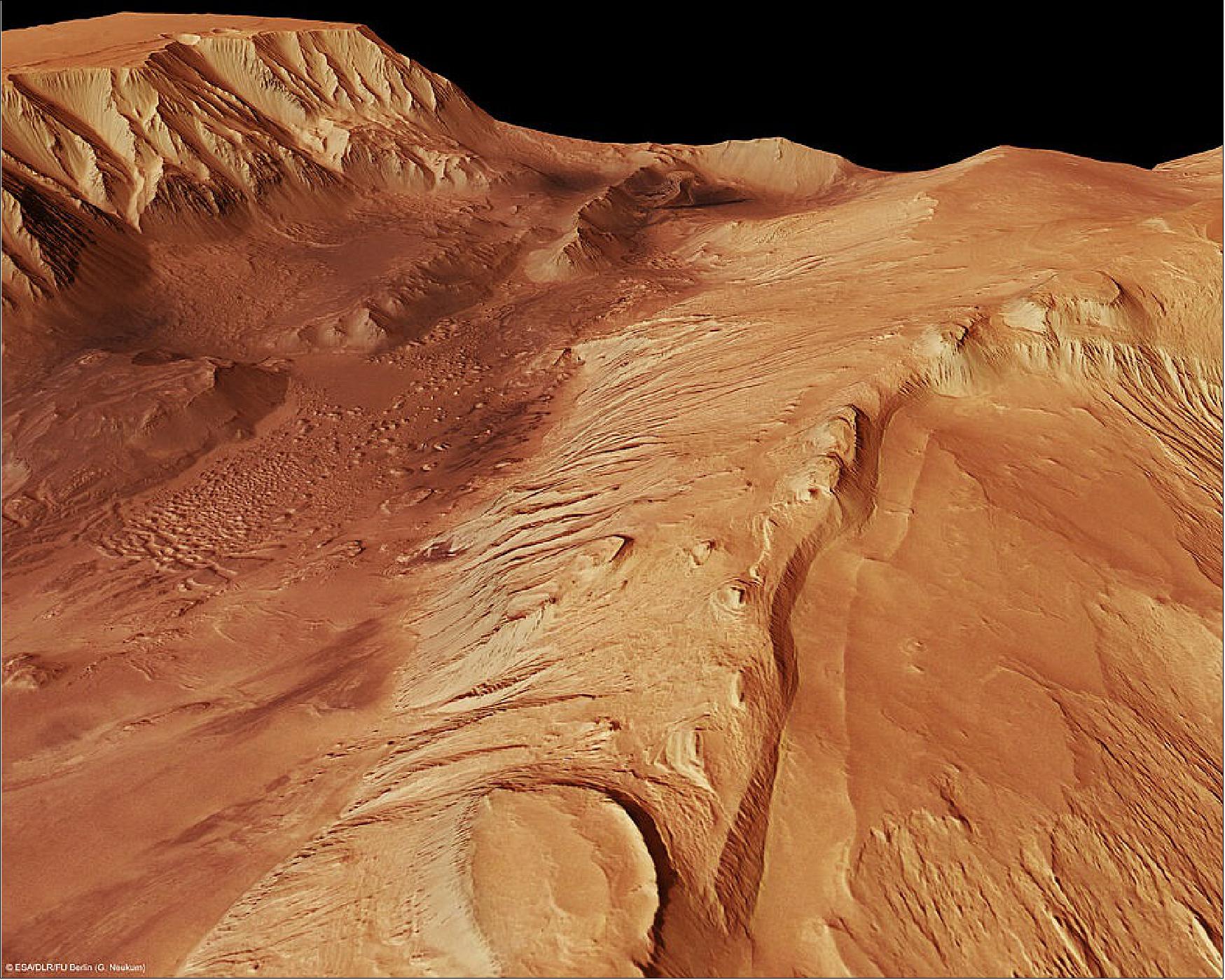
- The finding also makes Valles Marineris an even more promising target for future human exploration missions to the planet. The largest canyon in the Solar System, Valles Marineris is arguably Mars’ most dramatic landscape, and a feature that is often compared to Earth’s Grand Canyon – despite being some ten times longer and five times deeper.
• December 3, 2021: This dramatic image of a 6 km diameter crater in the northern plains of Mars was captured by the CaSSIS camera on the ESA-Roscosmos ExoMars Trace Gas Orbiter during local evening when half the crater was in shadow. The crater is located at 134°12'13.0"W/43°14'59.7"N. 26)
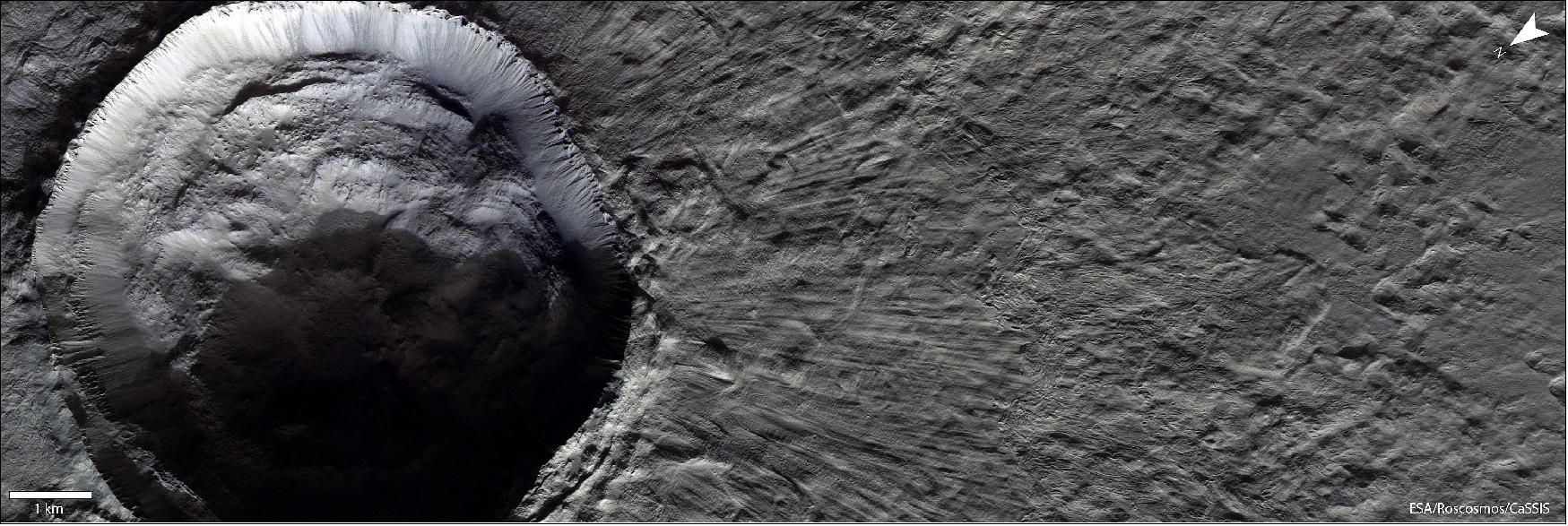
• November 19, 2021: A jagged slice in a crater wall on Mars stands out brightly against the darker terrain in this image taken by the CaSSIS camera on the ESA-Roscosmos ExoMars Trace Gas Orbiter at 7pm local time on 1 May 2021. 27)

• November 5, 2021: A spectacular double crater dominates this scene on Mars, pictured by the CaSSIS camera on the ESA-Roscosmos ExoMars Trace Gas Orbiter on 7 June 2021. 28)
![Figure 17: The crater duo is located in an otherwise smooth plain of Arcadia Planitia [39.1ºN/174.8ºE]. Double craters like these are formed when two meteorites impact the surface simultaneously and in very close proximity. The two impactors would have originated from the same object that broke apart when it entered the martian atmosphere. The two craters are of similar size, which means that the two projectiles were approximately the same size as well (image credit: ESA/Roscosmos/CaSSIS, CC BY-SA 3.0 IGO)](https://eoportal.org/ftp/satellite-missions/e/ExoMars_141122/ExoMars_Auto80.jpeg)
- During the impact, the interaction of the two shockwaves created an ejecta blanket with a butterfly shape. The remarkable linear streaks in the ejecta material radiates around the double crater, and are an indicator of the good level of preservation of this feature.
- To the north are large isolated hills that likely predate the formation of the double crater.
- TGO arrived at Mars in 2016 and began its full science mission in 2018. The spacecraft is not only returning spectacular images, but also providing the best ever inventory of the planet’s atmospheric gases, and mapping the planet’s surface for water-rich locations. It will also provide data relay services for the second ExoMars mission comprising the Rosalind Franklin rover and Kazachok platform, when it arrives on Mars in 2023.
• October 22, 2021: This mesmerizing image of swirling deposits on Mars was taken by the CaSSIS camera on the ESA-Roscosmos ExoMars Trace Gas Orbiter on 9 May 2021. 29)
- The swirling and looping texture is typical of the deposits on the floor of the Hellas impact basin in the southern hemisphere of Mars. At 2300 km in diameter and 7 km deep, Hellas is one of the largest identified impact craters both on Mars and within the Solar System.
- The swirling nature of the landscape evokes a feeling of flow. The exact reason for its origin is a puzzle however, and could be attributed to one of many different processes: salt tectonism, or viscous deformation of ice and sediments, for example.

• September 24, 2021: Exquisite detail of the Red Planet’s history is captured in this image taken by the CaSSIS camera on the ESA-Roscosmos ExoMars Trace Gas Orbiter (TGO) on 21 April 2021. 30)
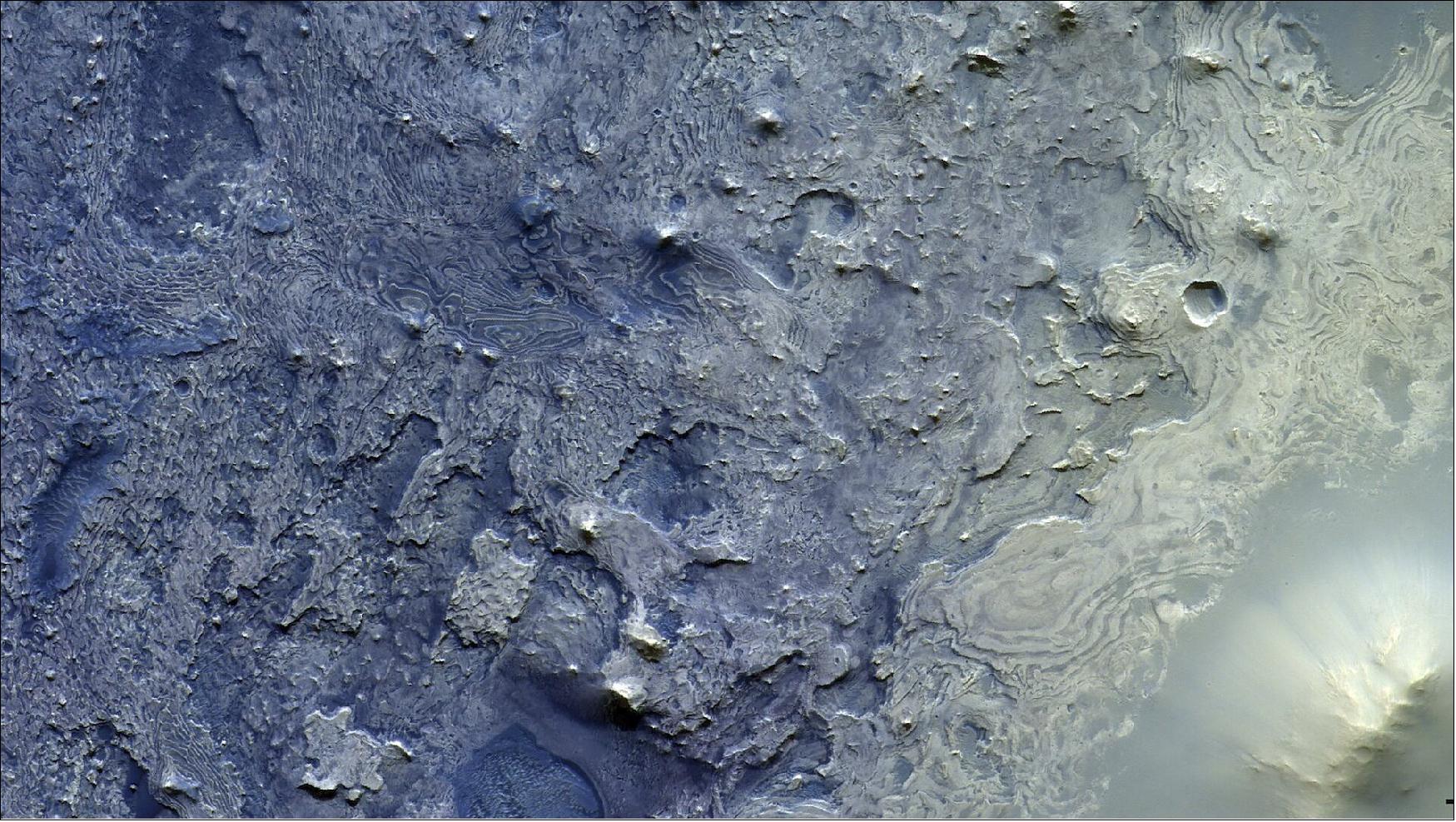
- TGO arrived at Mars in 2016 and began its full science mission in 2018. The spacecraft is not only returning spectacular images, but also providing the best ever inventory of the planet’s atmospheric gases, and mapping the planet’s surface for water-rich locations. It will also provide data relay services for the second ExoMars mission comprising the Rosalind Franklin rover and Kazachok platform, when it arrives on Mars in 2023.
• September 10, 2021: Volcanic trenches on Mars. The two blue parallel trenches in this image, called Cerberus Fossae, were thought to have formed by tectonic processes. They run for almost one thousand km over the volcanic region. In this image, CaSSIS is looking straight down into one of these 2 km-wide fissures. 31)
![Figure 20: This image of the young volcanic region of Elysium Planitia on Mars [10.3°N, 159.5°E] was taken on 14 April 2021 by the CaSSIS camera on the ESA-Roscosmos ExoMars Trace Gas Orbiter (TGO), image credit: ESA/Roscosmos/CaSSIS](https://eoportal.org/ftp/satellite-missions/e/ExoMars_141122/ExoMars_Auto7D.jpeg)
- The floor here is a few hundred meters deep and is filled with coarse-grained sand, likely basaltic in composition, which appears blue in the CaSSIS false-color composite image. The flat volcanic plains nearby are punctured by small impact craters, which expose possibly the same basaltic materials that we see within Cerberus Fossae.
- TGO arrived at Mars in 2016 and began its full science mission in 2018. The spacecraft is not only returning spectacular images, but also providing the best ever inventory of the planet’s atmospheric gases, and mapping the planet’s surface for water-rich locations. It will also provide data relay services for the second ExoMars mission comprising the Rosalind Franklin rover and Kazachok platform, when it arrives on Mars in 2023.
• August 25, 2021: Landslides are geomorphological processes occurring under specific environmental conditions. On Mars as on Earth, they come in various shapes and sizes, and Earth analogues are used to understand similar processes seen on planetary bodies. 32)

- For this particular landslide the failure area, from where the material collapsed, is slightly out of frame, although the transport and deposit zones show great details such as longitudinal striations and flow ridges. The impact craters on the lobe indicates that this is not a recent event, but it remains a challenge to accurately date its formation.
- TGO arrived at Mars in 2016 and began its full science mission in 2018. The spacecraft is not only returning spectacular images, but also providing the best ever inventory of the planet’s atmospheric gases, and mapping the planet’s surface for water-rich locations. It will also provide data relay services for the second ExoMars mission comprising the Rosalind Franklin rover and Kazachok platform, when it arrives on Mars in 2023.
• August 6, 2021: The image of Figure 22 was taken on 22 March 2021 in the Lunae Planum region [16.74°N, 300.9°E] of Mars by the CaSSIS camera on the ESA-Roscosmos ExoMars Trace Gas Orbiter (TGO). 33)
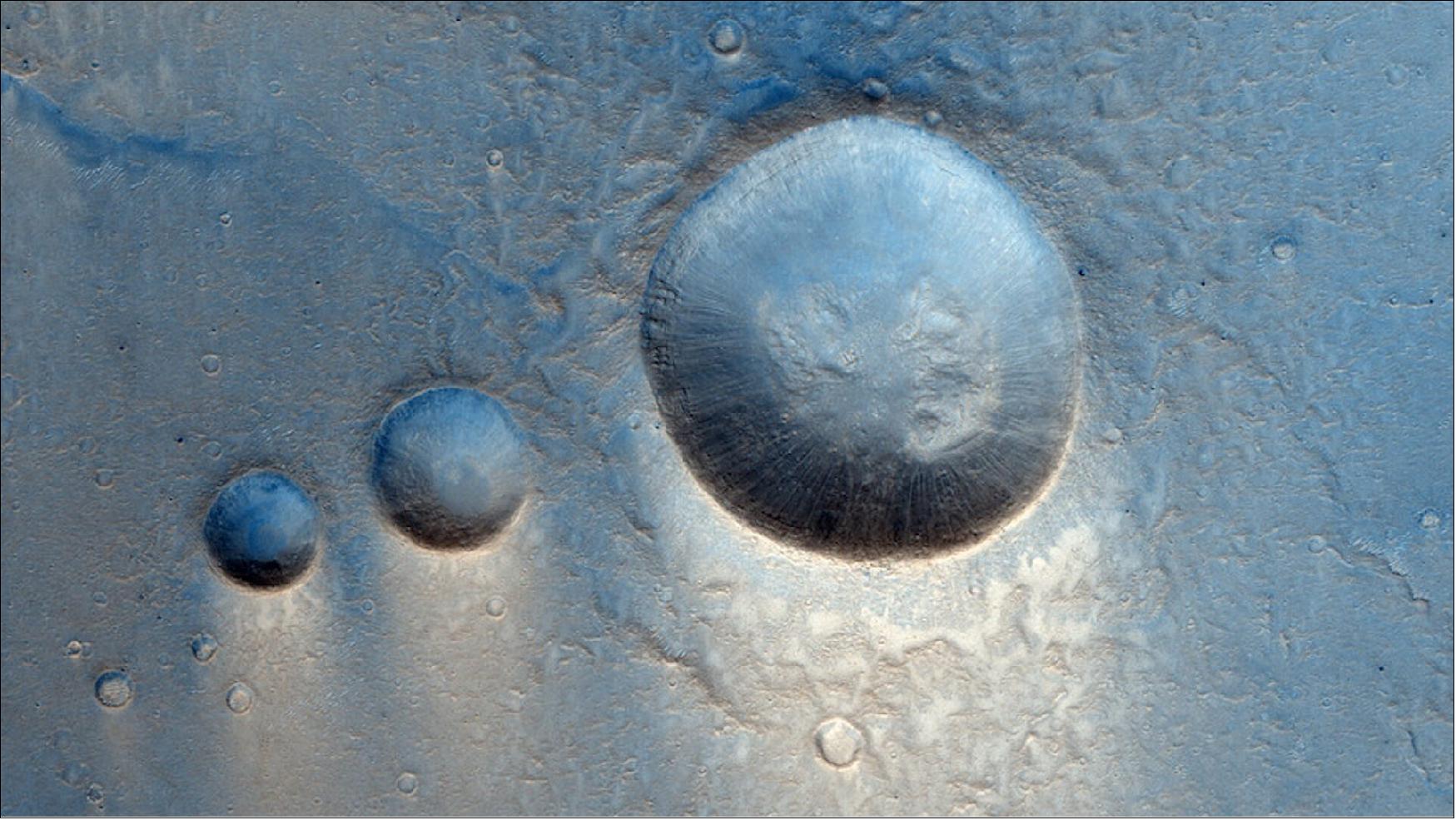
- TGO’s full science mission began in 2018. The spacecraft is not only returning spectacular images, but also providing the best ever inventory of the planet’s atmospheric gases, and mapping the planet’s surface for water-rich locations. It will also provide data relay services for the second ExoMars mission comprising the Rosalind Franklin rover and Kazachok platform, when it arrives on Mars in 2023.
• July 20,2021: The ESA-Roscosmos Trace Gas Orbiter has set new upper limits on how much methane, ethane, ethylene and phosphine is in the martian atmosphere – four so-called ‘biomarker’ gases that are potential signs of life. 34)
- Searching for biomarkers on Mars is a primary goal of the ExoMars Trace Gas Orbiter. A key biomarker of interest is methane, as much of the methane found on Earth is produced by living things or geological activity – and so the same may be true for Mars.
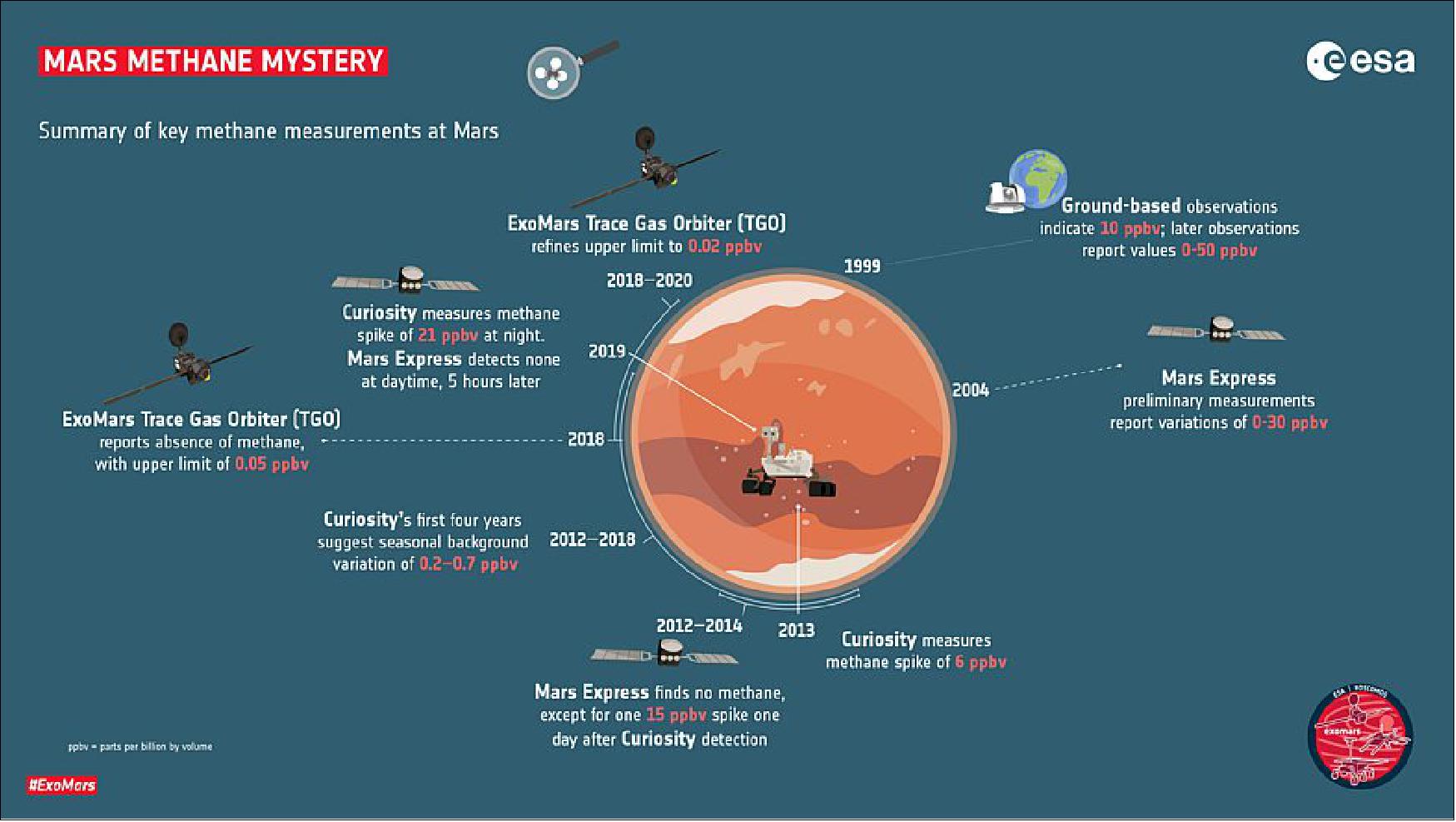
- The ‘methane mystery’ on Mars has been ongoing for many years, with contradictory findings from missions including ESA’s Mars Express and NASA’s Curiosity rover capturing sporadic spikes and bursts of the gas in Mars’ atmosphere, fluctuations both in orbit and at the planet's surface, signs of the gas varying with the seasons, or not observing any methane at all.
- Previous estimates from Mars and ground-based missions range from 0.2 up to 30 parts per billion by volume (ppbv), indicating up to 30 molecules of methane per billion molecules. For reference, methane is present in Earth’s atmosphere at nearly 2000 ppbv.
- However, the first results from the Trace Gas Orbiter, reported in April 2019, spotted no methane, instead calculating that, if present, the gas must have a maximum concentration of just 0.05 ppbv.
- “We have now used the Trace Gas Orbiter to refine the upper limit for methane at Mars even further, this time gathering data for over 1.4 martian years – 2.7 Earth years,” says Franck Montmessin of LATMOS, France, Co-Principal Investigator of the Trace Gas Orbiter’s Atmospheric Chemistry Suite (ACS) and lead author of one of a trio of new papers on martian biomarkers.
- “We found no sign of the gas at all, suggesting that the amount of methane at Mars is likely even lower than previous estimates suggest.”
- As the orbiter’s instruments are highly sensitive, if methane is present it must be at an abundance of less than 0.05 ppbv – and more likely less than 0.02 ppbv, say Franck and colleagues. The scientists also hunted for signs of methane around Curiosity’s home, Gale crater, and found nothing, despite the rover reporting the presence of methane there.
- “Curiosity measures right at Mars’ surface while the orbiter takes measurements a few kilometers above – so the difference between these two findings could be explained by any methane being trapped to the lower atmosphere or the immediate vicinity of the rover,” adds Franck.
- The apparent lack of martian methane reported by Franck and colleagues is supported by a paper using data from the orbiter’s NOMAD (Nadir Occultation MArs Discovery) instrument, again spanning a full martian year and searching for methane and two other biomarkers.
- “We also found no sign of methane on Mars, and set an upper limit of 0.06 ppbv, which agrees with TGO’s initial findings using ACS,” says the paper’s lead author Elise Wright Knutsen, previously at NASA’s Goddard Space Flight Center, USA, and now at LATMOS, France. “As well as searching for global methane, we also looked for localized plumes at over 2000 locations on the planet and didn’t detect anything – so if methane is released in this way, it must be sporadic.”
- Alongside methane, Elise and colleagues looked for two other potential biomarker gases: ethane and ethylene. These molecules are expected to occur after methane is broken down by sunlight, and so are exciting both in their own right and in the context of our hunt for methane. Ethane and ethylene molecules also have short lifetimes, meaning that if they are found in a planetary atmosphere they must have been recently released or created via an ongoing process. This makes them excellent tracers of possible biological or geological activity.
- “These are ExoMars’ first results hunting for these two gases,” says Elise. “We didn’t detect either, and so set upper limits for ethane and ethylene at 0.1 and 0.7 ppbv, respectively – low, but higher than our limits for methane.”
- The orbiter has also been hunting for phosphine – a gas that caused a splash and huge controversy last year when it was allegedly detected at Venus. Most phosphine on Earth is biologically produced, making it an exciting biomarker in the atmospheres of terrestrial planets.
- “We didn’t find any signs of phosphine at Mars,” says Kevin Olsen of the University of Oxford, UK, and lead author of the phosphine study. “Our upper limits are similar for those of ethane and ethylene – between 0.1 and 0.6 ppbv.”
- The search for life on Mars, or lingering signatures of it, is a central goal of the ExoMars programme, and the hunt for biomarkers in particular is a primary goal of the Trace Gas Orbiter. The forthcoming ExoMars rover Rosalind Franklin, due for launch in 2022, will complement TGO’s hunt for biomarkers by digging down into the martian surface; underground samples may be more likely to retain biomarkers, as material is shielded from the harsh radiation environment of space.
- “Whether biomarkers are detected or not, these findings are important for our understanding of which processes occur, and which do not, in the martian atmosphere – essential information when considering where to focus our continued investigation of Mars,” adds Håkan Svedhem, ESA Project Scientist for the ExoMars Trace Gas Orbiter.
- “Many key questions remain – for instance, why does Curiosity see methane at Gale Crater, while we find none in orbit? Could this methane have come from elsewhere, or only be found in particular locations across the planet – or could an unexpected process be destroying any methane present before we can detect it?
- It will be exciting to continue working collaboratively with missions like the Curiosity and Rosalind Franklin rovers, both of which have totally different vantage points to an orbiter, to really pin down what is happening in this mysterious planetary environment.”
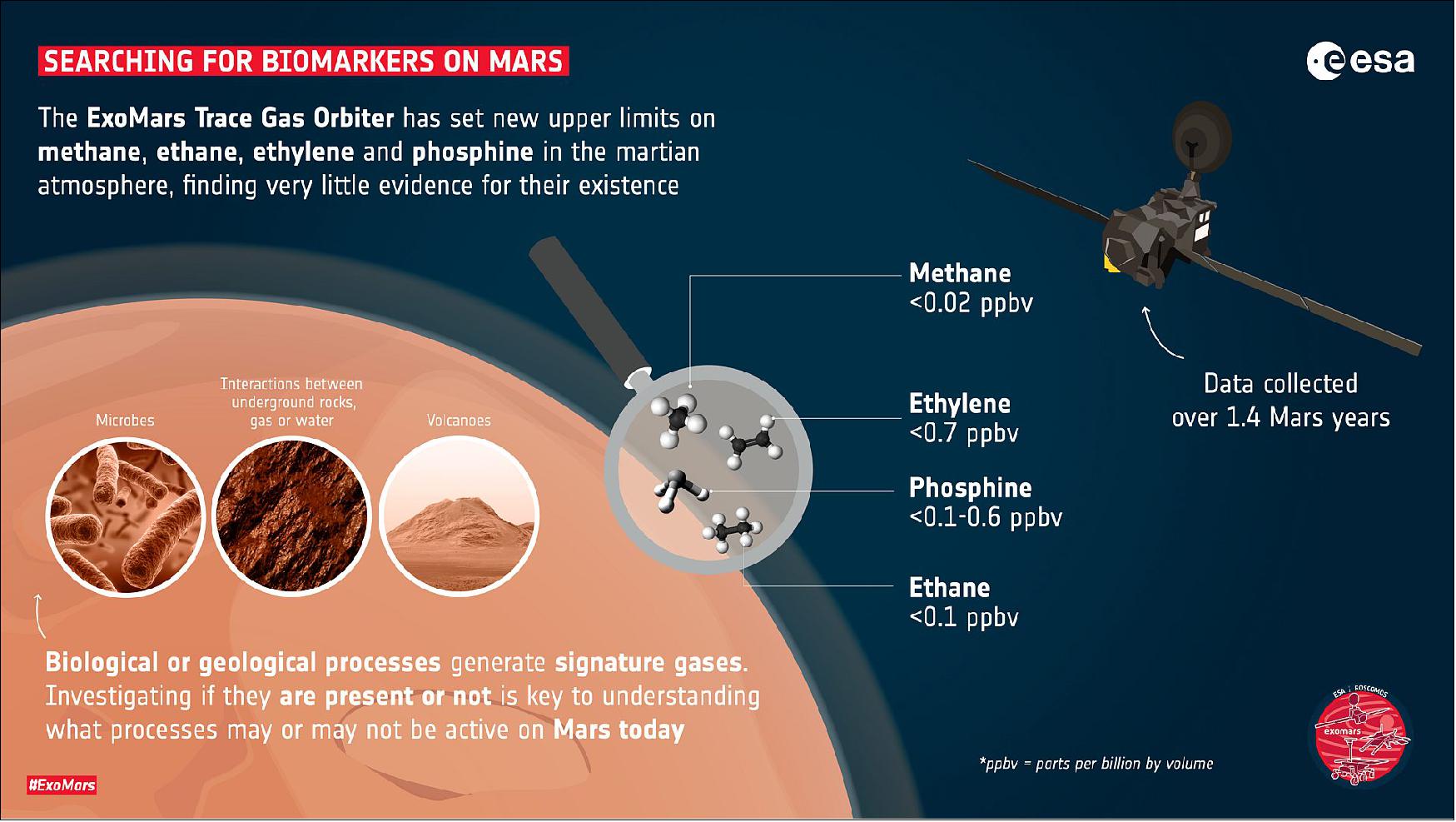
This article is based on three papers: 35) 36) 37)
• March 15, 2021: At first glance this captivating scene peering through wispy clouds and down onto a dune field is reminiscent of a satellite view of one of Earth’s deserts, but this is in fact a beautiful landscape on Mars. 38)
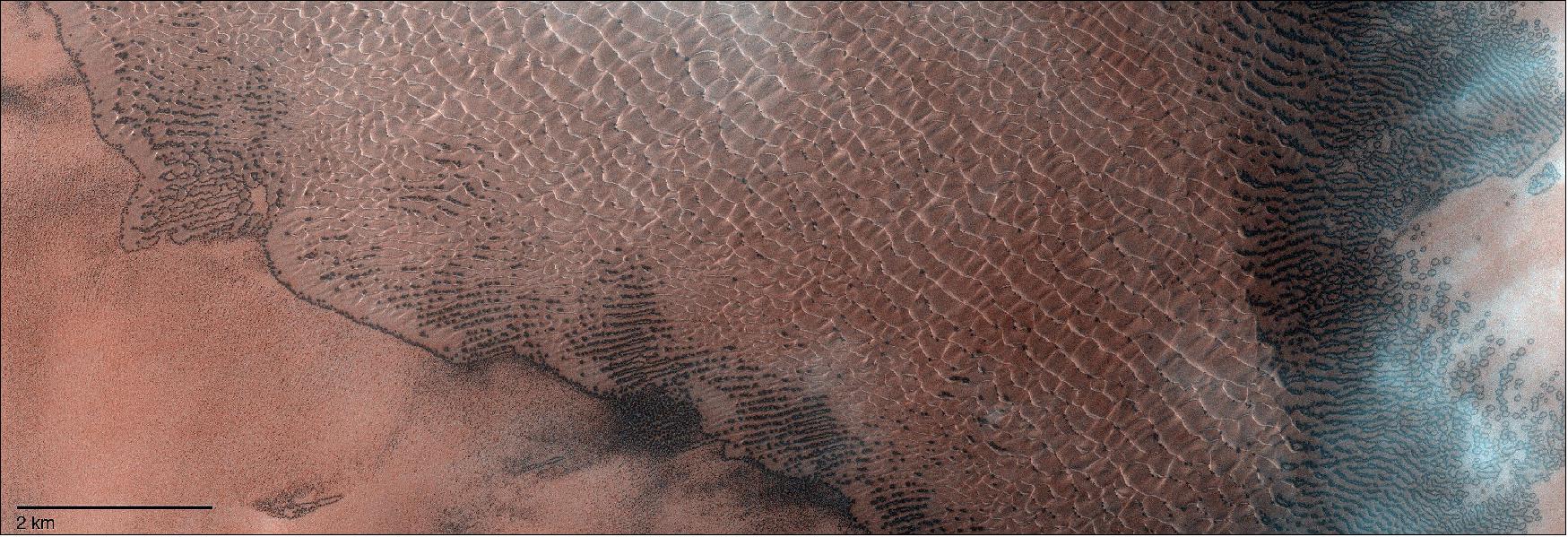
- At this time, southern summer was coming to an end on Mars. The image was taken as part of a campaign to track the evolution of the dune field through the end of summer and beginning of autumn, when frost would start covering the surface in this region. The crests of the dunes indicate the average wind direction, in this case, the wind comes predominantly from the bottom left to the top right of the image. To the right, darker, more basaltic rich sediments are visible. It is also in the right of the image that bright white clouds stand out against the darker sediments on the ground.
The First Five Years
- TGO launched from the Baikonur Cosmodrome in Kazakhstan on 14 March 2016, arriving at Mars seven months later. It spent several months aerobraking – using the top of the planet’s atmosphere to create drag and slow down – to became the first ESA spacecraft used to enter its science orbit in this way.
- The mission began full science operations in April 2018 with its suite of four instruments. TGO’s NOMAD and ACS spectrometers are designed to provide the best ever inventory of the planet’s atmospheric gases yet, and have already detected a new gas – hydrogen chloride – for the first time, as well as studying processes linked to atmospheric water escape in greater detail than ever. TGO is also adding to the lively debate surrounding the presence of methane on the planet by revealing a surprising lack of the mysterious gas. The FREND instrument is mapping the distribution of hydrogen in the uppermost meter of the planet’s surface, creating a detailed map of possible water-rich oases, relevant for future exploration of Mars. The CaSSIS camera has captured more than 20,000 images documenting the surface and complementing the data returned by the other instruments to help characterize features that may be related to trace gas sources.
- TGO also provides routine data relay for NASA’s landers and rovers: Opportunity (until its end of operations in 2018), Curiosity, Insight and Perseverance. It will also be the communication link for the second ESA-Roscosmos ExoMars mission, comprising the Rosalind Franklin rover and Kazachok platform, when it arrives on Mars in 2023.
• February 25, 2021: The ESA-Roscosmos Trace Gas Orbiter has spotted NASA’s Mars 2020 Perseverance rover, along with its parachute and back shell, heat shield and descent stage, in the Jezero Crater region of Mars. The images were captured with the orbiter’s CaSSIS camera on 23 February 2021. The components are seen as dark or bright pixels. 39)
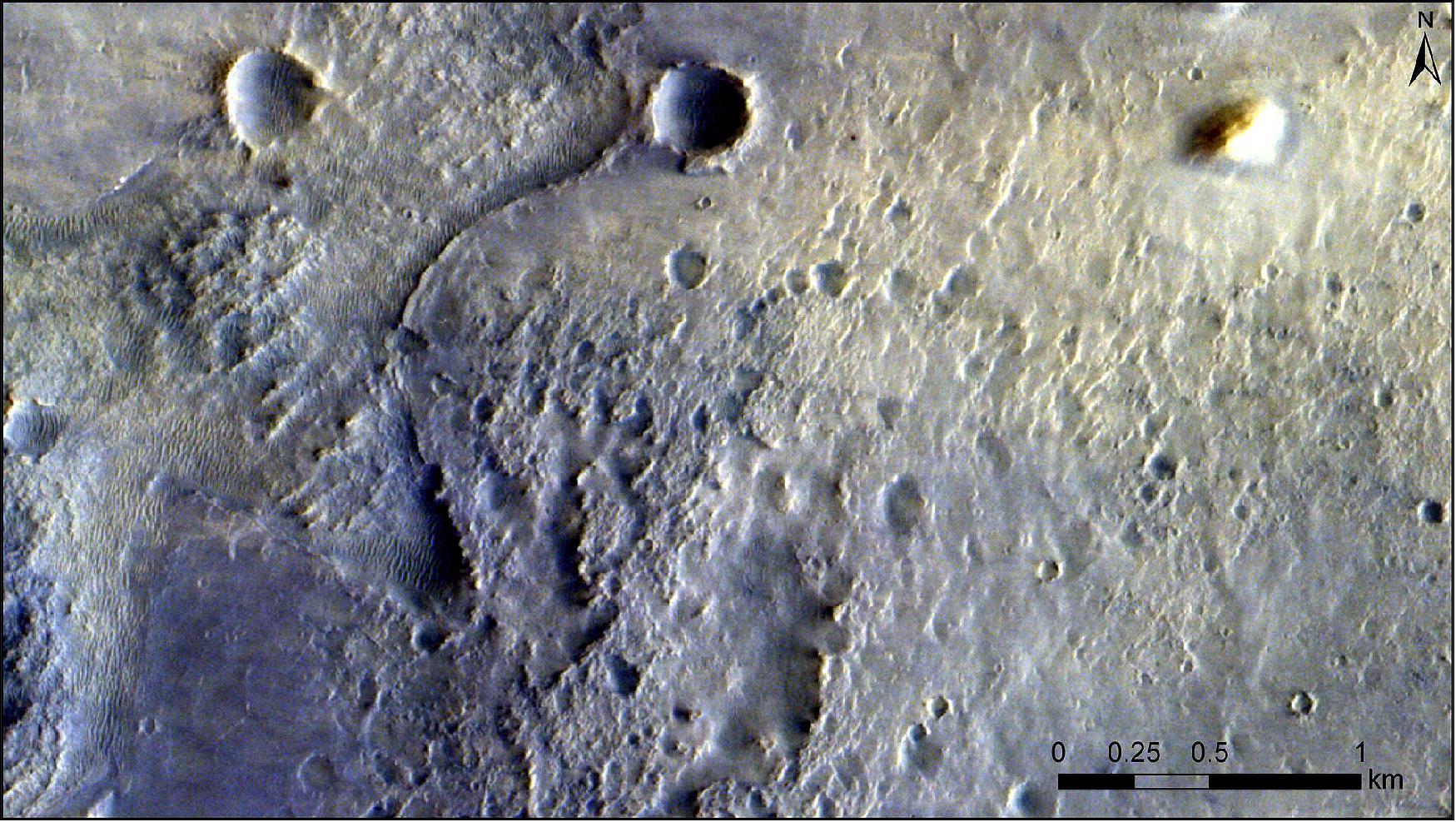
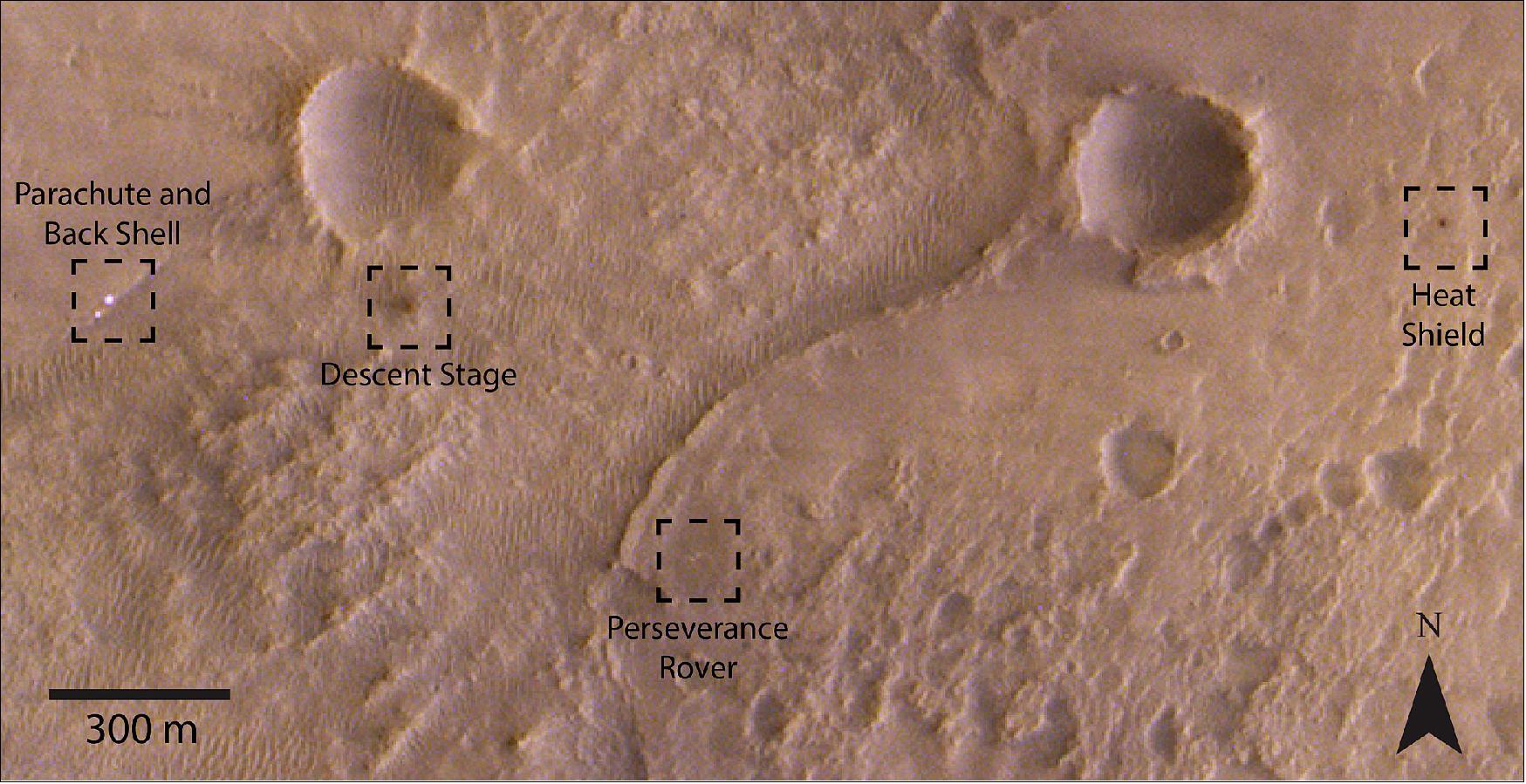
• February 22, 2021: Giant dust devils – swirling columns of wind – are constantly scouring the surface of Mars. 40)

- Dust devils on Mars form in much the same way as those on Earth: when the ground gets hotter than the air above it, rising plumes of hot air move through cooler denser air, creating an updraft, with the cooler air sinking and setting up a vertical circulation. If a horizontal gust of wind blows through, the dust devil is triggered. Once whirling fast enough, the spinning funnels can pick up dust and push it around the surface.
- Martian dust devils are much larger than their Earth counterparts, though. On the Red Planet they can tower up to eight kilometers high, creating paths that are tens to hundreds of meters wide, stretching out for several kilometers. Their colossal size makes them highly effective at carrying dust high up into Mars’ atmosphere. As such, they are interesting – and important – to study in order to understand how they might influence the planet’s climate over time.
- One of the scientific goals of the CaSSIS imager is to investigate dynamic surface processes, including aeolian processes like these, and to support the orbiter's suite of spectrometers in documenting trace gases in the planet's atmosphere and their potential sources.
• February 16, 2021: This image shows a portion of the landing ellipse (circled) for NASA’s Mars 2020 Perseverance rover, which is expected to land within Jezero crater on 18 February 2021. The complete landing ellipse is 7.7 x 6.6 km, and is centered on an ancient river delta near the rim of Jezero that could hold clues about whether or not Mars was able to harbor life at some point during its ancient past. Jezero crater itself was once the site of a lake, and Perseverance will explore this region looking for signs of fossilized microbial life. 41)
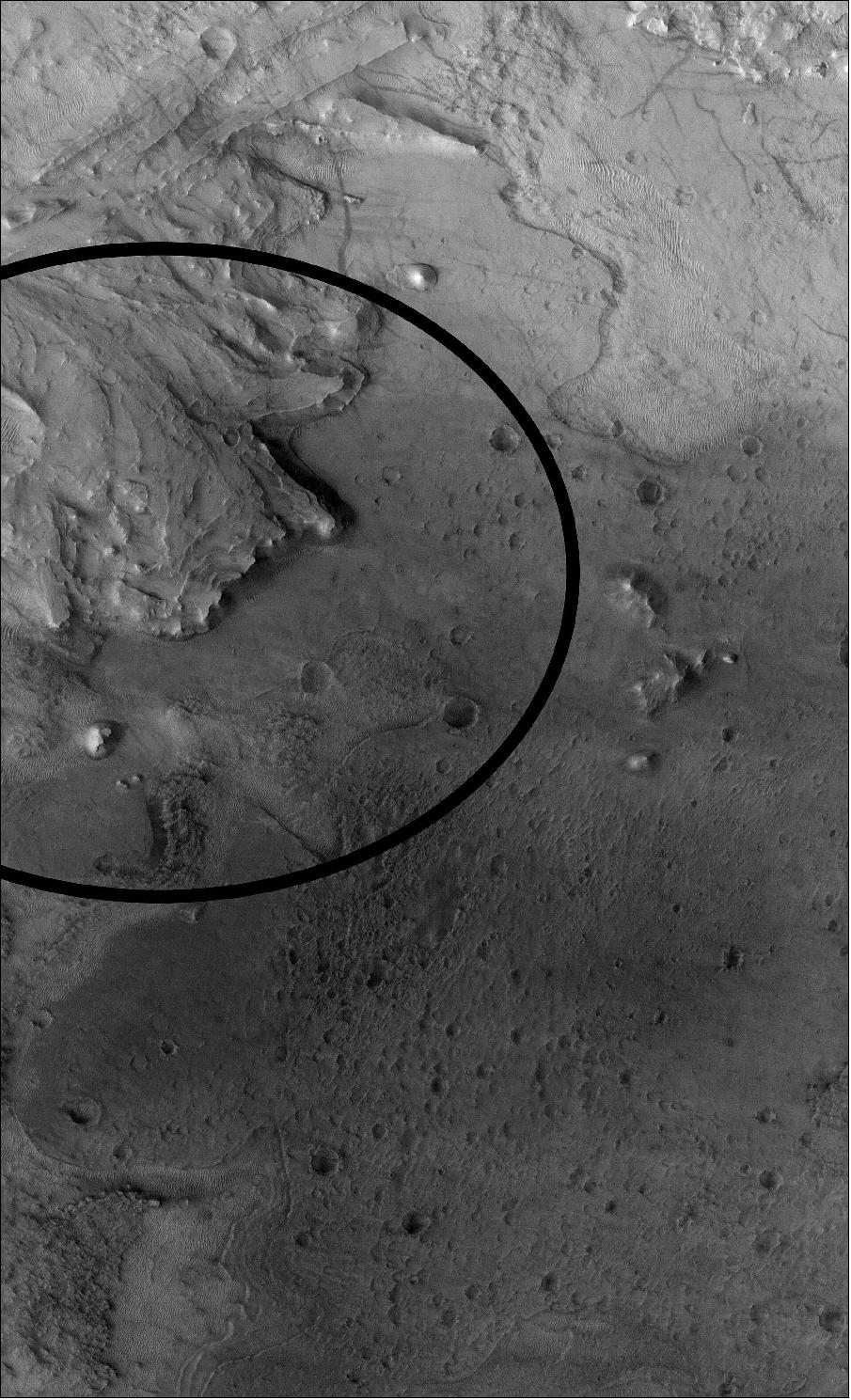
• February 16, 2021: This image shows an area close to the landing ellipse for NASA’s Mars 2020 Perseverance rover, which is expected to land within Jezero crater on 18 February 2021. Jezero crater was once the site of a lake, and the landing site is centered on an ancient river delta near the rim of the crater. Although the actual landing ellipse is just outside of this image, it was taken as part of an imaging campaign to study the rover's future neighborhood, in preparation for its arrival. 42)

• February 10, 2021: Sea salt embedded in the dusty surface of Mars and lofted into the planet’s atmosphere has led to the discovery of hydrogen chloride – the first time the ESA-Roscosmos ExoMars Trace Gas Orbiter has detected a new gas. The spacecraft is also providing new information about how Mars is losing its water. 43)
- A major quest in Mars exploration is hunting for atmospheric gases linked to biological or geological activity, as well as understanding the past and present water inventory of the planet, to determine if Mars could ever have been habitable and if any water reservoirs could be accessible for future human exploration. Two new results from the ExoMars team published today in Science Advances unveil an entirely new class of chemistry and provide further insights into seasonal changes and surface-atmosphere interactions as driving forces behind the new observations.
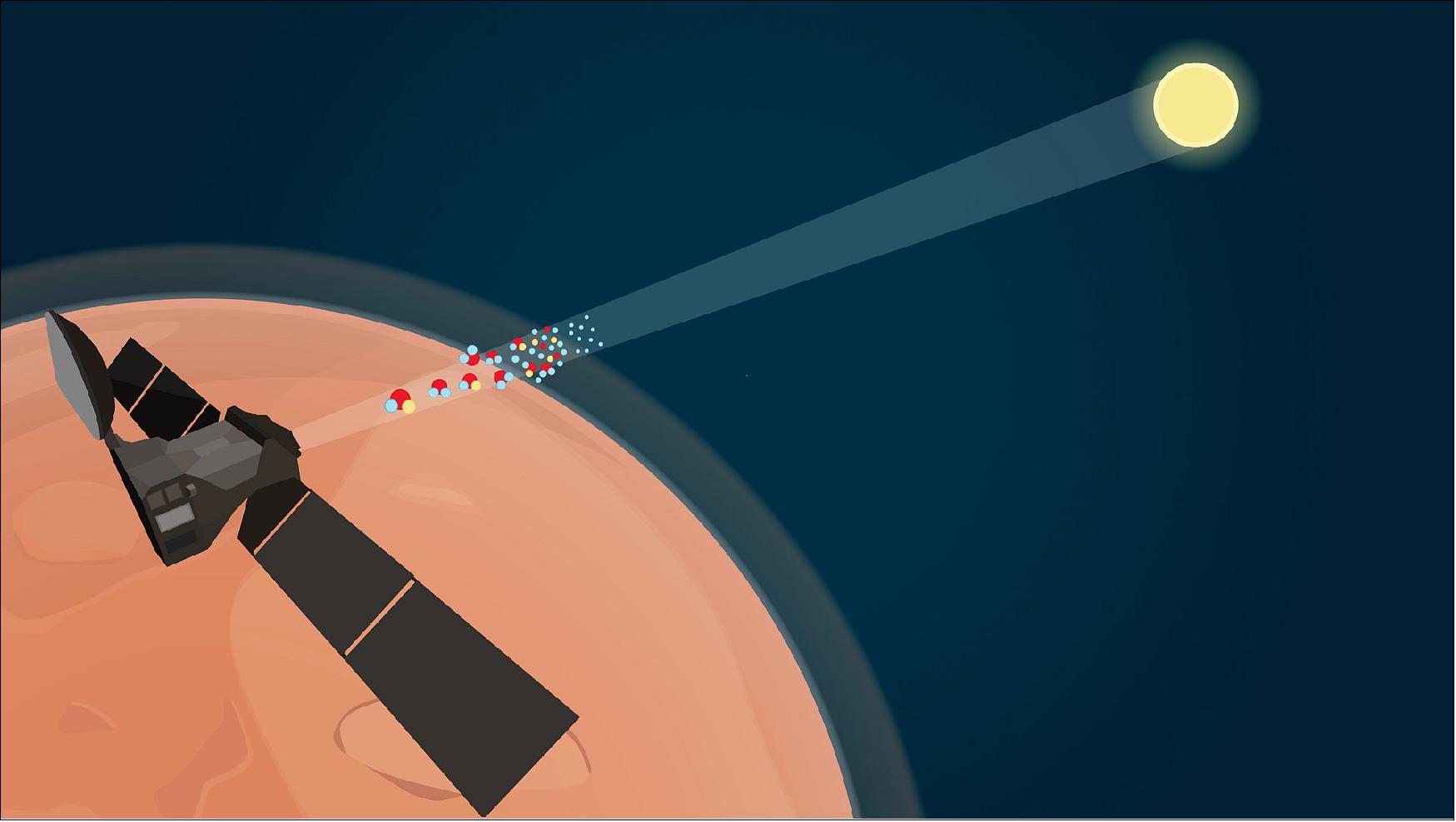
A New Chemistry
- “We’ve discovered hydrogen chloride for the first time on Mars. This is the first detection of a halogen gas in the atmosphere of Mars, and represents a new chemical cycle to understand,” says Kevin Olsen from the University of Oxford, UK, one of the lead scientists of the discovery.
- Hydrogen chloride gas, or HCl, comprises a hydrogen and chlorine atom. Mars scientists were always on the look-out for chlorine- or sulphur-based gases because they are possible indicators of volcanic activity. But the nature of the hydrogen chloride observations – the fact that it was detected in very distant locations at the same time, and the lack of other gases that would be expected from volcanic activity – points to a different source. That is, the discovery suggests an entirely new surface-atmosphere interaction driven by the dust seasons on Mars that had not previously been explored.
- In a process very similar to that seen on Earth, salts in the form of sodium chloride – remnants of evaporated oceans and embedded in the dusty surface of Mars – are lifted into the atmosphere by winds. Sunlight warms the atmosphere causing dust, together with water vapor released from ice caps, to rise. The salty dust reacts with atmospheric water to release chlorine, which itself then reacts with molecules containing hydrogen to create hydrogen chloride. Further reactions could see the chlorine or hydrochloric acid-rich dust return to the surface, perhaps as perchlorates, a class of salt made of oxygen and chlorine.
- “You need water vapor to free chlorine and you need the by-products of water – hydrogen - to form hydrogen chloride. Water is critical in this chemistry,” says Kevin. “We also observe a correlation to dust: we see more hydrogen chloride when dust activity ramps up, a process linked to the seasonal heating of the southern hemisphere.”
- The team first spotted the gas during the global dust storm in 2018, observing it appear simultaneously in both northern and southern hemispheres, and witnessed its surprisingly quick disappearance again at the end of the seasonal dusty period. They are already looking into the data collected during the following dust season and see the HCl rising again.
- “It is incredibly rewarding to see our sensitive instruments detecting a never-before-seen gas in the atmosphere of Mars,” says Oleg Korablev, principal investigator of the Atmospheric Chemistry Suite instrument that made the discovery. “Our analysis links the generation and decline of the hydrogen chloride gas to the surface of Mars.”
- Extensive laboratory testing and new global atmospheric simulations will be needed to better understand the chlorine-based surface-atmosphere interaction, together with continued observations at Mars to confirm that the rise and fall of HCl is driven by the southern hemisphere summer.
- “The discovery of the first new trace gas in the atmosphere of Mars is a major milestone for the Trace Gas Orbiter mission,” says Håkan Svedhem, ESA’s ExoMars Trace Gas Orbiter project scientist. “This is the first new class of gas discovered since the claimed observation of methane by ESA’s Mars Express in 2004, which motivated the search for other organic molecules and ultimately culminated in the development of the Trace Gas Orbiter mission, for which detecting new gases is a primary goal.” 44) 45)
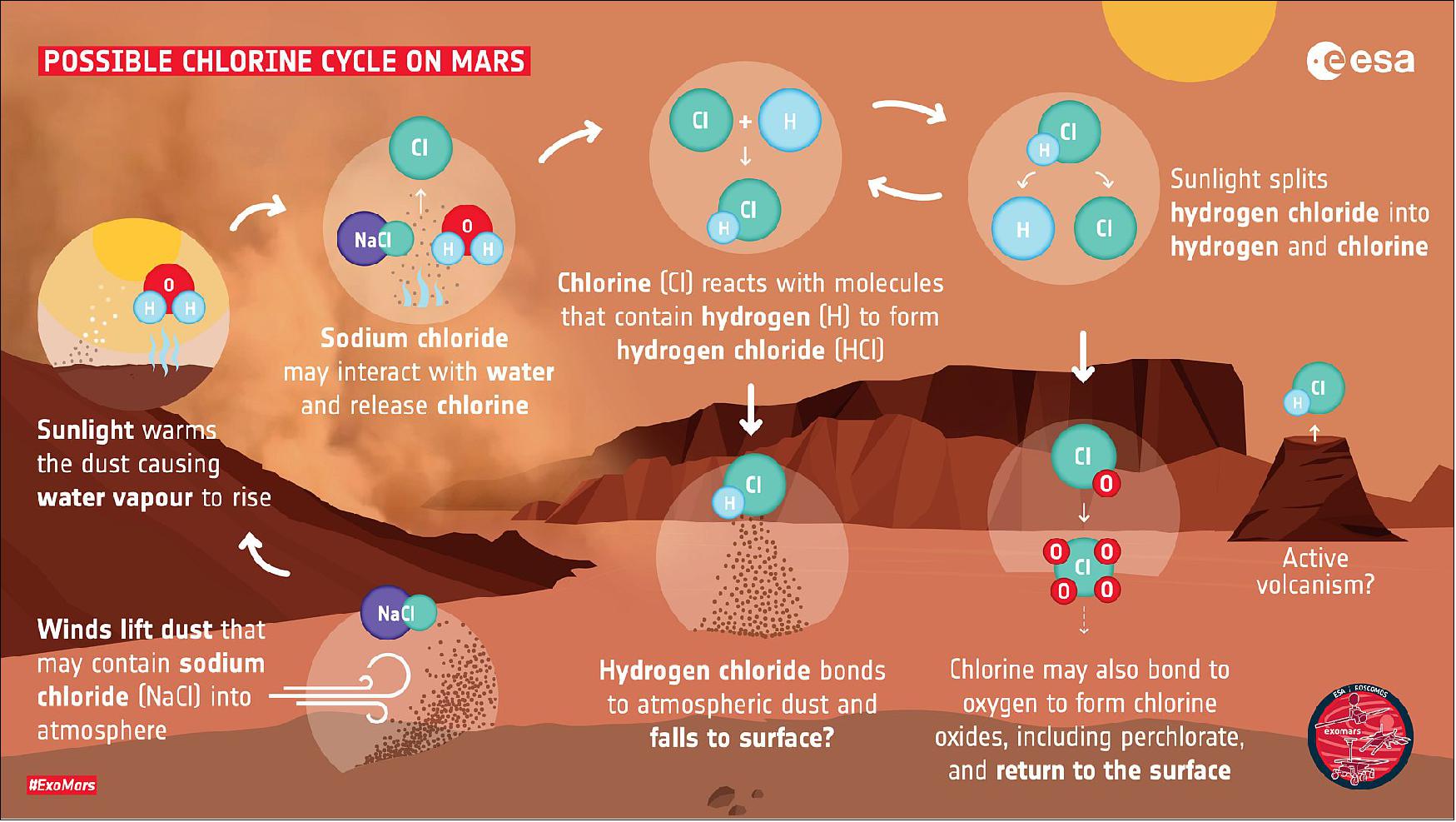
Rising Water Vapor Holds Clues to Climate Evolution
- As well as new gases, the Trace Gas Orbiter is refining our understanding of how Mars lost its water – a process which is also linked to seasonal changes.
- Liquid water is once thought to have flowed across the surface of Mars as evidenced in the numerous examples of ancient dried out valleys and river channels. Today, it is mostly locked up in the ice caps and buried underground. Mars is still leaking water today, in the form of hydrogen and oxygen escaping from the atmosphere.
- Understanding the interplay of potential water-bearing reservoirs and their seasonal and long-term behavior is key to understanding the evolution of the climate of Mars. This can be done through the study of water vapor and ‘semi-heavy’ water (where one hydrogen atom is replaced by a deuterium atom, a form of hydrogen with an additional neutron).
- “The deuterium to hydrogen ratio, D/H, is our chronometer – a powerful metric that tells us about the history of water on Mars, and how water loss evolved over time. Thanks to the ExoMars Trace Gas Orbiter, we can now better understand and calibrate this chronometer and test for potential new reservoirs of water on Mars,” says Geronimo Villanueva of NASA’s Goddard Space Flight Center and lead author of the new result.
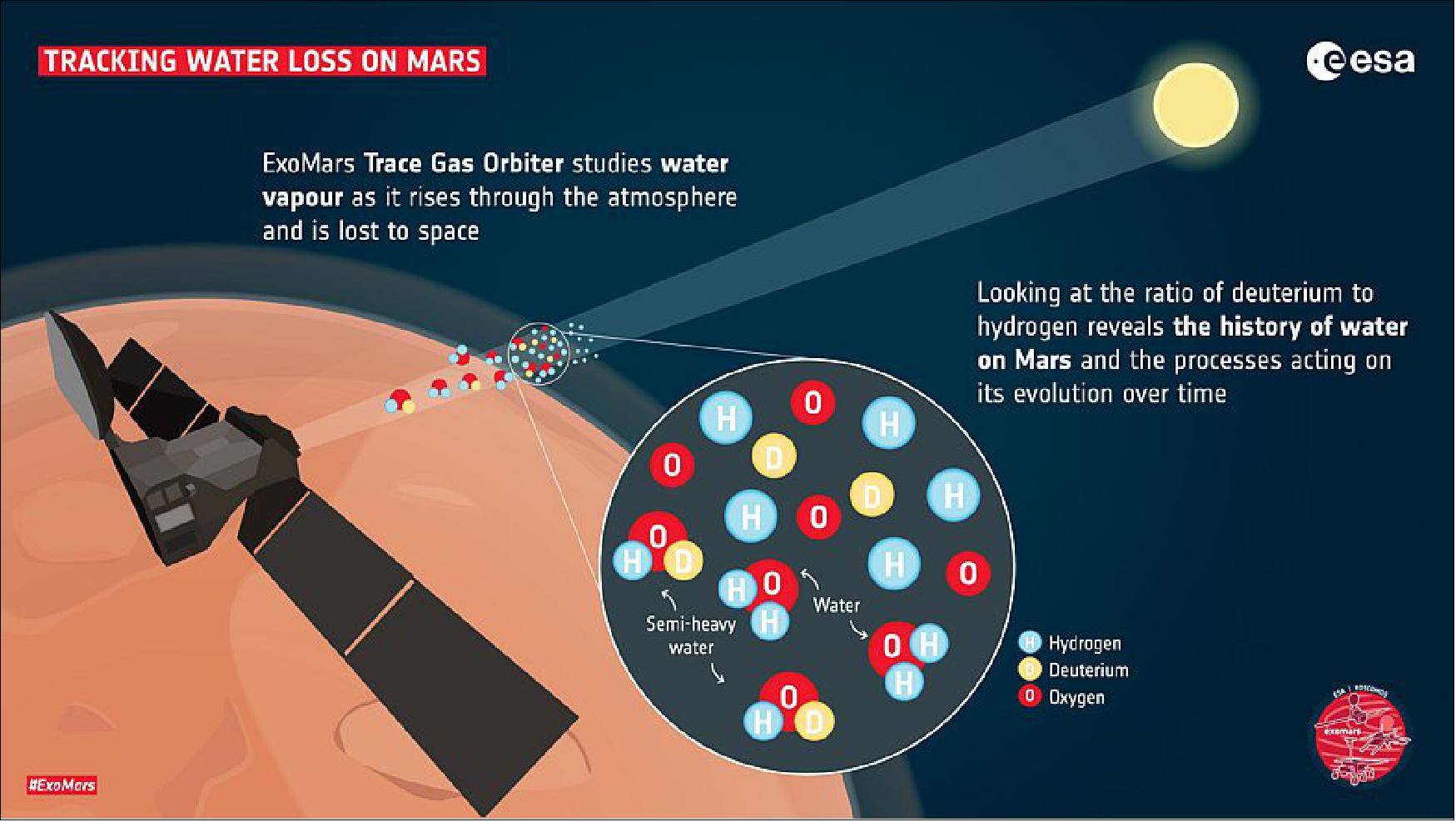
- With the Trace Gas Orbiter we can watch the path of the water isotopologues as they rise up into the atmosphere with a level of detail not possible before. Previous measurements only provided the average over the depth of the whole atmosphere. It is like we only had a 2D view before, now we can explore the atmosphere in 3D,” says Ann Carine Vandaele, principal investigator of the Nadir and Occultation for MArs Discovery (NOMAD) instrument that was used for this investigation.
- The new measurements reveal dramatic variability in D/H with altitude and season as the water rises from its original location.“Interestingly, the data show that once water is fully vaporised, it mostly displays a common large enrichment in semi-heavy water, and a D/H ratio six times greater than Earth’s across all reservoirs on Mars, confirming that large amounts of water have been lost over time,” says Giuliano Liuzzi of American University and NASA’s Goddard Space Flight Center and one of the lead scientists of the investigation.
- ExoMars data collected between April 2018 and April 2019 also showed three instances that accelerated water loss from the atmosphere: the global dust storm of 2018, a short but intense regional storm in January 2019, and water release from the south polar ice cap during summer months linked to seasonal change. Of particular note is a plume of rising water vapor during southern summer that would potentially inject water into the upper atmosphere on a seasonal and yearly basis.
- Future coordinated observations with other spacecraft including NASA’s MAVEN, which focuses on the upper atmosphere, will provide complementary insights to the evolution of water over the martian year.
- “The changing seasons on Mars, and in particular the relatively hot summer in the southern hemisphere seems to be the driving force behind our new observations such as the enhanced atmospheric water loss and the dust activity linked to the detection of hydrogen chloride, that we see in the two latest studies,” adds Håkan. “Trace Gas Orbiter observations are enabling us to explore the martian atmosphere like never before.”
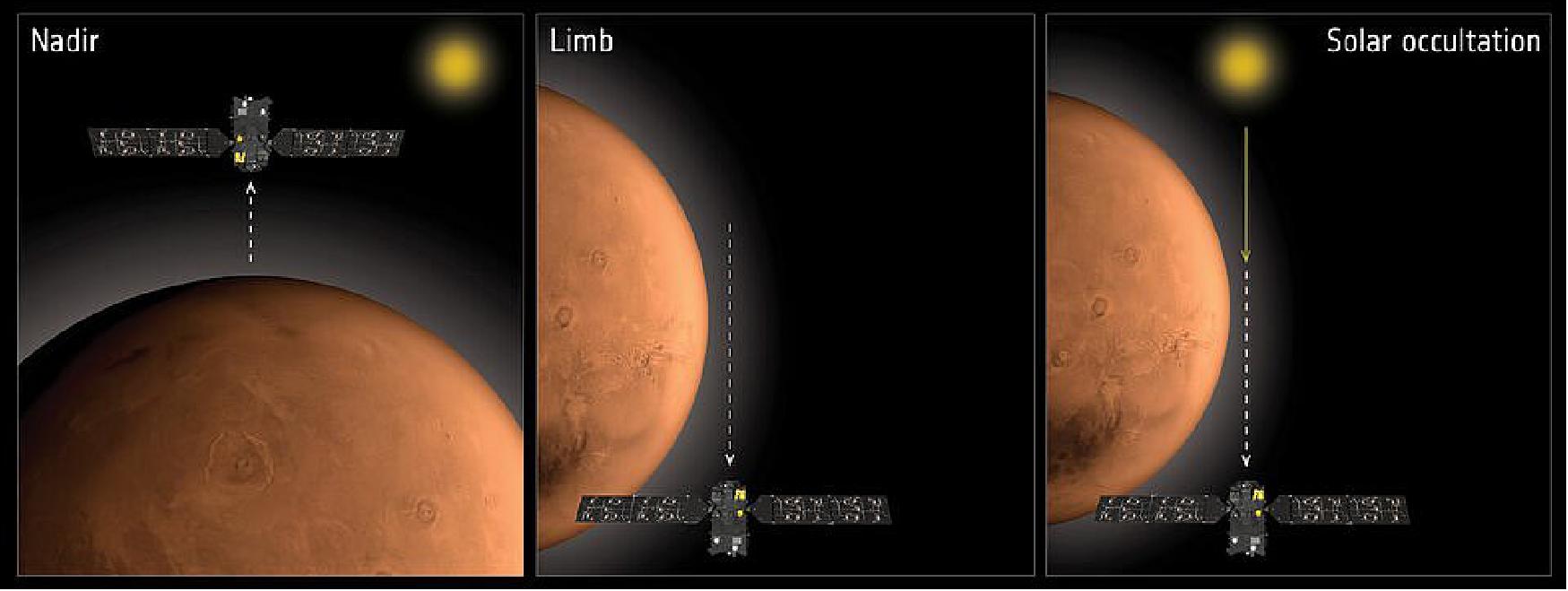
• February 10, 2021: The CaSSIS (Color and Stereo Surface Imaging System) instrument onboard the ExoMars Trace Gas Orbiter took the image on 19 October 2020. 46)
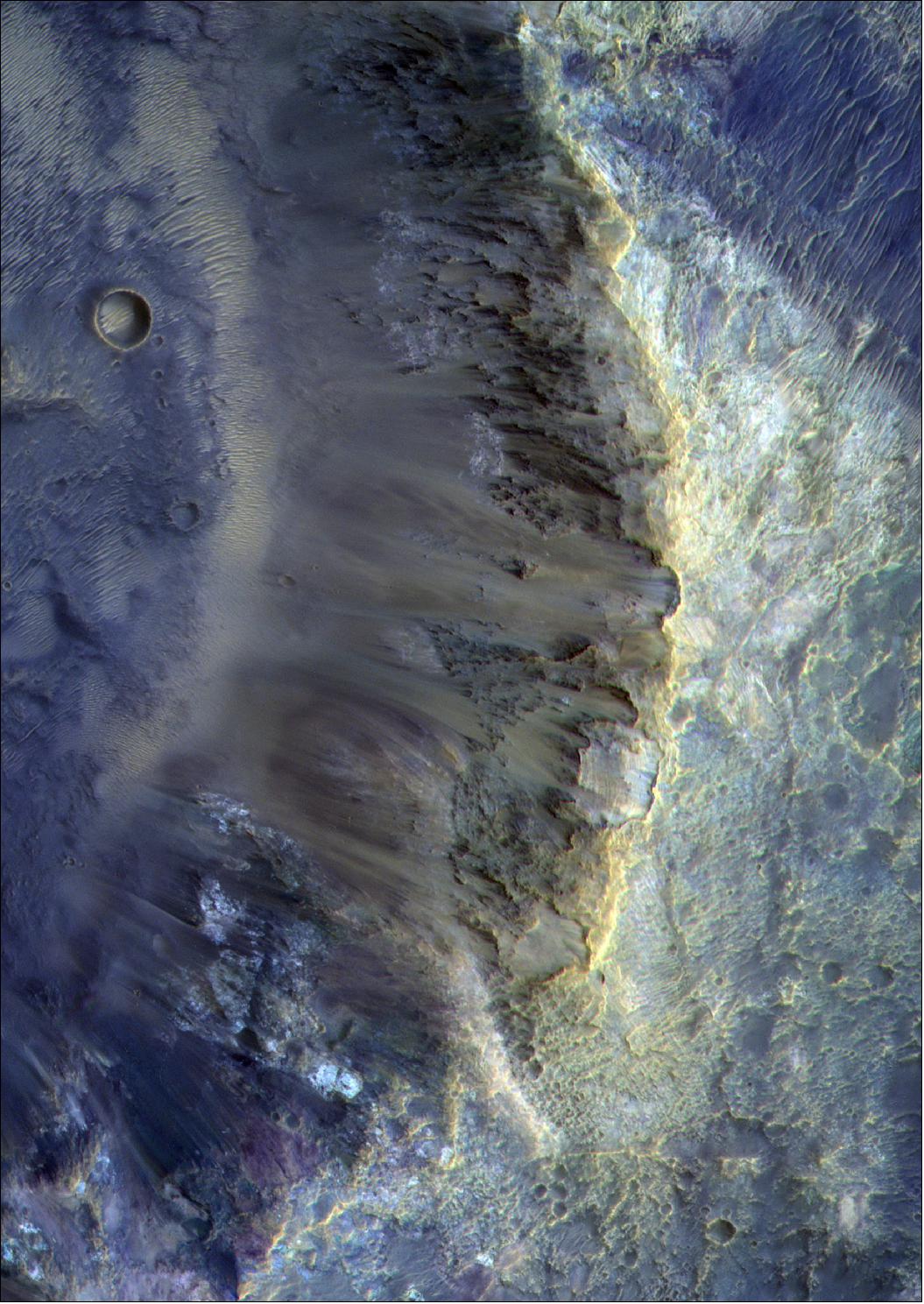
• February 4, 2021: The CaSSIS (Color and Stereo Surface Imaging System) instrument onboard the ExoMars Trace Gas Orbiter mission returned this image of an area in Melas Chasma, part of the vast Valles Marineris canyon system on Mars. Valles Marineris stretches for more than 4000 km across the planet’s surface, and plunges more than 7 km deep in places. 47)
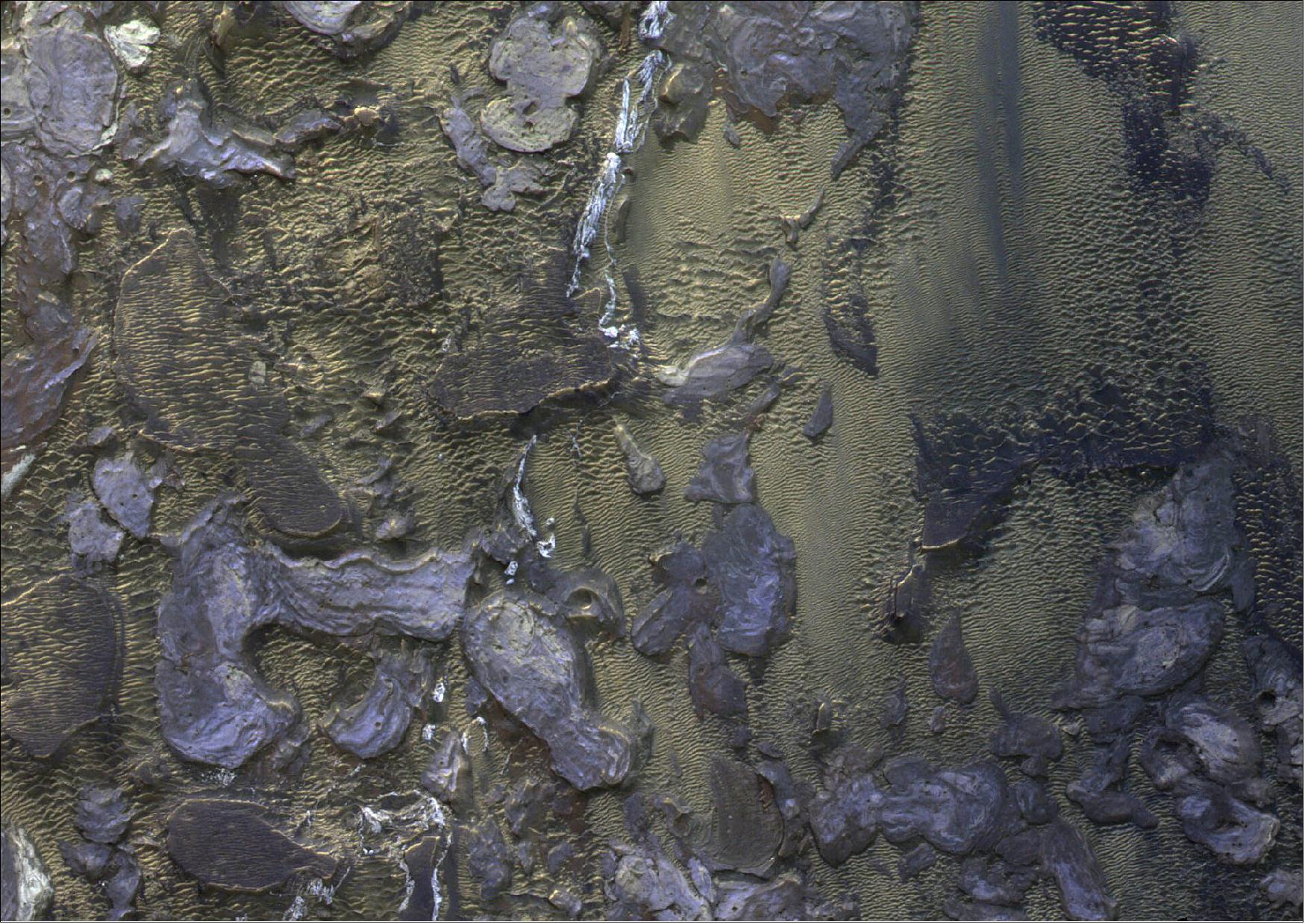
- The CRISM spectrometer on NASA’s Mars Reconnaissance Orbiter revealed a variety of minerals and phases that correlate with the light-toned blocks seen here (for example: nontronite, jarosite, aluminum-rich clays, hydrated silica, and/or an acid-leached clay). The tan-colored ripples likely contain ferric iron oxides that gives rise to this distinctive color. There is also evidence of the past presence of water in this region. The bright-white layered materials imply the presence of a hydrated calcium sulphate (possibly gypsum), which is thought to have formed through the ponding and subsequent evaporation of water that may have once occupied portions of the Chasma floor.
• January 28, 2021: The CaSSIS camera onboard the ExoMars Trace Gas Orbiter has captured its 20,000th image of Mars! 48)
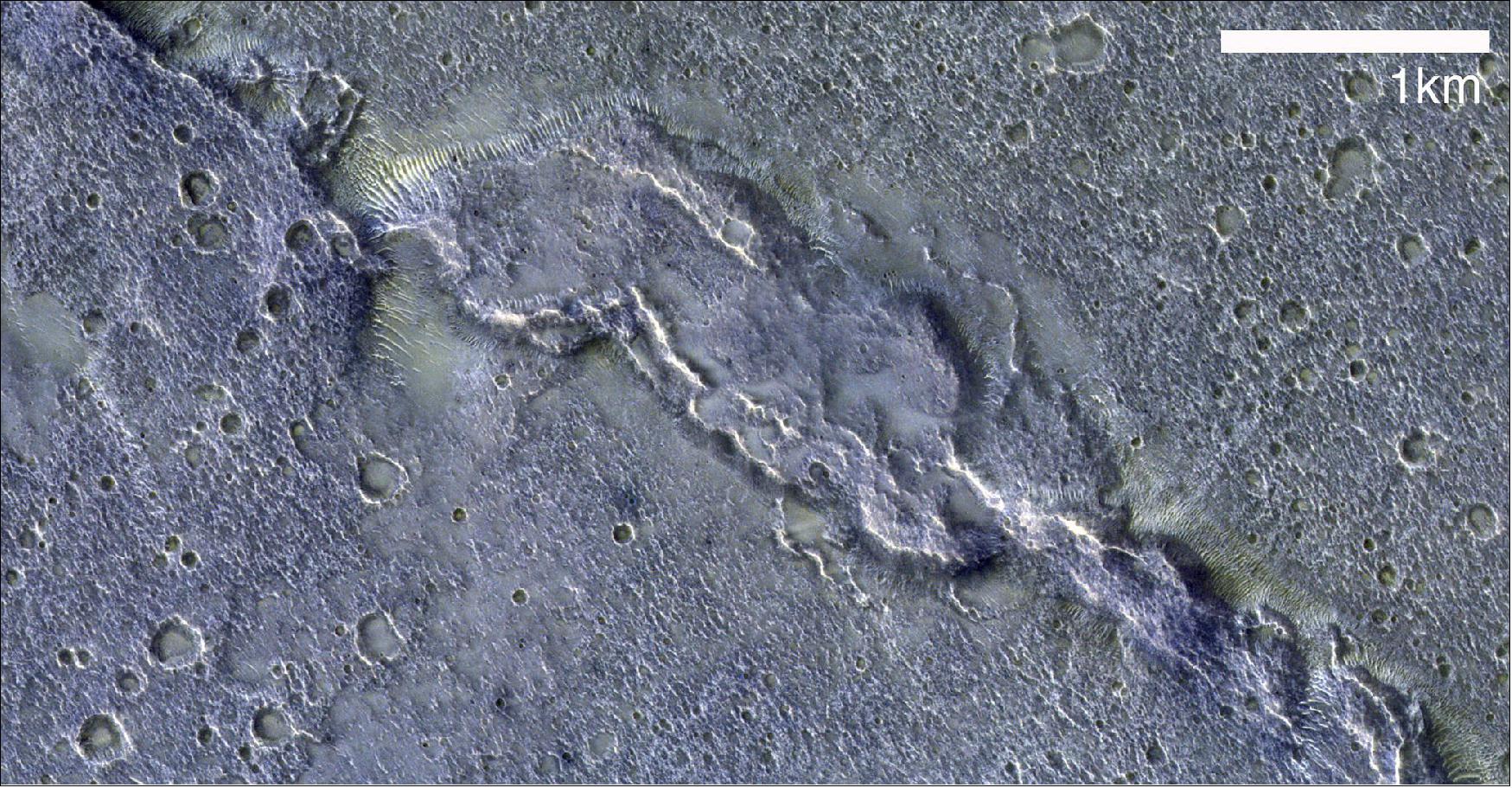
- The study of wrinkle ridges, and in particular their distribution and orientation, can reveal details of the complex and dynamic geological history of Mars.
- The ExoMars program is a joint endeavor between ESA and Roscosmos.
• January 6, 2021: Frosty scenes in martian summer. The CASSIS camera onboard the ExoMars Trace Gas Orbiter captured remnant frost deposits in a region near Sisyphi Tholus, in the high southern latitudes of Mars (74ºS/246ºE). 49)

- The ExoMars program is a joint endeavor between ESA and Roscosmos.
• August 4, 2020: A new set of images captured this spring by CASSIS (Color and Stereo Surface Imaging System) on the ESA-Roscosmos ExoMars Trace Gas Orbiter shows a series of interesting geological features on the surface of Mars, captured just as the planet passed its spring equinox. 50)
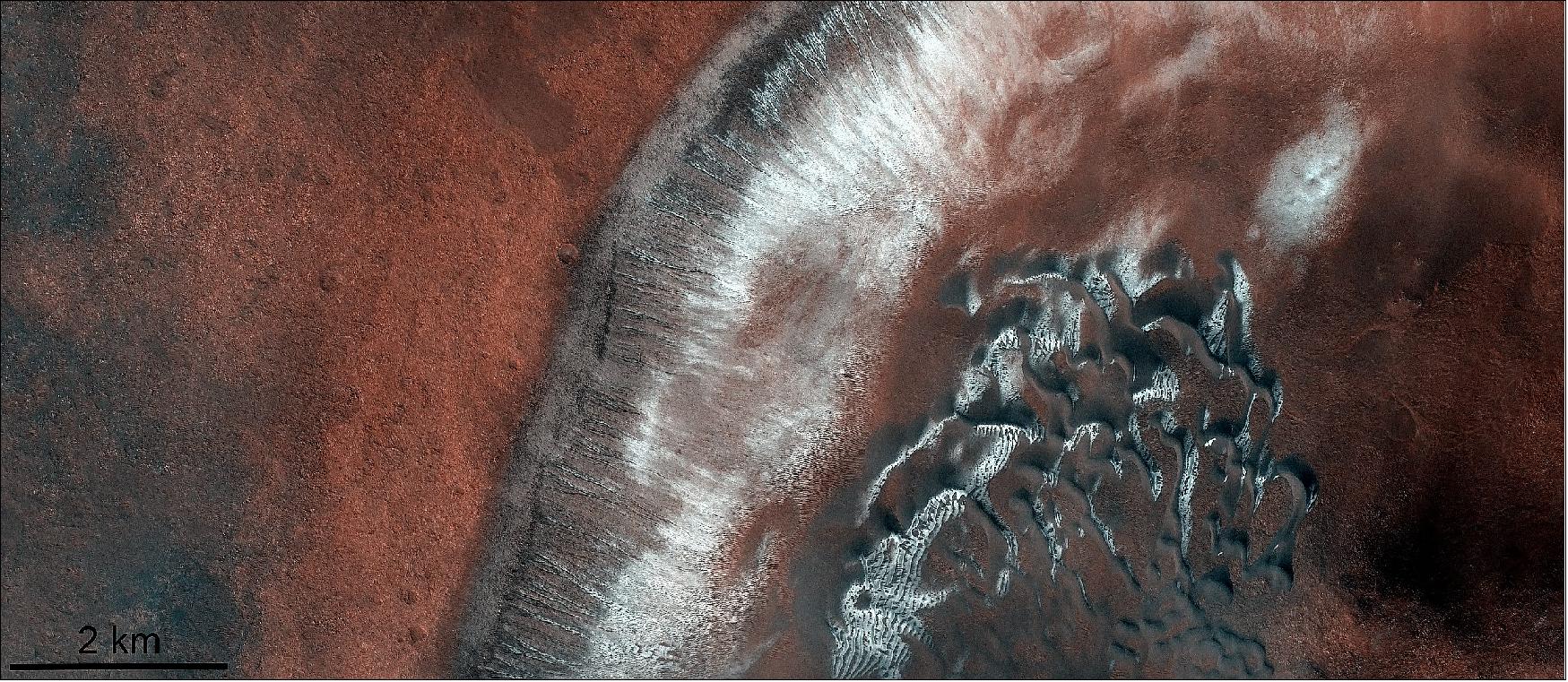
- The image of Figure 41 reveals an almost black dune field on the right, surrounded by red soils that are partially covered with bright white ice. Gullies, also partially covered with ice, are visible in the crater wall in the center of the image. Scientists are currently investigating the relationship between this seasonal ice and the presence of the gullies. The image was taken just after the spring equinox in the southern hemisphere of Mars, when the southernmost part of the crater (to the right) was almost completely free of ice while the northern part (center) was still partially covered. The southern crater wall has had a longer exposure to the Sun (like on Earth equator-facing slopes receive more sunlight), so the ice in this area recedes faster.

- In the center of the image (Figure 42) are dendritic structures which look like the veins on oak leaves. These structures, evidence of ancient river networks in this region, protrude from the surface, unlike channels, which are usually sunken in the surface. This is because the channels were filled with harder material – possibly lava – and over time the softer rocks surrounding these branching channels have been eroded, leaving an inverted imprint of this ancient river system.


- The beautiful color variations across the floor of Ius Chasma are caused by changes in rock composition. Scientists theorize that the light rocks are salts left behind after an ancient lake evaporated. The information about the rock's composition is useful to scientists as it allows them to retrace the formation history of the canyon.
• July 27, 2020: ESA’s ExoMars Trace Gas Orbiter has spotted new gas signatures at Mars. These unlock new secrets about the martian atmosphere, and will enable a more accurate determination of whether there is methane, a gas associated with biological or geological activity, at the planet. 51)
- The Trace Gas Orbiter (TGO) has been studying the Red Planet from orbit for over two years. The mission aims to understand the mixture of gases that make up the martian atmosphere, with a special focus on the mystery surrounding the presence of methane there.
- Meanwhile, the spacecraft has now spotted never-before-seen signatures of ozone (O3) and carbon dioxide (CO2), based on a full martian year of observations by its sensitive Atmospheric Chemistry Suite (ACS). The findings are reported in two new papers published in Astronomy & Astrophysics, one led by Kevin Olsen of the University of Oxford, UK and another led by Alexander Trokhimovskiy of the Space Research Institute (IKI) of the Russian Academy of Sciences in Moscow, Russia. 52) 53)
- These features are both puzzling and surprising,” says Kevin.
- They lie over the exact wavelength range where we expected to see the strongest signs of methane. Before this discovery, the CO2 feature was completely unknown, and this is the first time ozone on Mars has been identified in this part of the infrared wavelength range.”
- The martian atmosphere is dominated by CO2, which scientists observe to gauge temperatures, track seasons, explore air circulation, and more. Ozone – which forms a layer in the upper atmosphere on both Mars and Earth – helps to keep atmospheric chemistry stable. Both CO2 and ozone have been seen at Mars by spacecraft such as ESA’s Mars Express, but the exquisite sensitivity of the ACS instrument on TGO was able to reveal new details about how these gases interact with light.
- Observing ozone in the range where TGO hunts for methane is a wholly unanticipated result.
- Scientists have mapped how martian ozone varies with altitude before. So far, however, this has largely taken place via methods that rely upon the gas' signatures in the ultraviolet, a technique which only allows measurement at high altitudes (over 20 km above the surface).
- The new ACS results show that it is possible to map martian ozone also in the infrared, so its behavior can be probed at lower altitudes to build a more detailed view of ozone’s role in the planet’s climate.
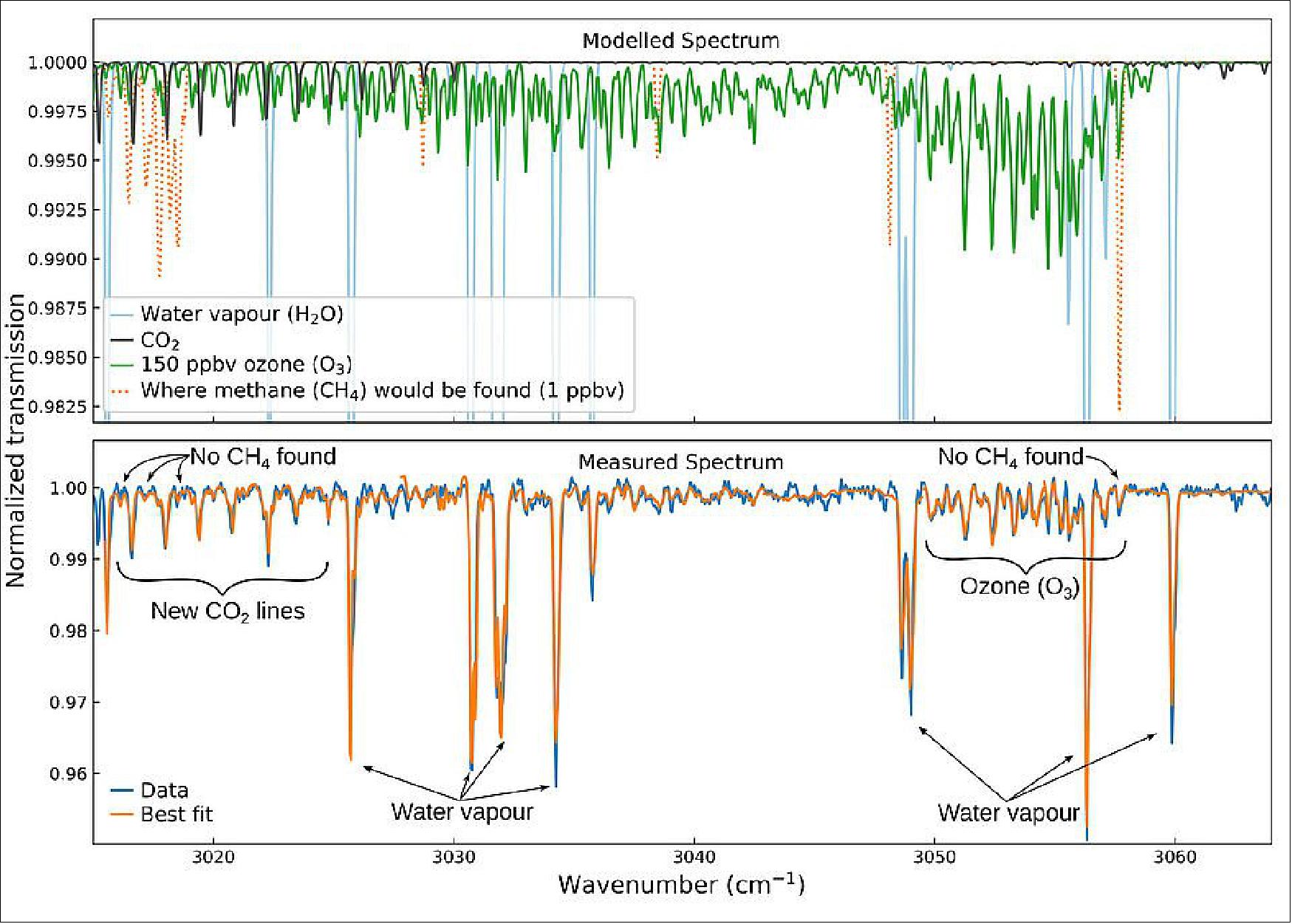
Unravelling the Methane Mystery
- One of the key objectives of TGO is to explore methane. To date, signs of martian methane – tentatively spied by missions including ESA’s Mars Express from orbit and NASA’s Curiosity rover on the surface – are variable and somewhat enigmatic.
- While also generated by geological processes, most of the methane on Earth is produced by life, from bacteria to livestock and human activity. Detecting methane on other planets is therefore hugely exciting. This is especially true given that the gas is known to break down in around 400 years, meaning that any methane present must have been produced or released in the relatively recent past.
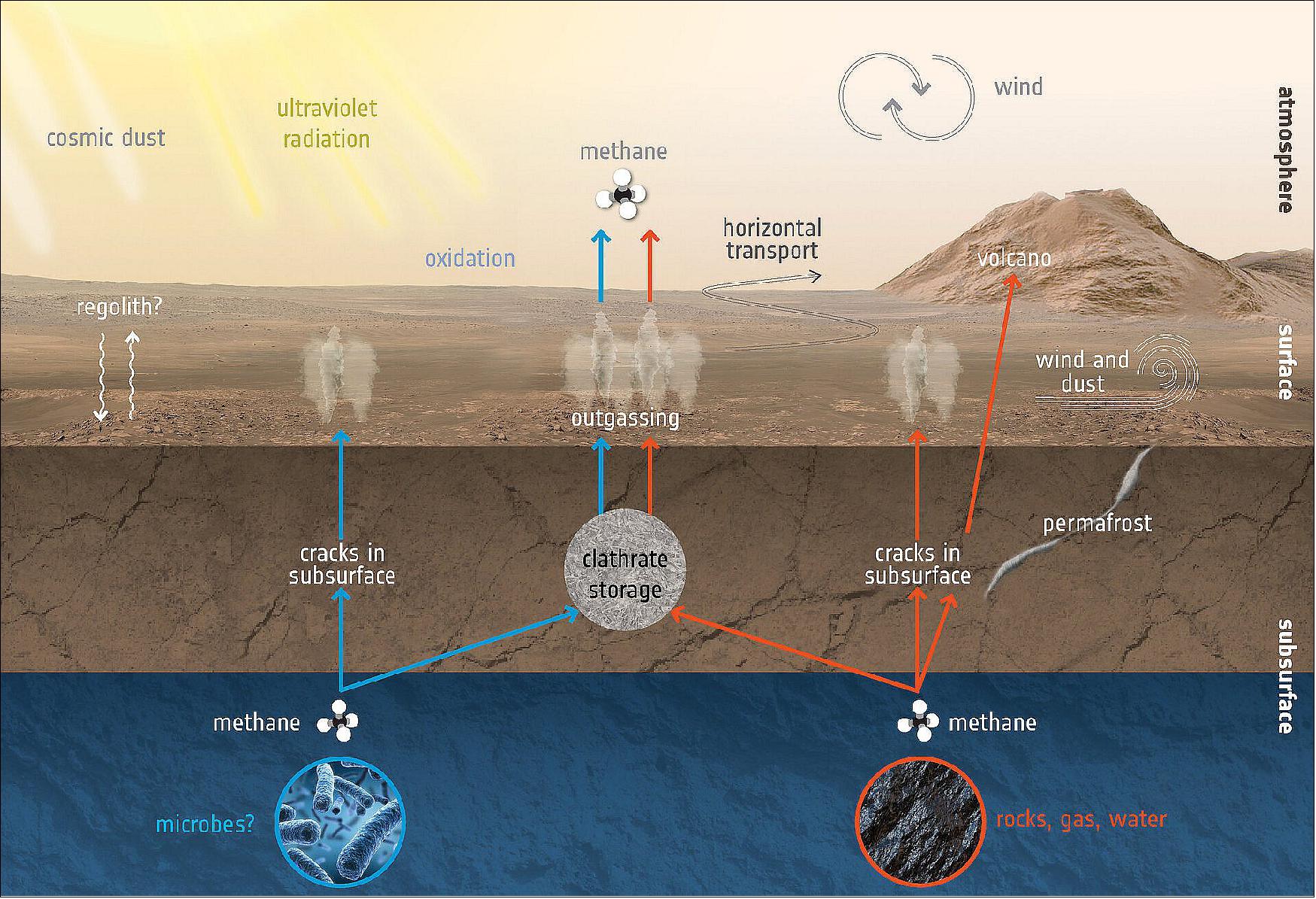
- Methane can also be generated by reactions between carbon dioxide and hydrogen (which, in turn, can be produced by reaction of water and olivine-rich rocks), by deep magmatic degassing or by thermal degradation of ancient organic matter. Again, this could be stored underground and outgassed through cracks in the surface. Methane can also become trapped in pockets of shallow ice, such as seasonal permafrost.
- Ultraviolet radiation can both generate methane – through reactions with other molecules or organic material already on the surface, such as comet dust falling onto Mars – and break it down. Ultraviolet reactions in the upper atmosphere (above 60 km) and oxidation reactions in the lower atmosphere (below 60 km) acts to transform methane into carbon dioxide, hydrogen and water vapor, and leads to a lifetime of the molecule of about 300 years.
- Methane can also be quickly distributed around the planet by atmospheric circulation, diluting its signal and making it challenging to identify individual sources. Because of the lifetime of the molecule when considering atmospheric processes, any detections today imply it has been released relatively recently.
- But other generation and destruction methods have been proposed which explain more localized detections and also allow a faster removal of methane from the atmosphere, closer to the surface of the planet. Dust is abundant in the lower atmosphere below 10 km and may play a role, along with interactions directly with the surface. For example, one idea is that methane diffuses or ‘seeps’ through the surface in localized regions, and is adsorbed back into the surface regolith. Another idea is that strong winds eroding the planet’s surface allows methane to react quickly with dust grains, removing the signature of methane. Seasonal dust storms and dust devils could also accelerate this process.
- Continued exploration at Mars – from orbit and the surface alike – along with laboratory experiments and simulations, will help scientists to better understand the different processes involved in generating and destroying methane.
- “Discovering an unforeseen CO2 signature where we hunt for methane is significant,” says Alexander Trokhimovskiy. “This signature could not be accounted for before, and may therefore have played a role in detections of small amounts of methane at Mars.”
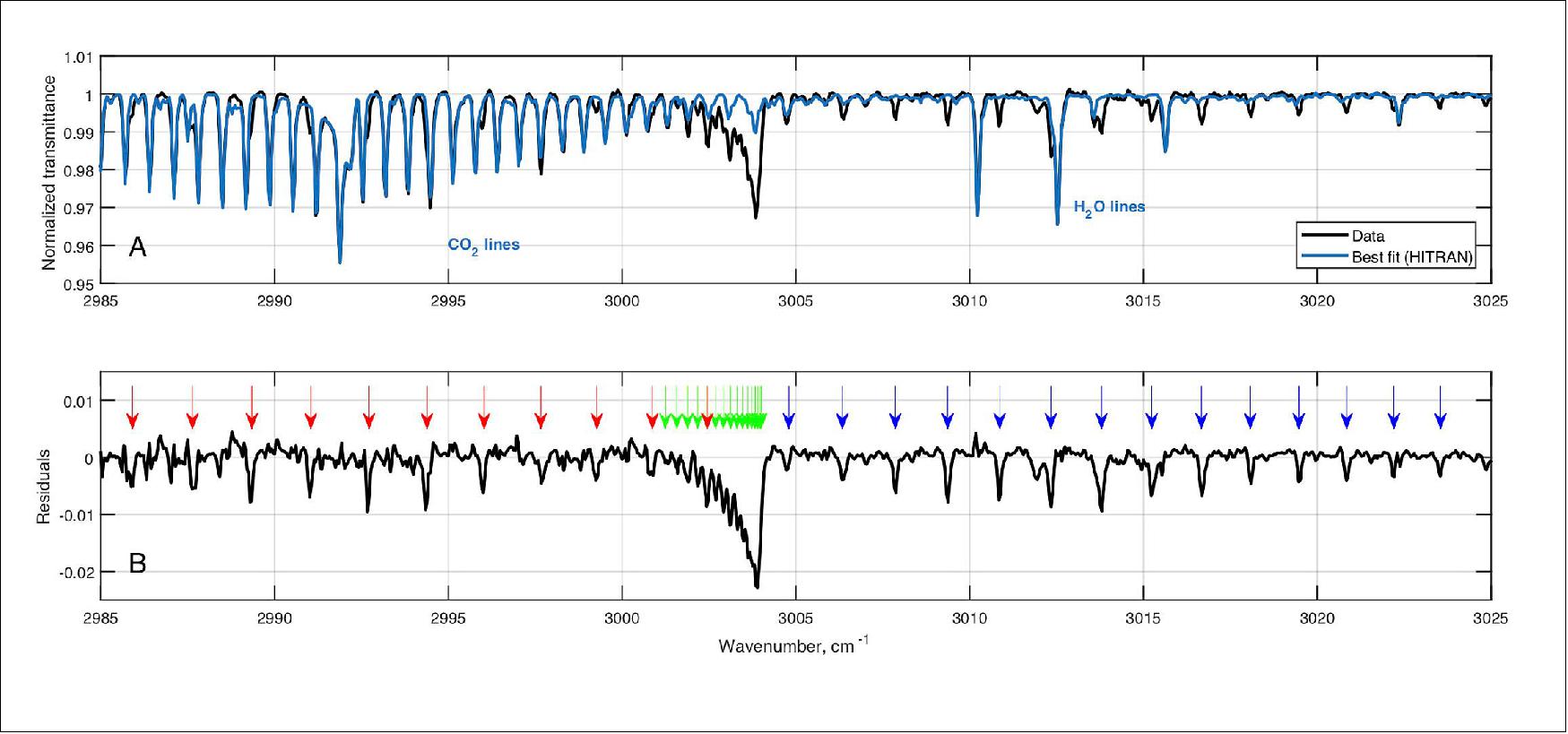
- The observations analyzed by Alexander, Kevin and colleagues were mostly performed at different times to those supporting detections of martian methane. Besides, the TGO data cannot account for large plumes of methane, only smaller amounts – and so, currently, there is no direct disagreement between missions.
- “In fact, we’re actively working on coordinating measurements with other missions,” clarifies Kevin. “Rather than disputing any previous claims, this finding is a motivator for all teams to look closer – the more we know, the more deeply and accurately we can explore Mars’ atmosphere.”
Realizing the Potential of ExoMars
- Methane aside, the findings highlight just how much we will learn about Mars as a result of the ExoMars program.
- “These findings enable us to build a fuller understanding of our planetary neighbor,” adds Alexander.
- “Ozone and CO2 are important in Mars’ atmosphere. By not accounting for these gases properly, we run the risk of mischaracterizing the phenomena or properties we see.”
- Additionally, the surprising discovery of the new CO2 band at Mars, never before observed in the laboratory, provides exciting insight for those studying how molecules interact both with one another and with light – and searching for the unique chemical fingerprints of these interactions in space.
- “Together, these two studies take a significant step towards revealing the true characteristics of Mars: towards a new level of accuracy and understanding,” says Alexander.
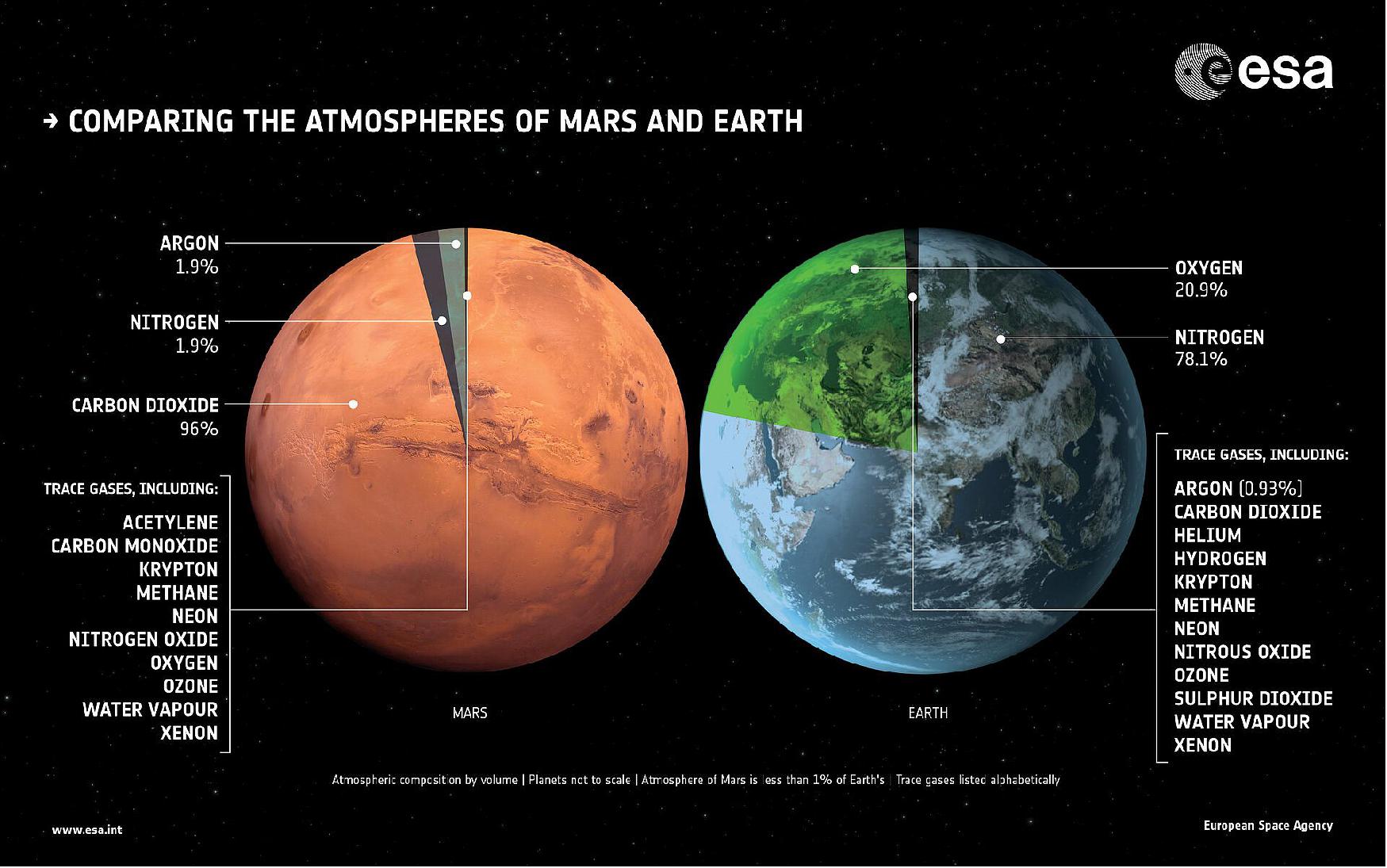
- Understanding if life could have ever existed in such conditions is one of the hot topics of Mars exploration, and for the ESA–Roscosmos ExoMars mission. The ExoMars Trace Gas Orbiter is capable of sniffing out the composition of the planet’s trace gases – which make up less than 1% by volume of a planet’s atmosphere – in minute amounts. Although making up a very small amount of the overall atmospheric inventory, methane in particular holds key clues to the planet’s current state of activity.
- On Earth, living organisms release much of the planet’s methane. It is also the main component of naturally occurring hydrocarbon gas reservoirs, and a contribution is also provided by volcanic and hydrothermal activity. Because of the key role natural biology plays in Earth’s methane production, confirming the existence of methane on Mars, and distinguishing between its potential sources, is a top priority of the ExoMars Trace Gas Orbiter.
Successful Collaboration in the Hunt for Life
- As its name suggests, the TGO aims to characterize any trace gases in Mars’ atmosphere that could arise from active geological or biological processes on the planet, and identify their origin.
- The ExoMars program consists of two missions: TGO, which was launched in 2016 and will be joined by the Rosalind Franklin rover and the Kazachok landing platform, due to lift off in 2022. These will take instruments complementary to ACS to the martian surface, examining the planet’s atmosphere from a different perspective, and share the core objective of the ExoMars program: to search for signs of past or present life on the Red Planet.
- “These findings are the direct result of hugely successful and ongoing collaboration between European and Russian scientists as part of ExoMars,” says ESA TGO Project Scientist Håkan Svedhem.
- “They set new standards for future spectral observations, and will help us to paint a more complete picture of Mars’ atmospheric properties – including where and when there may be methane to be found, which remains a key question in Mars exploration.”
- “Additionally, these findings will prompt a thorough analysis of all the relevant data we’ve collected to date – and the prospect of new discovery in this way is, as always, very exciting. Each piece of information revealed by the ExoMars Trace Gas Orbiter marks progress towards a more accurate understanding of Mars, and puts us one step closer to unravelling the planet’s lingering mysteries.”
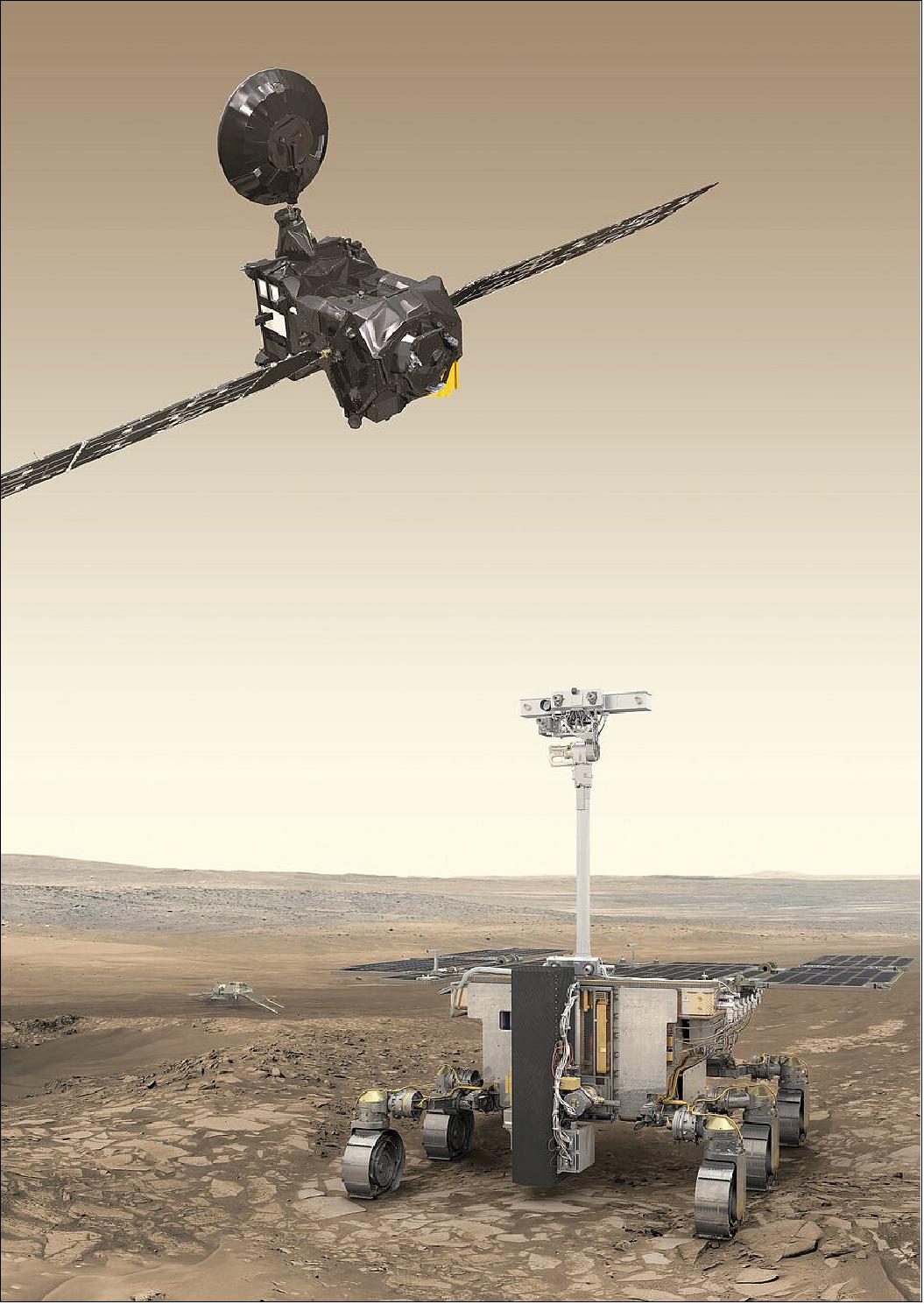
• June 15, 2020: ESA’s ExoMars Trace Gas Orbiter has detected glowing green oxygen in Mars’ atmosphere – the first time that this emission has been seen around a planet other than Earth. 54)
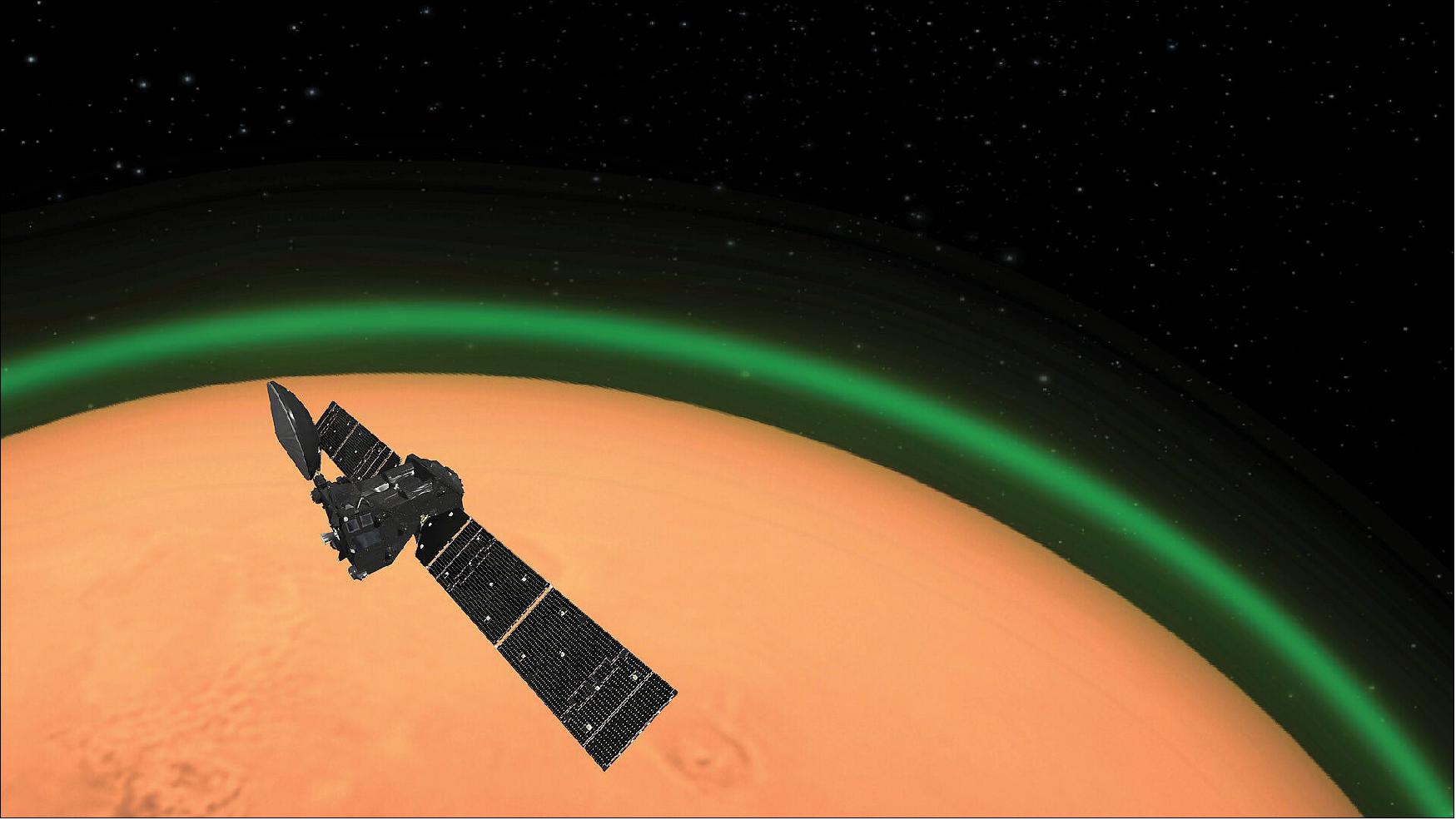
- On Earth, glowing oxygen is produced during polar auroras when energetic electrons from interplanetary space hit the upper atmosphere. This oxygen-driven emission of light gives polar auroras their beautiful and characteristic green hue.
- The aurora, however, is just one way in which planetary atmospheres light up. The atmospheres of planets including Earth and Mars glow constantly during both day and night as sunlight interacts with atoms and molecules within the atmosphere. Day and night glow are caused by slightly different mechanisms: night glow occurs as broken-apart molecules recombine, whereas day glow arises when the Sun’s light directly excites atoms and molecules such as nitrogen and oxygen.
- On Earth, green night glow is quite faint, and so is best seen by looking from an ‘edge on’ perspective – as portrayed in many spectacular images taken by astronauts aboard the International Space Station (ISS). This faintness can be an issue when hunting for it around other planets, as their bright surfaces can drown it out.
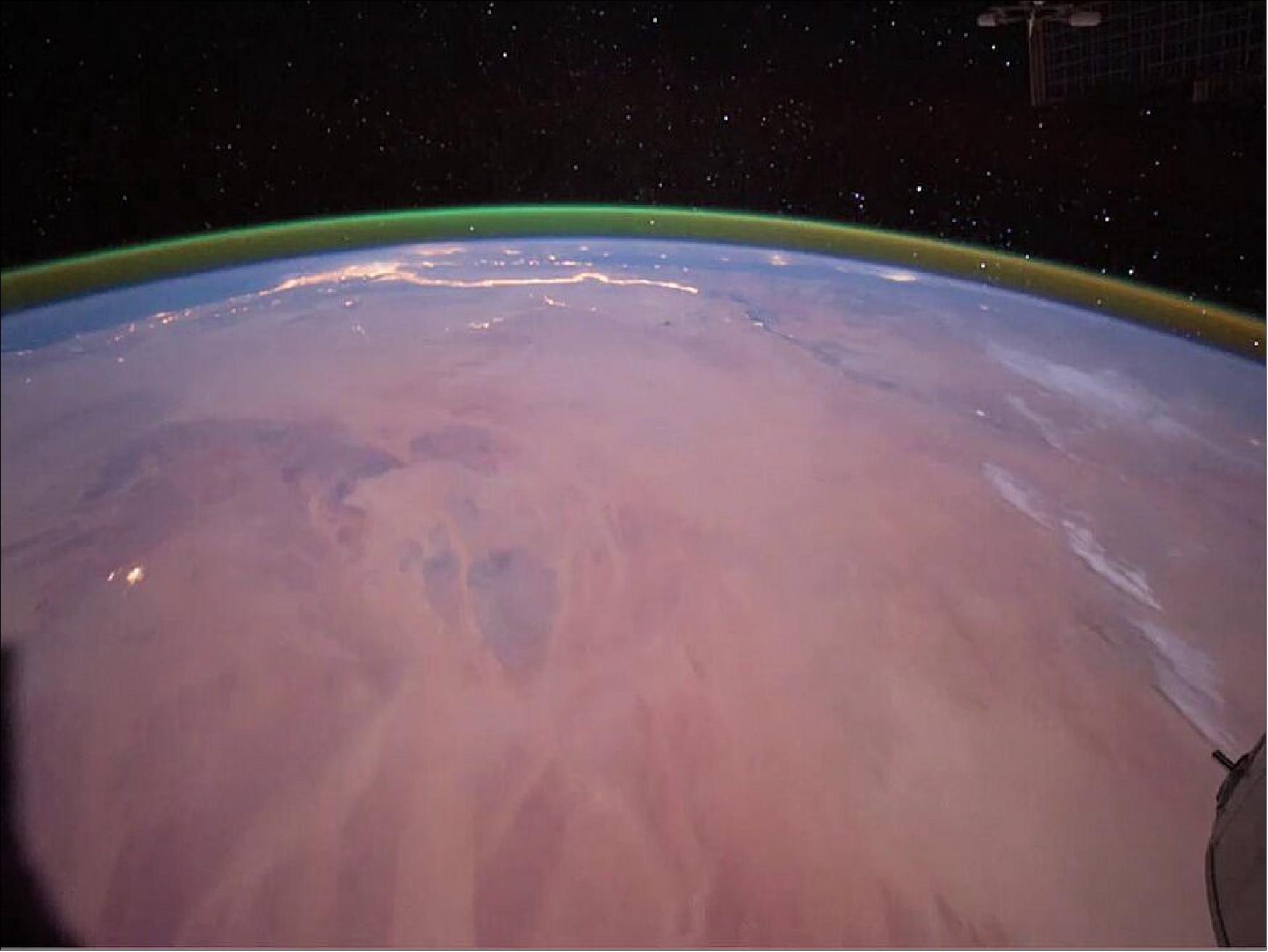
- This green glow has now been detected for the first time at Mars by the ExoMars Trace Gas Orbiter (TGO), which has been orbiting Mars since October 2016.
- “One of the brightest emissions seen on Earth stems from night glow. More specifically, from oxygen atoms emitting a particular wavelength of light that has never been seen around another planet,” says Jean-Claude Gérard of the Université de Liège, Belgium, and lead author of the new study published in Nature Astronomy.
- “However, this emission has been predicted to exist at Mars for around 40 years – and, thanks to TGO, we’ve found it.”
- Jean-Claude and colleagues were able to spot this emission using a special observing mode of the TGO. One of the orbiter’s advanced suite of instruments, known as NOMAD (Nadir and Occultation for Mars Discovery) and including the ultraviolet and visible spectrometer (UVIS), can observe in various configurations, one of which positions its instruments to point directly down at the martian surface – also referred to as the ‘nadir’ channel.
- “Previous observations hadn’t captured any kind of green glow at Mars, so we decided to reorient the UVIS nadir channel to point at the ‘edge’ of Mars, similar to the perspective you see in images of Earth taken from the ISS,” adds co-author Ann Carine Vandaele of the Institut Royal d'Aéronomie Spatiale de Belgique, Belgium, and Principal Investigator of NOMAD.
- Between 24 April and 1 December 2019, Jean-Claude, Ann Carine and colleagues used NOMAD-UVIS to scan altitudes ranging from 20 to 400 km from the martian surface twice per orbit. When they analyzed these datasets, they found the green oxygen emission in all of them.
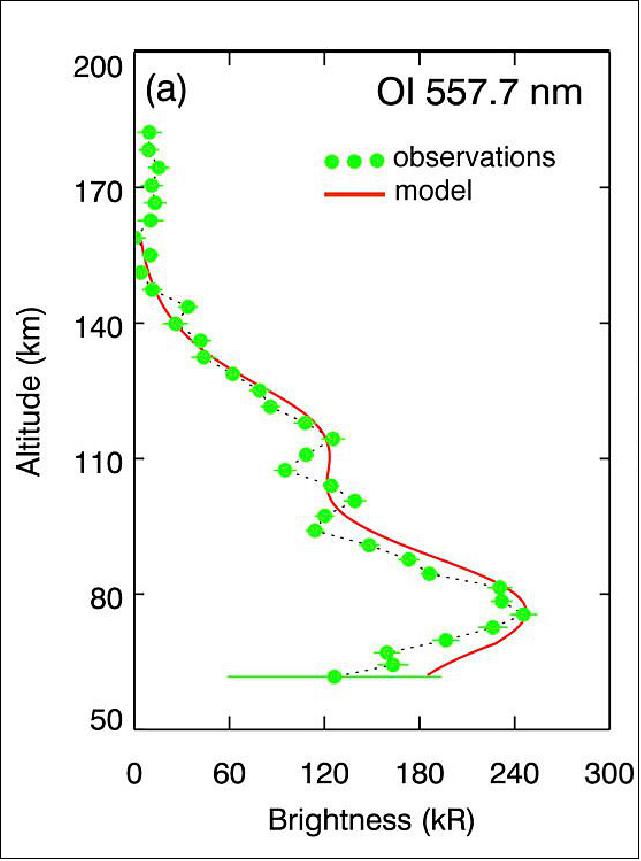
- “The emission was strongest at an altitude of around 80 kilometers and varied depending on the changing distance between Mars and the Sun,” adds Ann Carine.
- Studying the glow of planetary atmospheres can provide a wealth of information about the composition and dynamics of an atmosphere, and reveal how energy is deposited by both the Sun’s light and the solar wind – the stream of charged particles emanating from our star.
- To better understand this green glow at Mars, and compare it to what we see around our own planet, Jean-Claude and colleagues dug further into how it was formed.
- “We modelled this emission and found that it’s mostly produced as carbon dioxide, or CO2, is broken up into its constituent parts: carbon monoxide and oxygen,” says Jean-Claude. “We saw the resulting oxygen atoms glowing in both visible and ultraviolet light.”
- Simultaneously comparing these two kinds of emissions showed that the visible emission was 16.5 times more intense than the ultraviolet.
- “The observations at Mars agree with previous theoretical models but not with the actual glowing we’ve spotted around Earth, where the visible emission is far weaker,” adds Jean-Claude. “This suggests we have more to learn about how oxygen atoms behave, which is hugely important for our understanding of atomic and quantum physics.”
- This understanding is key to characterizing planetary atmospheres and related phenomena – such as auroras. By deciphering the structure and behavior of this green glowing layer of Mars’ atmosphere, scientists can gain insight into an altitude range that has remained largely unexplored, and monitor how it changes as the Sun’s activity varies and Mars travels along its orbit around our star.
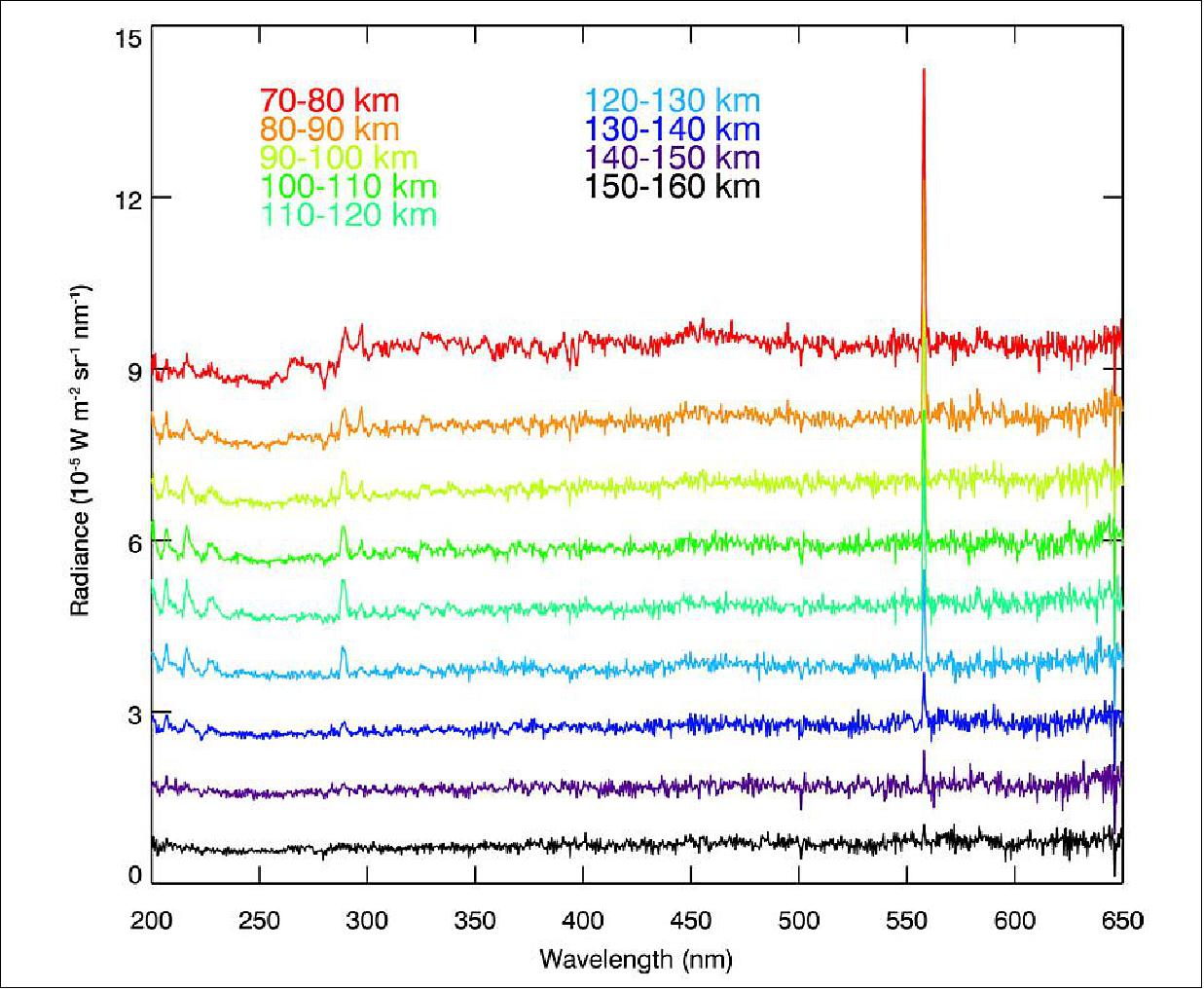
- “This is the first time this important emission has ever been observed around another planet beyond Earth, and marks the first scientific publication based on observations from the UVIS channel of the NOMAD instrument on the ExoMars Trace Gas Orbiter,” highlights Håkan Svedhem, ESA’s TGO Project Scientist.
- “It demonstrates the remarkably high sensitivity and optical quality of the NOMAD instrument. This is especially true given that this study explored the dayside of Mars, which is much brighter than the nightside, thus making it even more difficult to spot this faint emission.”
- Understanding the properties of Mars’ atmosphere is not only interesting scientifically, but is also key to operate the missions we send to the Red Planet. Atmospheric density, for example, directly affects the drag experienced by orbiting satellites and by the parachutes used to deliver probes to the martian surface.
- “This type of remote-sensing observation, coupled with in situ measurements at higher altitudes, helps us to predict how the martian atmosphere will respond to seasonal changes and variations in solar activity,” adds Håkan. “Predicting changes in atmospheric density is especially important for forthcoming missions, including the ExoMars 2022 mission that will send a rover and surface science platform to explore the surface of the Red Planet.” 55)
• January 17, 2020: Water reaches Mars' upper atmosphere. Mars once hosted abundant water on its surface but subsequently lost most of it to space. Small amounts of water vapor are still present in the atmosphere, which can escape if they reach sufficiently high altitudes. Fedorova et al. used data from the ExoMars Trace Gas Orbiter spacecraft to determine the distribution of water in Mars' atmosphere and investigate how it varies over seasons. Water vapor is sometimes heavily saturated, and its distribution is affected by the planet's large dust storms. Water can efficiently reach the upper atmosphere when Mars is in the warmest part of its orbit, and this behavior may have controlled the overall rate at which Mars lost its water. 56)
- Mars once harbored an active hydrological cycle, as demonstrated by geological features on its surface, but it no longer holds the quantity of water required to produce such geological imprints . 57) The planet’s bulk inventory of water amounts to a global equivalent layer (GEL) of ~30 m, mostly contained in its polar ice caps. This is less than 10% of the water that once flowed on the surface. Mars’ enhanced concentration of heavy water (semiheavy water five or more times the terrestrial standard), strengthens the hypothesis that most of Mars’ primordial water has escaped over time.
- Water in the atmosphere is a negligible component of the planet’s total water inventory, being equivalent to a global layer 10 µm thick, but nevertheless regulates the dissipation of water over time. Most martian water has been lost to space because its decomposition products (atomic hydrogen and oxygen) reach the upper atmosphere, where they can acquire sufficient thermal energy to overcome the low gravity of Mars (which is about one-third that of Earth’s). Water decomposition is theorized to follow a complex reaction chain involving the recombination of H atoms into H2 on a time scale of centuries, buffering any short-term hydrogen abundance variations. This mechanism has been challenged by observations showing that freshly produced H atoms can reach the exosphere (the uppermost layer where the atmosphere thins out and exchanges matter with interplanetary space) on a monthly time scale. The observed short-term variability of the hydrogen atoms populating the exosphere could be caused by direct deposition of water molecules at altitudes high enough to expose them to sunlight, which subsequently triggers a rapid enhancement of hydrogen atoms in the exosphere.
- Testing this hypothesis requires characterizing the mechanisms contributing to upward water propagation through large-scale atmospheric circulation. One such mechanism is the cold trap imposed (as on Earth) by water ice cloud formation at low altitude, subsequent to water condensation. The condensation is predicted to occur whenever the partial pressure of water vapor exceeds saturation. The vapor pressure law causes the cold trap efficiency to depend heavily on temperature, which eventually limits the amount of water that can be transported to higher altitudes.
- We investigate these processes using occultations of the Sun by the martian atmosphere (henceforth, solar occultations), where the vertical distributions of gases and particles can be directly observed. We used the Atmospheric Chemistry Suite (ACS) on the ExoMars Trace Gas Orbiter (TGO) spacecraft. 58) ACS is an assembly of three infrared spectrometers that together provide continuous spectral coverage from 0.7 to 17 µm, with a spectral resolving power ranging from 10,000 to 50,000. Our dataset was assembled by performing solar occultations with the near-infrared (NIR), mid-infrared (MIR), and thermal infrared in honor of professor V. I. Moroz (TIRVIM) channels of ACS. The NIR channel (0.7 to 1.7 µm) encompasses absorption bands of CO2, H2O, CO, and O2, diagnostic of their molecular concentrations over altitudes of 5 to 100 km, with a vertical resolution of 1 to 3 km. TIRVIM (2 to 17 µm) provides simultaneous information on dust and water ice particle abundance.
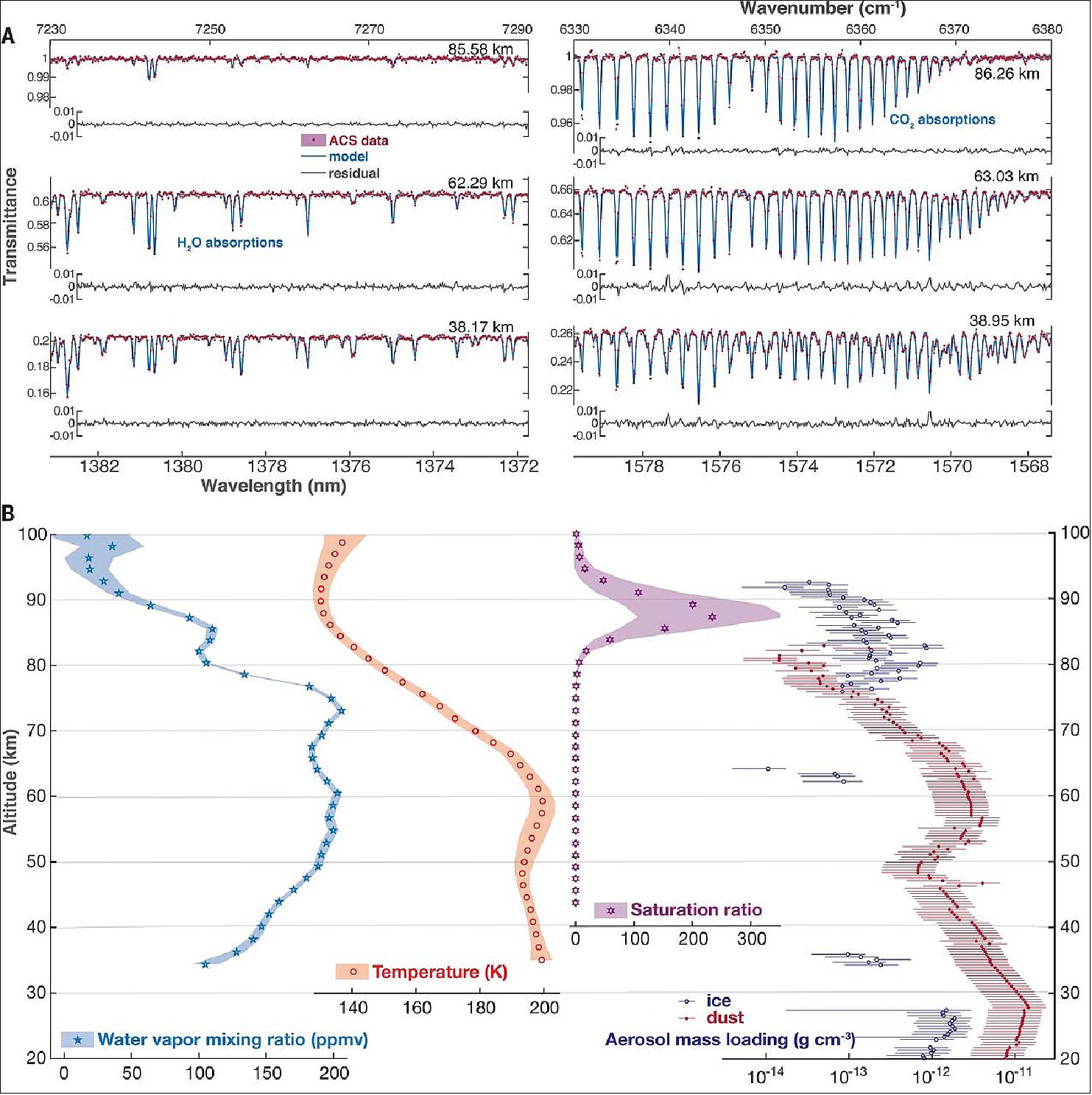
• December 20, 2019: Ice capping the northern hemisphere terrain of Mars slowly recedes as summer progresses, revealing the underlying surface. 59)
- At this time, it was mid-summer in the northern hemisphere of Mars: the carbon dioxide ice cover had retreated, revealing the permanent water ice deposits much more clearly, along with details of surfaces previously covered in ice.

• December 20, 2019: Many craters in the polar regions of Mars hold permanent ice deposits year-round. 60)

• December 20, 2019: The rim of this ice-rich crater catches the early morning sunlight in the high northern latitudes of Mars, imaged by the CaSSIS camera onboard ESA’s ExoMars Trace Gas Orbiter on 26 October 2019. 61)

- While the image was taken during the summer months, some shadowed regions receive fewer hours of sunlight on average throughout the year, so they trap permanent deposits of water ice.
- The image is centered at 230.77ºE/73.95ºN. It was taken on 26 October 2019. The scale is indicated on the image.
• September 16, 2019: Dunes come in various characteristic shapes on Mars just as on Earth, providing clues about the prevailing wind direction. Monitoring them over time also gives us a natural laboratory to study how dunes evolve, and how sediments in general are transported around the planet. 62)

- During winter in the polar regions, a thin layer of carbon dioxide ice covers the surface and then sublimates – turns directly from ice into vapor – with the first light of spring. In the dune fields, this springtime defrosting occurs from the bottom up, trapping gas between the ice and the sand. As the ice cracks, this gas is released violently and carries sand with it, forming the dark patches and streaks observed in this CaSSIS image.
- The image also captures ‘barchan’ dunes – the crescent or U-shaped dunes seen in the right of the image – as they join and merge into barchanoid ridges. The curved tips of the barchan dunes point downwind. The transition from barchan to barchanoid dunes tells us that secondary winds also play a role in shaping the dune field.
• May 30, 2019: On 15 June, the ESA-Roscosmos ExoMars Trace Gas Orbiter (TGO) will follow a different path. An ‘Inclination Change Maneuver’ will put the spacecraft in an altered orbit, enabling it to pick up crucial status signals from the ExoMars rover, Rosalind Franklin, due to land on the Red Planet in 2021. 63)
- After completing a complex series of maneuvers during 2017, ExoMars TGO is now orbiting the Red Planet every two hours, collecting scientific data from NASA’s surface-bound rover and lander, and relaying it back to Earth. At the same time, the orbiter is gathering its own data on the planet’s atmosphere, water abundance and alien surface.
- More than a year before Rosalind even lifts off from Earth’s surface, flight dynamics experts at ESA’s ESOC mission control center have formulated a long-term plan to ensure ExoMars TGO can communicate with the new ESA rover and surface platform, contained in the entry, descent and landing module.
- Slight changes to a spacecraft’s orbit have a large effect over time, so while the upcoming maneuvers will only slightly alter TGO’s speed, it will be in the right position to communicate with the then-incoming rover by 2021.
TGO's Natural Motion
- Mars’ uneven gravity field means that TGO’s orbit ‘wanders’, so it gradually rotates around Mars over time. As illustrated in this image, the spacecraft first follows the black path, then the green, then the red – continuing until it completes an entire rotation around the planet every four and a half months.
- To keep in touch with the descent module as it enters the Martian atmosphere, descends, and lands upon its surface, TGO’s orientation needs to change.
- Three maneuvers in the month of June will alter TGO’s speed, twice by 30.9 m/s and one final small change of 1.5 m/s, bringing it slightly closer to the Martian poles.
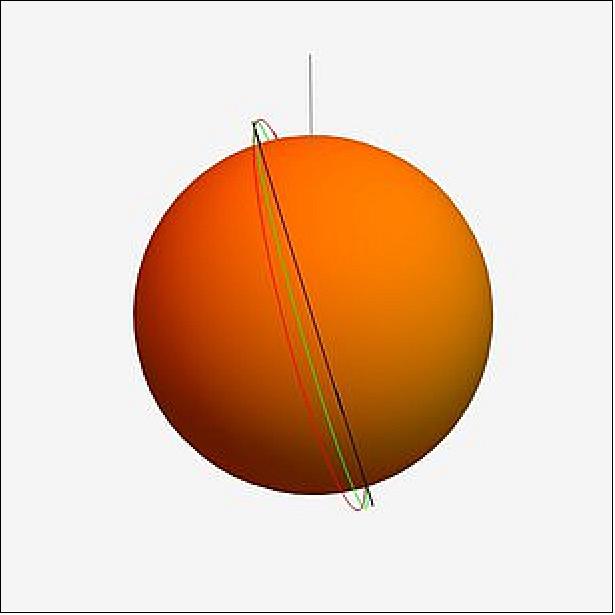
Inclined to Fly
- Thanks to these maneuvers, TGO’s path will look more like the second graphic shown here, illustrating ‘snapshots in time’ during the 2021 descent of the new rover. - The green line of Figure 60 represents Rosalind Franklin’s landing approach path. The black line shows the TGO orbit with its optimized orientation, two years after the upcoming maneuvers. The red path shows TGO’s original orbit.
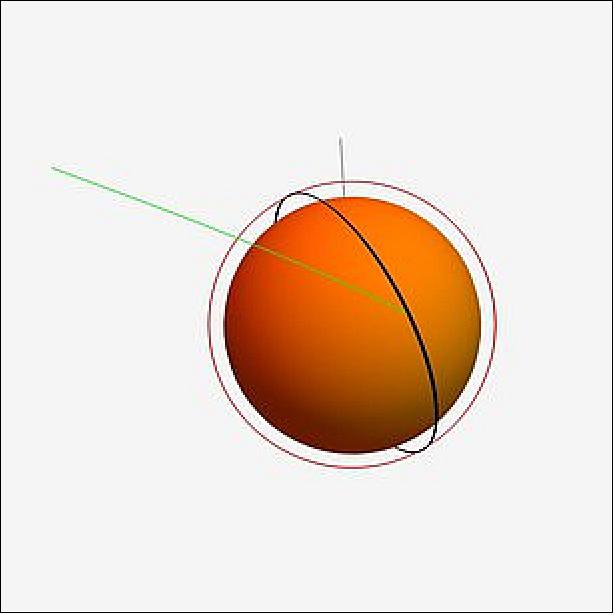
In-Phase with Rosalind Franklin
- Once TGO is set to orbit with its new, optimized orientation around Mars, teams on the ground must also ensure it will be on the correct side of the planet when the rover arrives – ‘in phase’ with Rosalind Franklin.
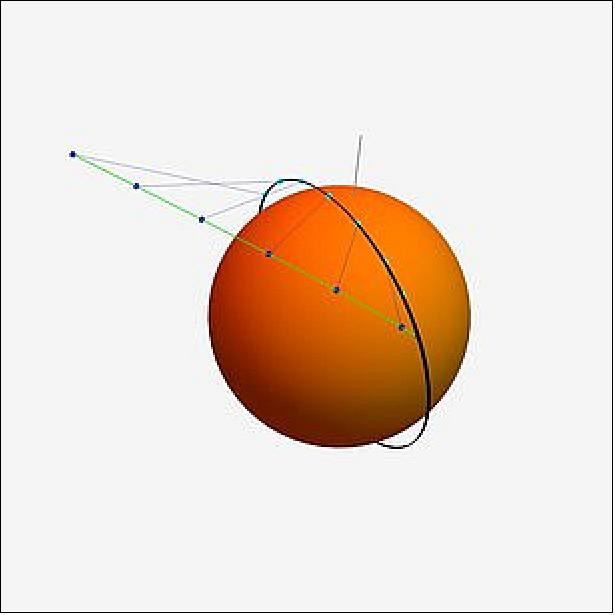
- In February 2021, a small maneuver will be performed to ensure TGO is in the right place at the right time for the lander's arrival. The result of all these maneuvers combined can be seen in Figure 61.
- The black line represents TGO’s orbit around Mars at the time Rosalind Franklin begins descending, shown by the green line. Blue dots along the orbits of both spacecraft are connected by horizontal lines, illustrating their relative positions at different time intervals, and how they are able to ‘see’ each other at every moment, thus ensuring that radio contact can be maintained.
Un-Phased
- If teams at mission control were to leave ExoMars TGO in its current orbit, without performing any maneuvers, Mars itself would later get between the orbiting spacecraft and the new Mars explorer.
- In Figure 62, the red line illustrates TGO’s un-phased orbit, and again the green line shows Rosalind Franklin’s entry path and Blue dots represent moments in time for each spacecraft. Lines between the dots reveal how in this scenario, Mars would block their view of each other.
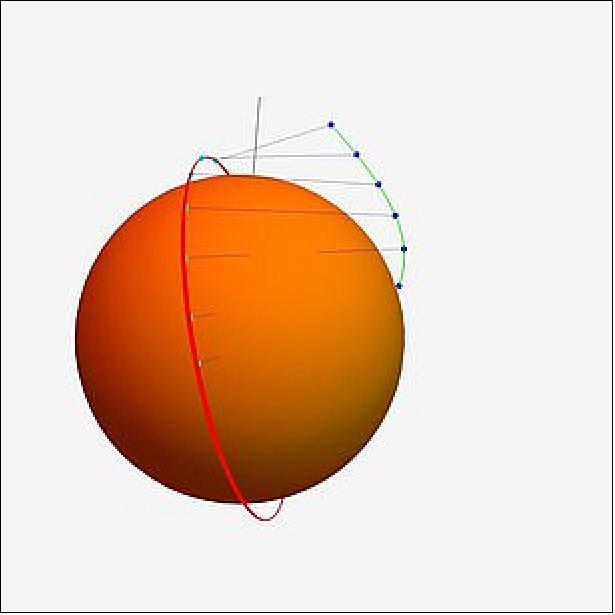
- Without phasing the orbiter with the Mars rover, the two craft will remain invisible to each other at the crucial moment when the rover descends to the surface.
- Not only does the foresight and long-term planning of mission experts ensure communication is maintained between two of ESA’s most important Mars missions, it saves fuel – a huge amount of which would be needed to get TGO in the right position in the weeks or even months before the ExoMars rover's arrival.
- ESA has demonstrated expertise in studying Mars from orbit, now we are looking to secure a safe landing, to rove across the surface and to drill underground to search for evidence of life. Our orbiters are already in place to provide data relay services for surface missions. The next logical step is to bring samples back to Earth, to provide access to Mars for scientists globally, and to better prepare for future human exploration of the Red Planet. This week we’re highlighting ESA’s contribution to Mars exploration as we ramp up to the launch of our second ExoMars mission, and look beyond to completing a Mars Sample Return mission.
• May 30, 2019: The ExoMars rover has a brand new control center in one of Europe’s largest Mars yards. The Rover Operations Control Center (ROCC) was inaugurated today in Turin, Italy, ahead of the rover’s exploration adventure on the Red Planet in 2021. 64)
- The control center will be the operational hub that orchestrates the roaming of the European-built laboratory on wheels, named after Rosalind Franklin, upon arrival to the martian surface on Kazachok, the Russian surface platform.
- “This is the crucial place on Earth from where we will listen to the rover’s instruments, see what she sees and send commands to direct the search for evidence of life on and under the surface,” said Jan Wörner, ESA’s Director General.
- The ExoMars rover will be the first of its kind to both move across the Mars surface and to study it at depth with a drill able to collect samples from down to two meters into the surface.
- The epicenter of the action for directing Mars surface operations on Earth is at the ALTEC (Aerospace Logistics Technology Engineering Company) SpA premises in Turin, Italy. From here, engineers and scientists will work shoulder to shoulder at mission control, right next to a very special Mars yard. Filled with 140 tons of soil, the Mars-like terrain has sandy areas and rocks of various sizes that will help rehearse possible mission scenarios.
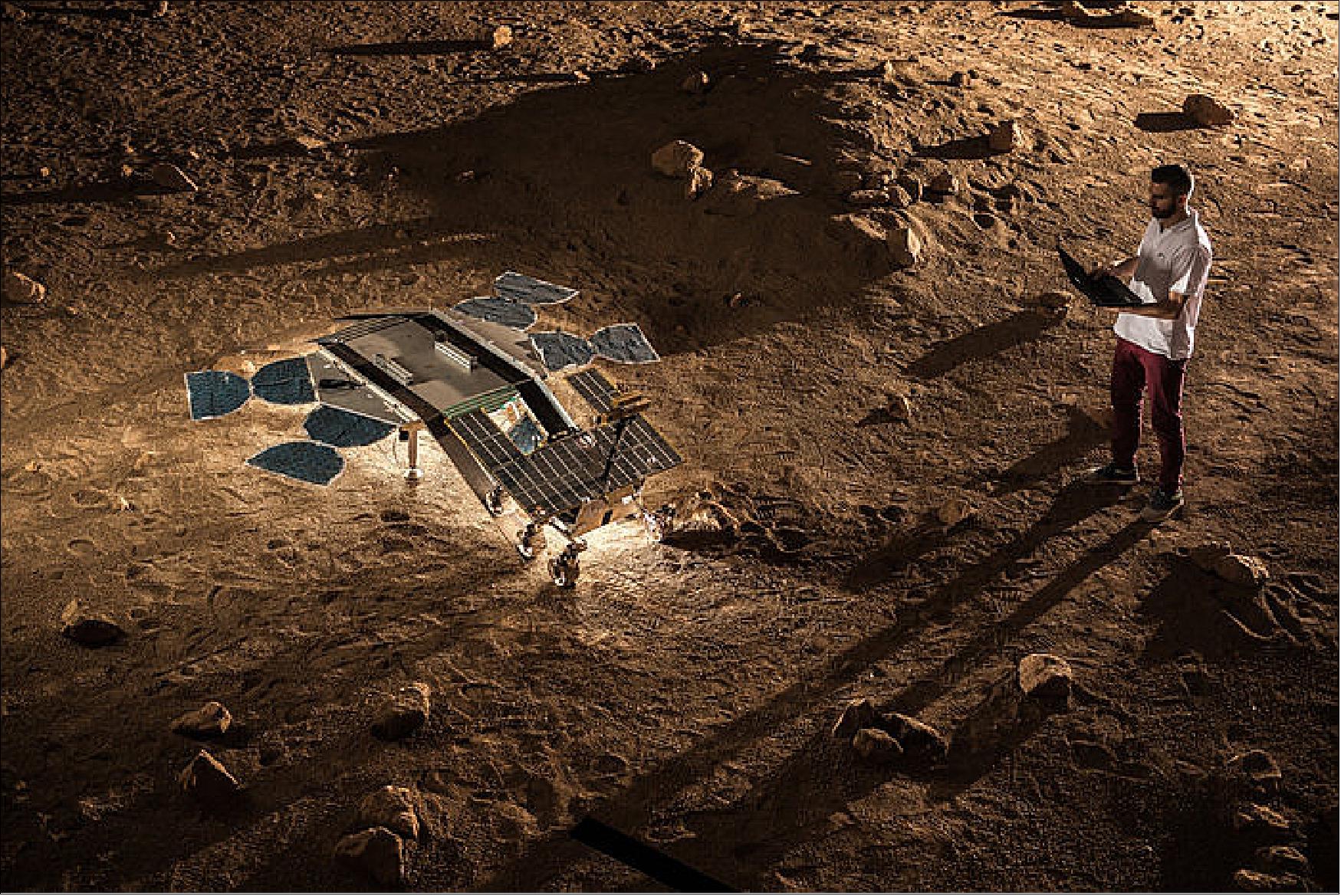
• May 29, 2019: Part of Aarhus University’s Mars Simulation Laboratory in Denmark, this wind tunnel has been specially designed to simulate the dusty surface of planet Mars. 65)
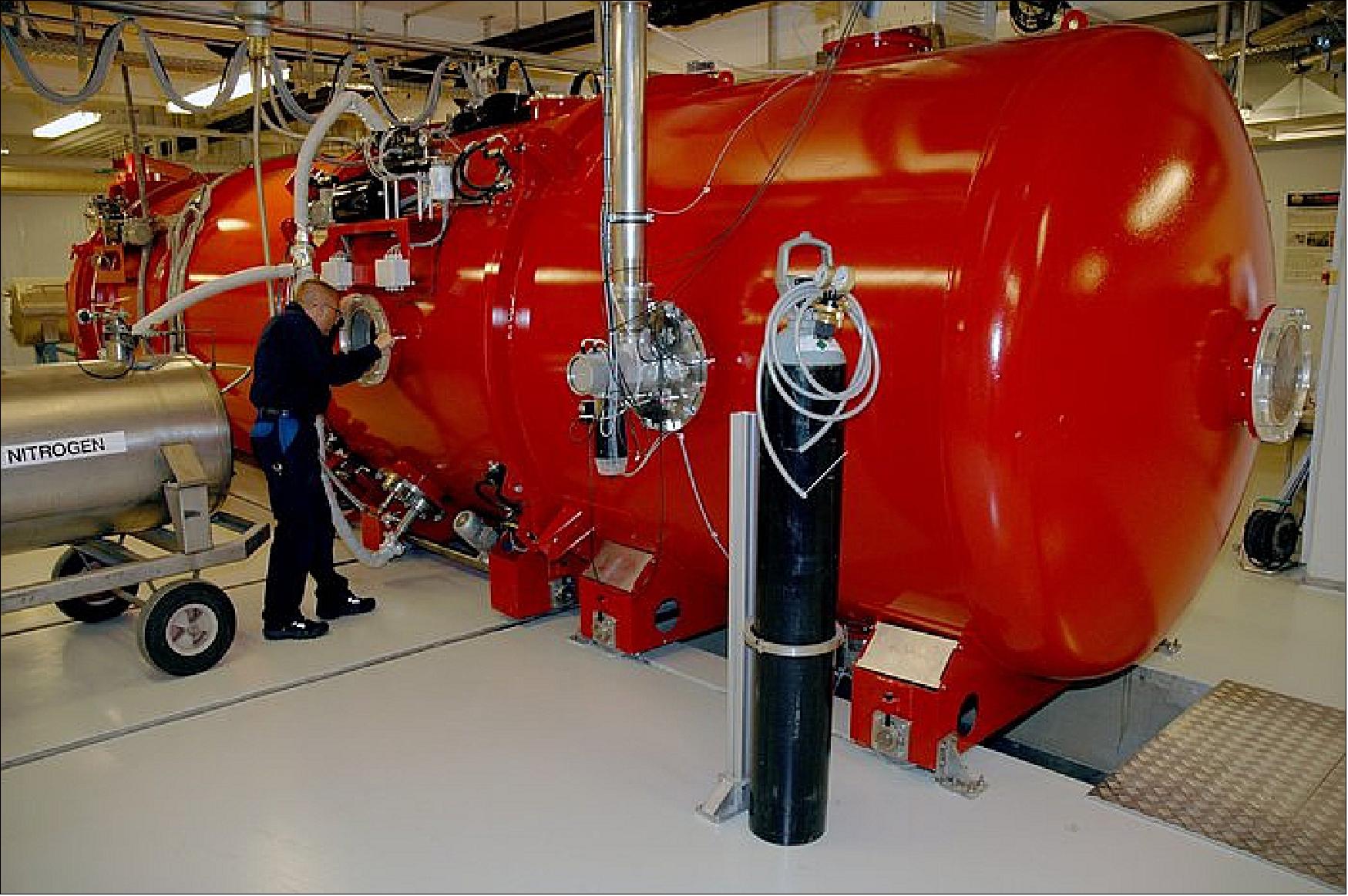
- The air pressure within the wind tunnel can be taken down to less than one hundredth of terrestrial sea level and the temperature reduced to as low as -170°C using liquid nitrogen. Fans then blow the scanty atmosphere that remains at up to 30 m/s, along with Mars-style dust.
- Researchers can evaluate how items such as sensors, solar panels and mechanical parts stand up to the clingy, abrasive particles, sourced from Mars-like, oxide-rich soil found in central Denmark.
- “We’ve been in operation all through this decade,” comments Jonathan Merrison of Aarhus University’s Department of Physics and Astronomy, overseeing the facility. “We’re the only wind tunnel that not only reproduces the low pressure and low temperatures of Mars, but also allows the introduction of particulates of sand and dust.
- “Probably about a third of the testing carried out here has been ExoMars related, then there have been users related to other Mars missions, as well as industrial testing of high altitude terrestrial equipment. We are also a member of the Europlanet network, a grouping of planetary scientists supported by the European Union, supporting the usage of various planetary simulation facilities and analogues.”
- The Aarhus Mars Simulation Wind Tunnel was based on a smaller, earlier version, which remains in use. Its development was supported by ESA’s Technology Development Element program for promising new technologies as well as the philanthropic Villum Kann Rasmussen Foundation.
• May 28, 2019: The ExoMars rover, named Rosalind Franklin, will be the first of its kind to both roam the Mars surface and to study it at depth. Rosalind Franklin will drill down to two meters into the surface to sample the soil, analyze its composition and search for evidence of past – and perhaps even present – life hidden underground. A miniature laboratory inside the rover – the ALD (Analytical Laboratory Drawer) – will analyze the samples with three different instruments, with some baked in the onboard oven to release gases for analysis, a technique used to search for traces of organic compounds. 66)
- The rover will relay its data back to Earth via the ExoMars Trace Gas Orbiter, which is already conducting its science mission from Mars orbit.
• May 28, 2019: There are few things better than the smell of freshly baked bread from the oven, this is because molecules in the bread disperse in the heat to reach your nose. In a similar way, the ExoMars rover Rosalind Franklin will ‘bake’ and ‘sniff’ martian samples in miniature ovens, imaged above, as part of its investigation of the extra-terrestrial world. 67)
- Set to land on Mars in 2021, Rosalind Franklin will scout areas of interest and drill up to 2 m below the surface and report back its findings to scientists on Earth. Nothing short of a miniature laboratory on wheels, the dirt that Rosalind Franklin collects will pass through different steps in an intricate process allowing for many types of analysis to get the best possible overview of the composition of Mars so far.
- MOMA (Mars Organic Molecule Analyzer) will heat samples to unlock the organic molecules from the Martian dust and transform them into the gas phase. The gas produced will then flow past a receptor that ‘sniffs’ the molecules to learn more about the sample, thanks to its gas chromatograph.
- Baked to up to 800°C in the pyrolysis ovens, the investigations are a one-shot affair. The samples are arranged around the circumference of a rotating carrousel, so that each tube can be placed under the sample funnel and positioned in the tapping station where the samples are ‘cooked’ and ‘sniffed’.
- The thumb-sized gold-colored tubes are hollow to hold the samples. At the tapping station a sphere pushes down on the oven rim to ensure an airtight seal during heating. The double golden pins are the connectors that send electricity running into the ovens.
- The silver-colored rod is a calibration target for a second component of MOMA dubbed ‘LDMS’ that uses laser heating (desorption) and mass spectrometry to analyze the samples. The rod is used to create a standard value for the laser on the Red Planet to ensure that LDMS is working correctly. Together MOMA’s gas chromatographer and LDMS will target biomarkers to answer questions related to the potential origin, evolution and distribution of life on Mars.
- Choosing when and where to take a Martian sample, and choosing which instrument to analyze the sample with, will be a discussion of interplanetary proportions for scientists, but that discussion will need to reach conclusions quickly: the ExoMars rover has 31 tubes to fill and analyze and is designed to work for 218 “sols” or Martian days.
- MOMA is built by a scientific consortium led by the Max-Planck-Institut für Sonnensystemforschung in Göttingen, Germany, with the gas chromatograph built by LISA (Laboratoire Interuniversitaire des Systèmes Atmosphériques) in Paris, France, and the LDMS by NASA’s Goddard Spaceflight Center in Greenbelt, USA. These miniature ovens are part of the rover on-board laboratory “ultra clean zone” that was designed by Thales Alenia Space in Italy, and mounted on a carrousel developed by OHB in Munich, Germany.
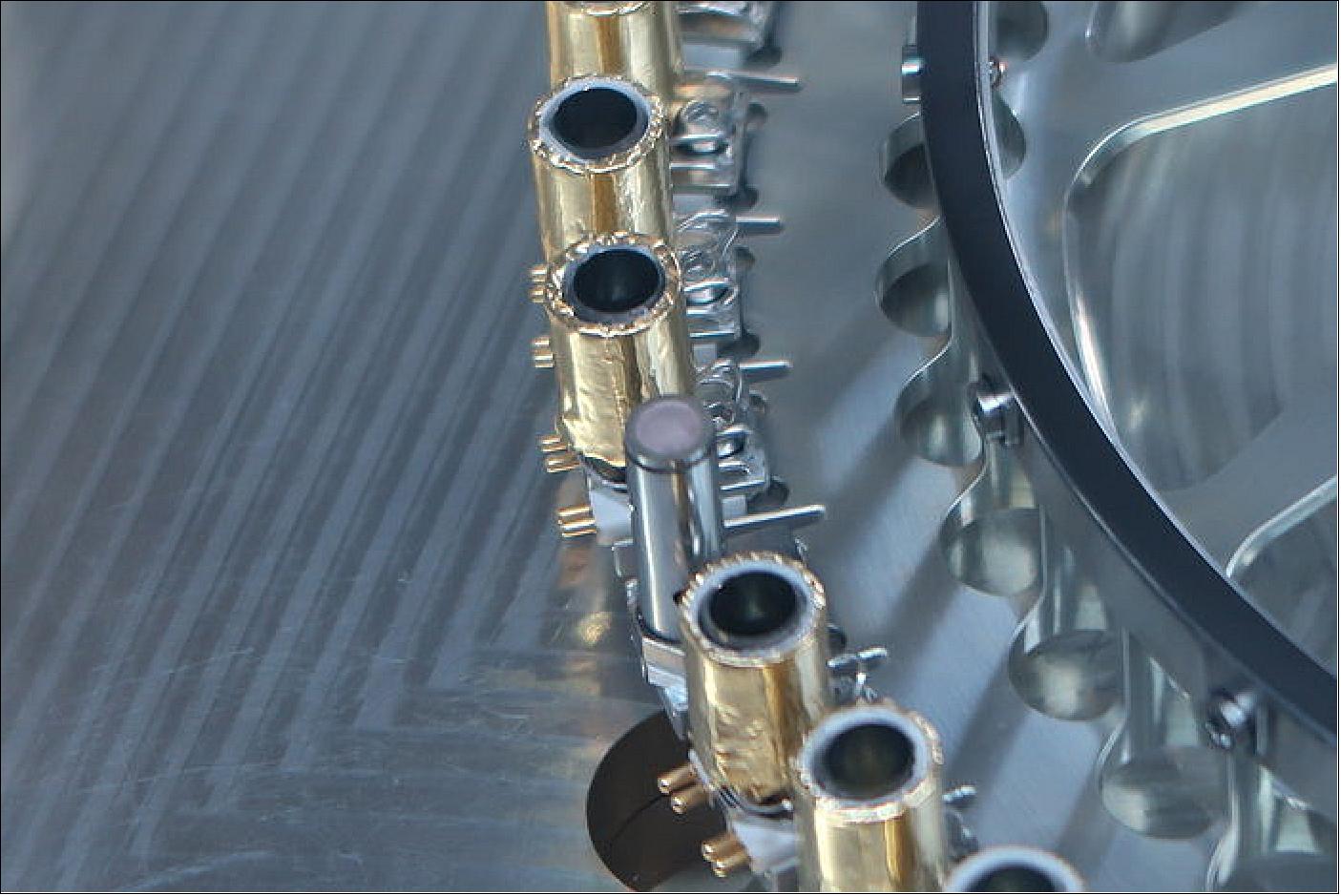
• April 10, 2019: New evidence of the impact of the recent planet-encompassing dust storm on water in the atmosphere, and a surprising lack of methane, are among the scientific highlights of the ExoMars Trace Gas Orbiter’s first year in orbit. 68)
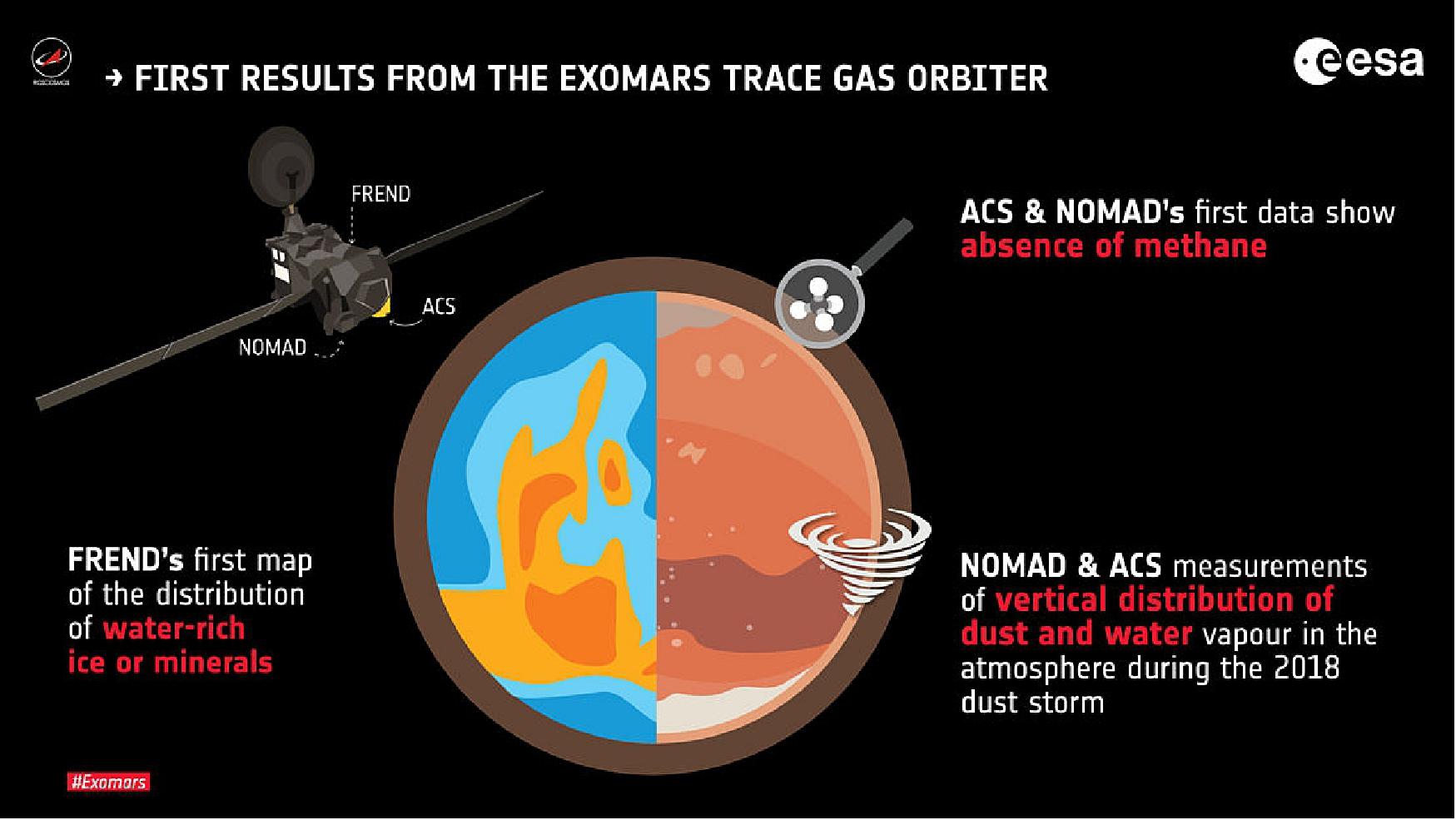
- TGO’s main science mission began at the end of April 2018, just a couple of months before the start of the global dust storm that would eventually lead to the demise of NASA’s Opportunity rover after 15 years roving the martian surface.
- Spacecraft in orbit, however, were able to make unique observations, with TGO following the onset and development of the storm and monitoring how the increase in dust affected the water vapor in the atmosphere – important for understanding the history of water at Mars over time. 69) 70)
Exploiting the Dust Storm
- Two spectrometers onboard – NOMAD and ACS – made the first high-resolution solar occultation measurements of the atmosphere, looking at the way sunlight is absorbed in the atmosphere to reveal the chemical fingerprints of its ingredients.
- This enabled the vertical distribution of water vapor and ‘semi-heavy’ water – with one hydrogen atom replaced by a deuterium atom, a form of hydrogen with an additional neutron – to be plotted from close to the martian surface to above 80 km altitude. The new results track the influence of dust in the atmosphere on water, along with the escape of hydrogen atoms into space.
- “In the northern latitudes we saw features such as dust clouds at altitudes of around 25–40 km that were not there before, and in southern latitudes we saw dust layers moving to higher altitudes,” says Ann Carine Vandaele, principal investigator of the NOMAD instrument at the Royal Belgian Institute for Space Aeronomy.
- “The enhancement of water vapor in the atmosphere happened remarkably quickly, over just a few days during the onset of the storm, indicating a swift reaction of the atmosphere to the dust storm.”
![Figure 68: TGO's main science mission began at the end of April 2018, just a couple of months before the start of the global dust storm that engulfed the planet. TGO followed the onset and development of the storm and monitored how the increase in dust affected the water vapor in the atmosphere [image credit: ESA; spacecraft: ATG/medialab; data: A-C Vandaele et al (2019)]](https://eoportal.org/ftp/satellite-missions/e/ExoMars_141122/ExoMars_Auto51.jpeg)
Legend to Figure 68: TGO made the first high-resolution solar occultation measurements with its two spectrometers ACS and NOMAD, by looking at the way sunlight is absorbed in the atmosphere to reveal the chemical fingerprints of its ingredients. This enabled the vertical distribution of water vapor and ‘semi-heavy’ water, to be plotted from close to the martian surface to above 80 km altitude – important for understanding the history of water at Mars over time. - The new results track the influence of dust in the atmosphere on water, and provide further insight into the escape of hydrogen atoms into space. The instruments also recorded dust and ice clouds appearing at different altitudes, and a quick enhancement of water vapor in the atmosphere.
- The observations are consistent with global circulation models. Dust absorbs the Sun’s radiation, heating the surrounding gas and causing it to expand, in turn redistributing other ingredients – like water – over a wider vertical range. A higher temperature contrast between equatorial and polar regions is also set up, strengthening atmospheric circulation. At the same time, thanks to the higher temperatures, fewer water-ice clouds form – normally they would confine water vapor to lower altitudes.
- The teams also made the first observation of semi-heavy water simultaneously with water vapor, providing key information on the processes that control the amount of hydrogen and deuterium atoms escaping to space. It also means the deuterium-to-hydrogen (D/H) ratio can be derived, which is an important marker for the evolution of the water inventory on Mars.
- “We see that water, deuterated or not, is very sensitive to the presence of ice clouds, preventing it from reaching atmospheric layers higher up. During the storm, water reached much higher altitudes,” says Ann Carine.“This was theoretically predicted by models for a long time but this is the first time we have been able to observe it.”
- Since the D/H ratio is predicted to change with the season and with latitude, TGO’s continued regional and seasonal measurements are expected to provide further evidence of the processes at play.
Methane Mystery Plot Thickens
- The two complementary instruments also started their measurements of trace gases in the martian atmosphere. Trace gases occupy less than one percent of the atmosphere by volume, and require highly precise measurement techniques to determine their exact chemical fingerprints in the composition. The presence of trace gases is typically measured in ‘parts per billion by volume’ (ppbv), so for the example for Earth’s methane inventory measuring 1800 ppbv, for every billion molecules, 1800 are methane.
- Methane is of particular interest for Mars scientists, because it can be a signature of life, as well as geological processes – on Earth, for example, 95% of methane in the atmosphere comes from biological processes. Because it can be destroyed by solar radiation on timescales of several hundred years, any detection of the molecule in present times implies it must have been released relatively recently – even if the methane itself was produced millions or billions of years ago and remained trapped in underground reservoirs until now. In addition, trace gases are mixed efficiently on a daily basis close to the planet’s surface, with global wind circulation models dictating that methane would be mixed evenly around the planet within a few months.
- Reports of methane in the martian atmosphere have been intensely debated because detections have been very sporadic in time and location, and often fell at the limit of the instruments’ detection limits. ESA’s Mars Express contributed one of the first measurements from orbit in 2004, at that time indicating the presence of methane amounting to 10 ppbv.
- Earth-based telescopes have also reported both non-detections and transient measurements up to about 45 ppbv, while NASA’s Curiosity rover, exploring Gale Crater since 2012, has suggested a background level of methane that varies with the seasons between about 0.2 and 0.7 ppbv – with some higher level spikes. More recently, Mars Express observed a methane spike one day after one of Curiosity’s highest-level readings.
![Figure 69: The ExoMars Trace Gas Orbiter’s first analysis of the martian atmosphere at various points around the globe finds an upper limit of methane 10–100 times less than all previous reported detections. The measured data show the sensitivity of the ACS and NOMAD instruments when looking at other molecules, such as water, while methane is apparently absent: the results suggest an upper limit of 0.05 parts per billion (ppbv), — The difference between TGO’s dataset and that of NASA’s Curiosity, which previously reported a seasonal background variation of methane, is presented, noting that the highest sensitivity of TGO’s measurements was achieved before the global dust storm that engulfed the planet in mid 2018, soon after the start of TGO’s science mission. A map with the locations where TGO’s detection attempts were made is also provided, with the majority of measurements taken over high latitudes. - To reconcile the differing results, a better understanding of the different mechanisms able to destroy methane close to the surface of the planet is needed [image credit: ESA; spacecraft: ATG/medialab; data: O. Korablev et al (2019)]](https://eoportal.org/ftp/satellite-missions/e/ExoMars_141122/ExoMars_Auto50.jpeg)
- The new results from TGO provide the most detailed global analysis yet, finding an upper limit of 0.05 ppbv, that is, 10–100 times less methane than all previous reported detections. The most precise detection limit of 0.012 ppbv was achieved at 3 km altitude.
- As an upper limit, 0.05 ppbv still corresponds to up to 500 tons of methane emitted over a 300 year predicted lifetime of the molecule when considering atmospheric destruction processes alone, but dispersed over the entire atmosphere, this is extremely low.
- “We have beautiful, high-accuracy data tracing signals of water within the range of where we would expect to see methane, but yet we can only report a modest upper limit that suggests a global absence of methane,” says ACS principal investigator Oleg Korablev from IKI (Space Research Institute), Russian Academy of Sciences, Moscow.
- “The TGO’s high-precision measurements seem to be at odds with previous detections; to reconcile the various datasets and match the fast transition from previously reported plumes to the apparently very low background levels, we need to find a method that efficiently destroys methane close to the surface of the planet.”
- “Just as the question of the presence of methane and where it might be coming from has caused so much debate, so the issue of where it is going, and how quickly it can disappear, is equally interesting,” says Håkan.
- “We don’t have all the pieces of the puzzle or see the full picture yet, but that is why we are there with TGO, making a detailed analysis of the atmosphere with the best instruments we have, to better understand how active this planet is – whether geologically or biologically.”
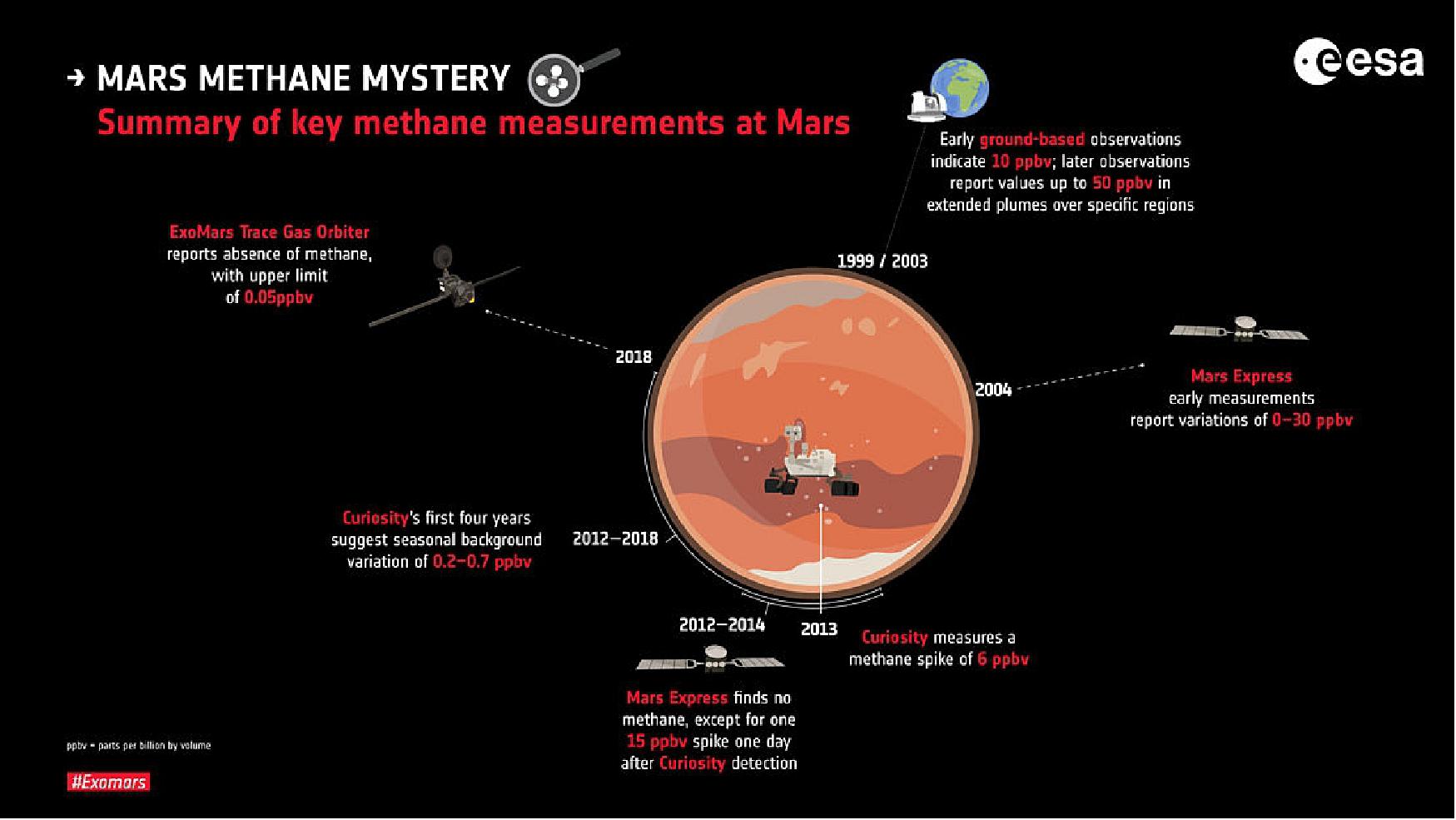
Best Map of Shallow Subsurface Water
- While the lively debate on the nature and presence of methane continues, one sure thing is that water once existed on Mars – and still does in the form of water-ice, or as water-hydrated minerals. And where there was water, there might have been life.
- To help understand the location and history of water on Mars, TGO’s neutron detector FREND is mapping the distribution of hydrogen in the uppermost meter of the planet’s surface. Hydrogen indicates the presence of water, being one of the constituents of the water molecule; it can also indicate water absorbed into the surface, or minerals that were formed in the presence of water.
- The instrument’s mapping task will take about one Mars year – almost two Earth years – to produce the best statistics to generate the highest quality map. But the first maps presented based on just a few month’s data already exceed the resolution of previous measurements.
![Figure 71: TGO’s first map of shallow subsurface water distribution on Mars. The FREND neutron spectrometer on the ExoMars Trace Gas Orbiter has started mapping the distribution of hydrogen in the uppermost meter of the martian’s surface. Hydrogen indicates the presence of water, being one of the constituents of the water molecule; it can also indicate water absorbed into the surface, or minerals that were formed in the presence of water. A map produced from 131 days data, from 3 May to 10 September 2018, is presented here, covering the globe from 70ºN to 70ºS. - Aside from the obviously water-rich permafrost of the polar regions, the new map provides more refined details of localized ‘wet’ and ‘dry’ regions. It also highlights water-rich materials in equatorial regions that may signify the presence of water-rich permafrost in present times, or the former locations of the planet’s poles in the past [image credit: ESA; spacecraft: ATG/medialab; data: I. Mitrofanov et al (2018)]](https://eoportal.org/ftp/satellite-missions/e/ExoMars_141122/ExoMars_Auto4E.jpeg)
- “In just 131 days the instrument had already produced a map that has a higher resolution than that of the 16 years data from its predecessor onboard NASA’s Mars Odyssey – and it is set to continue getting better,” says Igor Mitrofanov, principal investigator of the FREND instrument at the Space Research Institute, Russian Academy of Sciences, Moscow.
- Aside from the obviously water-rich permafrost of the polar regions, the new map provides more refined details of localized ‘wet’ and ‘dry’ regions. It also highlights water-rich materials in equatorial regions that may signify the presence of water-rich permafrost in present times, or the former locations of the planet’s poles in the past.
- “The data is continually improving and we will eventually have what will become the reference data for mapping shallow subsurface water-rich materials on Mars, crucial for understanding the overall evolution of Mars and where all the present water is now,” adds Igor. “It is important for the science on Mars, and it is also valuable for future Mars exploration.”
- “We have already been enjoying beautiful images and stereo views of Mars thanks to the TGO’s imaging system and now we are delighted to share the first look at data from the other instruments,” concludes Håkan. “We have a promising future in contributing to the many fascinating aspects of Mars science, from the distribution of subsurface water, to active surface processes and to the mysteries of the martian atmosphere.”
- For dust devil details, see Figure 72.
• April 8, 2019: Mars may have a reputation for being a desolate world, but it is certainly not dead: its albeit thin atmosphere is still capable of whipping up a storm and, as this image reveals, send hundreds – maybe even thousands – of ‘dust devils’ scurrying across the surface. 71)
- These swirling columns of wind scour away the top layer of surface material and transport it elsewhere. Their course is plotted by the streaks they leave behind – the newly exposed surface material, which is colored in blue/grey in this recent image from the CaSSIS camera onboard the ExoMars Trace Gas Orbiter.
- Dust devils on Mars form in the same way as those on Earth: when the ground gets hotter than the air above it, rising plumes of hot air move through cooler denser air, creating an updraft, with the cooler air sinking and setting up a vertical circulation. If a horizontal gust of wind blows through, the dust devil is triggered. Once whirling fast enough, the spinning funnels can pick up dust and push it around the surface.

• March 14, 2019: Curious surface features, water-formed minerals, 3D stereo views, and even a sighting of the InSight lander showcase the impressive range of imaging capabilities of the ExoMars Trace Gas Orbiter. 72)
- The ESA-Roscosmos TGO (Trace Gas Orbiter), launched three years ago today, on 14 March 2016. It arrived at Mars on 19 October that year, and spent over a year demonstrating the aerobraking technique needed to reach its science orbit, starting its prime mission at the end of April 2018.
- Showcase of the ExoMars orbiter’s imaging capabilities. For a better overview, the series of images (12) are numbered.
1) Dust Devil Frenzy
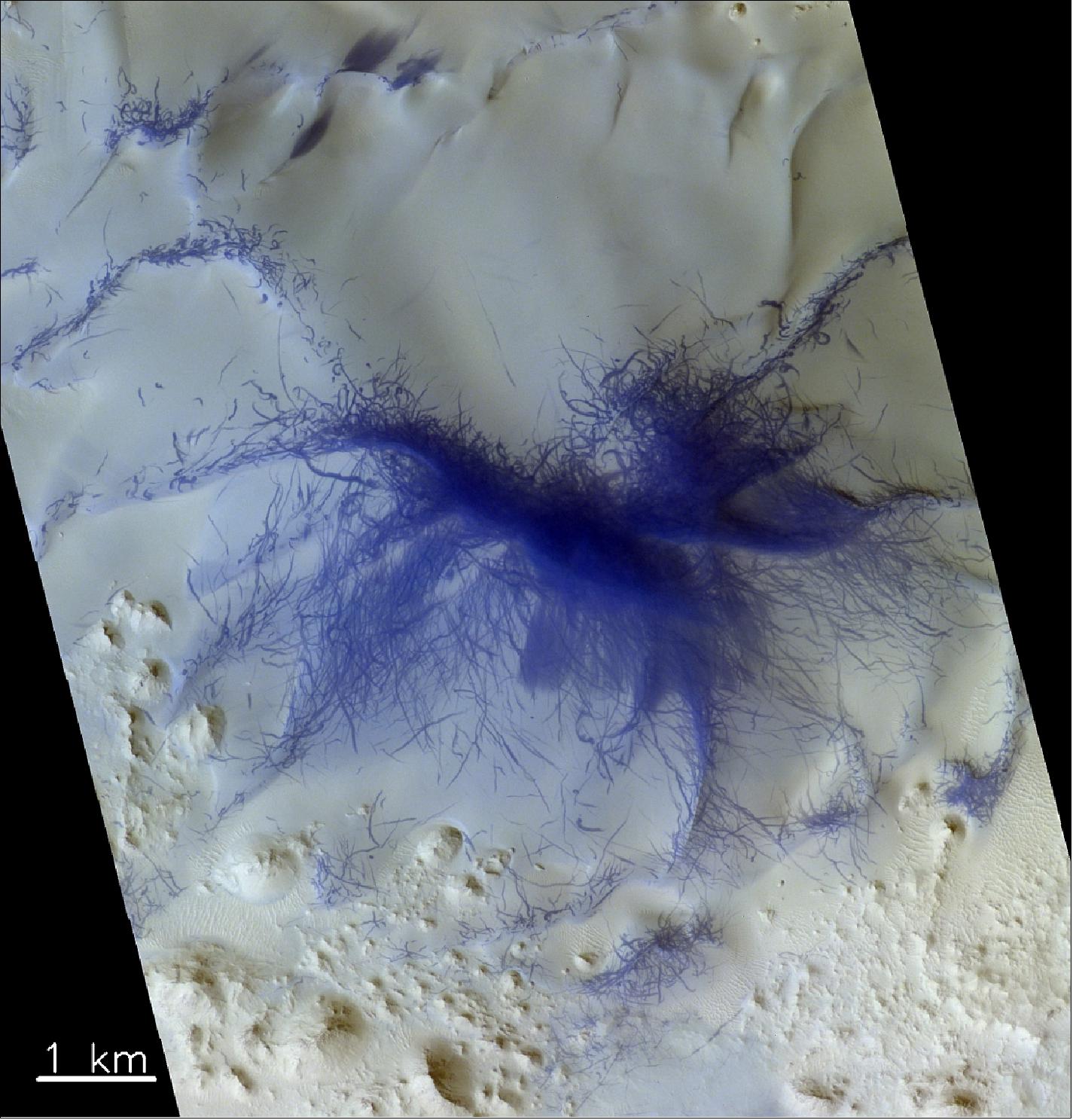
Legend to Figure 73: This image is a color-composite representation where features that are bluer compared to the average color of Mars are shown in bright blue hues. In actual color, the streaks would appear dark red. Dust devils churn up the surface material, exposing fresher material below. The reason why the streaks are so concentrated on the ridges is not known at present, but a relationship to orographic lift as masses of carbon dioxide air flow uphill and converge with other air masses is one possibility.
2) Banded Terrain
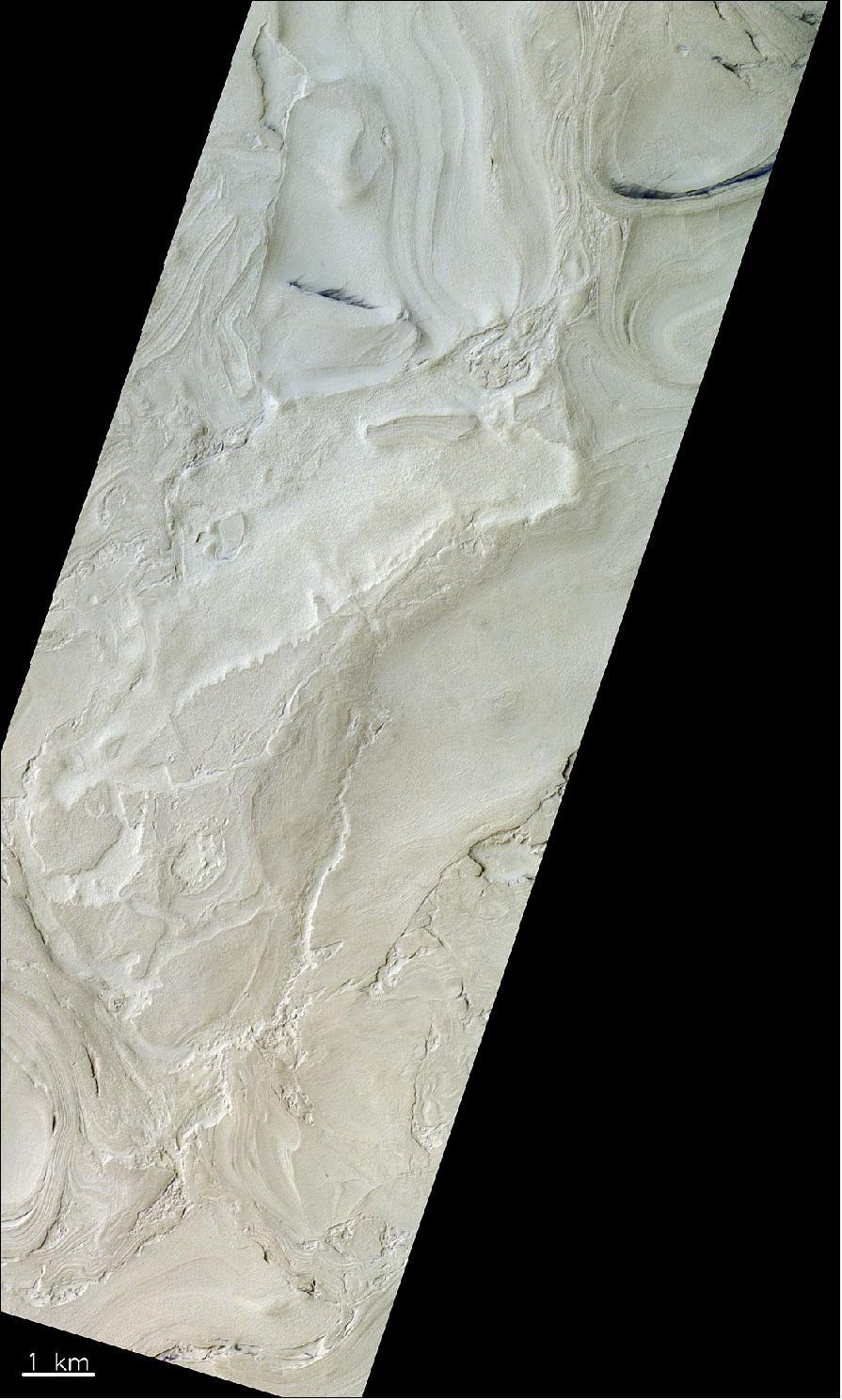
3) Hello InSight
Amongst a new showcase of images from the spacecraft’s CaSSIS, is an image of NASA’s InSight lander – the first time a European instrument has identified a lander on the Red Planet. Insight arrived on Mars on 26 November 2018 to study the interior of the planet. Images of the lander have already been returned by NASA’s Mars Reconnaissance Orbiter; these are the first images from TGO.
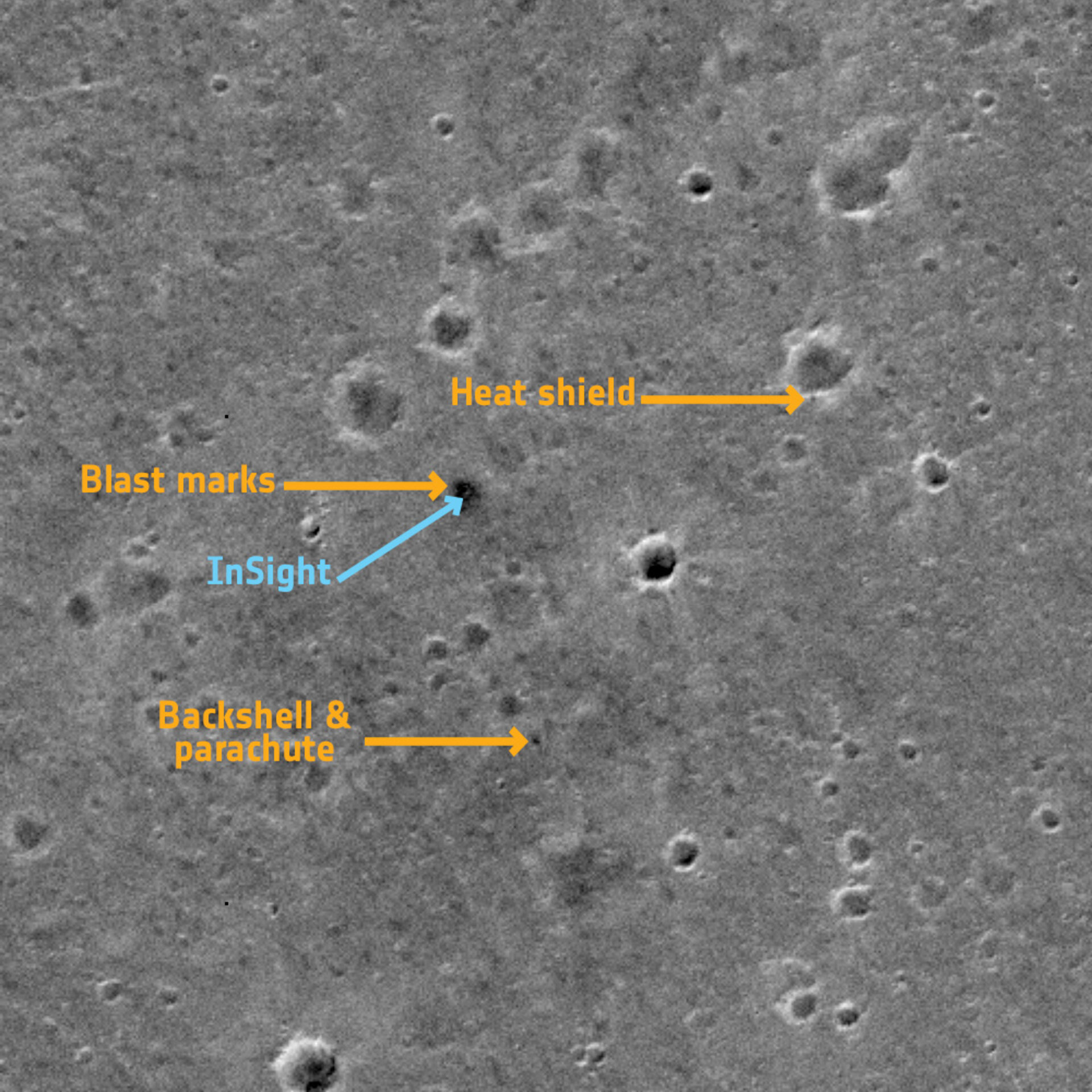
Legend to Figure 75: The CaSSIS view shows InSight as a slightly brighter dot in the center of the dark patch produced when the lander fired its retro rockets, just before touchdown in the Elysium Planitia region of Mars, and disturbed the surface dust. The heat shield released just before landing can also be seen on the edge of a crater, and the backshell used to protect the lander during descent is also identified.
“The ExoMars Trace Gas Orbiter is being used to relay data from InSight to Earth,” says Nicolas Thomas, CaSSIS Principal Investigator, from the University of Bern in Switzerland. “Because of this function, to avoid uncertainties in communications, we had not been able to point the camera towards the landing site so far – we had to wait until the landing site passed directly under the spacecraft to get this image.”
CaSSIS is expected to provide additional support to the InSight team by observing the surface of Mars in the area surrounding the lander. If the seismometer picks up a signal, the source might be a meteorite impact. One of CaSSIS’s tasks will be to help search for the impact site, which will allow the InSight team to better constrain the internal properties of Mars near the landing site.
The image of InSight also demonstrates that CaSSIS will be able to take pictures of the future ExoMars mission. The mission comprises a rover – named Rosalind Franklin – together with a surface science platform, and is due to be launched in July 2020, arriving at Mars in March 2021. TGO will also act as the data relay for the rover.
4) Salty Sulphates
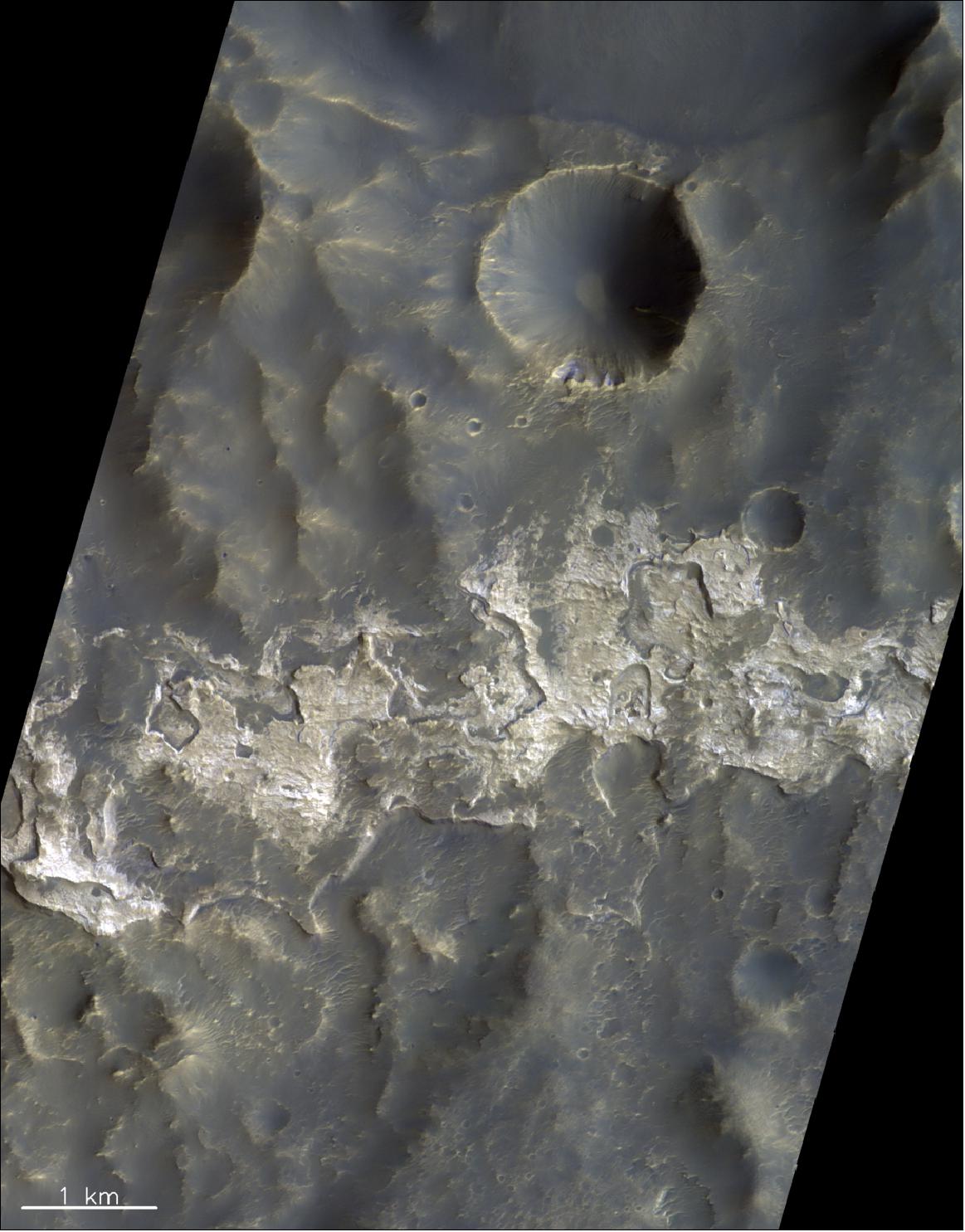
Legend to Figure 76: Layered rocks that appear in light-tones are found extensively on the northern crater walls, terraces and floor. These rocks have subsequently been eroded to expose successive layers in cross-section.
The CRISM spectrometer onboard NASA’s Mars Reconnaissance Orbiter has already revealed that these layers contain various hydrated minerals, such as sulphate salts that appear to cover the white-colored rocks. The beige-colored layered rocks, consistent with a sulphate salt signature, appear to line the crater wall, reminiscent of a high water mark.
These ‘bathtub rings’ are consistent with deposits formed by lakes that start to dry up and, through evaporation, begin to deposit specific minerals turn by turn. As the water evaporates, the minerals that are the least readily dissolved in water will begin to precipitate out of the dwindling solution.
The relatively small 1.6 km-wide impact crater towards the top of the image appears to have a small amount of white-colored bedrock exposed in its wall, which CRISM indicates is aluminous clay-bearing material. This suggests that the clay-bearing rocks are older than the sulphate salts that occupy the central portion of this image section.
5) South Polar Layered Terrains
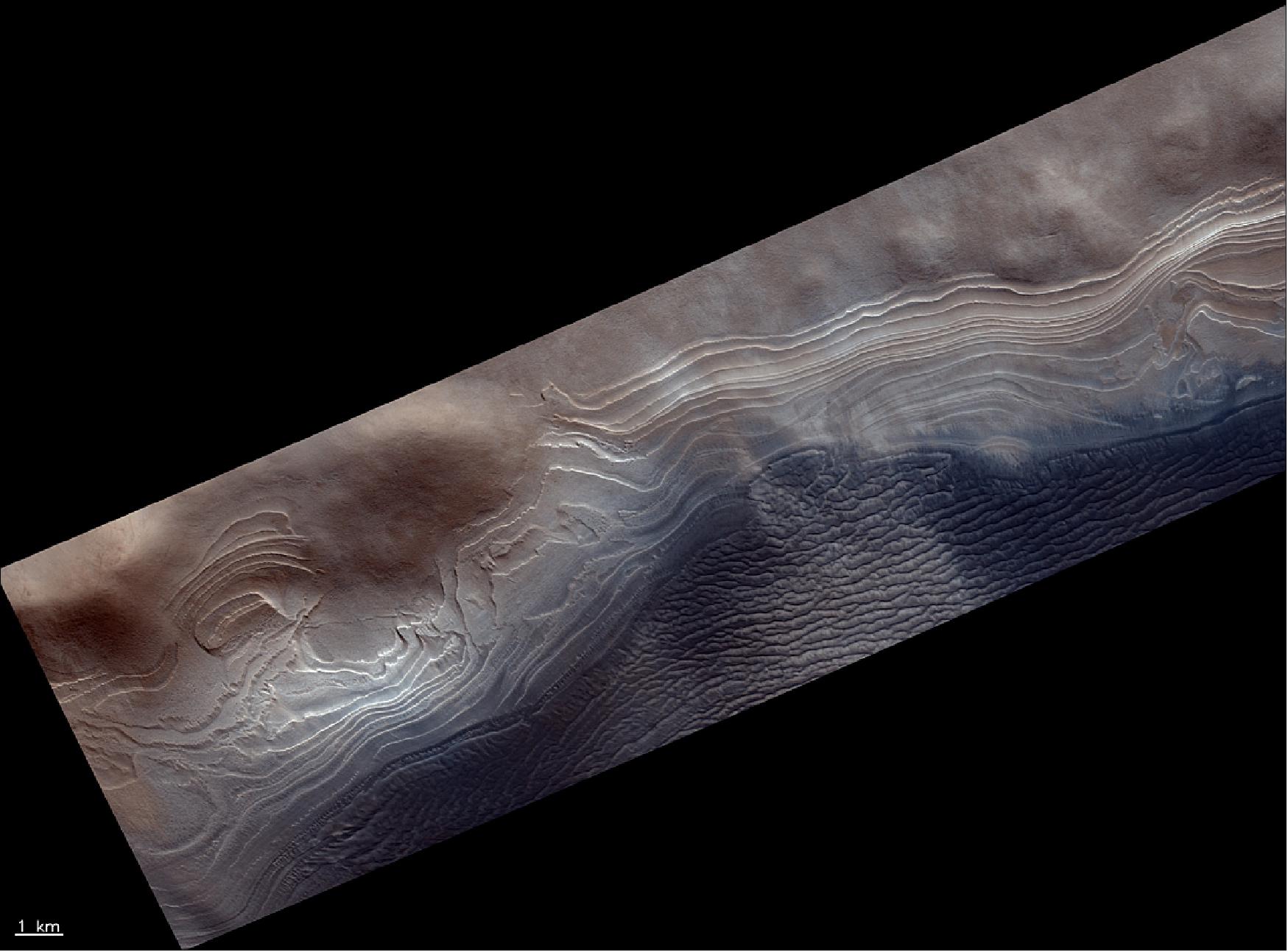
Legend to Figure 77: The ‘polar layered deposits’ of Mars, as the ice caps are known, are made of layers upon layers of ice and dust that record how the climate of Mars has evolved in the last few million to hundreds of millions of years.
Many of the impact craters that surround the caps have layered mounds that appear similar to the polar layered deposits, and some, particularly in the north, are known to be composed of nearly pure water ice. Layered mounds, like the one imaged here in the Burroughs crater, lie close to the south polar deposits, and have been less studied than the layers of the caps.
They may represent remnant ice deposits from past climates when the extent of the polar layered deposits reached to lower latitudes, or they may have been deposited independently, which would mean that they represent an entirely separate record of climate – perhaps extending further back into the history of the Mars.
This particular image shows heavily eroded layers toward the northwestern edge of the Burroughs crater mound (north is up). In this orientation, the top of the image contains the crater wall outside of the mound, which is about 400 km lower in elevation than the bottom of the image and shows the mound’s surface.
Because the CaSSIS instrument takes stereo pairs of images, the elevation differences – also between the layers – can be studied with the resulting digital terrain model.
6) Crater Floor
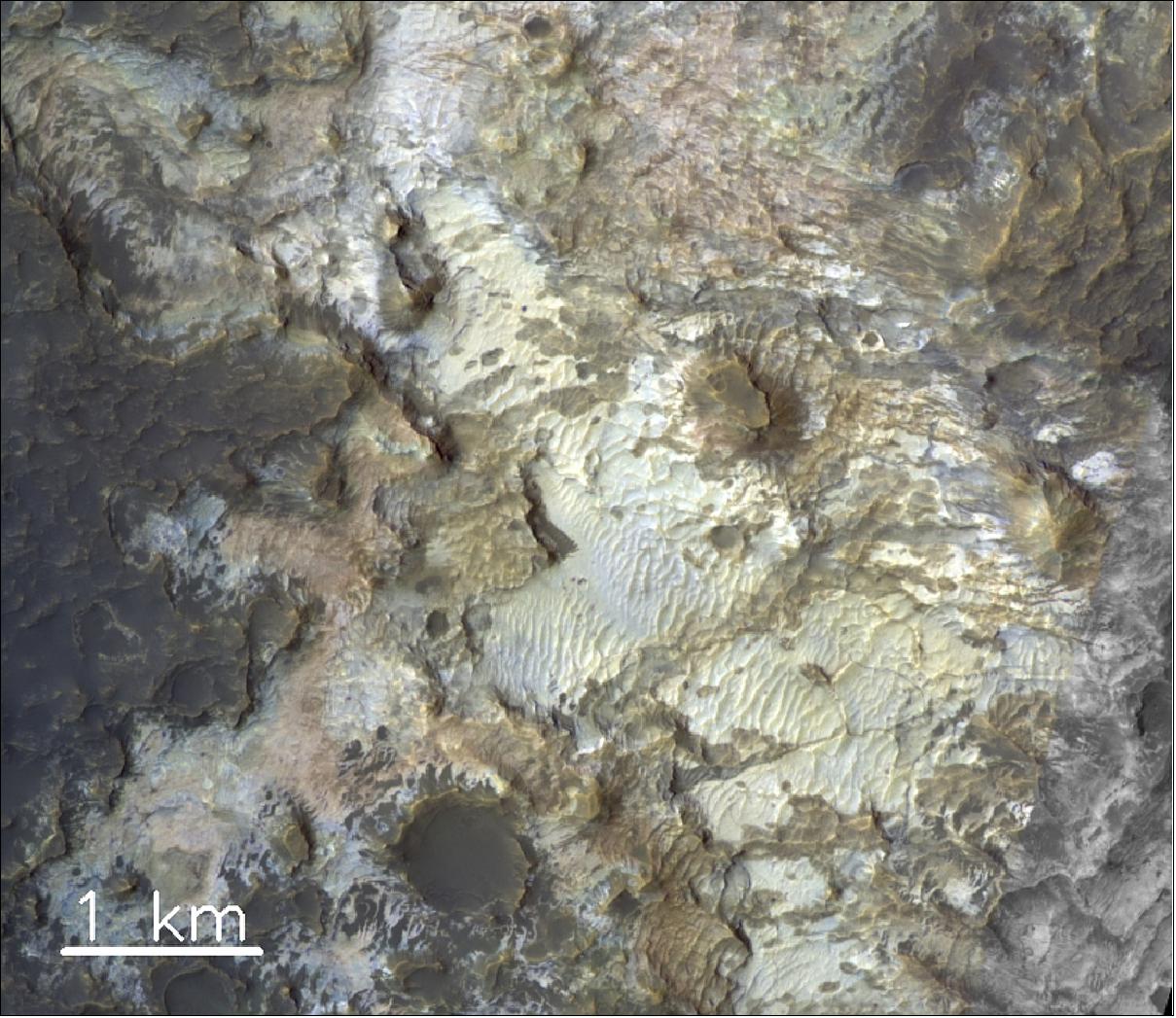
7) A Well-Preserved Crater
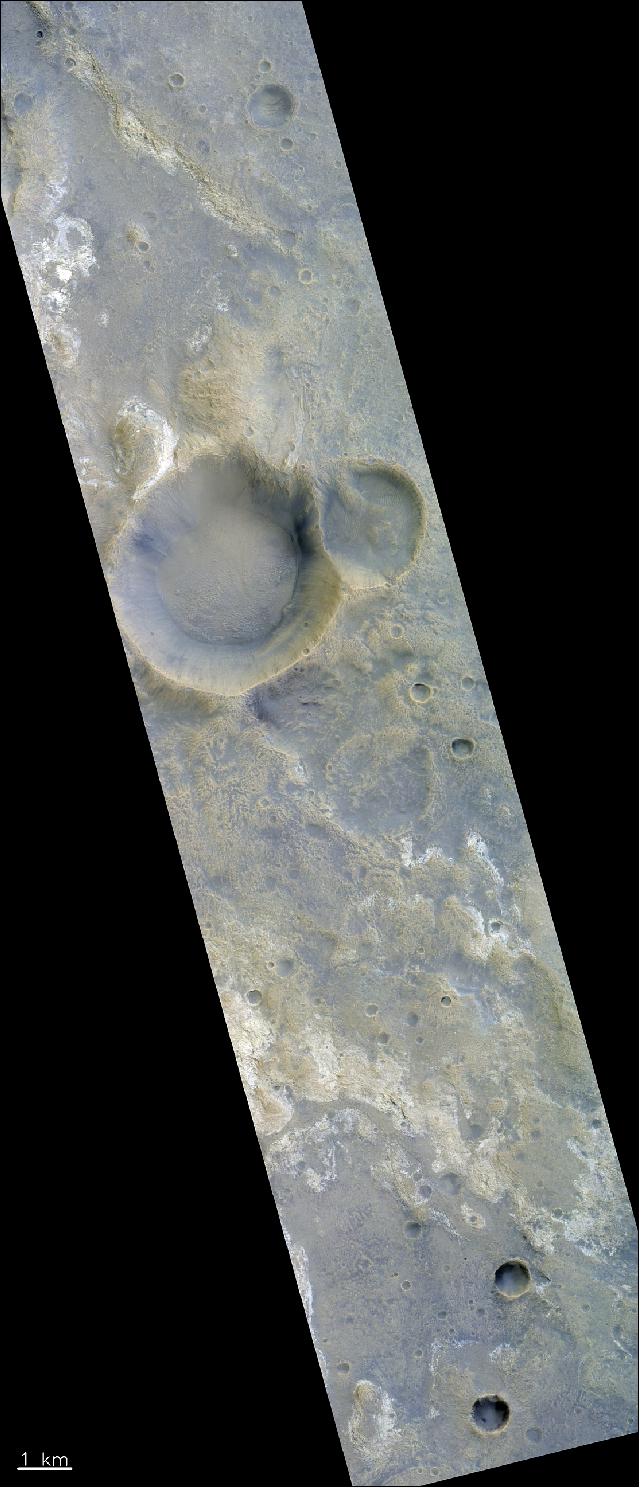
Legend to Figure 79: The color capability of CaSSIS reveals exposures of light-toned bedrock in this color-composite view. The light-toned bedrock, observed extensively throughout the region, may be associated with the formation of some of the most ancient rocks of the Hellas basin – between 3.7 and 4.1 billion years ago. Many exposures of this terrain show evidence of being altered chemically by water, with phyllosilicate clays being one of the most common minerals formed during this early period of martian history.
8) Mineral Diversity
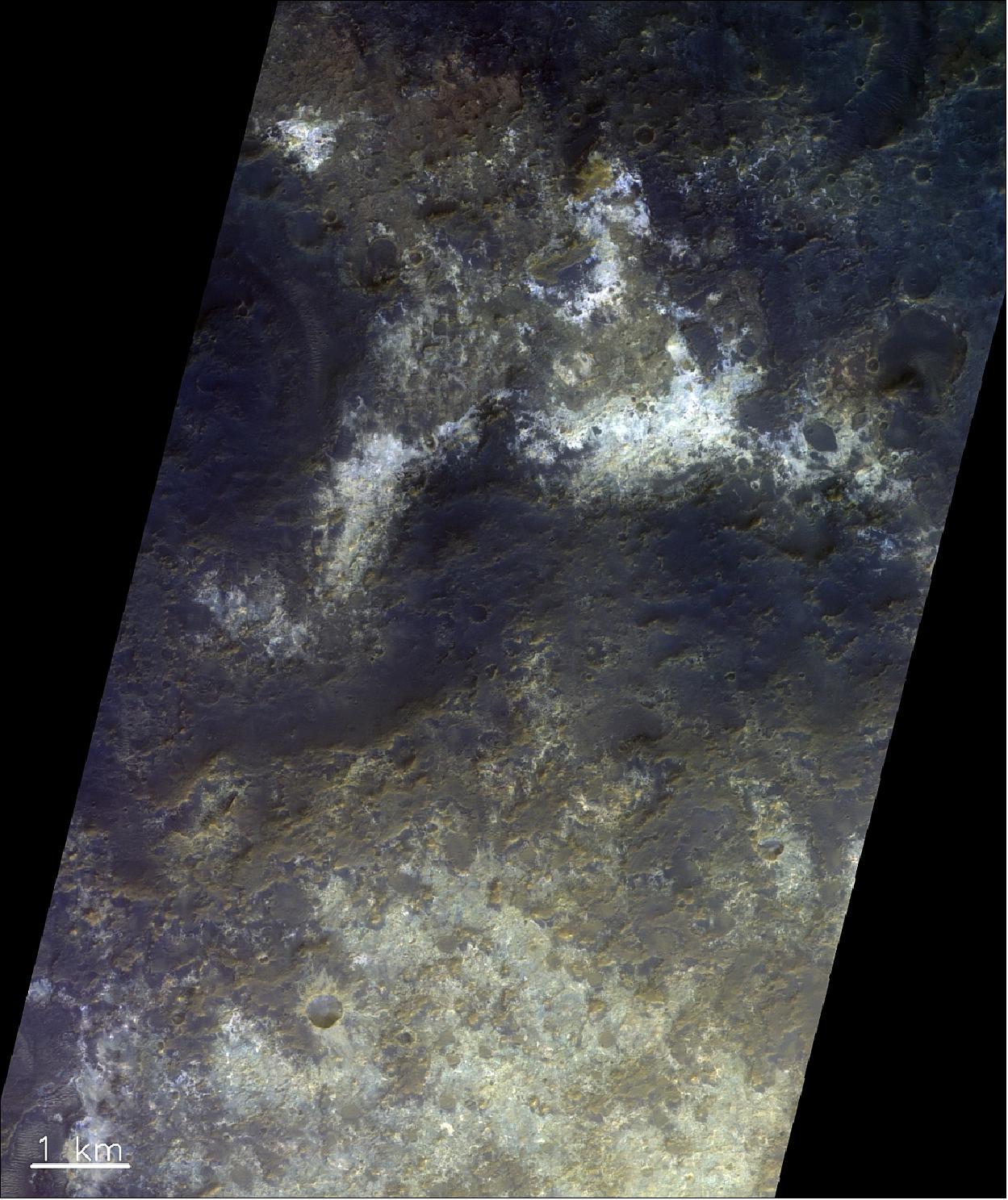
Legend to Figure 80: Mawrth Vallis is an outflow channel dissecting the ancient cratered highlands of Mars and leading into the low-lying plains of the northern hemisphere. Some of the bedrock exposed in the sides of the main outflow channel in this view belongs to the most ancient rocks found at the surface of Mars and displays evidence for strong and sustained water activity in the past. Clay minerals are particularly abundant here and provide important clues about the interaction between rock and water on the Red Planet.
9) Layered Depressions – 3D

Legend to Figure 81: The geology of the Hellas basin is complex with ancient terrains showing evidences of erosion and sedimentary processes, which might be linked to past water activity. Both the shapes of the features revealed by stereo imaging and the mineralogical composition of the finely layered outcrops are key for understanding their formation processes. CaSSIS color-composite images like these, combined with data from other instruments, help map variations in composition of the surface material.
10) Jezero Crater Neighborhood – 3D
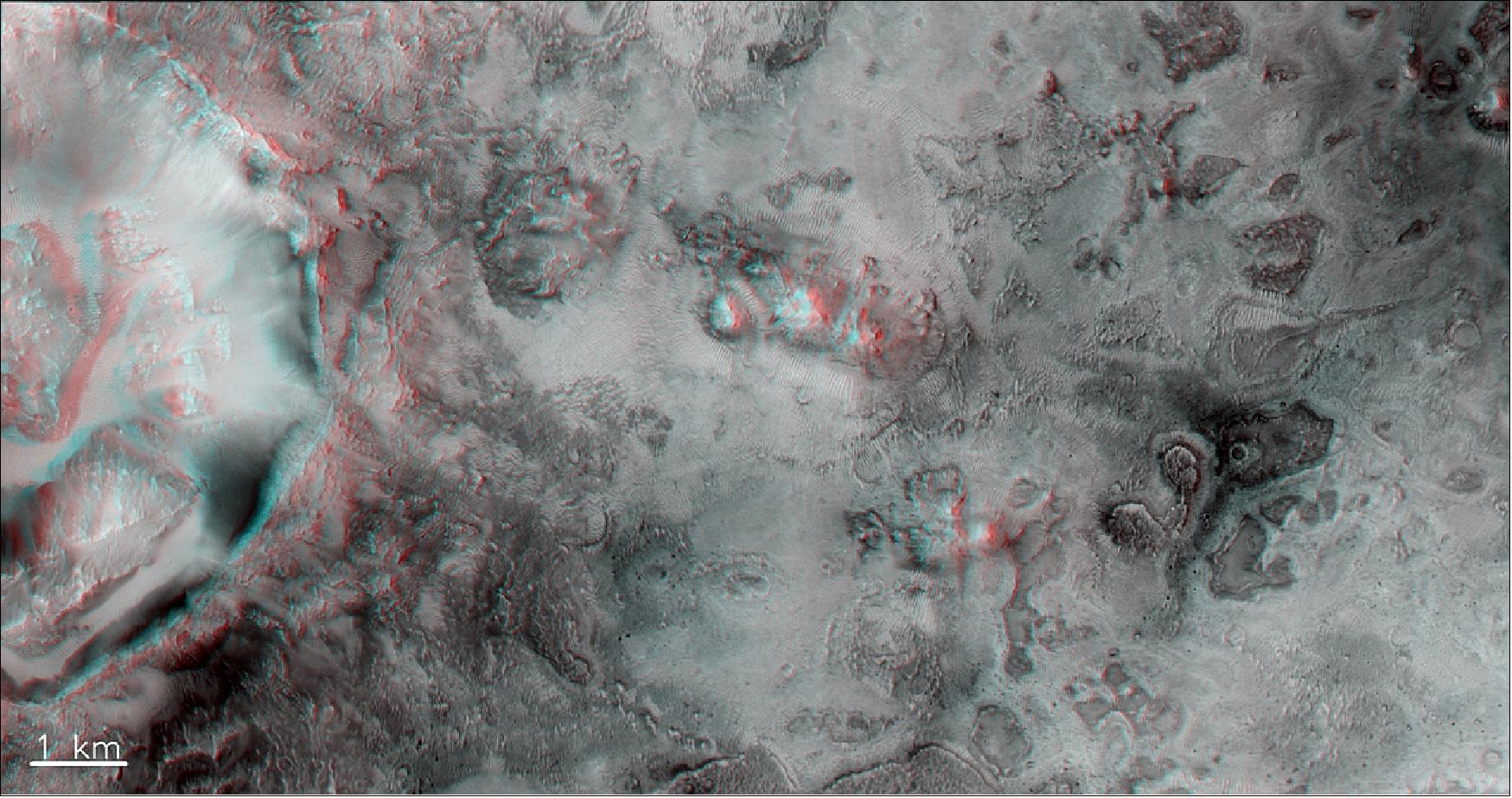
11) Brain Terrain – 3D
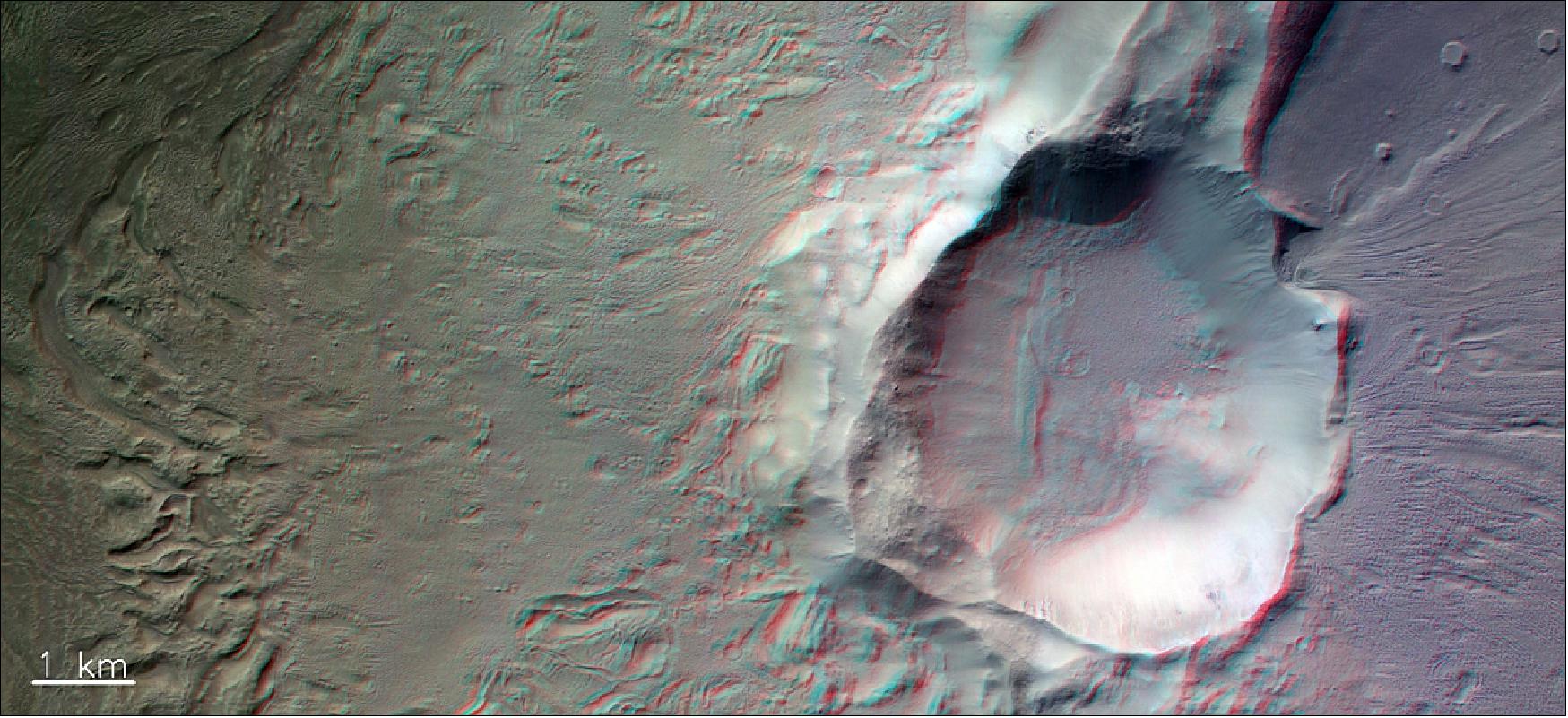
Legend to Figure 83: To the left of the image, so-called ‘brain coral terrain’ is visible – so-named because of its likeness in appearance to the ridges on the surface of the human brain. It appears to sit on the floor of the largest crater, although this deposit may be related to the lineated fill that lines the floor of the 15-km crater to the right of the image. Both types of terrain are associated with ice-rich material found near the boundary between Mars’ northern plains and its southern highlands.
Information held in images like these – best viewed with red-blue ‘3D’ glasses to give the impression of depth – help scientists make a detailed study of the order in which the many interacting layers were formed, thus piecing together the history of complex regions.
12) Rocky Islands – 3D
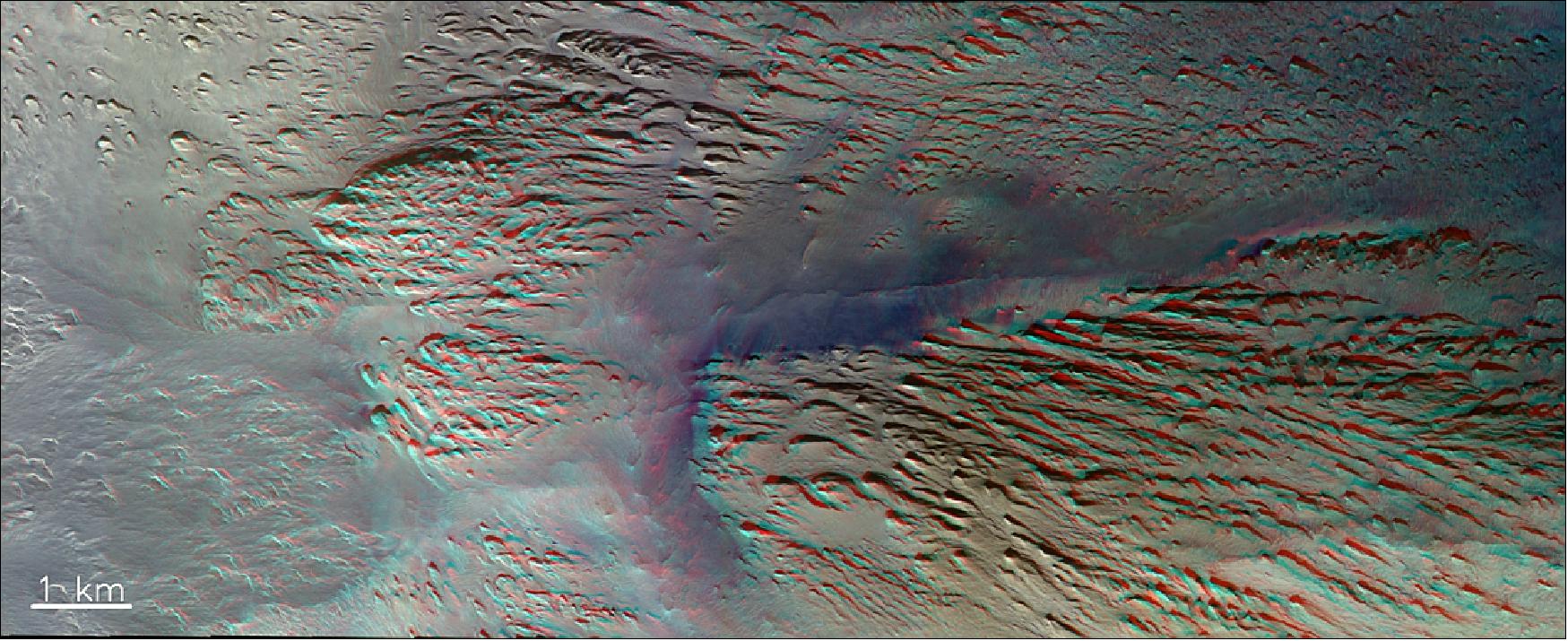
• February 04, 2019: The distinctive form of a delta (Figure 85) arises from sediments that are deposited by a river as it enters slower-moving water, like a lake or a sea, for example. The Nile River delta is a classic example on Earth, and uncannily similar features have been spotted on Saturn’s moon Titan and – closer to home – Mars. While liquid water is no longer present on the surface of Mars, features in the left portion of this image provide strong evidence of it having played an important role in the history of the Red Planet. Furthermore, water-ice is still stable on the surface today, and a recent discovery from Mars Express detected a pocket of liquid water below the surface. 73)
- The 100-meter-thick fan-shaped deposit seen in this image is found in Eberswalde crater in the southern hemisphere of Mars (326.33ºE/23.55ºS). The image covers an area of 31 x 7.5 km and was taken on 16 November 2018 by CaSSIS (Color and Stereo Surface Imaging System) of the ESA-Roscosmos ExoMars Trace Gas Orbiter.
- While presented in beautiful aqueous blues and greens, the image is false-color. The layered rocks that comprise the delta deposits are indicated in white/yellow to purple/blue. The yellow represents the presence of oxidized iron deposits, indicating that the rocks were altered by the presence of water, while the blues signify less altered materials. This suggests that the influence of liquid water reduced over time, perhaps relating to a change in environmental conditions.

- After the deposition of the delta sediments in the crater’s ancient lake, fresher sediments – some perhaps deposited by wind – accumulated to cover up a major part of the delta and its connecting channels. These secondary sediments were later eroded in the delta, exposing an inverted relief of the structure that is observed today.
- This particular delta was first observed by NASA's Mars Global Surveyor and has also been imaged by ESA’s Mars Express. It sits inside a 65 km wide impact basin called Eberswalde, which is almost completely buried by material ejected from the much larger and younger nearby Holden Crater.
- Another example of a martian delta can be found in Jezero Crater, which was recently selected as the landing site for the NASA Mars 2020 rover. Meanwhile the ESA-Roscosmos ExoMars rover, also launching in 2020, will target the ancient, once water-rich plains of Oxia Planum. The ExoMars rover will drill down to two meters below the surface to search of clues for past life preserved underground.
- ESA has been exploring Mars for more than 15 years, starting with Mars Express that arrived at the Red Planet at the end of 2003, and which continues to return results today. Meanwhile the Trace Gas Orbiter will complete its first year of science investigations in April; it is sniffing the atmosphere to seek out the faint traces of gases that might be linked to active biological or geological process, and mapping the distribution of underground water-ice. It is also a data relay, providing essential communications infrastructure for current and future surface assets.
- ESA and NASA are also preparing for the next stage of Mars exploration: returning a sample from the Red Planet. NASA’s 2020 rover is set to collect surface samples in small canisters that could later be retrieved by a second mission, and launched into Mars orbit. A third mission would rendezvous with the samples and return them to Earth, where they could be accessed by teams of scientists across the world.
- Long-term planning is crucial to realize the missions that investigate fundamental science questions, and to ensure the continued development of innovative technology, inspiring new generations of European scientists and engineers.
• November 29, 2018: The ExoMars TGO (Trace Gas Orbiter) is all set to receive the first signals from InSight – NASA’s latest inhabitant of Mars. The joint ESA/Roscosmos ExoMars TGO is a research spacecraft orbiting Mars to make a detailed analysis of gases in the martian atmosphere that may be linked to geological or biological activity. The orbiter also relays information from spacecraft exploring the martian surface to teams on Earth, increasing the quantity of data it is possible for us to receive from missions scouring the surface of the Red Planet. 74)
- On Friday 30 November, at 15:20 UTC (16:20 CET), the TGO spacecraft will fly over the stationary new lander, catching the latest data it has gathered during its brief stretch on its new planet. This data from the alien world will be downloaded from the ExoMars TGO when it next comes into view of NASA’s Madrid ground station, later on Monday evening (3 December).
- Nestled within the spacecraft are two Electra radios, one of which is shown in Figure 2. These NASA-built radios include special features that allow data to be relayed between a stationary lander or rover, the orbiting spacecraft, and Earth.
- ESA’s TGO will join NASA orbiters in picking up signals from InSight for the lifetime of its mission, beaming martian data back to Earth as well as forwarding data from Earth to the new InSight lander, and providing the first-ever routine data relay support between missions of different agencies at Mars.
Extended Life for ESA's Science Missions 75)
• November 14, 2018: The SPC (Science Program Committee) of ESA has confirmed the continued operations of ten scientific missions in the Agency's fleet up to 2022. After a comprehensive review of their scientific merits and technical status, the SPC has decided to extend the operation of the five missions led by ESA's Science Program: Cluster, Gaia, INTEGRAL, Mars Express, and XMM-Newton. The SPC also confirmed the Agency's contributions to the extended operations of Hinode, Hubble, IRIS, SOHO, and ExoMars TGO. 75)
- This includes the confirmation of operations for the 2019–2020 cycle for missions that had been given indicative extensions as part of the previous extension process, and indicative extensions for an additional two years, up to 2022.
Note: Every two years, all missions whose approved operations end within the following four years are subject to review by the advisory structure of the Science Directorate. Extensions are granted to missions that satisfy the established criteria for operational status and science return, subject to the level of financial resources available in the science program. These extensions are valid for the following four years, subject to a mid-term review and confirmation after two years.
- The decision was taken during the SPC meeting at ESA/ESAC (European Space Astronomy Center) near Madrid, Spain, on 14 November.
- ESA's science missions have unique capabilities and are prolific in their scientific output. Cluster, for example, is the only mission that, by varying the separation between its four spacecraft, allows multipoint measurements of the magnetosphere in different regions and at different scales, while Gaia is performing the most precise astrometric survey ever realized, enabling unprecedented studies of the distribution and motions of stars in the Milky Way and beyond.
- Many of the science missions are proving to be of great value to pursue investigations that were not foreseen at the time of their launch. Examples include the role of INTEGRAL and XMM-Newton in the follow-up of recent gravitational wave detections, paving the way for the future of multi-messenger astronomy, and the many discoveries of diverse exoplanets by Hubble.
- Collaboration between missions, including those led by partner agencies, is also of great importance. The interplay between solar missions like Hinode, IRIS and SOHO provides an extensive suite of complementary instruments to study our Sun; meanwhile, Mars Express and ExoMars TGO are at the forefront of the international fleet investigating the Red Planet.
- Another compelling factor to support the extension is the introduction of new modes of operation to accommodate the evolving needs of the scientific community, as well as new opportunities for scientists to get involved with the missions.
• October 25, 2018: This striking view of layered sediments on Mars was captured by the ExoMars Trace Gas Orbiter’s CaSSIS (Color and Stereo Surface Imaging System) on 2 October 2018. The image, which covers an area 25 x 7 km wide, focuses on a layered mound in Juventae Chasma, just north of the iconic Valles Marineris. 76)
- The features in the chasmata around Valles Marineris have been well studied by Mars orbiters, including ESA’s Mars Express and NASA’s Mars Reconnaissance Orbiter (MRO). The CRISM instrument on MRO detected a significant amount of sulphates at the base of the mound shown in this image – a composition that points to the presence of water in the distant past.
- The new image from CaSSIS reveals the beautiful sedimentary layers in high resolution, allowing scientists to explore the correlation between color as seen by the camera, and composition as determined by previous measurements to better understand how these minerals were deposited in the area. Patterns in the layering can also serve as a record of climate, further constraining the type of environment in which this feature formed, and shedding light on the history of this stunning landscape.
- The ExoMars program is a joint endeavor between ESA and Roscosmos.

• September 19, 2018: Astronauts on a mission to Mars would be exposed to at least 60% of the total radiation dose limit recommended for their career during the journey itself to and from the Red Planet, according to data from the ESA-Roscosmos ExoMars TGO (Trace Gas Orbiter) being presented at the EPSC (European Planetary Science Congress) in Berlin, Germany, this week. 77)
- The orbiter’s camera team are also presenting new images of Mars during the meeting. They will also highlight the challenges faced from the recent dust storm that engulfed the entire planet, preventing high-quality imaging of the surface.
- Radiation monitoring: The TGO began its science mission at Mars in April, and while its primary goals are to provide the most detailed inventory of martian atmospheric gases to date – including those that might be related to active geological or biological processes – its radiation monitor has been collecting data since launch in 2016.
- The Liulin-MO dosimeter of the Fine Resolution Epithermal Neutron Detector (FREND) provided data on the radiation doses recorded during the orbiter’s six-month interplanetary cruise to Mars, and since the spacecraft reached orbit around the planet.
- On Earth, a strong magnetic field and thick atmosphere protects us from the unceasing bombardment of galactic cosmic rays, fragments of atoms from outside our Solar System that travel at close to the speed of light and are highly penetrating for biological material.
- In space this has the potential to cause serious damage to humans, including radiation sickness, an increased lifetime risk for cancer, central nervous system effects, and degenerative diseases, which is why ESA is researching ways to best protect astronauts on long spaceflight missions.
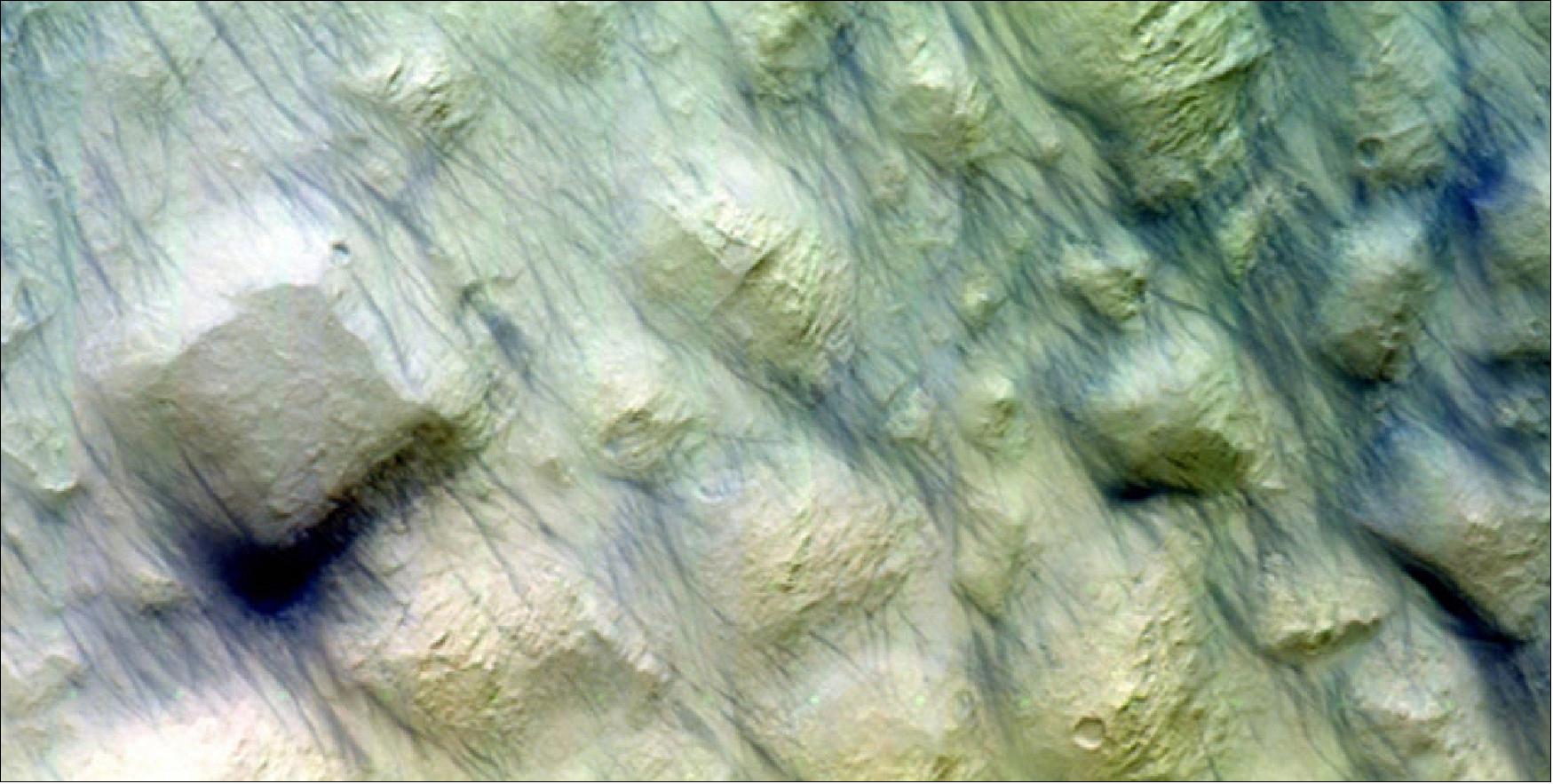
Legend to Figure 87: The image shows an unusual terrain type – sometimes referred to as chaotic blocks – but what is particularly striking are the large number of dark streaks. One possible interpretation is that these features were produced during the recent dust storm: they could have resulted from dust devils stirring up the surface dust.
- The ExoMars measurements cover a period of declining solar activity, corresponding to a high radiation dose. Increased activity of the Sun can deflect the galactic cosmic rays, although very large solar flares and eruptions can themselves be dangerous to astronauts.
- “One of the basic factors in planning and designing a long-duration crewed mission to Mars is consideration of the radiation risk,” says Jordanka Semkova of the Bulgarian Academy of Sciences and lead scientist of the Liulin-MO instrument.
- “Radiation doses accumulated by astronauts in interplanetary space would be several hundred times larger than the doses accumulated by humans over the same time period on Earth, and several times larger than the doses of astronauts and cosmonauts working on the International Space Station. Our results show that the journey itself would provide very significant exposure for the astronauts to radiation.”
- The results imply that on a six-month journey to the Red Planet, and assuming six-months back again, an astronaut could be exposed to at least 60% of the total radiation dose limit recommended for their entire career.
- The ExoMars data, which is in good agreement with data from Mars Science Laboratory’s cruise to Mars in 2011–2012 and with other particle detectors currently in space – taking into account the different solar conditions – will be used to verify radiation environment models and assessments of the radiation risk to the crewmembers of future exploration missions.
- A similar sensor is under preparation for the ExoMars 2020 mission to monitor the radiation environment from the surface of Mars. Arriving in 2021, the next mission will comprise a rover and a stationary surface science platform. The Trace Gas Orbiter will act as a data relay for the surface assets.
- Global dust storm subsides: Radiation is not the only hazard facing Mars missions. A global dust storm that engulfed the planet earlier this year resulted in severely reduced light levels at the surface, sending NASA’s Opportunity rover into hibernation. The solar-powered rover has been silent for more than three months.
- Orbiting 400 km above the surface, the ExoMars Trace Gas Orbiter’s CaSSIS (Color and Stereo Surface Imaging System) has also suffered. Because the surface of the planet was almost totally obscured by dust, the camera was switched off for much of the storm period.
- “Normally we don’t like to release images like this, but it does show how the dust storm prevents useful imaging of the surface,” says the camera’s Principal Investigator, Nicolas Thomas from the University of Bern. “We had images that were worse than this when we took an occasional look at the conditions, and it didn’t make too much sense to try to look through ‘soup’.”
- But the camera team discovered that even a dust cloud has a silver lining. “The dust-obscured observations are actually quite good for calibration,” says Nicolas. “The camera has a small amount of straylight and we have been using the dust storm images to find the source of the straylight and begin to derive algorithms to remove it.”
- Since 20 August, CaSSIS has started round-the-clock imaging again. “We still have some images affected by the dust storm but it is quickly getting back to normal and we have already had a lot of good quality images coming down since the beginning of September,” adds Nicolas.
- One image acquired on 2 September (Figure 87), although not completely free from artefacts, shows striking dark streaks that might be linked to the storm itself. A possible interpretation is that these features were produced by ‘dust devils’ – whirlwinds – stirring up loose surface material. The region, Ariadne Colles in the southern hemisphere of Mars, was imaged by NASA’s Mars Reconnaissance Orbiter camera in March, before the storm, and there seemed to be little evidence of these streaks.
• September 17, 2018: The image of Figure 88 shows the south-facing rim of a pit crater at 68°S in the Sisyphi Planum region of Mars. It is a color composite made from images acquired on 2 September 2018 by the CaSSIS (Color and Stereo Surface Imaging System) onboard the joint ESA-Roscosmos ExoMars TGO (Trace Gas Orbiter) mission, when the southern hemisphere of Mars was in late spring. 78)
- Most striking are the bright residual carbon dioxide ice deposits on south-facing slopes of the crater. In colder months carbon dioxide and some water vapor freezes on the surface. Then, as the Sun gets higher in the sky again, the ice sublimates away, revealing the underlying surface.
- This particular crater is known to have active gullies – small, incised networks of narrow channels at the rim of the crater that are associated with debris flows. Ice-rich landslide-like flows of material down-slope can be seen in this image – perhaps related to the ‘defrosting’ of the ice as the seasons change.
- Seasonal changes of ice and frost on Mars is one aspect of the ExoMars orbiter’s mission being discussed this week at the European Planetary Science Congress, a major European annual meeting on planetary science, this year hosted by the Technische Universität Berlin, Germany.
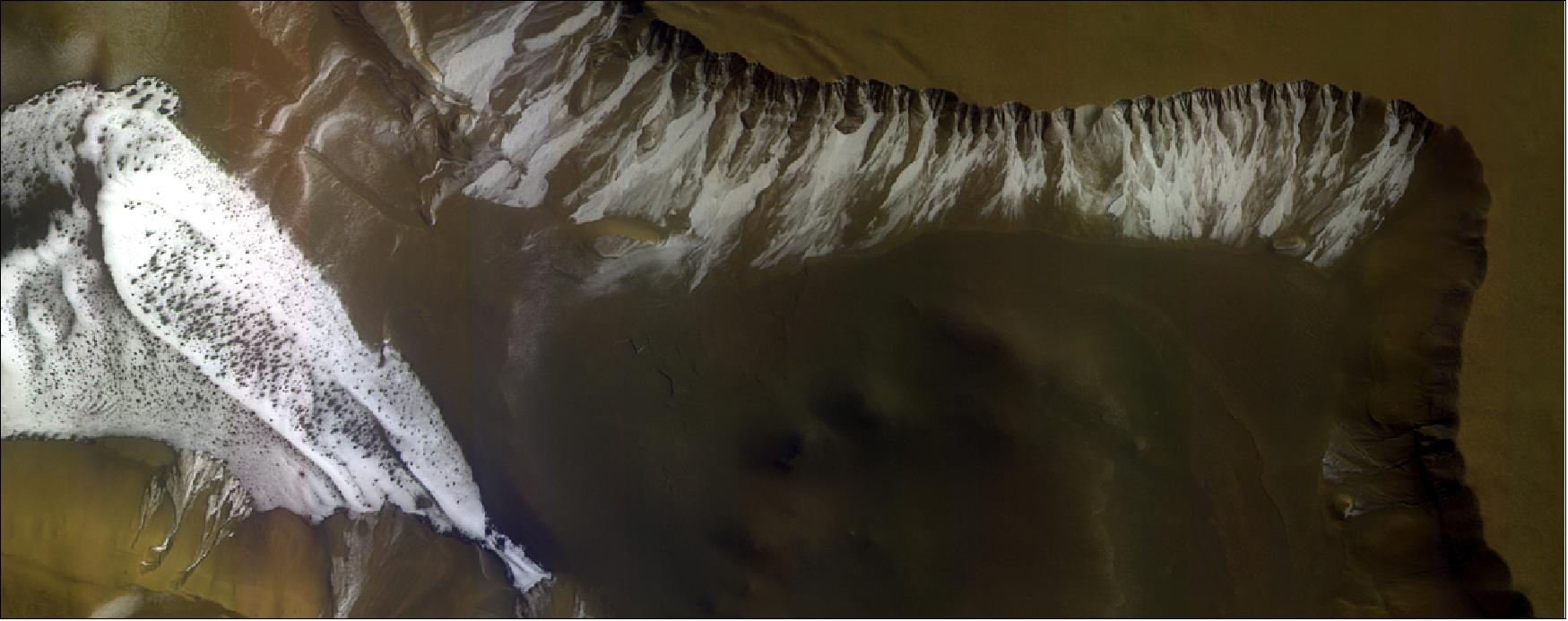
• August 24, 2018: This beautiful dune field lies inside a crater near the south polar region of Mars. The image was taken by the ExoMars Trace Gas Orbiter’s CaSSIS (Color and Stereo Surface Imaging System) on 18 May 2018, at the beginning of martian southern spring, when a thin layer of seasonal carbon dioxide ice was still covering the surface. Over the winter, the ice grains in this thin layer appear to grow enough that the ice becomes almost transparent, letting light through and heating up the surface from the bottom of the ice. As the ice begins to sublimate from the bottom up, pressure builds up, and it is released through instabilities and cracks in the ice layer, in what scientists think are geyser-like processes of carbon dioxide gas that push out martian sand. The black streaks seen all across this image are examples of the darker sand being propelled out through the ice cracks and down the slip face of the dunes. 79)

• July 16, 2018: The Rt Hon Theresa May, Prime Minister of the UK, examines the ESA ExoMars rover in the Space Zone at the Farnborough International Airshow, accompanied by ESA Director General Jan Wörner, ESA astronaut Tim Peake and Chief Executive of the UK Space Agency Dr Graham Turnock, 16 July 2018. 80)
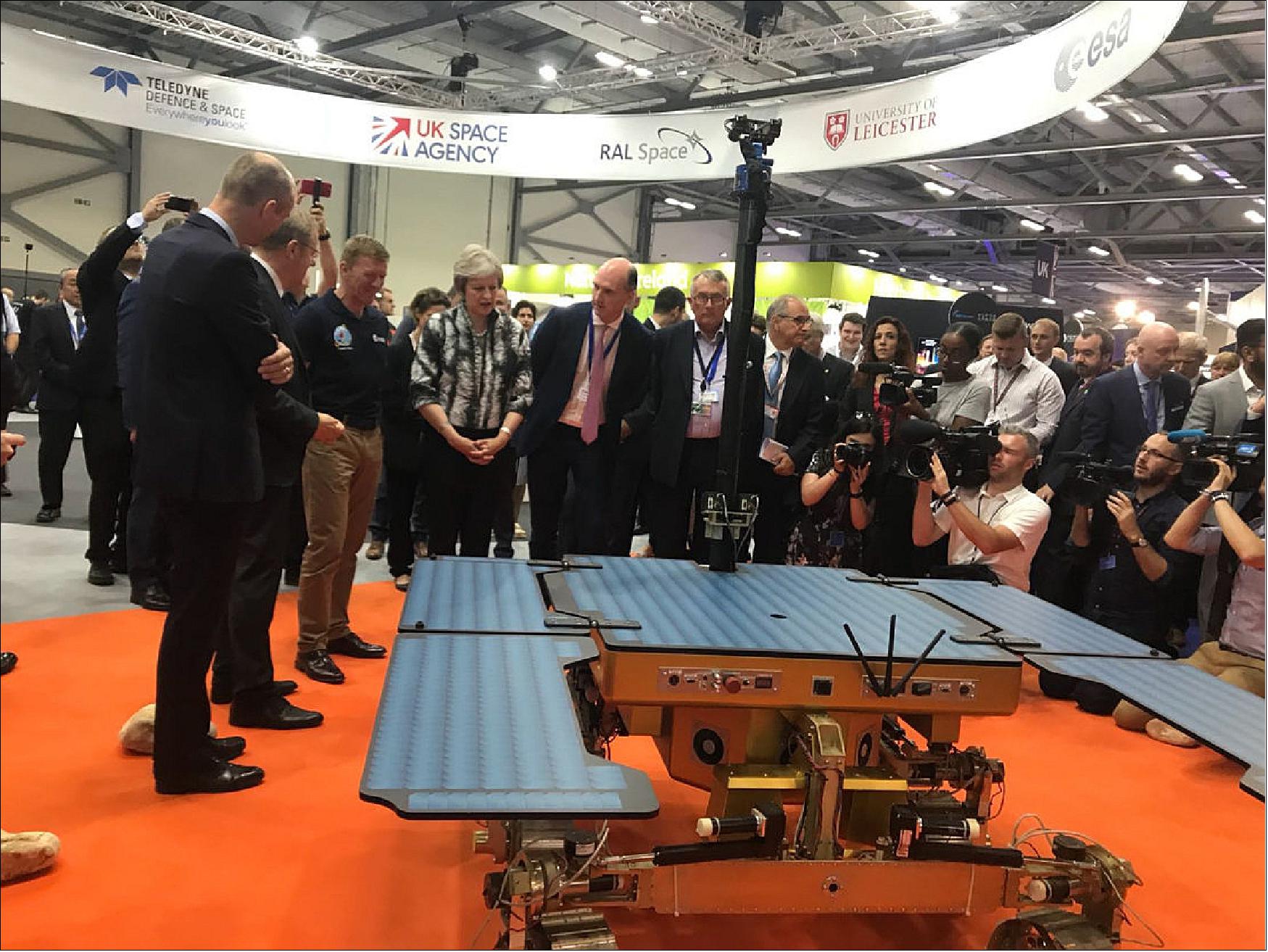
• June 27, 2018: The ExoMars Trace Gas Orbiter showing the region where the ancient Uzboi Vallis enters the Holden crater in the southern hemisphere of Mars. The valley begins on the northern rim of the Argyre basin and was formed by running water. The fluvial deposits are clearly visible in the impact cratered terrain. 81)

• June 4, 2018: The poles of Mars have huge ice caps that are similar to Earth’s polar caps in Greenland and Antarctica. These caps are composed primarily of water ice and were deposited in layers that contain varying amounts of dust. They are referred to as the martian Polar Layered Deposits (PLD). 82)
- Thanks to massive canyons that dissect the layered deposits, orbiting spacecraft can view the layered internal structure. The ExoMars orbiter’s CaSSIS (Color and Stereo Surface Imaging System) viewed this 7 x 38 km segment of icy layered deposits near the margin of the South PLD, which extend as far north as 73ºS.
- Here, CaSSIS has imaged remnant deposits within a crater at this margin. The beautiful variations in color and brightness of the layers are visible through the camera’s color filters. It highlights the bright ice and the redder sandy deposits toward the top of the image.
- The ExoMars program is a joint endeavor between ESA and Roscosmos.

• April 26, 2018: The ExoMars TGO (Trace Gas Orbiter) has returned the first images of the Red Planet from its new orbit. The spacecraft arrived in a near-circular 400 km altitude orbit a few weeks ago ahead of its primary goal to seek out gases that may be linked to active geological or biological activity on Mars. 83)
- The orbiter's CaSSIS (Color and Stereo Surface Imaging System) took this stunning image, which features part of an impact crater, during the instrument’s test period. The camera was activated on 20 March and was tested for the start of its main mission on 28 April.
- “We transmitted new software to the instrument at the start of the test phase and after a couple of minor issues, the instrument is in good health and ready to work,” says the camera’s principal investigator, Nicolas Thomas from the University of Bern in Switzerland.
- The image captures a 40 km-long segment of Korolev Crater located high in the northern hemisphere. The bright material on the rim of the crater is ice.
- “We were really pleased to see how good this picture was given the lighting conditions,” says Antoine Pommerol, a member of the CaSSIS science team working on the calibration of the data. “It shows that CaSSIS can make a major contribution to studies of the carbon dioxide and water cycles on Mars.”
- “We aim to fully automate the image production process,” says Nick. “Once we achieve this, we can distribute the data quickly to the science community for analysis.” - The team also plans to make regular public releases.

- The orbiter’s camera is one of four instruments on the Trace Gas Orbiter, or TGO, which also hosts two spectrometer suites and a neutron detector.
- The spectrometers began their science mission on 21 April with the spacecraft taking its first ‘sniff’ of the atmosphere. In reality, the sniffing is the spectrometers looking at how molecules in the atmosphere absorb sunlight: each has a unique fingerprint that reveals its chemical composition.
- A long period of data collection will be needed to bring out the details, especially for particularly rare – or not even yet discovered – ingredients in the atmosphere. Trace gases, as hinted at from their name, are only present in very small amounts: that is, less than one percent of the volume of the planet’s atmosphere. In particular, the orbiter will seek evidence of methane and other gases that could be signatures of active biological or geological activity.
- The camera will eventually help characterize features on the surface that may be related to trace gas sources. “We are excited to finally be starting collecting data at Mars with this phenomenal spacecraft,” says Håkan Svedhem, ESA’s TGO project scientist. “The test images we have seen so far certainly set the bar high.”
• April 9, 2018: The ExoMars orbiter will soon begin its search for gases that may be linked to active geological or biological activity on the Red Planet. The TGO (Trace Gas Orbiter) has reached its final orbit after a year of ‘aerobraking’ that ended in February. This exciting operation saw the craft skimming through the very top of the upper atmosphere, using drag on its solar wings to transform its initial highly elliptical four-day orbit of about 200 x 98,000 km into the final, much lower and near-circular path at about 400 km. 84)
- It is now circling Mars every two hours and, after calibration and installation of new software, it will begin routine scientific observations. “This is a major milestone for our ExoMars program, and a fantastic achievement for Europe,” says Pia Mitschdoerfer, Trace Gas Orbiter mission manager. “We have reached this orbit for the first time through aerobraking and with the heaviest orbiter ever sent to the Red Planet, ready to start searching for signs of life from orbit.”
- “We will start our science mission in just a couple of weeks and are extremely excited about what the first measurements will reveal,” says Håkan Svedhem, the orbiter’s project scientist. “We have the sensitivity to detect rare gases in minute proportions, with the potential to discover if Mars is still active today – biologically or geologically speaking.”
- The primary goal is to take a detailed inventory of trace gases – those that make up less than 1% of the total volume of the planet’s atmosphere. In particular, the orbiter will seek evidence of methane and other gases that could be signatures of active biological or geological activity.
- On Earth, living organisms release much of the planet’s methane. It is also the main component of naturally occurring hydrocarbon gas reservoirs, and a contribution is also provided by volcanic and hydrothermal activity.
- Methane on Mars is expected to have a rather short lifetime – around 400 years – because it is broken down by ultraviolet light from the Sun. It also reacts with other species in the atmosphere, and is subject to mixing and dispersal by winds. That means, if it is detected today, it was likely created or released from an ancient reservoir relatively recently.
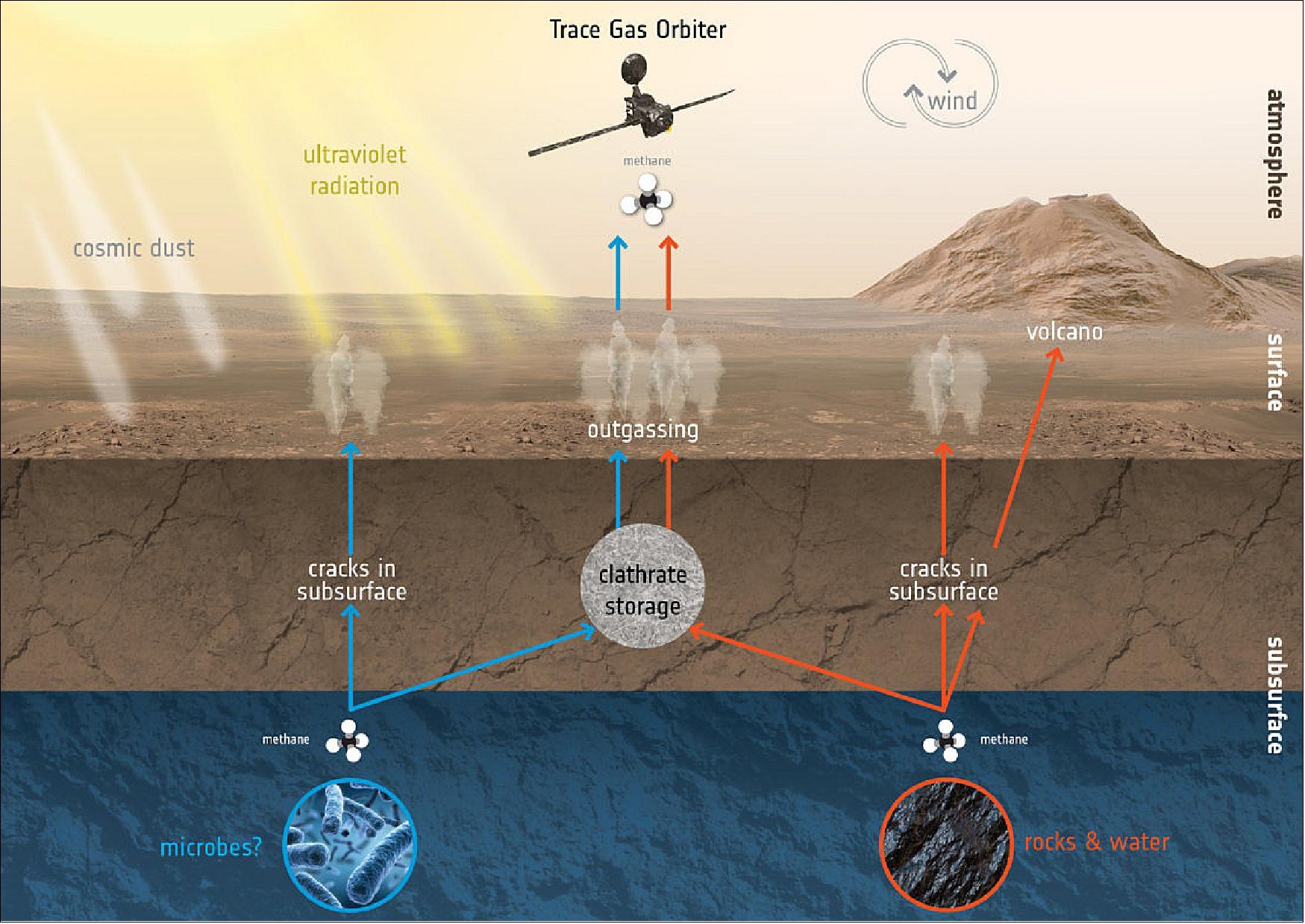
Legend to Figure 94: Methane can also be generated by reactions between water and olivine-rich rocks, perhaps in combination with warmer, volcanic environments. Again, this could be stored underground in icy cages, and outgassed through cracks in the surface – or through volcanoes. Ultraviolet radiation can both break down the methane and generate it through reactions with other molecules or organic material already on the surface, such as comet dust falling onto Mars. Methane can also be quickly distributed around the planet by strong winds, ‘diluting’ its signal and making it challenging to identify individual sources.
Methane on Mars is expected to have a rather short lifetime – around 400 years – so any detections imply it must have been produced or released relatively recently. The Trace Gas Orbiter will build up a picture over time of the methane distribution, to understand geographic and seasonal distributions, and eventually home in on areas where it might be originating.
The spacecraft has the capability to detect and analyze methane and other trace gases, even in low concentrations, with an improved accuracy of three orders of magnitude compared to previous measurements. Furthermore, it will be able to detect key ‘isotopologues’ of methane and water (isotopologues are molecules that have at least one atom with a different number of neutrons than the parent chemical species) to help distinguish between the different formation scenarios.
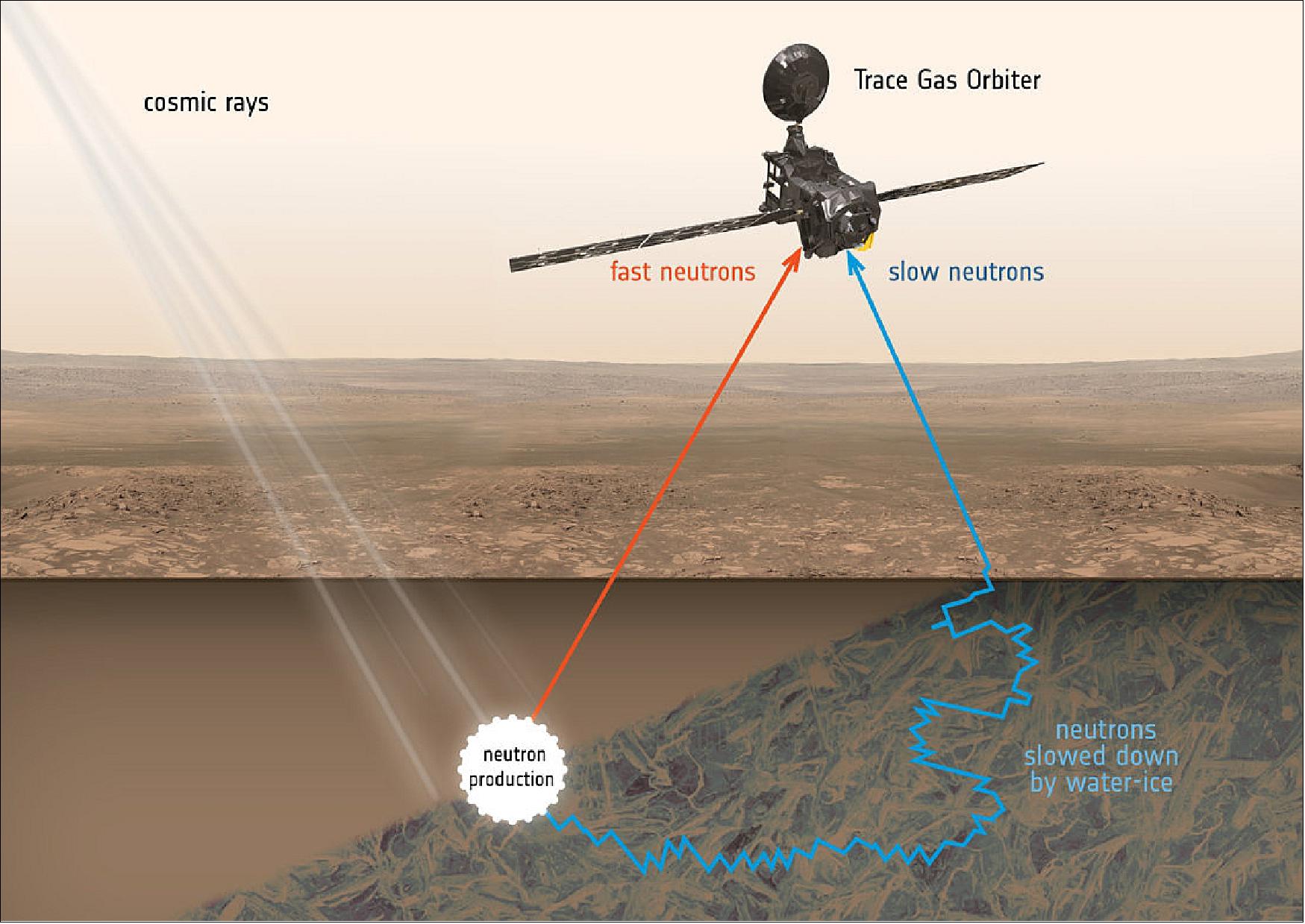
Legend to Figure 95: The graphic shows a simple representation of the detection process. Cosmic rays constantly bombard the surface of Mars; they knock neutrons out of the atoms they encounter on the surface and underneath. If water or frozen water-ice is present, hydrogen atoms cause multiple reflections in their paths through the subsurface, slowing down the neutrons. While some neutrons are captured in the subsurface, others escape back out into space. The speeds at which they arrive at the detector on TGO help determine the nature of the subsurface: those that have interacted with water will have lost some of their energy, and be travelling relatively slower than those that have not.
- The four instruments will make complementary measurements of the atmosphere, surface and subsurface. Its camera will help to characterize features on the surface that may be related to trace-gases sources.
- Its instruments will also look for water-ice hidden just below the surface, which along with potential trace gas sources could guide the choice for future mission landing sites.
- It will also soon start providing communication relay for NASA’s Opportunity and Curiosity rovers, ahead of the arrival of NASA’s InSight lander later this year, and for the ExoMars rover and surface science platform in March 2021.
- Preliminary relay tests with NASA’s rovers were conducted in November 2016, shortly after the orbiter’s arrival at Mars. Eventually, it will provide multiple data relay connections each week. — The ExoMars program is a joint endeavor between ESA and Roscosmos.
• February 21, 2018: ESA is reporting that the ”surfing is complete” — referring to ”the 'aerobraking campaign' during which we commanded ExoMars to dip into the wispy, upper-most tendrils of the atmosphere once per revolution, slowing the craft and lowering its orbit,” says ESA flight director Michel Denis. 85)
- “This took advantage of the faint drag on the solar wings, steadily transforming the orbit. It’s been a major challenge for the mission teams supported by European industry, but they’ve done an excellent job and we’ve reached our initial goal. During some orbits, we were just 103 km above Mars, which is incredibly close.”
- The end of this effort came at 17:20 GMT on 20 February, when the spacecraft fired its thrusters for about 16 minutes to raise the closest approach to the surface to about 200 km, well out of the atmosphere. This effectively ended the aerobraking campaign, leaving it in an orbit of about 1050 km x 200 km.
- “Aerobraking works only because we spent significant time in the atmosphere during each orbit, and then repeated this over 950 times,” says Michel. “Over a year, we’ve reduced the speed of the spacecraft by an enormous 3600 km/h, lowering its orbit by the necessary amount.”
- Trimming: In the next month, the control team will command the craft through a series of up to 10 orbit-trimming maneuvers, one every few days, firing its thrusters to adjust the orbit to its final two-hour, circular shape at about 400 km altitude, expected to be achieved around mid-April.
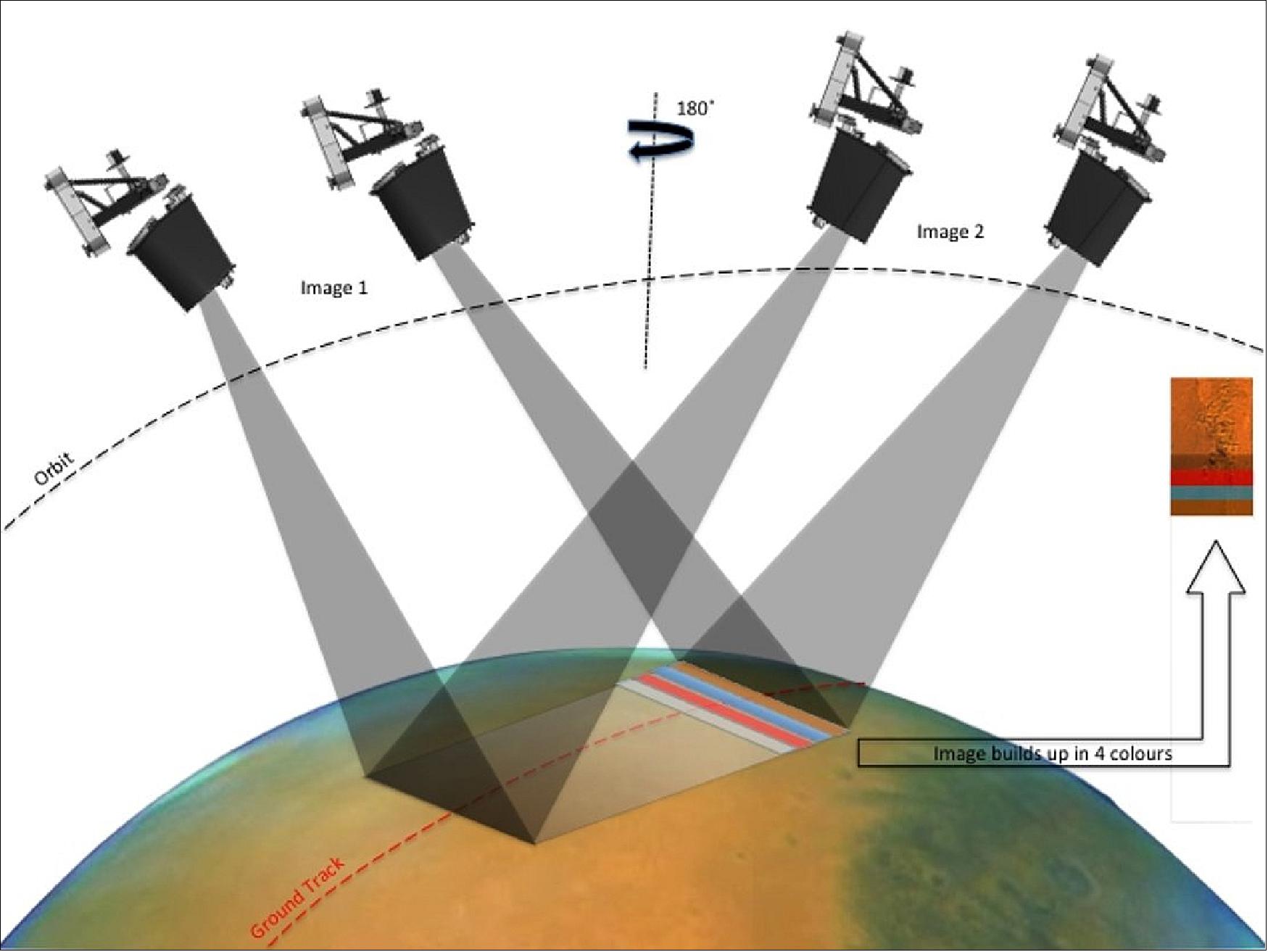
- The initial phases of science gathering, in mid-March, will be devoted to checking out the instruments and conducting preliminary observations for calibration and validation. The start of routine science observations should happen around 21 April.
- “Then, the spacecraft will be reoriented to keep its camera pointing downwards and its spectrometers towards the Sun, so as to observe the Mars atmosphere, and we can finally begin the long-awaited science phase of the mission,” says Håkan Svedhem, ESA’s project scientist.
- The main goal is to take a detailed inventory of trace gases, in particular seeking out evidence of methane and other gases that could be signatures of active biological or geological activity.
- A suite of four science instruments will make complementary measurements of the atmosphere, surface and subsurface. Its camera will help to characterize features on the surface that may be related to trace-gases sources, such as volcanoes. - It will also look for water-ice hidden just below the surface, which along with potential trace gas sources could guide the choice for future mission landing sites.
- Long-distance calls: April will also see the spacecraft test its data-relay capability, a crucial aspect of its mission at Mars.
- A NASA-supplied radio relay payload will catch data signals from US rovers on the surface and relay these to ground stations on Earth. Data relaying will get underway on a routine basis later in the summer.
- Starting in 2021, once ESA’s own ExoMars rover arrives, the orbiter will provide data-relay services for both agencies and for a Russian surface science platform. - ExoMars is a joint endeavor between ESA and Roscosmos.
• February 1, 2018: According to Armelle Hubault, the Spacecraft Operations Engineer on the TGO flight control team, the ExoMars mission has made tremendous progress and is well on its way to establishing its final near-circular orbit at an altitude of ~400 km around the Red Planet. 86)
- The graphic of Figure 97 provides a very concise visualization of the fantastic progress we’ve made with aerobraking to date. It was coded by my ExoMars TGO colleague Johannes Bauer; the bold grey lines show successive reductions in the ExoMars TGO orbital period by 1 hour; the thin lines by 30 minutes.
- We started on the biggest orbit with an apocenter (the furthest distance from Mars during each orbit) of 33,200 km and an orbit of 24 hours in March 2017, but had to pause last summer due to Mars being in conjunction.
- We recommenced aerobraking in August 2017, and are on track to finish up in the final science orbit in mid-March 2018. As of today, 30 Jan 2018, we have slowed ExoMars TGO by 781.5 m/s.
- On 30 Jan. 2018 at 15:35 CET (Central European Time), the spacecraft was where the red dot is, coming out of pericenter passage (passing through the point of closest approach over the surface – where Mars’ thin, uppermost atmosphere drags on the craft the most to give the braking effect).
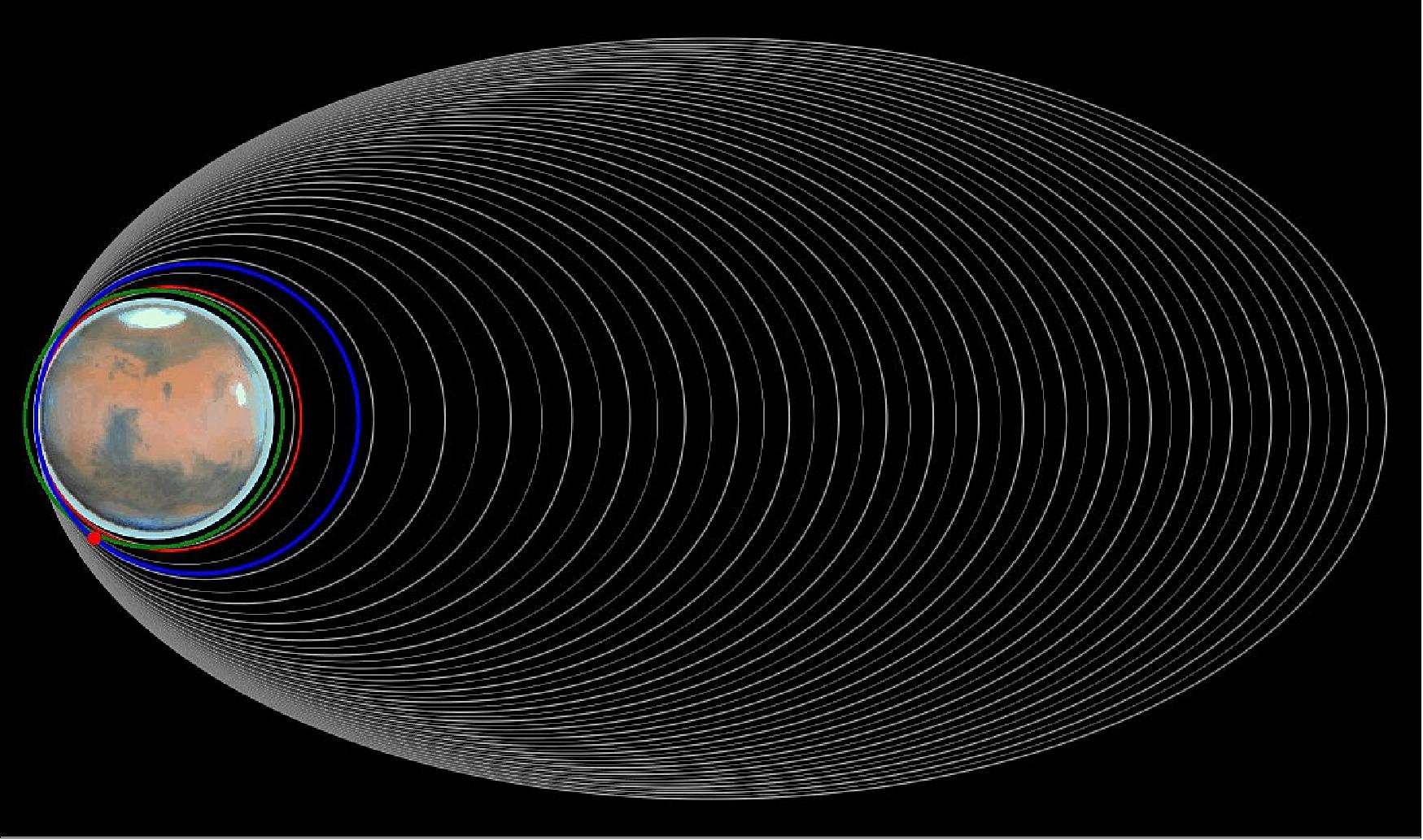
- The blue line is the current orbit, which takes only 2 hrs and 48 min and with the apocenter reduced to 2700 km; the red line shows the final aerobraking orbit we expect to achieve later in March. Then, we will use the thrusters to maneuver the spacecraft into the green orbit (roughly 400 km circular) – the final science and operational data relay orbit. - The image is pretty much to scale.
- We have to adjust our pericenter height regularly, because on the one hand, the martian atmosphere varies in density (so sometimes we brake more and sometimes we brake less) and on the other hand, martian gravity is not the same everywhere (so sometimes the planet pulls us down and sometimes we drift out a bit). We try to stay at about 110 km altitude for optimum braking effect.
- To keep the spacecraft on track, we upload a new set of commands every day – so for us, for flight dynamics and for the ground station teams, it’s a very demanding time!
- When TGO skims through the atmosphere, it has to adopt a specific orientation to optimize the braking effect and to make sure it stays stable and does not start to spin madly, which would not be optimal. — We are basically using the solar panels as ‘wings’ to slow us down and circularize the orbit.
- The main challenge at the moment is that, since we never know in advance how much the spacecraft is going to be slowed during each pericenter passage, we also never know exactly when it is going to reestablish contact with our ground stations after pointing back to Earth.
- We are working with a 20-min ‘window’ for acquisition of signal (AOS), when the ground station first catches TGO’s signal during any given station visibility, whereas normally for interplanetary missions we have a firm AOS time programmed in advance.
- With the current orbital period now just below 3 hrs, we go through this little exercise 8 times per day!
• January 24, 2018: In 2013, the European Space Agency and Roscosmos—the Russian governmental body responsible for space research—agreed to cooperate on ExoMars, the first joint interplanetary mission between ESA and Russia. This project now involves scientists from 29 research organizations, including MIPT (Moscow Institute of Physics and Technology) and the IKI (Space Research Institute) of the Russian Academy of Sciences (RAS), which is the leading contributor of hardware and equipment on the Russian side. By now, the first package of observation instruments has been delivered into Mars orbit to seek minor chemical components of the planet's atmosphere that may be traces of primitive life (Ref. 127). 87)
- Even if the new data prove to be inconclusive, they will definitely heat up the discussion on whether there ever was life on the red planet. In early 2018, the ExoMars satellite with research instruments on board will lower into its operational orbit and begin observations of the Martian atmosphere. A recent article in Space Science Reviews describes the makeup and objectives of one of the two Russian-built instruments carried by the orbiter.
- The ExoMars joint space mission of ESA and Roscosmos involves two phases. The first one started on March 14, 2016, with the launch of a Proton-M booster rocket from Russia's space complex in Baikonur, Kazakhstan. The rocket launched two modules: the Schiaparelli lander and the TGO (Trace Gas Orbiter). The two were delivered to Mars in 226 days, making a journey of 500 million km.
- Schiaparelli was intended to test the technology for future landings. It attempted a landing, but crashed to the surface. TGO's objectives are to detect trace gases in the atmosphere, map water ice distribution below the surface, and conduct high-resolution imaging, including stereo surface imaging.
- The favorable launch windows for Mars trajectories happen once in about two years, and the second phase of the ExoMars mission is scheduled for 2020. A new lander will deploy a rover to navigate autonomously across the Martian surface, transmitting the data it collects via TGO. The main objective of the ExoMars mission is to explore whether life ever existed on Mars.
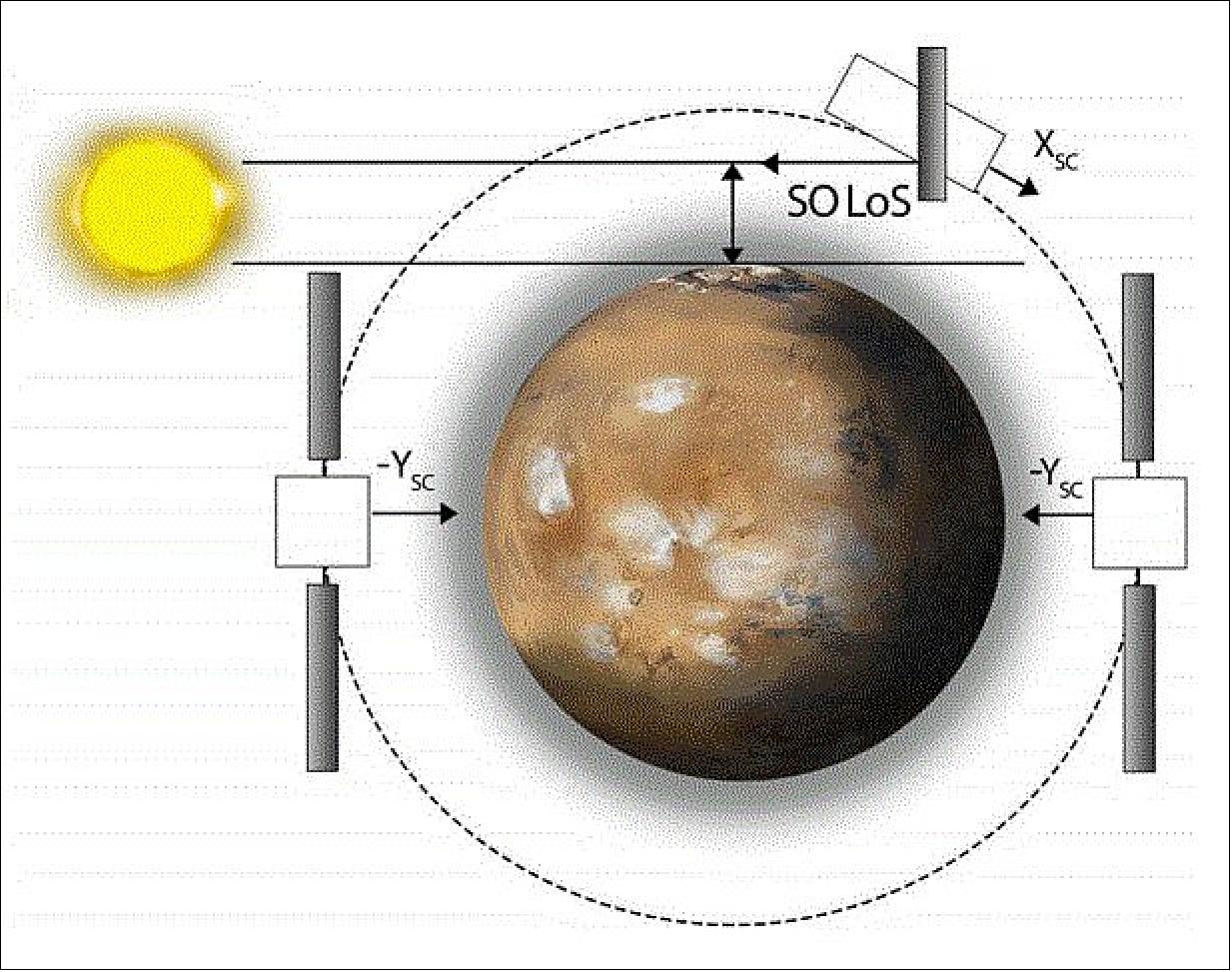
- The TGO satellite carries four scientific instruments: a high-resolution color imaging system, a high-resolution neutron detector, and two spectrometer suites. The epithermal neutron detector and the ACS (Atmospheric Chemistry Suite) were built at the Space Research Institute in Moscow (IKI).
- TGO's primary scientific objective is to study the climate, atmosphere, and surface of Mars. Using its onboard detectors, sensitive enough to spot trace amounts of gases, the orbiter is expected to settle the doubts concerning the presence of atmospheric methane on Mars. This gas was previously detected by Earth-based telescopes and NASA's Curiosity rover.
- The Russian-built ACS (Figure 133) comprises three infrared spectrometers. It is sensitive enough to detect and measure trace amounts of atmospheric gases such as methane, which could be a sign of geological or biological activity on Mars. The spectrometers have a resolving power of 10,000 or more and a broad spectral coverage—from 0.7 to 17 micrometers. With their help, TGO will clarify the role of the major Martian atmospheric constituents—carbon dioxide, water vapor, and aerosols—in the planet's climate.
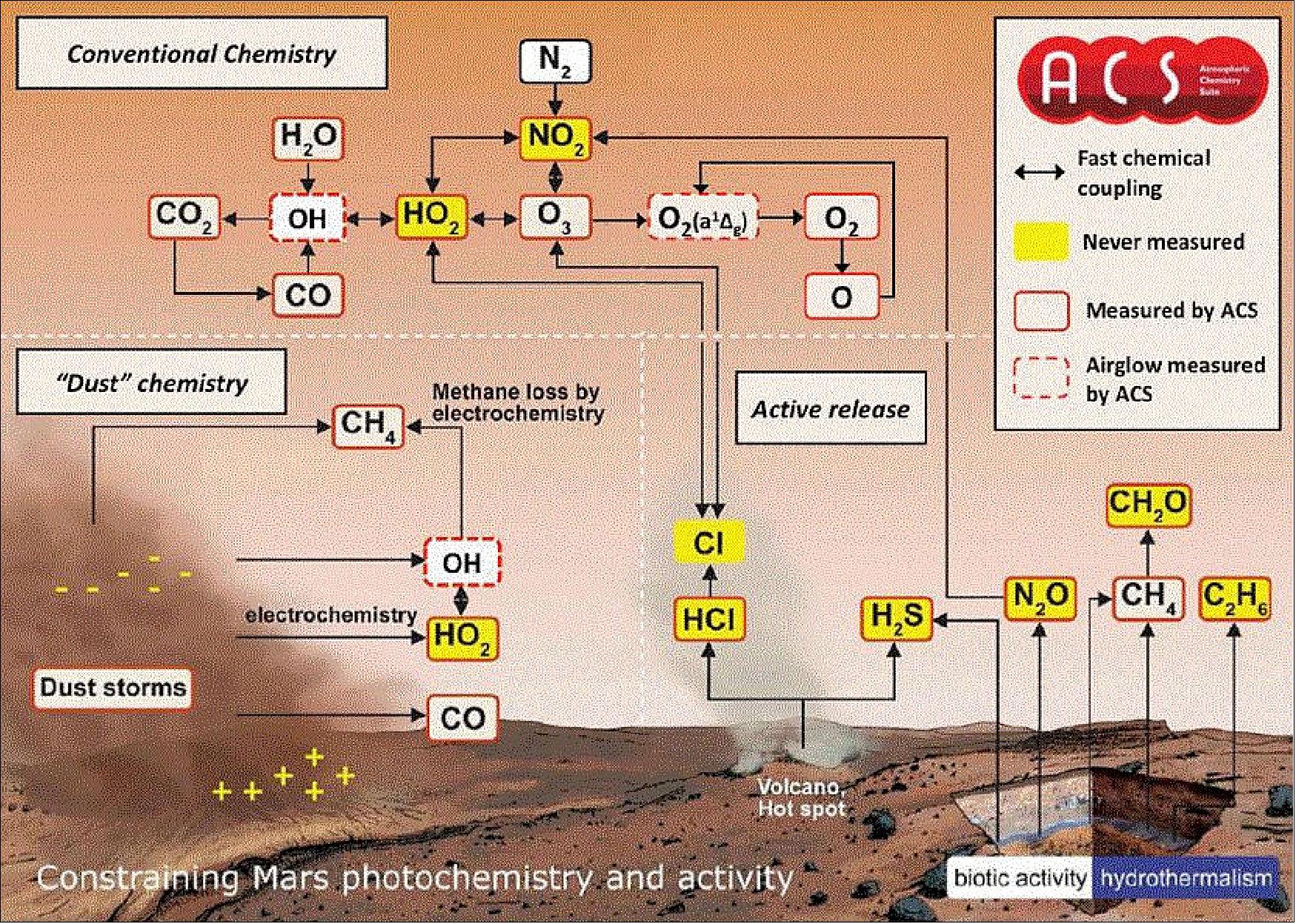
- The near-infrared (NIR) channel is accommodated by a versatile echelle spectrometer covering the spectral range between 0.7 and 1.6 µm with a resolving power of about 20,000. This device will mainly focus on the measurements of water vapor, aerosols, the dayside airglows of molecular oxygen, and the nightside airglows caused by the photochemical processes in the Martian atmosphere. Observations in the NIR band will be conducted in three primary modes (Figure 99). Namely, the solar occultation measurements of light passing through the Martian atmosphere and the nadir—or "straight-down"—measurements of sunlight reflected by the planet and its own radiation. Limb measurements are also supported.
- The MIR (Mid-Infrared) channel is a cross-dispersion echelle spectrometer dedicated to solar occultation measurements in the 2.2-4.4 µm range. It has a resolving power of more than 50,000. By design, ACS-MIR will make high-sensitivity measurements of trace gas content, including methane and aerosol concentrations, and the deuterium-to-hydrogen ratio. Meeting the key objectives of the ExoMars mission will depend on observations in the mid-infrared band. It is largely this channel that holds promise of a scientific breakthrough.
- "It enables measurements of Martian atmosphere that are hundreds of times more accurate than ever before," says chief engineer Alexander Trokhimovskiy of the IKI/RAS, who led the work on ACS-MIR. "Also, the probe is bound for an orbit that makes fairly frequent solar occultation observations possible."
- MIPT (Moscow Institute of Physics and Technology) has developed data processing algorithms and designed a general circulation model of Martian atmosphere, which is required for planning experiments and interpreting their results," adds Alexander Rodin, the head of the Applied Infrared Spectroscopy Lab at MIPT.
- Known as TIRVIM, the third ACS instrument is a Fourier-transform spectrometer operating in the 1.7-17 µm range with a resolution of 0.2-1.3 /cm. It is responsible for gathering the data on Martian climate: atmospheric temperature profiles, dust content, and surface temperature. Thermal infrared measurements are expected to map temperatures from the surface of the planet all the way up to the altitude of about 60 km. The instrument will also make it possible to estimate the optical depths of Martian dust and clouds with unparalleled precision, providing an opportunity to detect ozone and hydrogen peroxide—two gases fundamental to Martian photochemistry (Figure 99).
- The TIRVIM detector owes the first half of its name to the thermal infrared, or TIR, spectral band, but the three final letters in the acronym honor Vasily Ivanovich Moroz, the founder of Russian infrared spectrometry and long-standing head of the Department of Planetary Physics at the Space Research Institute of the Russian Academy of Sciences.
• October 16, 2017: Diffuse, water-ice clouds, a hazy sky and a light breeze. Such might have read a weather forecast for the Tharsis volcanic region on Mars on 22 November 2016, when this image was taken by the ExoMars TGO (Trace Gas Orbiter). 88)
- Below, 630 km west of the volcano Arsia Mons, the southernmost of the Tharsis volcanoes, outlines of ancient lava flows dominate the surface (Figure 100). The dark streaks are due to the action of wind on the dark-colored basaltic sands, while redder patches are wind blown dust. A handful of small impact craters can also be seen.
- The Trace Gas Orbiter, a joint effort between ESA and Roscosmos, arrived at Mars on 19 October last year. Since March it has been repeatedly surfing in and out of the atmosphere, generating a tiny amount of drag that will steadily pull it into a near-circular 400 km altitude orbit. It is expected to begin its full science operational phase from this orbit in early 2018.
- Prior to this ‘aerobraking’ phase, several test periods were assigned to check the four science instrument suites from orbit and to refine data processing and calibration techniques.
- The false-color composite shown here was made from images taken with the CaSSIS (Color and Stereo Surface Imaging System) in the near-infrared, red and blue channels.
- The image is centered at 131°W / 8.5°S. The ground resolution is 20.35 m/pixel, and the image is about 58 km across. At the time the image was taken, the altitude was 1791 km, yielding a ground track speed of 1.953 km/s.
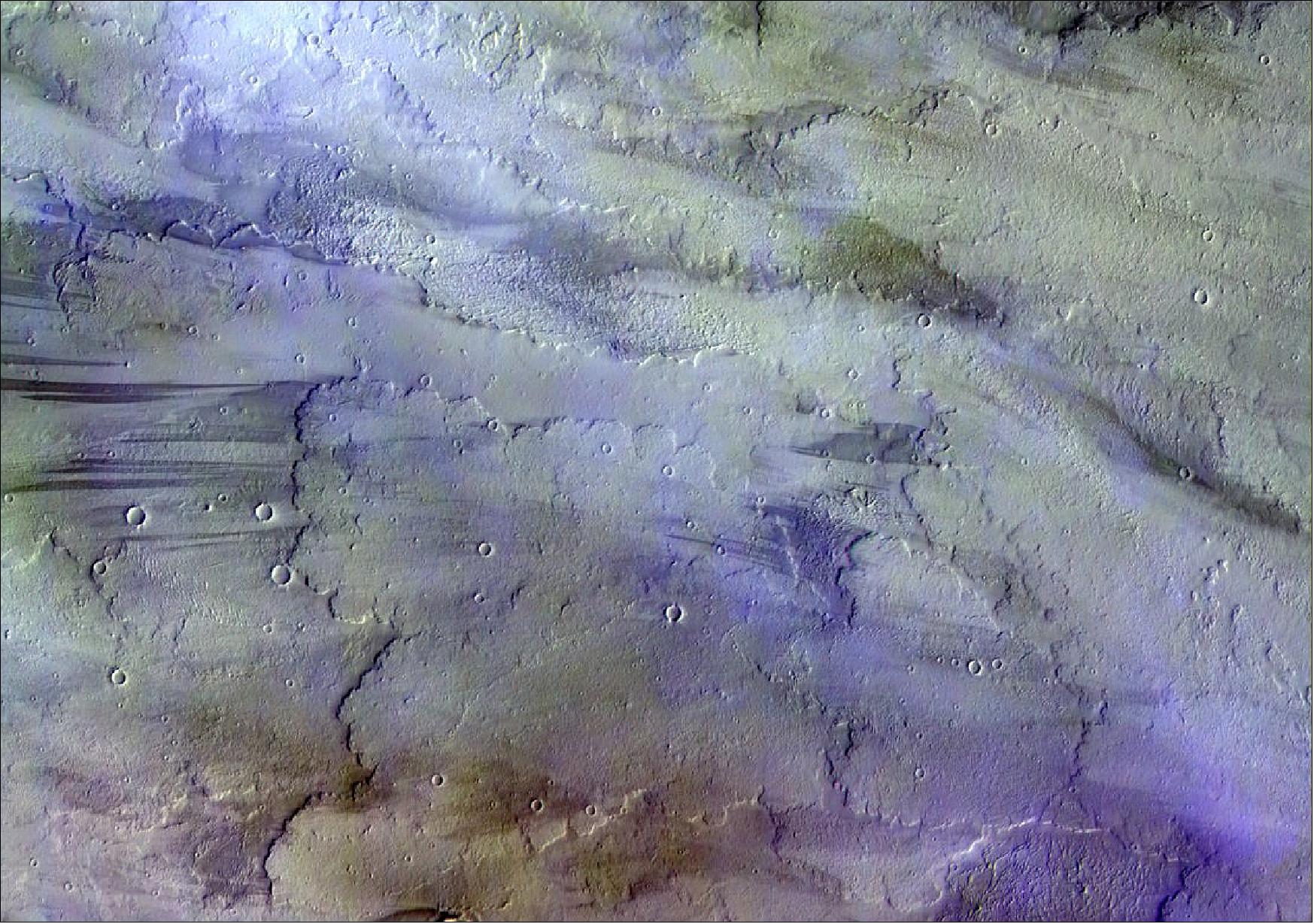
• May 24, 2017: The inquiry into the crash-landing of the ExoMars Schiaparelli module has concluded, that conflicting information in the onboard computer caused the descent sequence to end prematurely. 89)
- The Schiaparelli entry, descent and landing demonstrator module separated from its mothership, the TGO (Trace Gas Orbiter), as planned on 16 October last year, and coasted towards Mars for three days.
- Much of the six-minute descent on 19 October 2016 went as expected: the module entered the atmosphere correctly, with the heatshield protecting it at supersonic speeds. Sensors on the front and back shields collected useful scientific and engineering data on the atmosphere and heatshield.
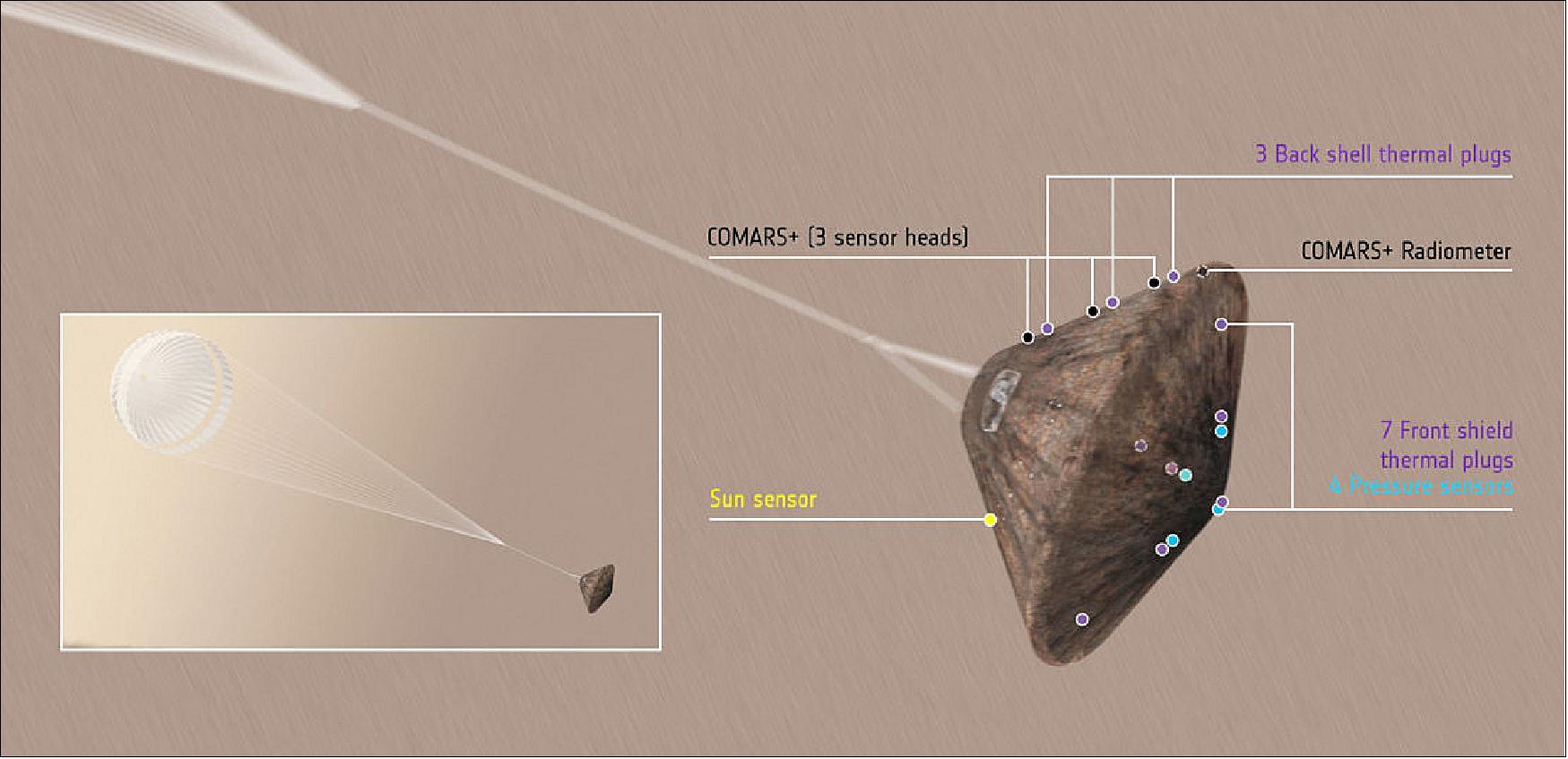
- Telemetry from Schiaparelli was relayed to the main craft, which was entering orbit around the Red Planet at the same time – the first time this had been achieved in Mars exploration. This realtime transmission proved invaluable in reconstructing the unfolding chain of events.
- At the same time as the orbiter recorded Schiaparelli’s transmissions, ESA’s Mars Express orbiter also monitored the lander’s carrier signal, as did the Giant Meterwave Radio Telescope in India.
- In the days and weeks afterwards, NASA’s Mars Reconnaissance Orbiter took a number of images identifying the module, the front shield, and the parachute still connected with the backshield, on Mars, very close to the targeted landing site.
- The images of Figure 102 suggested that these pieces of hardware had separated from the module as expected, although the arrival of Schiaparelli had clearly been at a high speed, with debris strewn around the impact site.
- The independent external inquiry, chaired by ESA’s Inspector General, has now been completed.
- It identifies the circumstances and the root causes, and makes general recommendations to avoid such defects and weaknesses in the future. The report summary can be downloaded here. A summary of the final report is available in PDF. 90)
- Around three minutes after atmospheric entry the parachute deployed, but the module experienced unexpected high rotation rates. This resulted in a brief ‘saturation’ – where the expected measurement range is exceeded – of the Inertial Measurement Unit, which measures the lander’s rotation rate.
- The saturation resulted in a large attitude estimation error by the guidance, navigation and control system software. The incorrect attitude estimate, when combined with the later radar measurements, resulted in the computer calculating that it was below ground level.
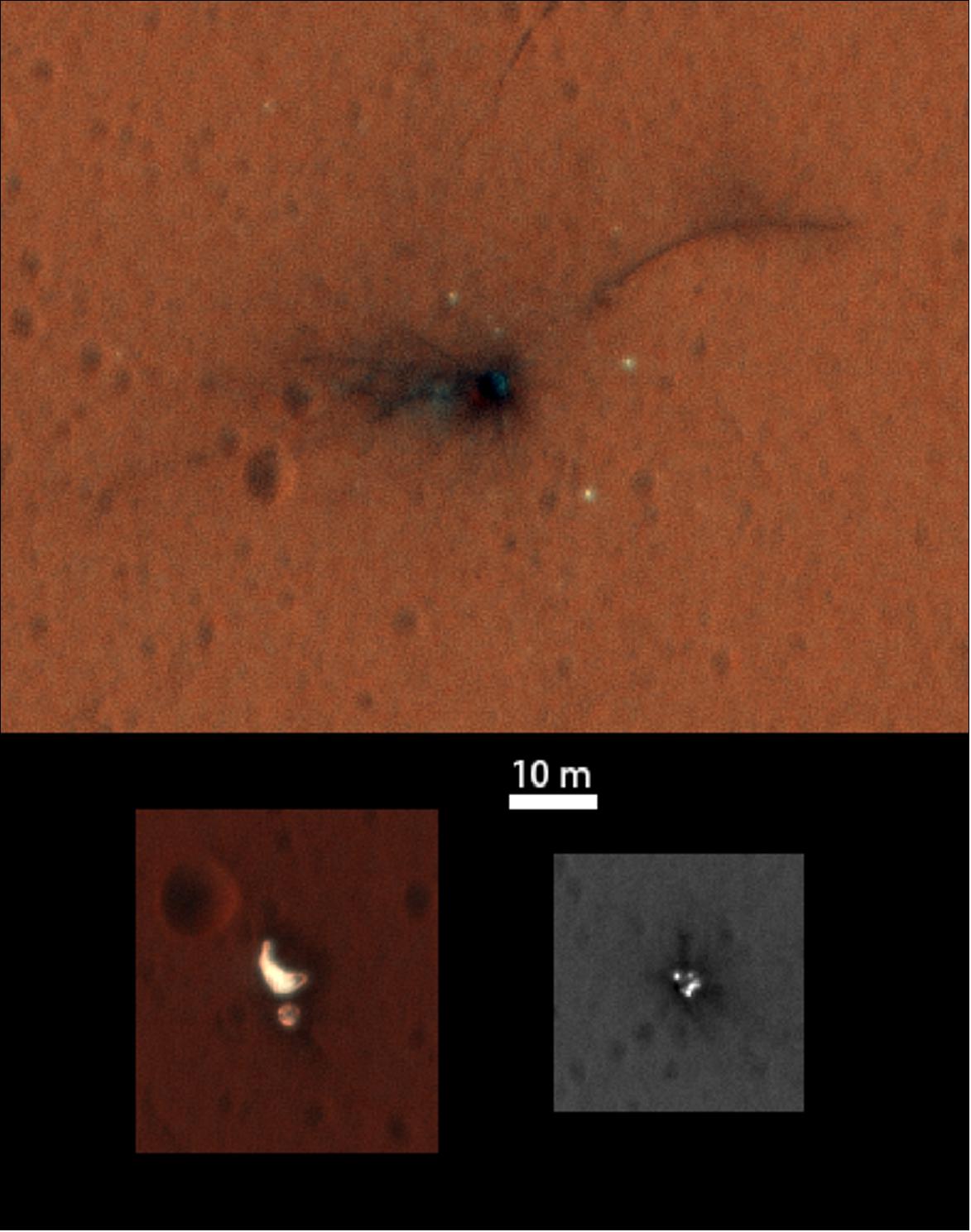
Legend to Figure 102: The colors have been graded according to the specific region to best reveal the contrast of features against the martian background. These images are in raw image geometry rather than map-projected, and north is about 7º west of straight up.
- This resulted in the early release of the parachute and back-shell, a brief firing of the thrusters for only 3 sec instead of 30 sec, and the activation of the on-ground system as if Schiaparelli had landed. The surface science package returned one housekeeping data packet before the signal was lost.
- In reality, the module was in free-fall from an altitude of about 3.7 km, resulting in an estimated impact speed of 540 km/h.
- The Schiaparelli Inquiry Board report noted that the module was very close to landing successfully at the planned location and that a very important part of the demonstration objectives were achieved. The flight results revealed required software upgrades, and will help improve computer models of parachute behavior.
- “The realtime relay of data during the descent was crucial to provide this in-depth analysis of Schiaparelli’s fate,” says David Parker, ESA’s Director of Human Spaceflight and Robotic Exploration.
- “We are extremely grateful to the teams of hard-working scientists and engineers who provided the scientific instruments and prepared the investigations on Schiaparelli, and deeply regret that the results were curtailed by the untimely end of the mission. - There were clearly a number of areas that should have been given more attention in the preparation, validation and verification of the entry, descent and landing system. We will take the lessons learned with us as we continue to prepare for the ExoMars 2020 rover and surface platform mission. Landing on Mars is an unforgiving challenge but one that we must meet to achieve our ultimate goals.”
- “Interestingly, had the saturation not occurred and the final stages of landing had been successful, we probably would not have identified the other weak spots that contributed to the mishap,” notes Jan Woerner, ESA's Director General. “As a direct result of this inquiry we have discovered the areas that require particular attention that will benefit the 2020 mission.”
- ExoMars 2020 (Figure 103) has since passed an important review confirming it is on track to meet the launch window. Having been fully briefed on the status of the project, ESA Member States at the Human Spaceflight, Microgravity and Exploration Program Board reconfirmed their commitment to the mission, which includes the first Mars rover dedicated to drilling below the surface to search for evidence of life on the Red Planet.
- Meanwhile the Trace Gas Orbiter has begun its year-long aerobraking in the fringes of the atmosphere that will deliver it to its science orbit in early 2018. The spacecraft has already shown its scientific instruments are ready for work in two observing opportunities in November and March.
- In addition to its main goal of analyzing the atmosphere for gases that may be related to biological or geological activity, the orbiter will also act as a relay for the 2020 rover and surface platform. — The ExoMars program is a joint endeavor between ESA and Roscosmos.
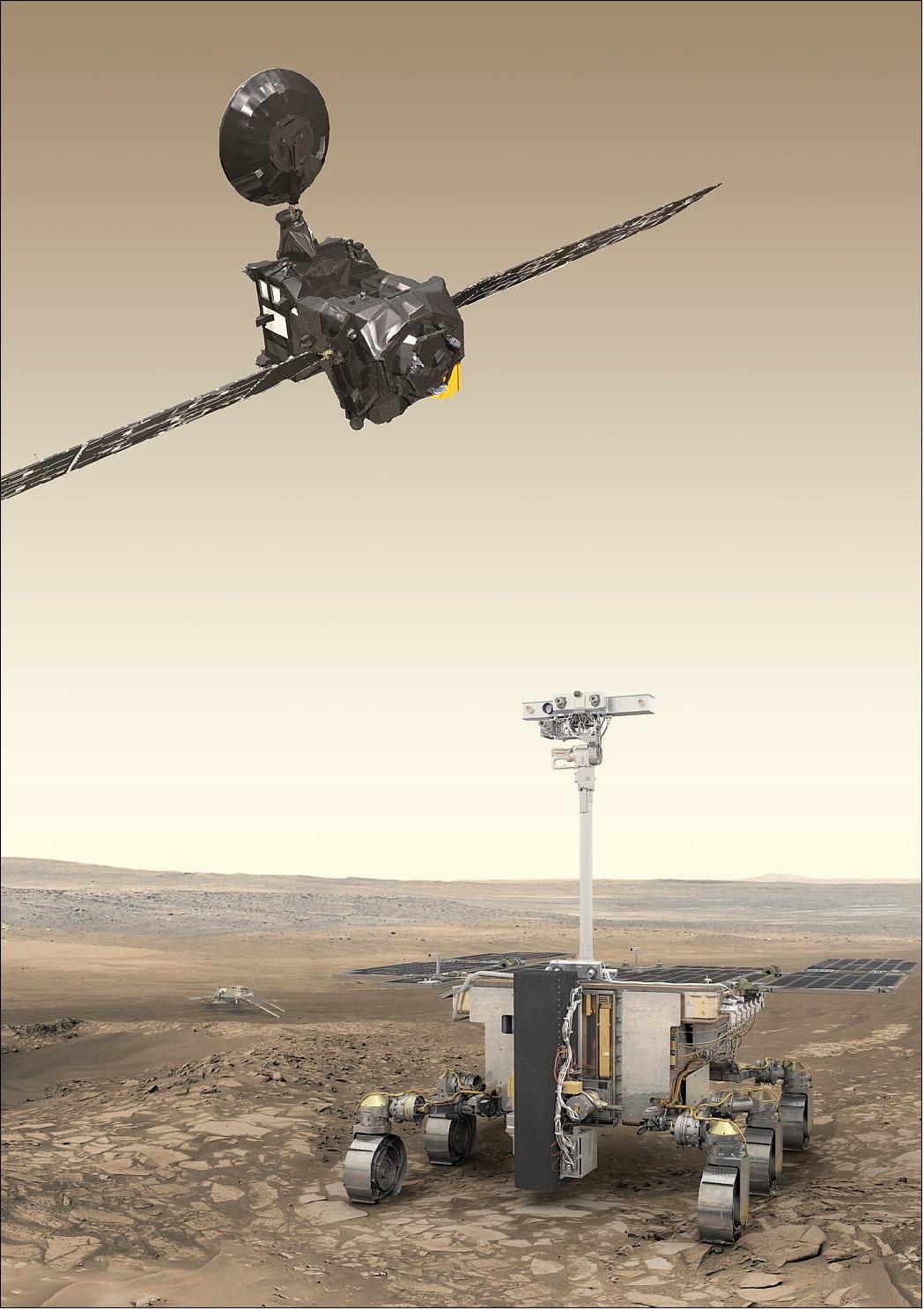
• March 28, 2017: Two ancient sites on Mars that hosted an abundance of water in the planet’s early history have been recommended as the final candidates for the landing site of the 2020 ExoMars rover and surface science platform: Oxia Planum and Mawrth Vallis. 92)
- A primary technical constraint is that the landing site be at a suitably low level, so that there is sufficient atmosphere to help slow the landing module’s parachute descent. Then, the 120 x 19 km landing ellipse should not contain features that could endanger the landing, the deployment of the surface platform ramps for the rover to exit, and driving of the rover. This means scrutinizing the region for steep slopes, loose material and large rocks.
- Oxia Planum was selected in 2015 for further detailed evaluation. Although not yet complete, the investigation so far indicates that the region would meet the various constraints. In addition, one other site had to be chosen from Aram Dorsum and Mawrth Vallis.
- After a two-day meeting with experts from the Mars science community, industry, and ExoMars project, during which the scientific merits of the three sites were presented alongside the preliminary compliance status with the engineering constraints, it was concluded that Mawrth Vallis will be the second site to be evaluated in more detail.
- Around a year before launch, the final decision will be taken on which site will become the ExoMars 2020 landing target.
- All of the sites lie just north of the equator, in a region with many channels cutting through from the southern highlands to the northern highlands. As such, they preserve a rich record of geological history from the planet’s wetter past billions of years ago, and are prime targets for missions like ExoMars that are searching for signatures of past life on Mars.
- Oxia Planum lies at a boundary where many channels emptied into the vast lowland plains and exhibits layers of clay-rich minerals that were formed in wet conditions some 3.9 billion years ago.
- Observations from orbit show that the minerals in Oxia Planum are representative of those found in a wide area around this region, and so would provide insight into the conditions experienced at a global scale during this epoch of martian history.
- Mawrth Vallis is a large outflow channel a few hundred kilometers away from Oxia Planum. The proposed landing ellipse is just to the south of the channel. The entire region exhibits extensively layered, clay-rich sedimentary deposits, and a diversity of minerals that suggests a sustained presence of water over a period of several hundred million years, perhaps including localized ponds.
- In addition, light-toned fractures containing ‘veins’ of water-altered minerals point to interactions between rocks and liquid in subsurface aquifers, and possible hydrothermal activity that may have been beneficial to any ancient life forms.
- Mawrth Vallis offers a window into a large period of martian history that could probe the early evolution of the planet’s environment over time. “While all three sites under discussion would give us excellent opportunities to look for signatures of ancient biomarkers and gain new insights into the planet’s wetter past, we can only carry two sites forward for further detailed analysis,” says Jorge Vago, ESA’s ExoMars rover project scientist. "Thus, after an intense meeting, which focused primarily on the scientific merits of the sites, the Landing Site Selection Working Group has recommended that Mawrth Vallis join Oxia Planum as one of the final two candidates for the ExoMars 2020 mission. Both candidate sites would explore a period of ancient martian history that hasn’t been studied by previous missions.”
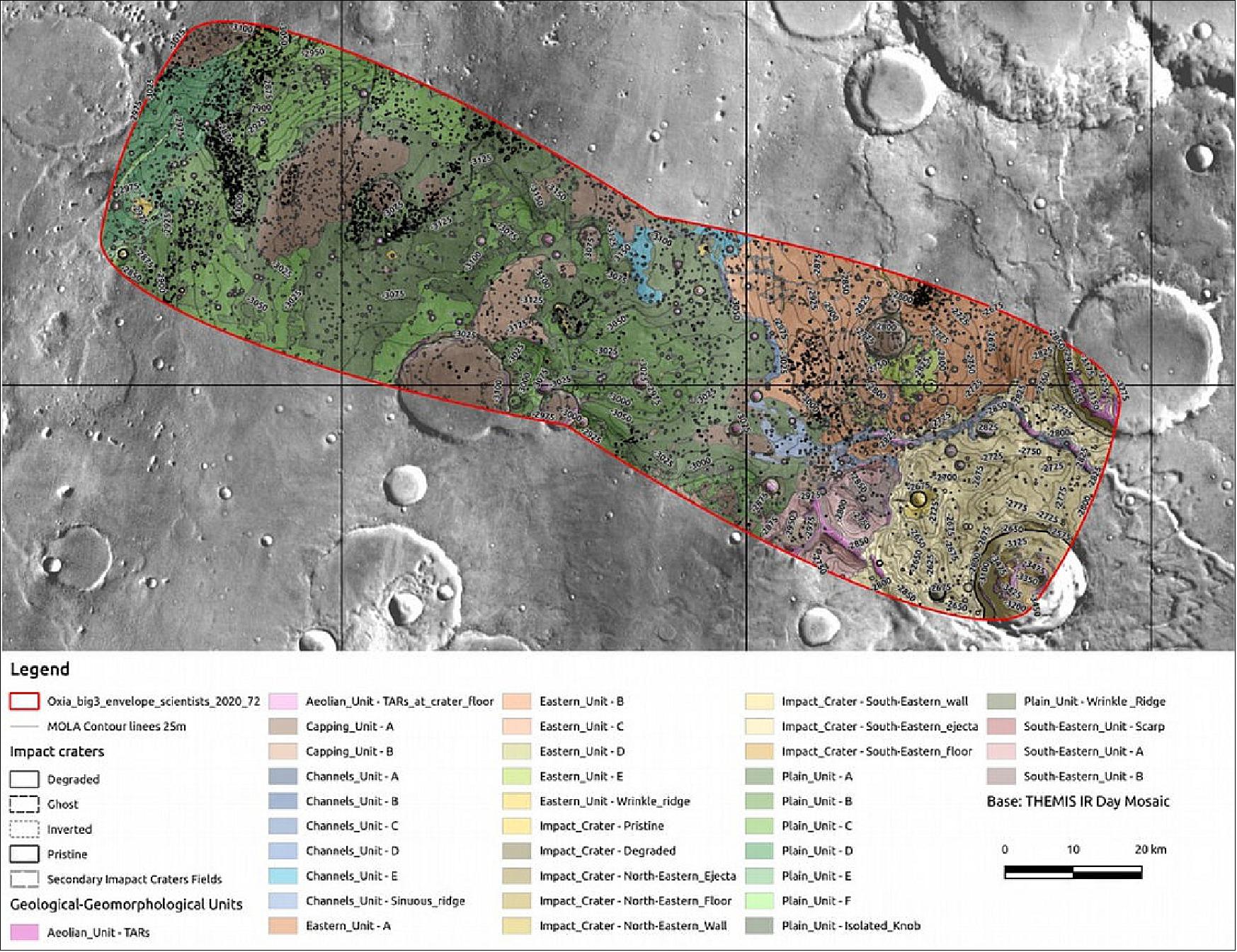
Legend to Figure 104: One example of how the Oxia Planum landing site under consideration for the ExoMars 2020 mission is being analyzed. The map outlines a boundary (red) that encapsulates the range of possible 120 x 19 km landing ellipses, with some added margin. Elevation contours are also indicated. The colors represent the variety of surface terrains identified, including plains (green shades), channels (blues), impact craters (yellow, with black outlines), and wind-blown features (pink). It is not a geological map intended for scientific analysis, but rather a tool used to identify different surface textures and where potential hazards may lie.
The background image is from the Thermal Emission Imaging System instrument on NASA’s Mars Odyssey orbiter.
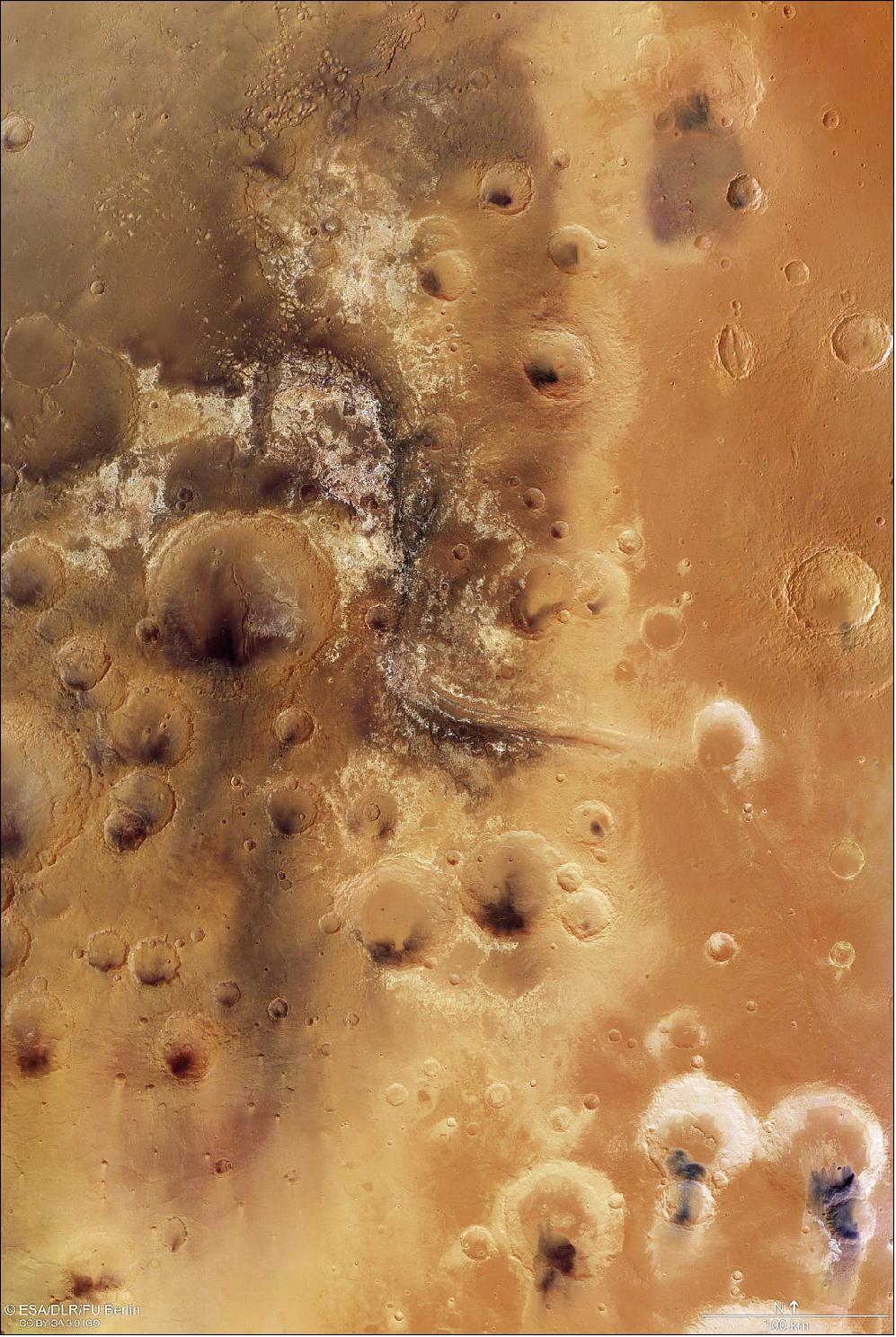
Legend to Figure 9: Sculpted by ancient water flowing on the surface, Mawrth Vallis is one of the most remarkable outflow channels on Mars. The valley, once a potentially habitable place, is one of the main features of a region at the boundary between the southern highlands and the northern lowlands.
Mawrth Vallis takes center stage in this image, a bird’s eye view of a 330,000 km2 area surrounding the valley. With a length of 600 km and a depth of up to 2 km, it is one of the biggest valleys on Mars. Huge amounts of water once passed through it, from a higher elevation region, part of which is shown in the lower right of the image, into the northern plains, in the top left.
Among the remarkable features are the large exposures of light-toned phyllosilicates (weathered clay minerals) that lie along its course. Phyllosilicates on Mars are evidence of the past presence of liquid water and point to the possibility that habitable environments could have existed on the planet up until 3.6 billion years ago.
A dark cap rock, remains of ancient volcanic ash, covers many of the clays and could have protected traces of ancient microbes in the rocks from radiation and erosion. This makes Mawrth Vallis one of the most interesting regions for geologists and astrobiologists alike. It is one of the candidate landing sites for ExoMars 2020, a joint mission between ESA and Russia, with the primary goal of finding out if life once existed on Mars.
The name comes from the Welsh word for Mars (“Mawrth”) and the Latin for valley (“Vallis”). This mosaic was created using nine individual images taken by the high-resolution stereo camera on ESA’s Mars Express spacecraft, which has been orbiting Mars since late 2003. It is one of a set of images of this region previously published on 7 July 2016 on the DLR website and the homepage of the Freie Universität Berlin.
• March 27, 2017: Choosing the rover’s landing site is a demanding and lengthy process, because it must not only be interesting scientifically but also safe from an engineering viewpoint. Establishing whether life ever existed on Mars is at the heart of the ExoMars program, thus the chosen site should be ancient – around 3.9 billion years old – with abundant evidence of water having been present for extended periods. 93)
- The rover has a drill (the dark grey box at the front in Figure 106) that is capable of extracting samples from depths of 2 m. This is crucial, because the present surface of Mars is a hostile place for living organisms owing to the harsh solar and cosmic radiation. By searching underground, the rover has a better chance of finding preserved evidence.
- From an engineering perspective, the site has to be low-lying, to allow the entry module to descend through enough atmosphere to help slow its descent with parachutes, and it must not contain features that could endanger the landing, such as craters, steep slopes and large rocks.
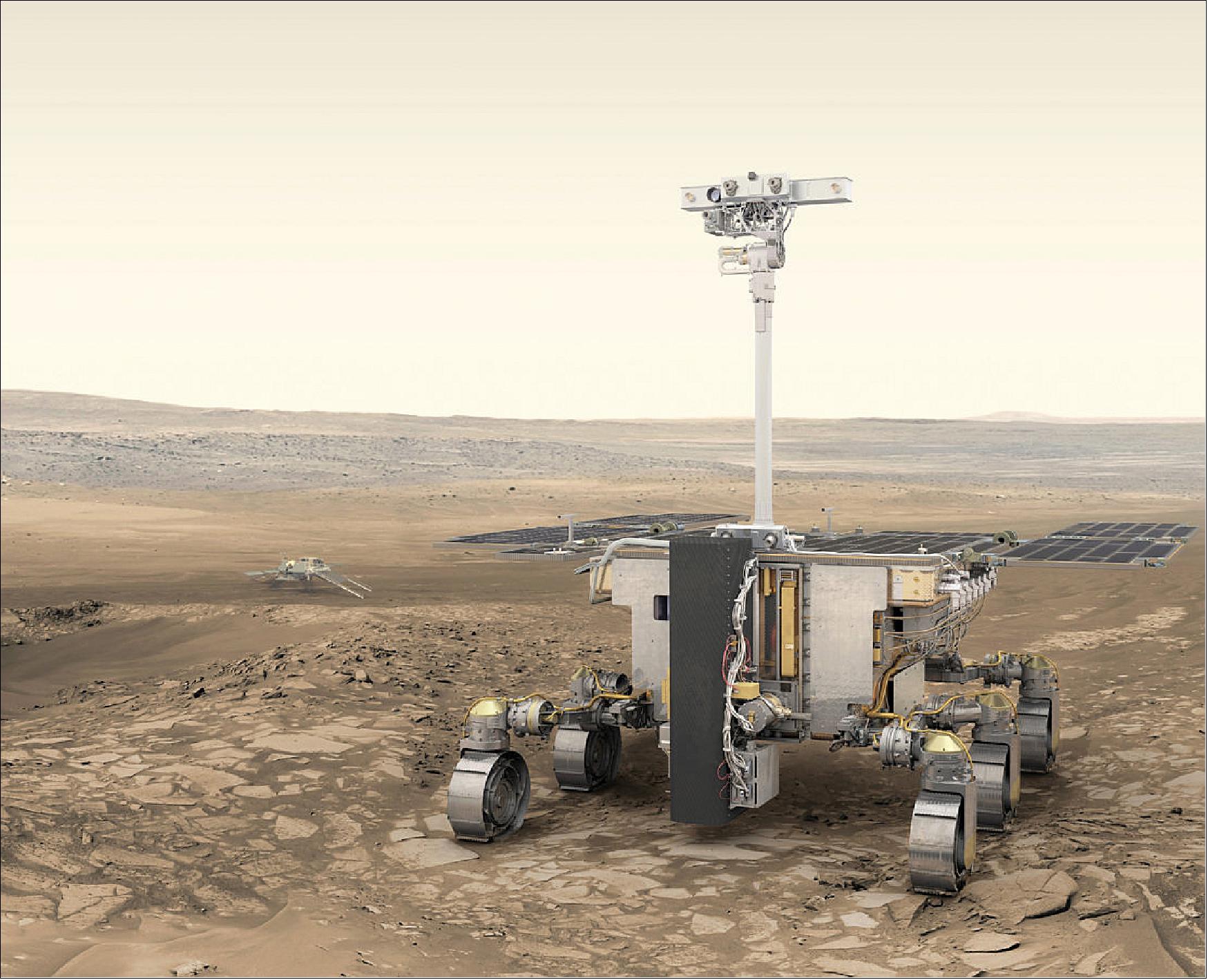
- The 310 kg rover will traverse the martian landscape on six wheels (Figure 107). It will be the first rover capable of drilling down 2 m, where ancient biomarkers may still be preserved from the harsh radiation environment on the surface. The drill is housed in the large box at the front of the rover. It will collect samples with the drill and deliver them to the Analytical Laboratory Drawer in the body of the rover, via the sample delivery window.
- The drill, shown here with the front casing of the drill box removed to reveal the interior, also contains the Mars Multispectral Imager for Subsurface Studies (Ma_MISS), which will image the walls of the borehole created by the drill to study the mineralogy and rock formation.
- PanCam, the panoramic camera, will provide stereo and 3D imagery of the terrain around the rover. ISEM (Infrared Spectrometer for ExoMars) will determine the major mineral composition of distant rocks, outcrops, and soils. CLUPI (Close-Up Imager) will acquire high-resolution, color, close-up images of outcrops, rocks, soils, drill fines and drill core samples. Navigation cameras and ‘localisation’ cameras are used to determine where the rover is and where it will move.
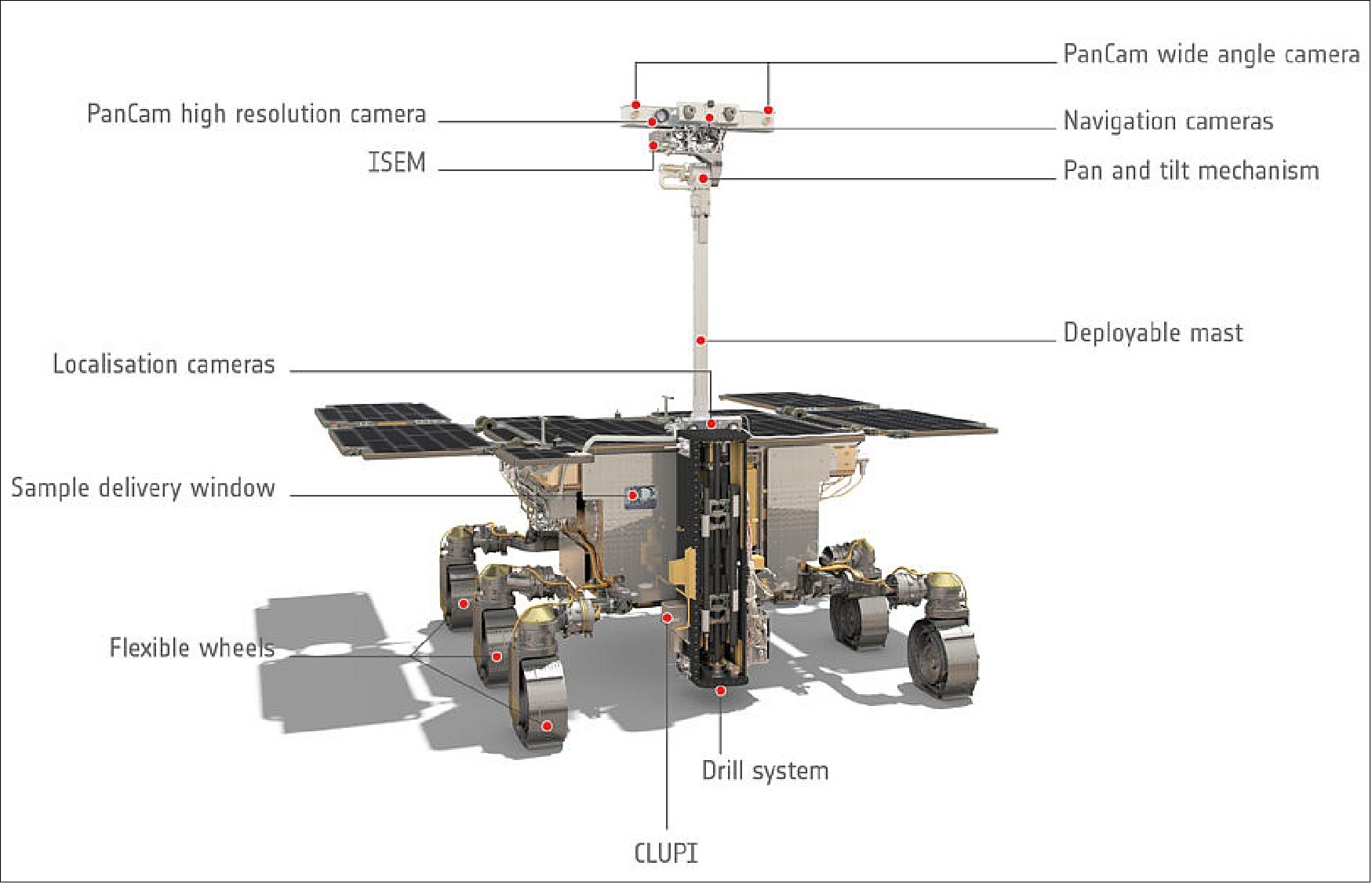
- The rover will traverse the martian landscape on six wheels. Power is supplied to the rover by solar arrays. These are folded during the journey to Mars and deployed once the rover is on the martian surface. Two UHF monopole antennas are used to communicate with Mars orbiters, including the Trace Gas Orbiter.
- The antennas of the WISDOM ground-penetrating radar can be seen in this view (Figure 108). The WISDOM (Water Ice Subsurface Deposit Observation on Mars) instrument suite will provide a detailed view of the Red Planet's shallow subsurface structure by sounding the upper layers of its crust. This will give three-dimensional geological context of the terrain covered by the rover.
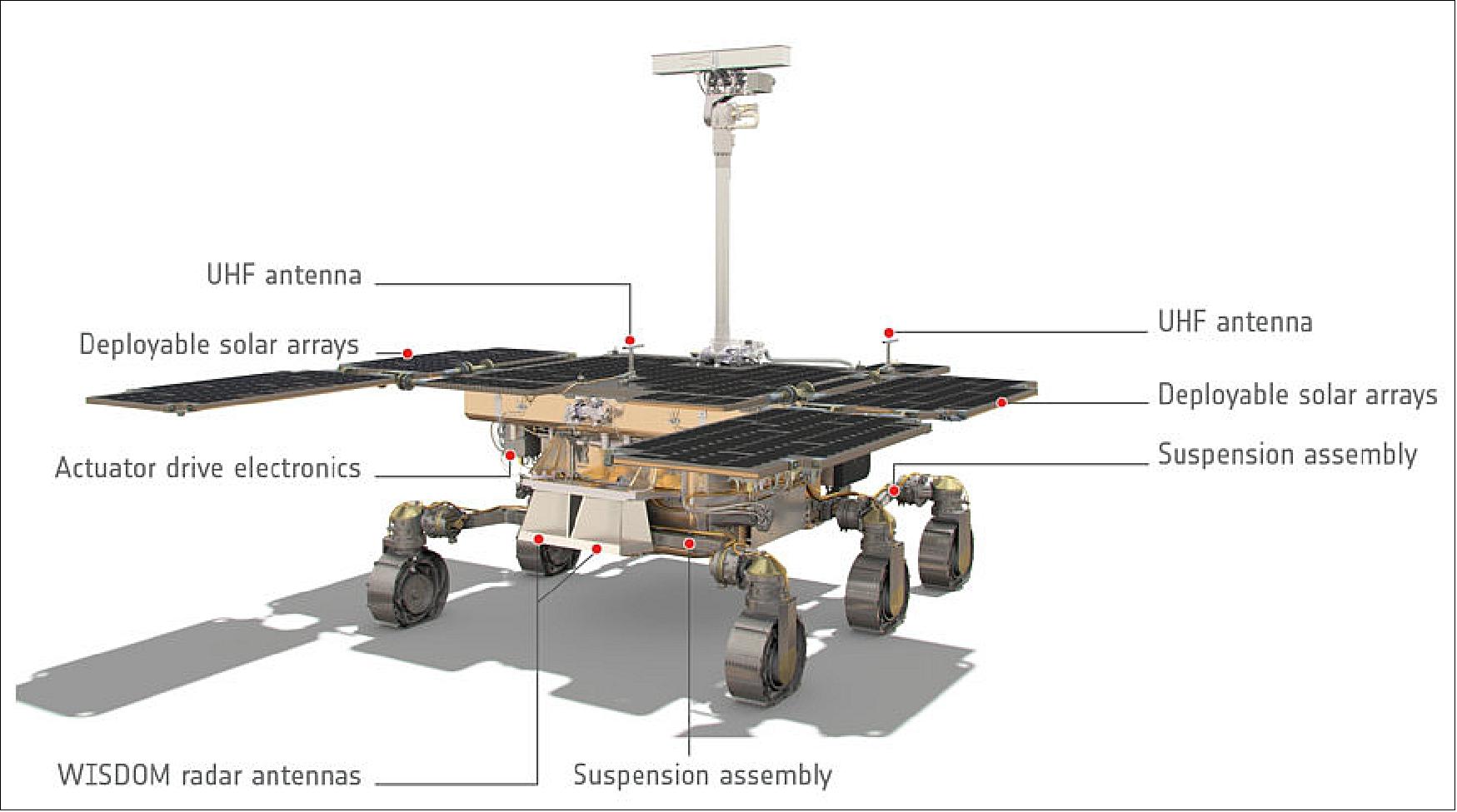
• March 16, 2017: The ExoMars TGO (Trace Gas Orbiter) has completed another set of important science calibration tests before a year of aerobraking gets underway. The mission was launched a year ago this week, and has been orbiting the Red Planet since 19 October. During two dedicated orbits in late November 2016, the science instruments made their first calibration measurements since arriving at Mars. The latest tests were carried out 5–7 March from a different orbit, and included checking procedures associated with taking images and collecting data on the planet’s atmosphere. 94)
- For example, the NOMAD (Nadir and Occultation for Mars Discovery) instrument made test observations to help determine the best settings to make future measurements of trace gases in the atmosphere (Figure 109). Methane in particular is of high interest. On Earth it is produced primarily by biological activity, and to a smaller extent by geological processes, such as some hydrothermal reactions. Understanding how the Red Planet’s methane is produced therefore has extremely exciting implications.
- NOMAD also had the opportunity to test joint measurements with the ACS (Atmospheric Chemistry Suite), which together will take highly sensitive measurements of the atmosphere to determine its constituents.
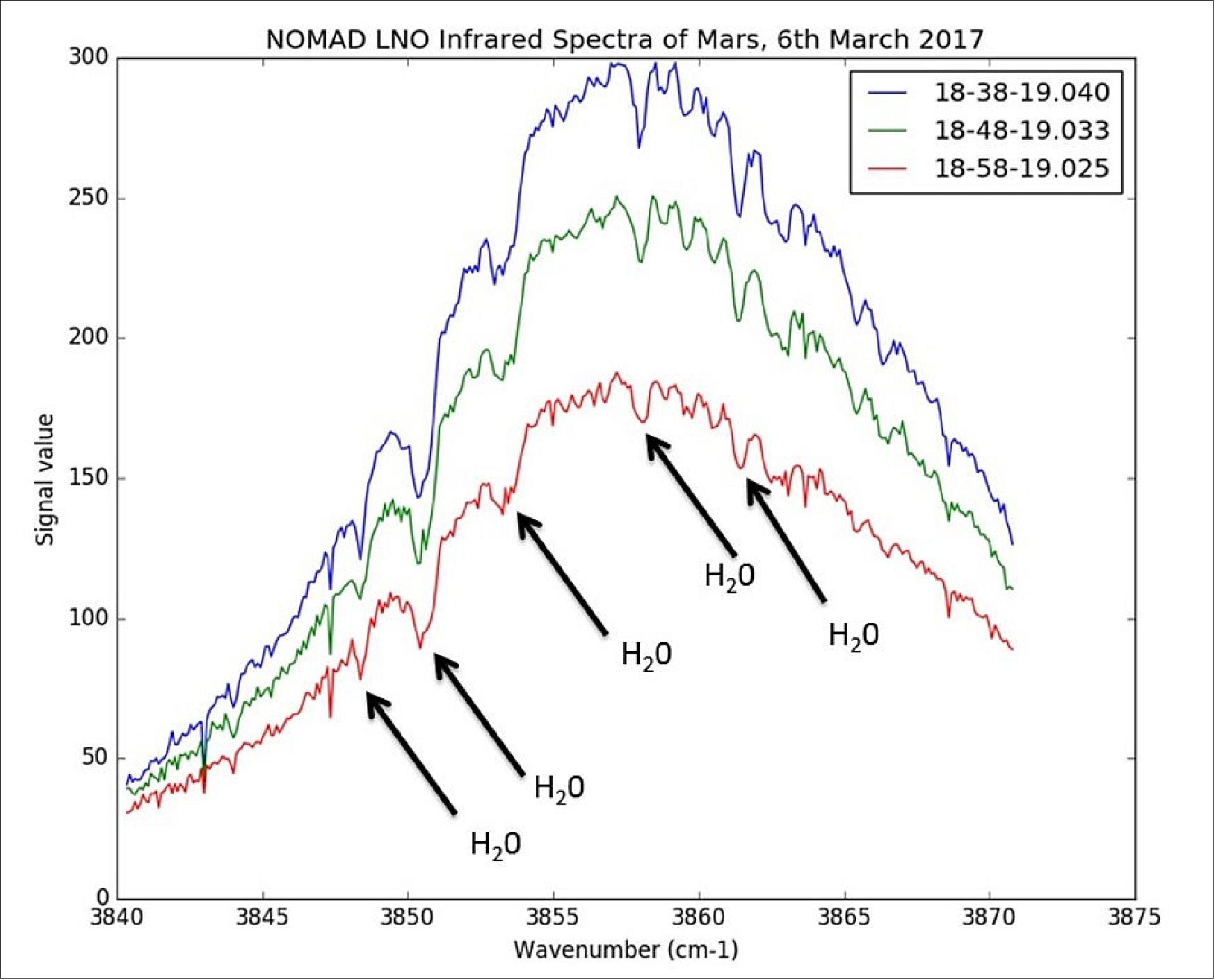
- Meanwhile, the FREND (Fine Resolution Epithermal Neutron Detector) detector continued to collect more on the flow of neutrons from the surface. Eventually, these data will be used to identify sites where water or ice might be hidden just below the surface.
- The high-resolution CaSSIS (Color and Stereo Surface Imaging System) was commanded to take a number of images, including star calibrations, and several pointing at Mars. An example is presented here, taken just as the orbiter was crossing the boundary between day and night, over the southern hemisphere. “These dress rehearsals enable our science teams to fine-tune their data acquisition techniques including pointing commands, iron out any software bugs, and get used to working with the data, well in advance of the start of the main mission starting next year,” says Håkan Svedhem, ESA’s project scientist. “What we’re seeing so far is really promising for our science goals.”
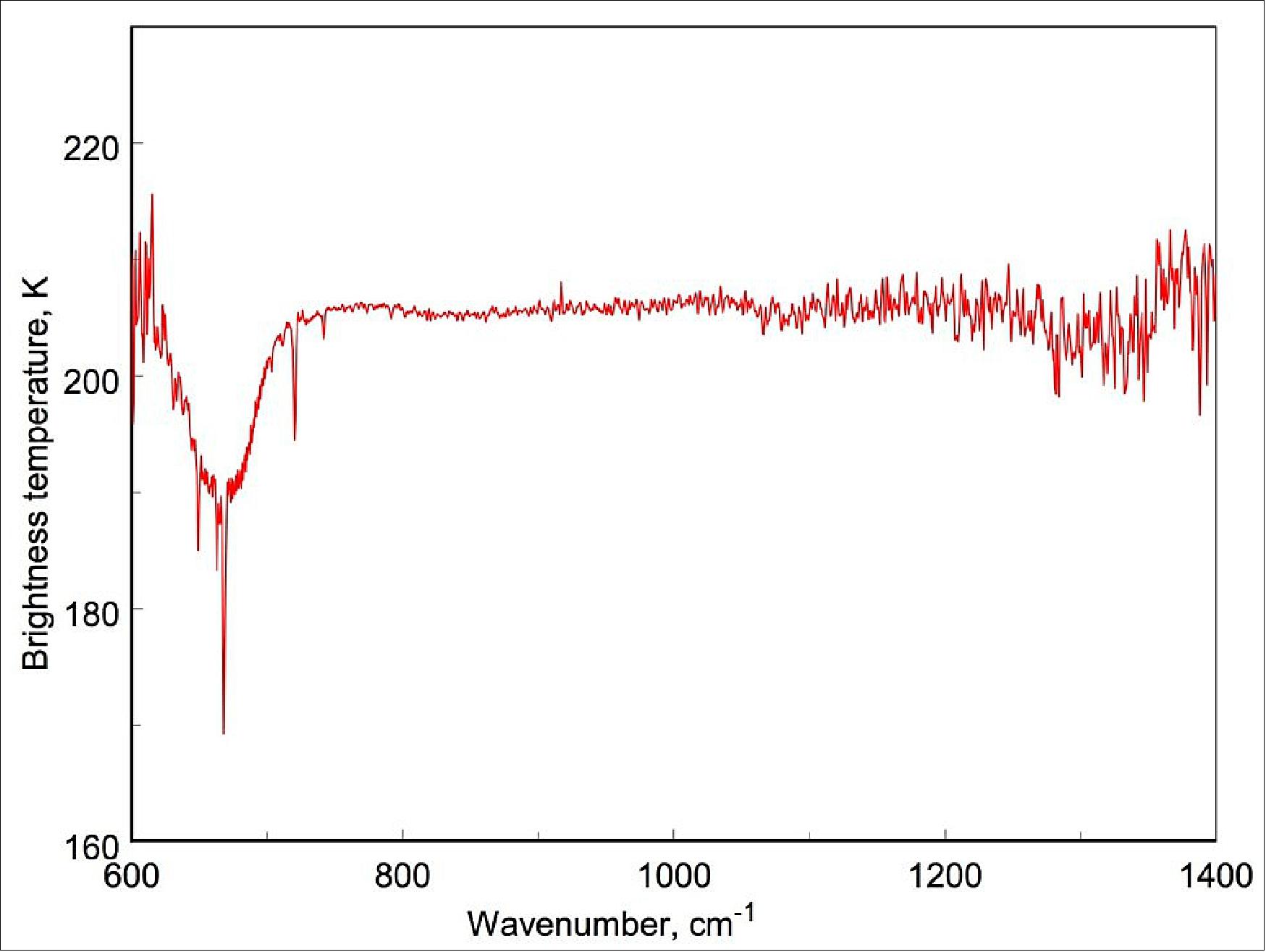
Legend to Figure 110: An example spectra is shown in the plot, made at thermal-infrared wavelengths. The deep and wide spectral band at the left of the plot is due to carbon dioxide, the main component of the martian atmosphere. Information held in the center of this band corresponds to the temperature of the upper layers of the atmosphere, while the ‘wings’ correspond to the lower layers. - Information like this will enable scientists to compute the temperature profile of the atmosphere, which in turn will contribute to computer models of global atmosphere circulation.
- Starting next year, the craft will make its observations from a near-circular 400 km-altitude orbit, circling the planet every two hours. TGO is currently in a one-day, 200 x 33 000 km orbit but will use the atmosphere to adjust the orbit gradually by ‘aerobraking’. It will repeatedly surf in and out of the atmosphere at closest approach, pulling down its furthest point over the course of the year.
- Earlier this week, the first commands for aerobraking were uploaded, ready to be executed starting yesterday. Over the next few weeks it will make seven engine burns that will adjust its orbit as part of a ‘walk-in’ period before the main aerobraking. This will first see the closest point of the orbit reduced to about 113 km.
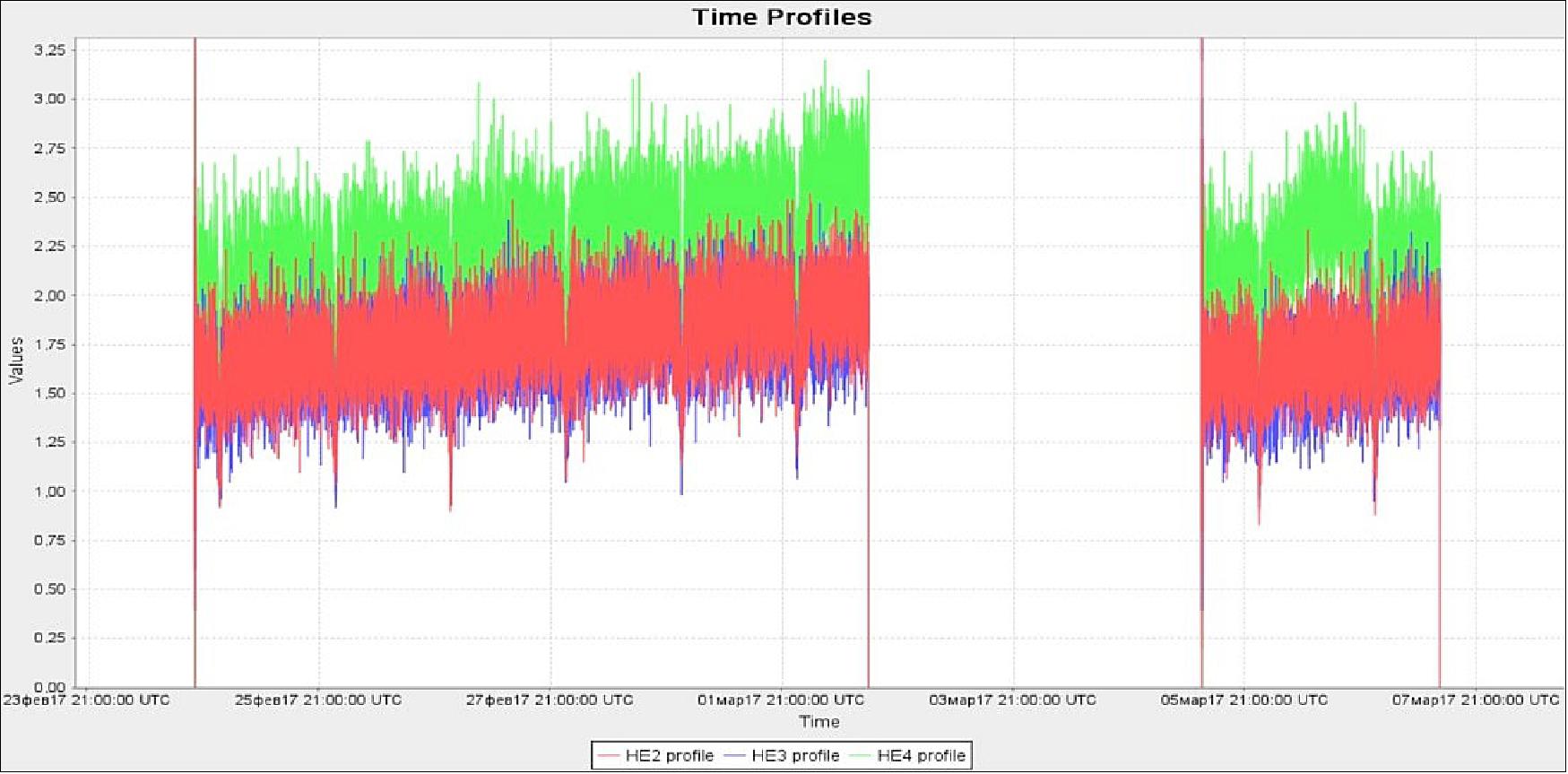
• March 13, 2017: As part of preparations for its main science mission to analyze the atmosphere for gases that may be related to biological or geological activity, and image sites that might be related to these sources, the TGO (Trace Gas Orbiter) has conducted two campaigns to test its science instruments – one last November and one last week (Figure 112). Presented here is one of the first image pairs taken by the orbiter’s high-resolution camera on 22 November, 2016. 95)
- By combining the image pair, a 3D image can be constructed and information about the relative heights of the surface features can be seen. The images were taken to test the timing of the images as the spacecraft moves over the surface, in order to best reconstruct the stereo images. Additional tests were conducted last week to fine-tune the process.
- Noctis Labyrinthus, or ‘Labyrinth of the night’, lies on the western edge of Valles Marineris, the grand canyon of the Solar System, and comprises a vast network of flat-topped plateaus and trenches. Landslides are seen in the flanks of the steep slopes.
- Since arriving, the orbiter has also conducted a number of maneuvers to change its orbital period and inclination, ready to begin the year-long aerobraking phase later this week. This process will use the planet’s atmosphere to gradually slow the spacecraft speed and so move it into a 400 km near-circular orbit, from which the craft will conduct its main science mission.
- The images were taken by the CaSSIS camera; the scale here is 7.2 m/pixel and the images correspond to an area on Mars about 15 x 45 km.

• February 7, 2017: ESA's ExoMars orbiter has moved itself into a new path on its way to achieving the final orbit for probing the Red Planet. 96)
- In January, ExoMars TGO conducted a series of crucial maneuvers, firing its main engine to adjust its orbit around Mars. The three firings shifted its angle of travel with respect to the equator to almost 74º from the 7º of its October arrival. This essentially raised the orbit from equatorial to being much more north–south (Figure 113).
- The arrival orbit was set so that it could deliver the Schiaparelli lander to Meridiani Planum, near the equator, with good communications.
- Once science observations begin next year, the new 74º orbit will provide optimum coverage of the surface for the instruments, while still offering good visibility for relaying data from current and future landers.
- The inclination change was also a necessary step for the next challenge: a months-long ‘aerobraking’ campaign designed to bring the spacecraft to its near-circular final science orbit, at an altitude of around 400 km.
- Mission controllers will command the craft to skim the wispy top of the atmosphere, generating a tiny amount of drag that will steadily pull it down. The process is set to begin in mid-March 2017, and is expected to take about 13 months.
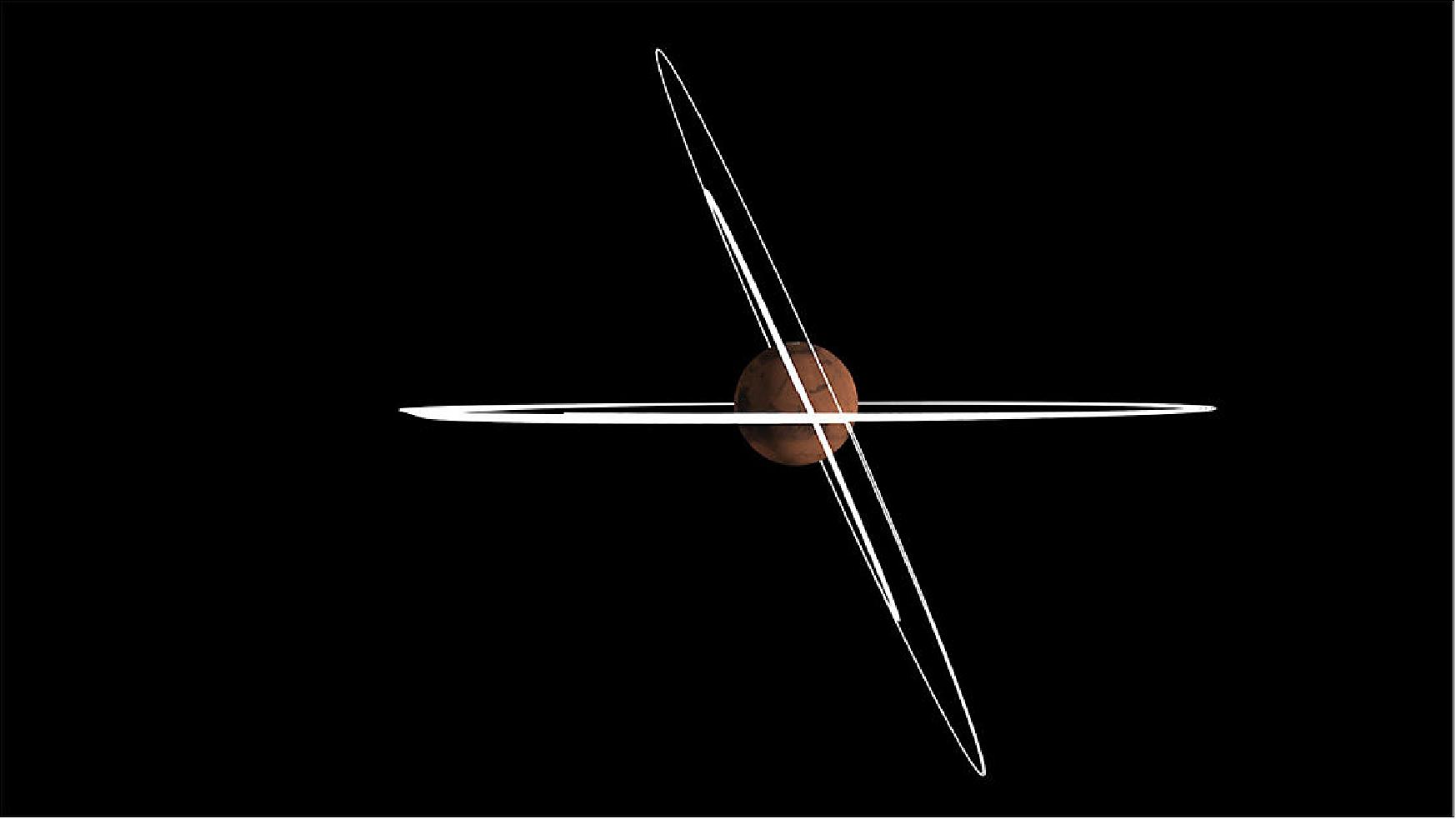
- Just before aerobraking, in early March, the science teams will have another opportunity to switch on their instruments and make vital calibration measurements from the new orbit. This will add to the test data collected during two dedicated orbits late last year, and is important preparation for the main science mission.
• December 16, 2016: The first ExoMars mission arrived at the Red Planet in October and now the second mission has been confirmed to complete its construction for a 2020 launch. ESA and Thales Alenia Space signed a contract today that secures the completion of the European elements of the next mission. The main objective of the ExoMars program is to address one of the most outstanding scientific questions of our time: is there, or has there ever been, life on Mars? 97) 98)
- The TGO (Trace Gas Orbiter) will soon be exploring this question from orbit: it will take a detailed inventory of trace gases, such as methane, that might be linked to biological or geological processes. The first test of the orbiter’s science instruments was recently completed. It will also act as a communications relay for various craft – in particular for 2020’s rover and surface platform.
- ESA’s rover will be the first capable of drilling 2 m into Mars, where ancient biomarkers may still be preserved from the harsh radiation environment on the surface.
- The Russian platform will carry instruments focused on the local atmosphere and surroundings. ExoMars is a joint endeavor between ESA and Roscosmos, with important contribution from NASA. The contract signed in Rome, Italy, secures the completion of the European elements and the rigorous tests to prove they are ready for launch.
- These include the rover itself, which will be accommodated within the Russian descent module, along with the carrier module for cruise and delivery to Mars. ESA is also contributing important elements of the descent module, such as the parachute, radar, inertial measurement unit, UHF radio elements, and the onboard computer and software.
- The science instruments for the rover and surface platform are funded by national agencies of ESA member states, Roscosmos and NASA following calls to the scientific community.
- The structural models of the carrier and rover are expected to be delivered in January and February 2017, respectively, along with structural and thermal models of the various descent module elements.
- “ExoMars is a cornerstone of ESA’s exploration program,” says David Parker, ESA’s Director of Human Spaceflight and Robotic Exploration. “Using its miniaturized life-search laboratory and advanced robotic technology, the mission will explore the Red Planet in search of new evidence to answer questions that have long fascinated humanity. “Following the renewed support demonstrated by ESA member states in the recent Ministerial Council, this new contract allows us to complete the flight models of the European elements and keeps us on track for a July 2020 launch.”
• December 16, 2016: After the smooth arrival of ESA’s latest Mars orbiter, mission controllers are now preparing it for the ultimate challenge: dipping into the Red Planet’s atmosphere to reach its final orbit. The ExoMars Trace Gas Orbiter is on a multiyear mission to understand the tiny amounts of methane and other gases in Mars’ atmosphere that could be evidence for possible biological or geological activity. 99)
- Following its long journey from Earth, the orbiter fired its main engine on 19 October to brake sufficiently for capture by the planet’s gravity. It entered a highly elliptical orbit where its altitude varies between about 250 km and 98 000 km, with each circuit taking about four Earth days. Ultimately, however, the science goals and its role as a data relay for surface rovers mean the craft must lower itself into a near-circular orbit at just 400 km altitude, with each orbit taking about two hours.
- Aerobraking: the ultimate challenge. Mission controllers will use ‘aerobraking’ to achieve this, commanding the craft to skim the wispy top of the atmosphere for the faint drag to steadily pull it down. “The amount of drag is very tiny,” says spacecraft operations manager Peter Schmitz, “but after about 13 months this will be enough to reach the planned 400 km altitude while firing the engine only a few times, saving on fuel.”
- During aerobraking, the team at ESA’s mission control in Darmstadt, Germany, must carefully monitor the craft during each orbit to ensure it is not exposed to too much friction heating or pressure. The drag is expected to vary from orbit to orbit because of the changing atmospheric, dust storms and solar activity. This means ESA’s flight dynamics teams will have to measure the orbit repeatedly to ensure it does not drop too low, too quickly. The aerobraking campaign is set to begin on 15 March, when Mars will be just over 300 million km from Earth, and will run until early 2018.
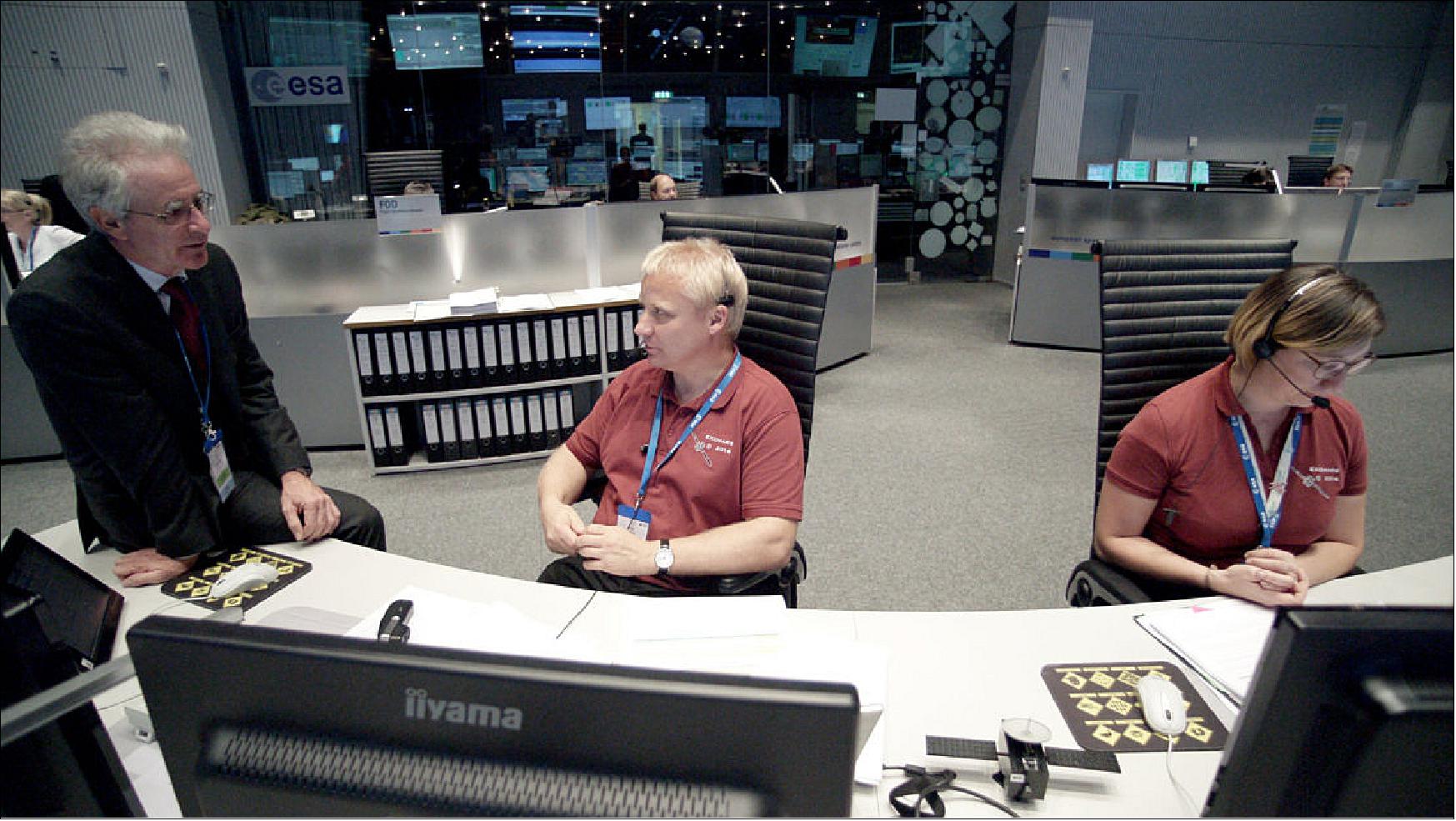
- Mission controllers are now working intensively to prepare the craft, the flight plan and ground systems for the campaign. First, on 19 January, they will adjust the angle of the orbit with respect to the Mars equator to 74º so that science observations can cover most of the planet.
- Next, to get into an orbit from where to start aerobraking, the high point will be reduced on 3 and 9 February 2017, leaving the craft in a 200 x 33,475 km orbit that it completes every 24 hours.
- ESA mission controllers have some previous experience with aerobraking using Venus Express, although that was done at the end of the mission as a demonstration. NASA also used aerobraking to take the Mars Reconnaissance Orbiter and other spacecraft into low orbits at Mars. “This will be our first time to use aerobraking to achieve an operational orbit, so we’re taking the extra time available now to ensure our plans are robust and cater for any contingencies,” says flight director Michel Denis.
- Beginning to slow down. Aerobraking proper will begin on 15 March, 2017 with a series of seven thruster firings, about one every three days, that will steadily lower the craft’s altitude at closest approach – from 200 km to about 114 km. “Then the atmosphere can start its work, pulling us down,” says Peter Schmitz. “If all goes as planned, very little fuel will then be needed until the end of aerobraking early in 2018, when final firings will circularize the 400 km orbit.”
- No date has been set, but science observations can begin once the final orbit is achieved. In addition, the path will provide two to three overflights of each rover every day to relay signals.
- Spacecraft status: Overall, the spacecraft is in excellent health. On 30 November, it received an updated ‘operating system’. To date, only one ‘safe mode’ has been triggered, when a glitch caused the craft to reboot and wait for corrective commands. That happened during preliminary testing of the main engine, when a faulty configuration was quickly identified and fixed. "We are delighted to be flying such an excellent spacecraft,” says Michel. “We have an exciting and challenging mission ahead of us.”
• December 6, 2016: The ExoMars TGO (Trace Gas Orbiter) has imaged the martian moon Phobos as part of a second set of test science measurements made since it arrived at the Red Planet on 19 October. 100)
- Example data from the first orbit were published last week, focusing on Mars itself. During the second orbit, the instruments made a number of measurements of Phobos, a 27 x 22 x 18 km moon that orbits Mars at a distance of only 6000 km.
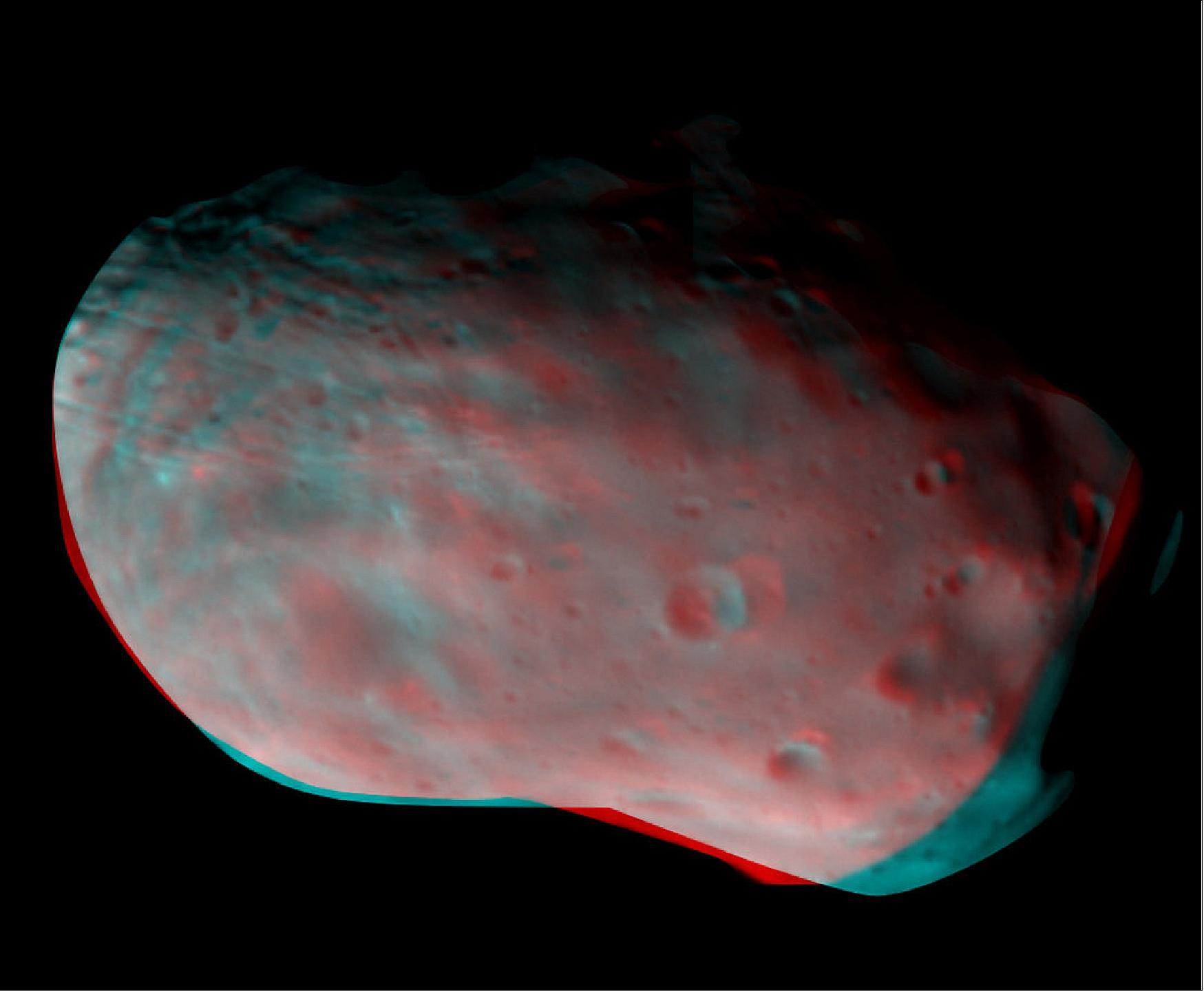
• November 29, 2016: Data from each of the two rovers active on Mars reached Earth last week in the successful first relay test of a NASA radio aboard Europe's new TGO (Trace Gas Orbiter). 101)
- The transmissions from NASA rovers Opportunity and Curiosity, received by one of the twin Electra radios on the orbiter on Nov. 22, mark a strengthening of the international telecommunications network supporting Mars exploration. The orbiter's main radio for communications with Earth subsequently relayed onward to Earth the data received by Electra.
- Frequent use of TGO's relay capability to support Mars rover operations is planned to begin more than a year from now. That's after the orbiter finishes adjusting its orbit to a near-circular path about400 km above Mars' surface. Meanwhile, four other active Mars orbiters also carry radios that can provide relay service for missions on the surface of Mars. The two active rovers routinely send data homeward via NASA orbiters Mars Odyssey and MRO (Mars Reconnaissance Orbiter).
- "The arrival of ESA's Trace Gas Orbiter at Mars, with its NASA-provided Electra relay payload on board, represents a significant step forward in our Mars relay capabilities," said Chad Edwards, manager of the Mars Relay Network Office within the Mars Exploration Program at NASA/JPL (Jet Propulsion Laboratory), Pasadena, California. "In concert with our three existing NASA orbiters and ESA's earlier Mars Express orbiter, we now have a truly international Mars relay network that will greatly increase the amount of data that future Mars landers and rovers can return from the surface of the Red Planet."
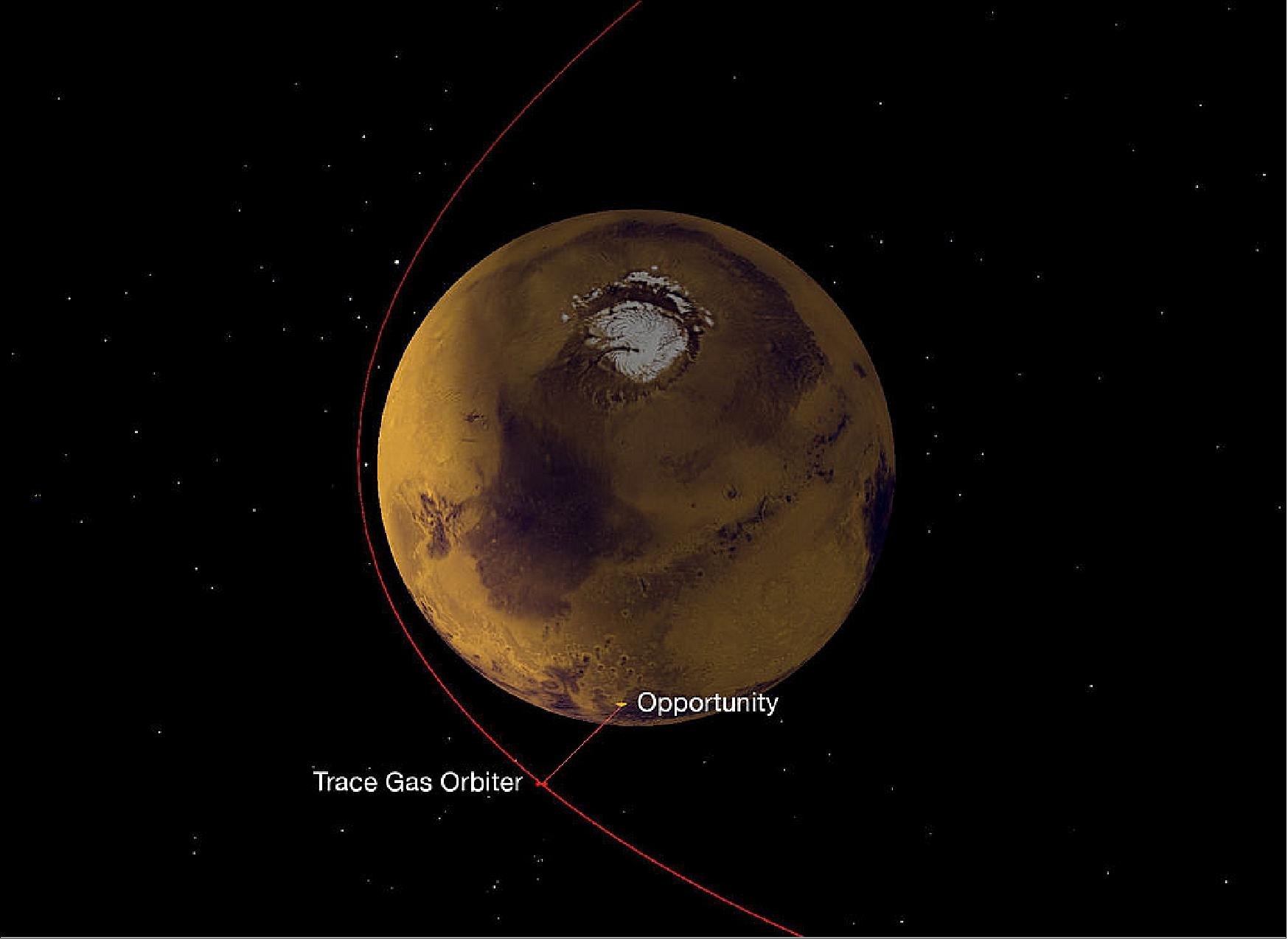
- NASA is on an ambitious journey to Mars that will include sending humans to the Red Planet. Current and future robotic spacecraft are leading the way and will prepare an infrastructure in advance for human missions.
- The JPL-designed Electra radios include special features for relaying data from a rover or stationary lander to an orbiter passing overhead. Relay of information from Mars-surface craft to Mars orbiters, then from the Mars orbiters to Earth, enables receiving much more data from the surface missions than would be possible with a direct-to-Earth radio link from the rovers or landers.
- "We already have almost 13 years' experience using ESA's Mars Express as an on-call backup for data relay from active Mars rovers, and TGO will greatly expand this to routine science-data relay," said Michel Denis, TGO flight director at ESA/ESOC ( European Space Operations Center), Darmstadt, Germany. "In 2020, TGO will extend this relay support to ESA's ExoMars rover and the Russian Surface Platform, an important capability together with its science mission that enhances the international data network at Mars."
- As an example of Electra capabilities, during a relay session between an Electra on the surface and one on an orbiter, the radios can maximize data volume by actively adjusting the data rate to be slower when the orbiter is near the horizon from the surface robot's perspective, faster when it is overhead (Ref. 101).
• November 29, 2016: ESA’s new ExoMars orbiter has tested its suite of instruments in orbit for the first time, hinting at a great potential for future observations. 103) 104)
- TGO (Trace Gas Orbiter), a joint endeavor between ESA and Roscosmos, arrived at Mars on 19 October. Its elliptical orbit takes it from 230–310 km above the surface to around 98 000 km every 4.2 days. It spent the last two orbits during 20–28 November testing its four science instruments for the first time since arrival, and making important calibration measurements.
- Data from the first orbit has been made available for this release to illustrate the range of observations to be expected once the craft arrives into its near-circular 400 km-altitude orbit late next year.
- TGO’s main goal is to make a detailed inventory of rare gases that make up less than 1% of the atmosphere’s volume, including methane, water vapor, nitrogen dioxide and acetylene. Of high interest is methane, which on Earth is produced primarily by biological activity, and to a smaller extent by geological processes such as some hydrothermal reactions.
![Figure 117: A 25 km-wide image strip over a structure called Arsia Chasmata, which lies on the flank of the large volcano Arsia Mons. The formation is volcanic in origin and many pit craters, possibly caused by subsidence, can be seen. The image was taken on 22 November 2016 and is one of the first acquired by the CaSSIS (Color and Stereo Surface Imaging System) onboard the ExoMars Trace Gas Orbiter. The image was taken as part of an eight-day campaign to test the science instruments for the first time since arriving at the Red Planet on 19 October [image credit: ESA/Roscosmos/ExoMars/CaSSIS/UniBE; mosaicking tool: AutoStitch (University of British Columbia)]](https://eoportal.org/ftp/satellite-missions/e/ExoMars_141122/ExoMars_Auto21.jpeg)
- The two instruments tasked with this role have now demonstrated they can take highly sensitive spectra of the atmosphere. During the test observations last week, the Atmospheric Chemistry Suite focused on carbon dioxide, which makes up a large volume of the planet's atmosphere, while the Nadir and Occultation for Mars Discovery instrument homed in on water.
- They also coordinated observations with ESA’s Mars Express and NASA’s Mars Reconnaissance Orbiter, as they will in the future.
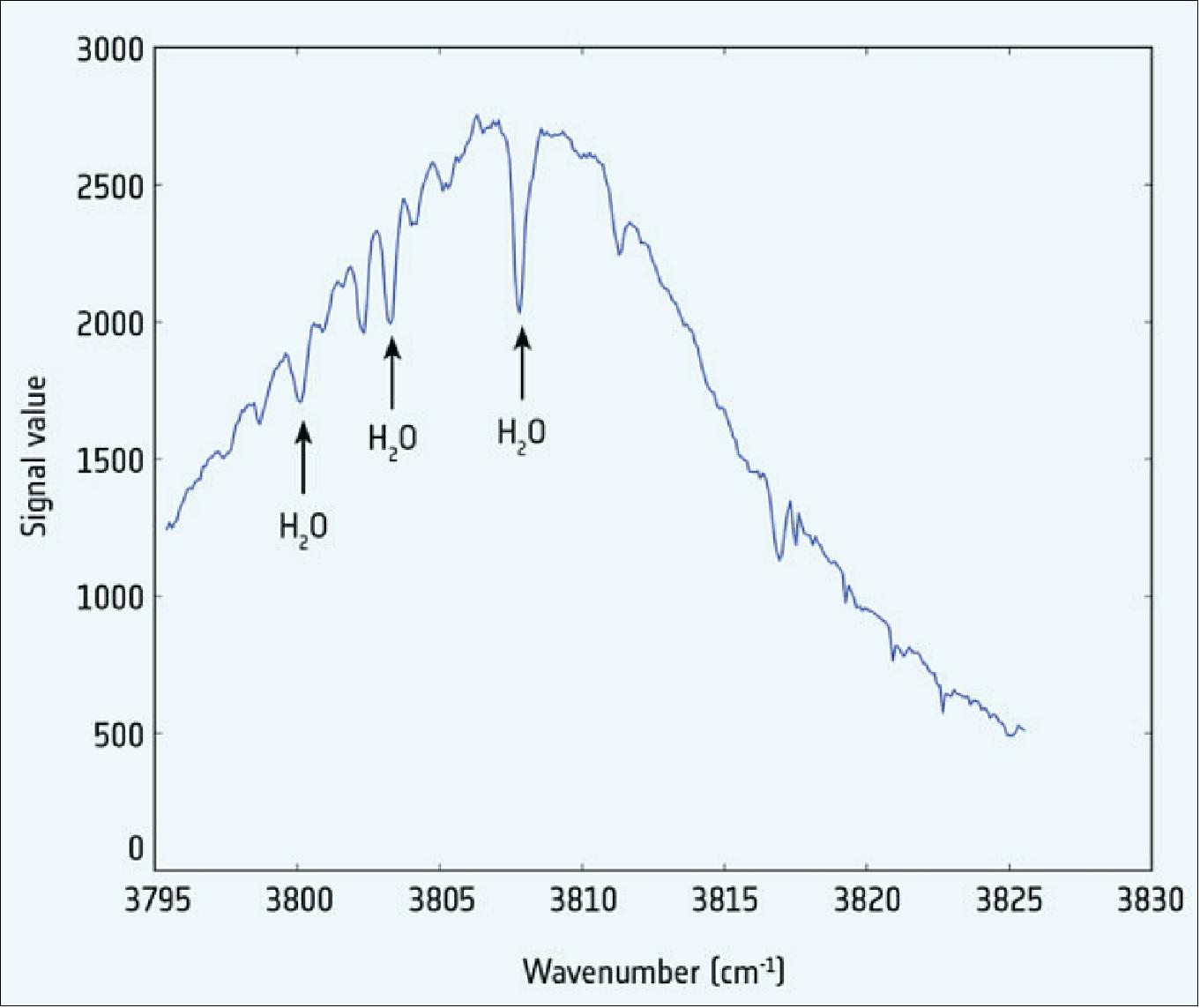
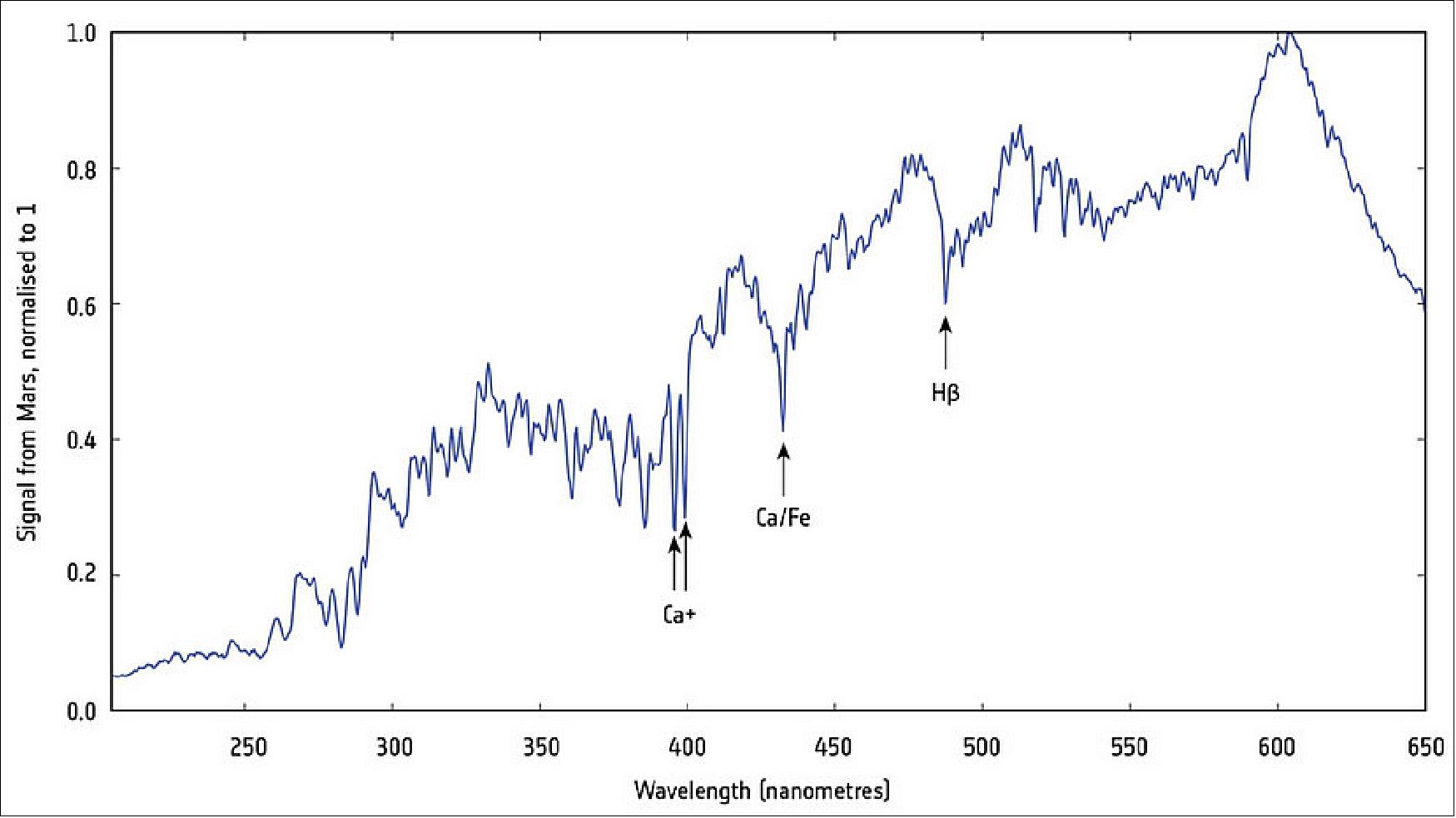
- Complementary measurements by the orbiter’s neutron detector, FREND (Fine Resolution Epithermal Neutron Detector), will measure the flow of neutrons from the planet’s surface. Created by the impact of cosmic rays, the way in which they are emitted and their speed on arriving at TGO points to the composition of the surface layer, in particular to water or ice just below the surface.
- The instrument has been active at various times during the cruise to Mars and on recent occasions while flying close to the surface could identify the relative difference between regions of known higher and lower neutron flux, although it will take several months to produce statistically significant results.
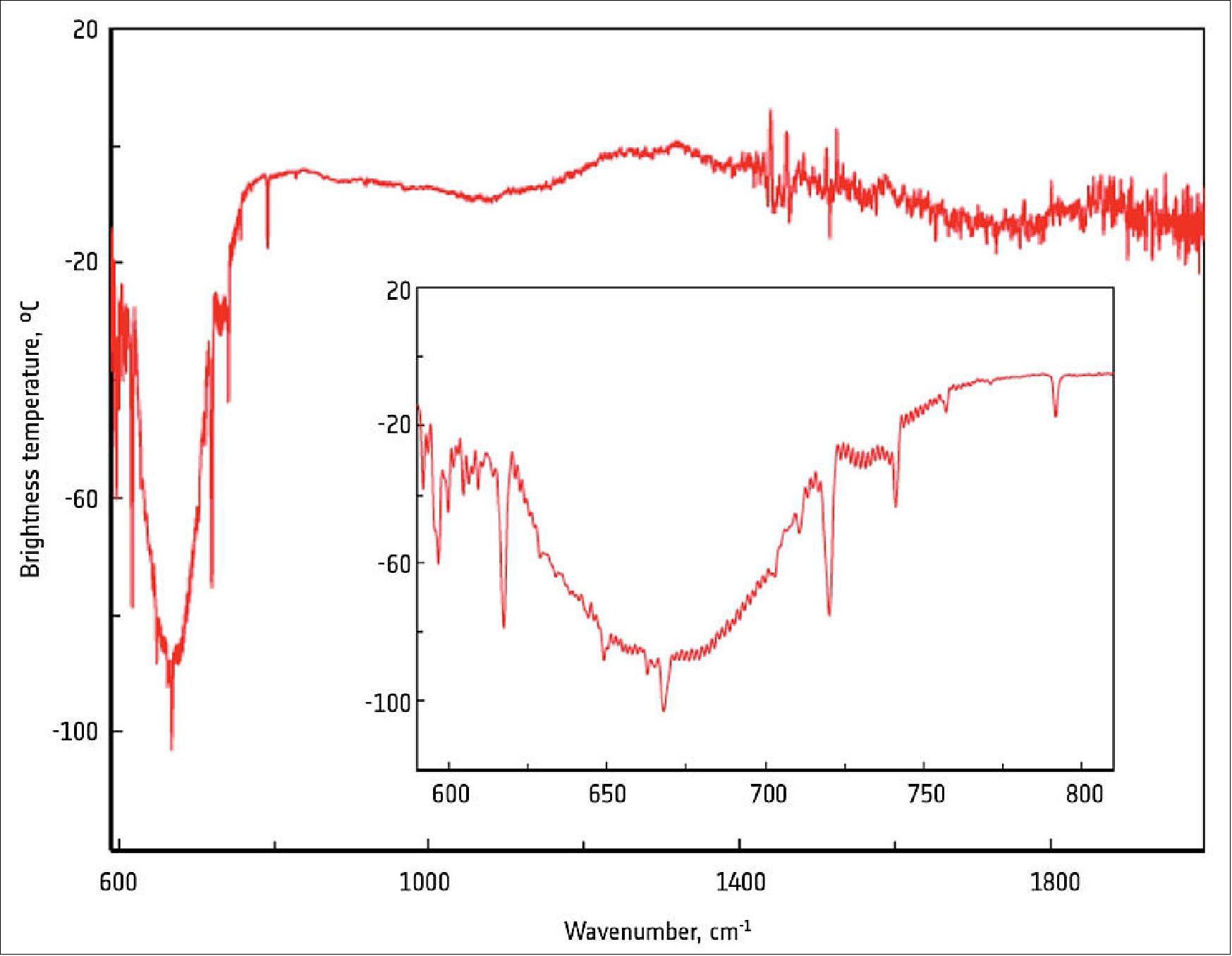
- The different capabilities of the CaSSIS (Color and Stereo Surface Imaging System) were also demonstrated, with 11 images captured during the first close flyby on 22 November. At closest approach the spacecraft was 235 km from the surface, and flying over the Hebes Chasma region, just north of the Valles Marineris canyon system. These are some of the closest images that will ever be taken of the planet by TGO, given that the spacecraft’s final orbit will be at around 400 km altitude.

- The camera team also completed a quick first test of producing a 3D reconstruction of a region in Noctis Labyrinthus, from a stereo pair of images. Although the images are impressively sharp, data collected during this test period will help to improve the camera’s onboard software as well as the quality of the images after processing.
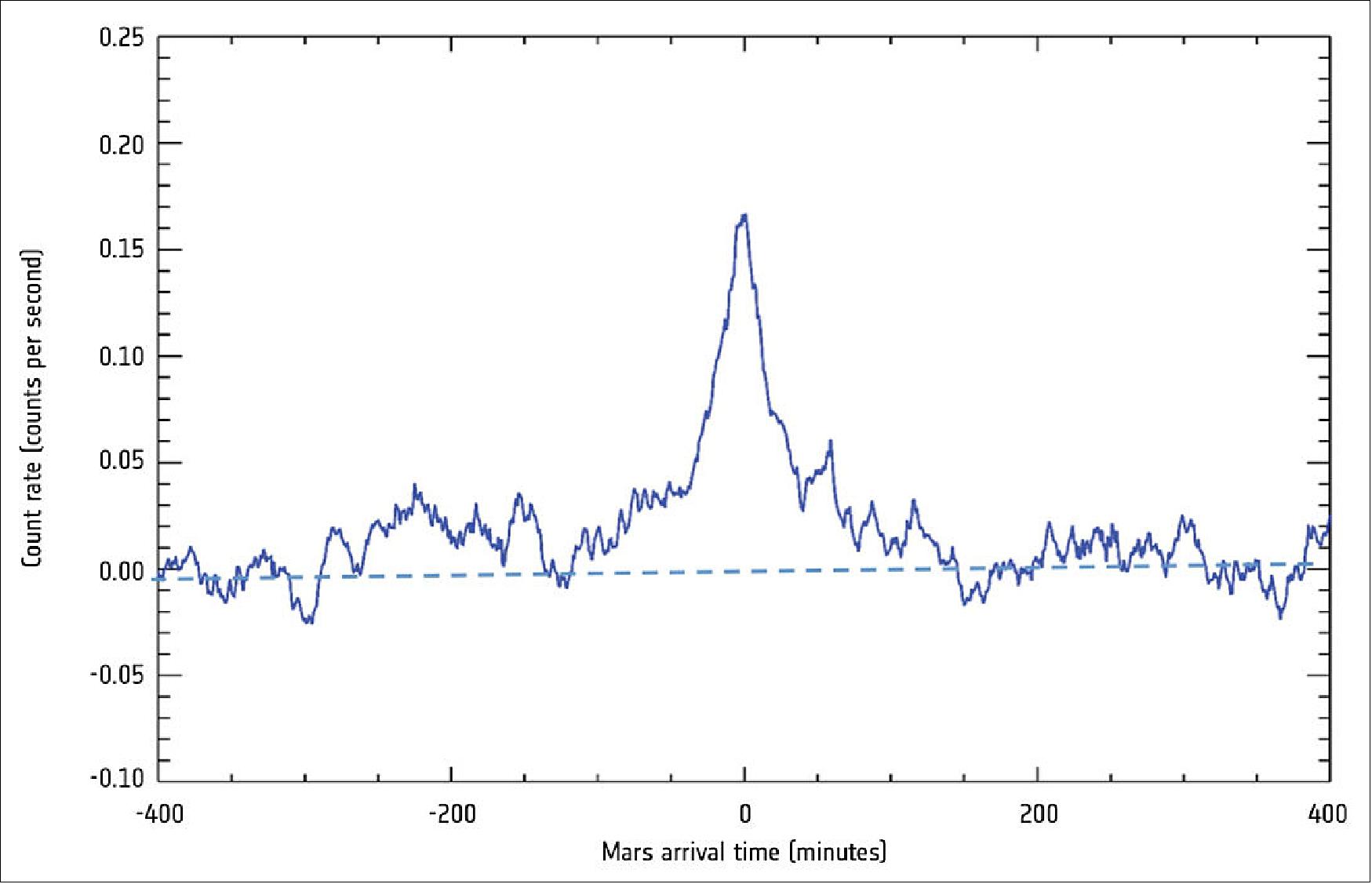
- “We are extremely happy and proud to see that all the instruments are working so well in the Mars environment, and this first impression gives a fantastic preview of what’s to come when we start collecting data for real at the end of next year,” says Håkan Svedhem, ESA’s TGO Project Scientist. “Not only is the spacecraft itself clearly performing well, but I am delighted to see the various teams working together so effectively in order to give us this impressive insight.
- “We have identified areas that can be fine-tuned well in advance of the main science mission, and we look forward to seeing what this amazing science orbiter will do in the future.”
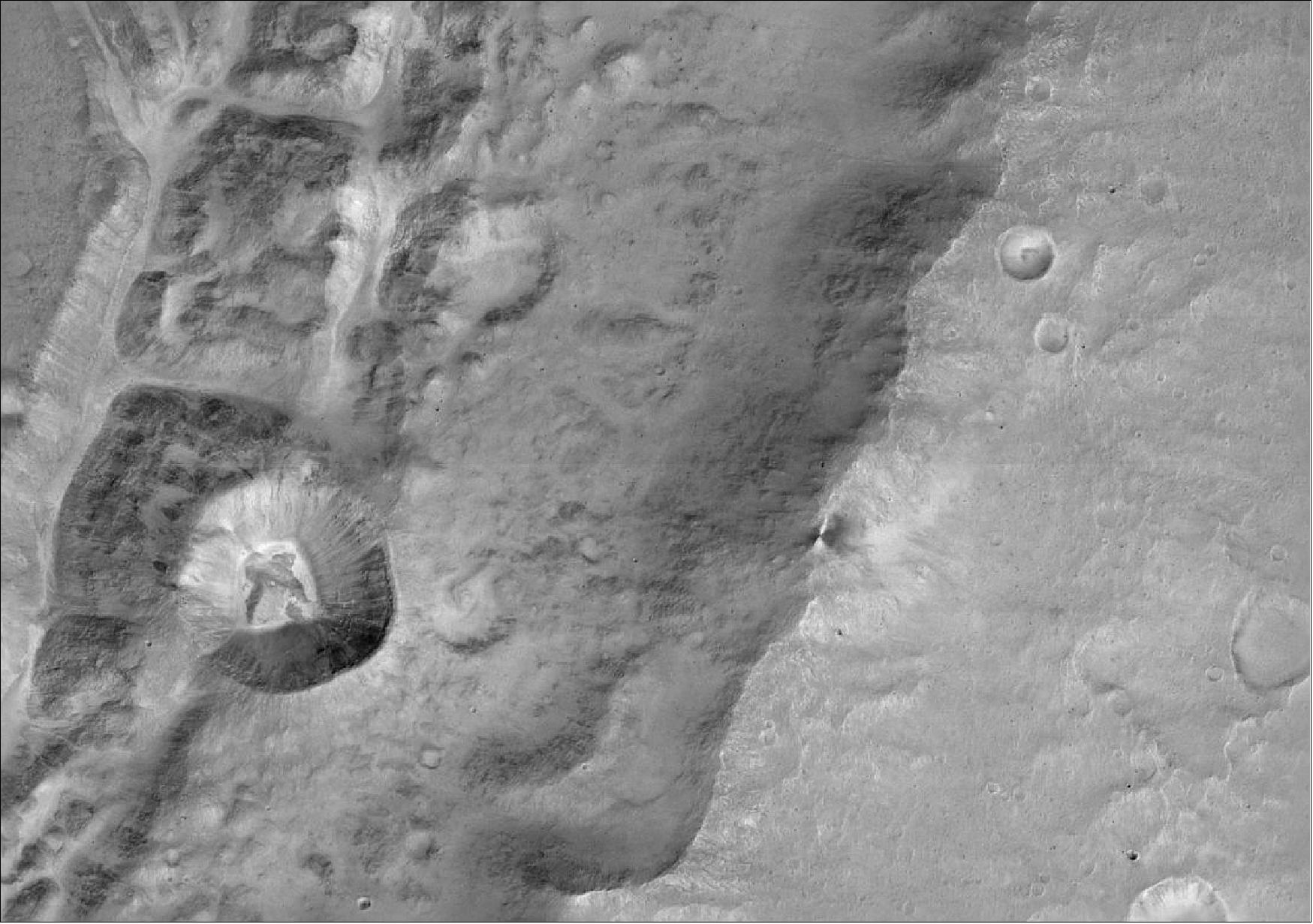
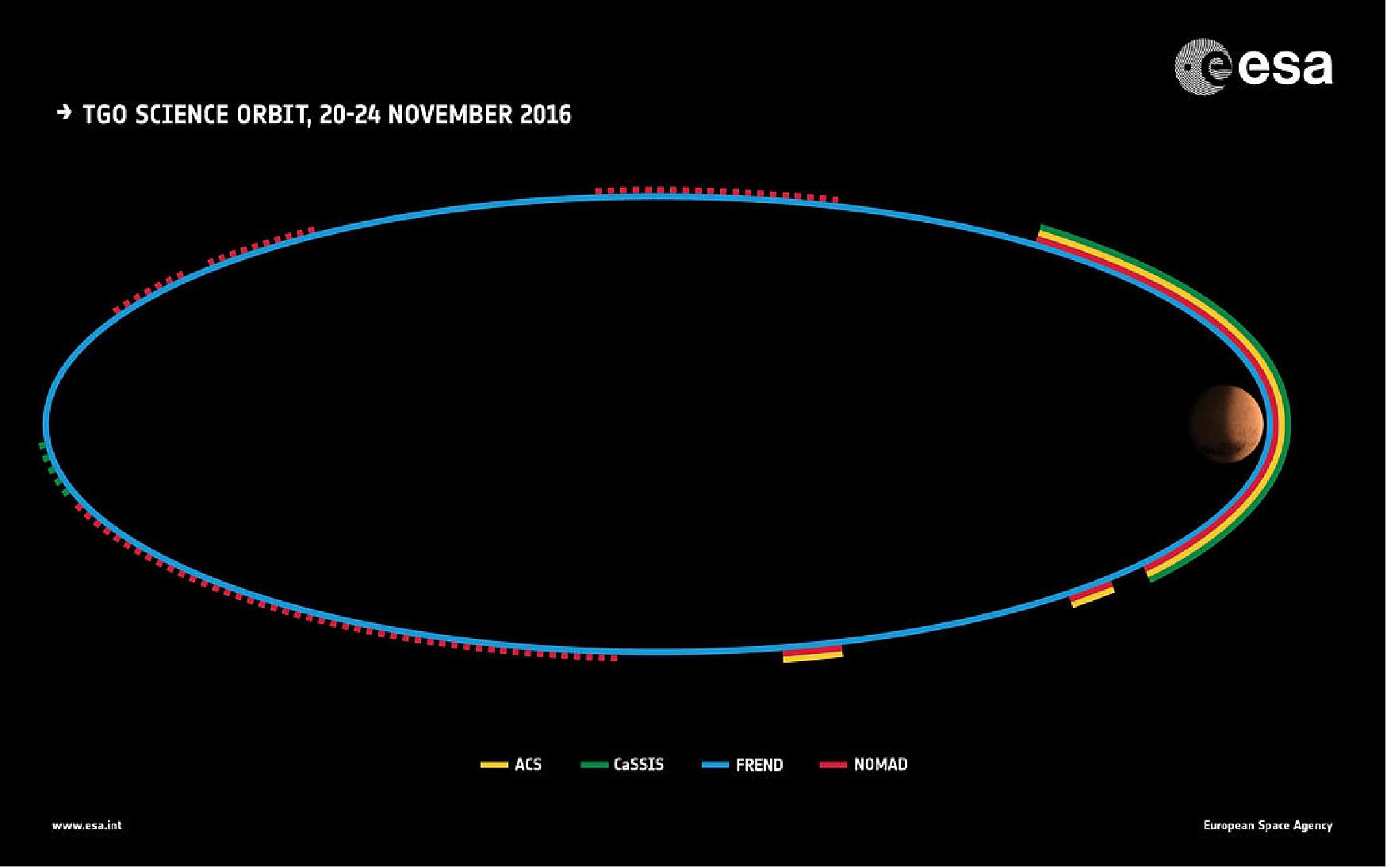
• November 18, 2016: The ExoMars orbiter is preparing to make its first scientific observations at Mars during two orbits of the planet starting next week. The TGO (Trace Gas Orbiter), a joint endeavor between ESA and Roscosmos, arrived at Mars on 19 October. It entered orbit, as planned, on a highly elliptical path that takes it from between 230 and 310 km above the surface to around 98,000 km every 4.2 days. 105)
- The main science mission will only begin once it reaches a near-circular orbit about 400 km above the planet’s surface after a year of ‘aerobraking’ – using the atmosphere to gradually brake and change its orbit. Full science operations are expected to begin by March 2018.
- But next week provides the science teams with a chance to calibrate their instruments and make the first test observations now the spacecraft is actually at Mars.
- In fact, the neutron detector has been on for much of TGO’s cruise to Mars and is currently collecting data to continue calibrating the background flux and checking that nothing changed after the Schiaparelli module detached from the spacecraft. - It will measure the flow of neutrons from the martian surface, created by the impact of cosmic rays. The way in which they are emitted and their speed on arriving at TGO will tell scientists about the composition of the surface layer. In particular, because even small quantities of hydrogen can cause a change in the neutron speed, the sensor will be able to seek out locations where ice or water may exist, within the planet’s top 1–2 m.
- The orbiter’s other three instruments have a number of test observations scheduled during 20–28 November.
- During the primary science mission two instrument suites will make complementary measurements to take a detailed inventory of the atmosphere, particularly those gases that are present only in trace amounts. Of high interest is methane, which on Earth is produced primarily by biological activity or geological processes such as some hydrothermal reactions.
- In the upcoming orbits there are only opportunities for pointing towards the horizon or directly at the surface. This will allow the science teams to check the pointing of their instrument to best prepare for future measurements. - There is the possibility that they might detect some natural nightside airglow – an emission of light in the upper atmosphere produced when atoms broken apart by the solar wind recombine to form molecules, releasing energy in the form of light.
- During the second orbit, the scientists have also planned observations of Phobos, the larger and innermost of the planet’s two moons.
- Finally, the camera will take its first test images at Mars next week. In each of the two orbits, it will first point at stars to calibrate itself for measuring the planet’s surface reflectance.
- CASSIS (Color and Stereo Surface Imaging System) is the high-resolution camera onboard the TGO. It is capable of acquiring color stereo images of surface features possibly associated with trace gas sources and sinks in order to better understand the range of processes that might be related to trace gas emission (see Figure 137).
• November 3, 2016: New high-resolution images taken by a NASA's MRO (Mars Reconnaissance Orbiter) on Nov. 1, show parts of the ExoMars Schiaparelli module and its landing site in color on the Red Planet. The main impact site is now captured in the central portion of the swath that is imaged by the high-resolution camera through three filters, enabling a color image to be constructed. In addition, the image of November 1 was taken looking slightly to the west, while the earlier image was looking to the east, providing a contrasting viewing geometry. 106)
- Indeed, the latest image set sheds new light on some of the details that could only be speculated from the first look on October 25. For example, a number of the bright white spots around the dark region interpreted as the impact site are confirmed as real objects – they are not likely to be imaging ‘noise’ – and therefore are most likely fragments of Schiaparelli.
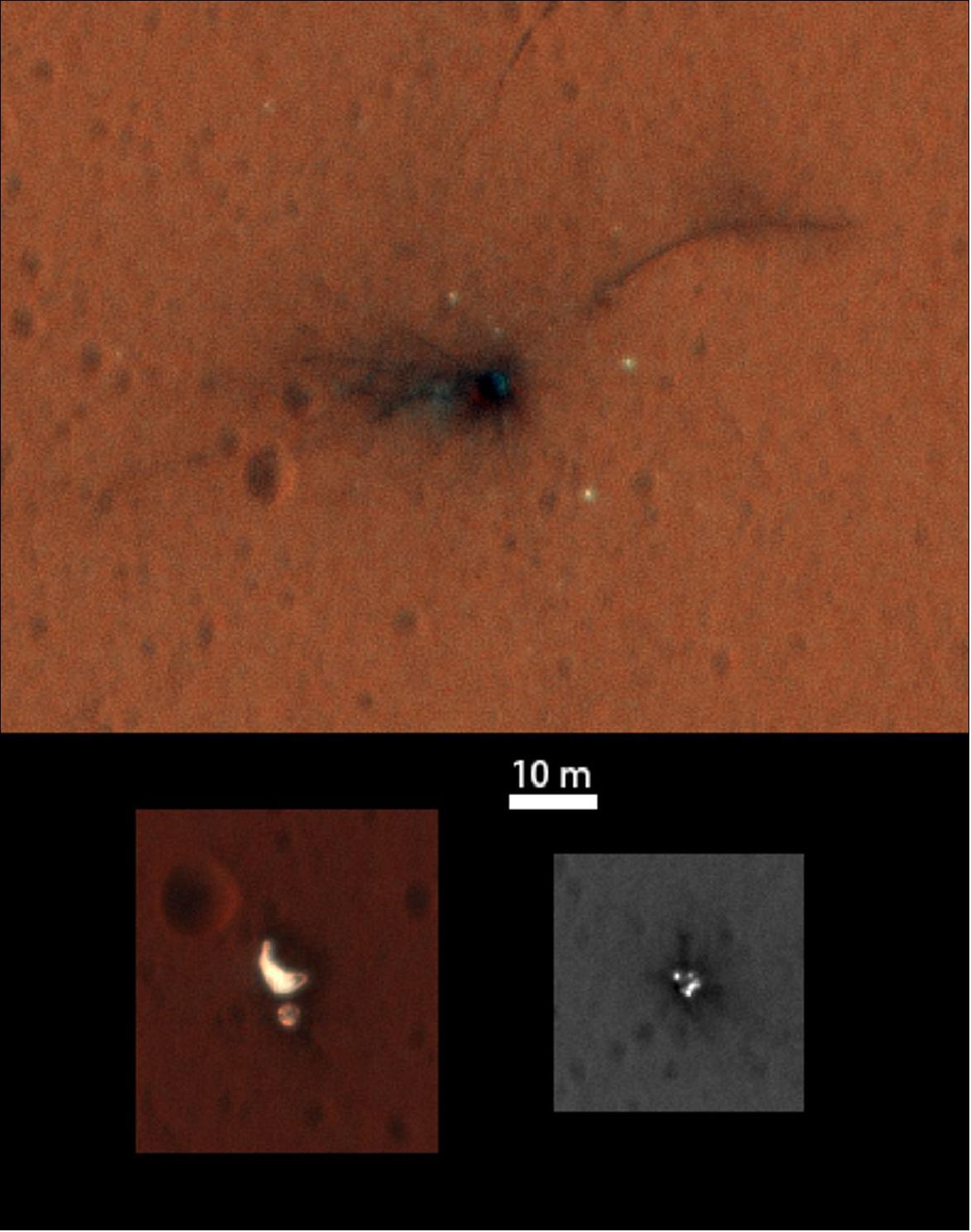
Legend to Figure 125: The colors have been graded according to the specific region to best reveal the contrast of features against the martian background. These images are in raw image geometry rather than map-projected, and north is about 7º west of straight up.
• October 27, 2016: Spacecraft operations manager Peter Schmitz gives the thumbs up in the main control room at ESA’s control center in Darmstadt, Germany, on 19 October 2016, shortly after the ExoMars TGO (Trace Gas Orbiter) arrived at the Red Planet. The spacecraft fired its main engine for 139 minutes to slow it down to be captured by Mars, entering an elliptical 101,000 x 3691 km orbit (with respect to the center of mass of the planet). It is in excellent health and will start making observations to calibrate its science instruments during two circuits in November 2016. 107)
• October 27, 2016: The most powerful telescope orbiting Mars is providing new details of the scene near the Martian equator where Europe's Schiaparelli test lander hit the surface last week. 108)
- The October 25, 2016, image (Figure 126) shows the area where the ESA's Schiaparelli test lander reached the surface of Mars, with magnified insets of three sites where components of the spacecraft hit the ground. It is the first view of the site from the HiRISE (High Resolution Imaging Science Experiment) camera on NASA's Mars Reconnaissance Orbiter taken after the Oct. 19, 2016, landing event. 109)
- This HiRISE observation adds information to what was learned from observation of the same area on Oct. 20 by the Mars Reconnaissance Orbiter's Context Camera (CTX). Of these two cameras, CTX covers more area and HiRISE shows more detail. A portion of the HiRISE field of view also provides color information. The impact scene was not within that portion for the Oct. 25 observation, but an observation with different pointing to add color and stereo information is planned.
- This Oct. 25 observation shows three locations where hardware reached the ground, all within about 1.5 km of each other, as expected. The annotated version includes insets with six-fold enlargement of each of those three areas. Brightness is adjusted separately for each inset to best show the details of that part of the scene. North is about 7 degrees counterclockwise from straight up. The scale bars are in meters.
- At lower left is the parachute, adjacent to the back shell, which was its attachment point on the spacecraft. The parachute is much brighter than the Martian surface in this region. The smaller circular feature just south of the bright parachute is about the same size and shape as the back shell (diameter of 2.4 m).
- At upper right are several bright features surrounded by dark radial impact patterns, located about where the heat shield was expected to impact. The bright spots may be part of the heat shield, such as insulation material, or gleaming reflections of the afternoon sunlight.
- According to the ExoMars project, which received data from the spacecraft during its descent through the atmosphere, the heat shield separated as planned, the parachute deployed as planned but was released (with back shell) prematurely, and the lander hit the ground at a velocity of more than than 300 km/hr.
- At mid-upper left are markings left by the lander's impact. The dark, approximately circular feature is about (2.4 m in diameter, about the size of a shallow crater expected from impact into dry soil of an object with the lander's mass — about 300 kg — and calculated velocity. The resulting crater is estimated to be about half a meter deep. This first HiRISE observation does not show topography indicating the presence of a crater. Stereo information from combining this observation with a future one may provide a way to check. Surrounding the dark spot are dark radial patterns expected from an impact event. The dark curving line to the northeast of the dark spot is unusual for a typical impact event and not yet explained. Surrounding the dark spot are several relatively bright pixels or clusters of pixels. They could be image noise or real features, perhaps fragments of the lander. A later image is expected to confirm whether these spots are image noise or actual surface features.
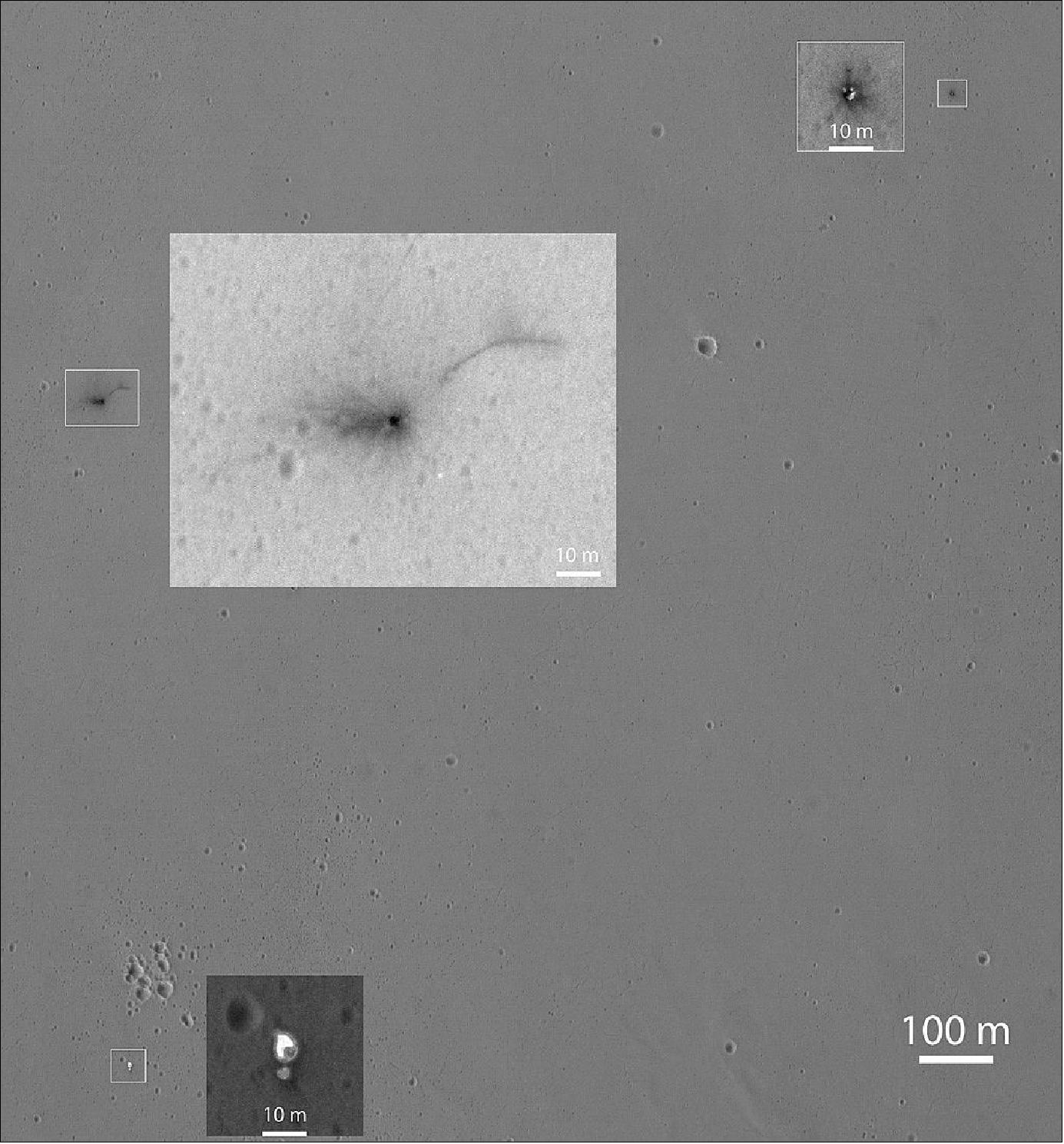
• October 25, 2016: Photos of a huge circle of churned-up Martian soil leave few doubts: theESA probe Schiaparelli that was supposed to test landing technology on Mars crashed into the red planet instead, and may have exploded on impact. 110)
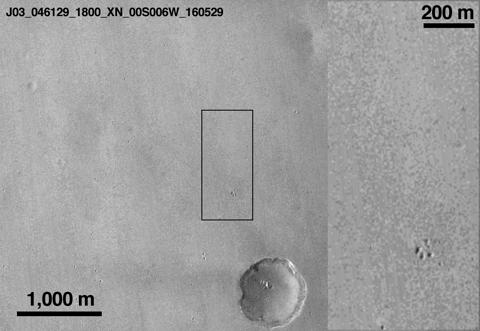
- The events of 19 October may be painful for ESA scientists to recall, but they will now have to relive them over and over again in computer simulations. The lander, called Schiaparelli, was part of ESA's ExoMars mission, which is being conducted jointly with the Russian Space Agency Roscosmos. It was a prelude to a planned 2020 mission, when researchers aim to land a much larger scientific station and rover on Mars, which will drill up to 2-meters down to look for signs of ancient life in the planet’s soil. Figuring out Schiaparelli’s faults and rectifying them is a priority, says Jorge Vago, project scientist for ExoMars. “That’s super important. I think it’s on everybody’s mind.”
- Schiaparelli sent data to its mother ship during its descent. Preliminary analysis suggests that the lander began the maneuver flawlessly, braking against the planet’s atmosphere and deploying its parachute. But at 4 minutes and 41 seconds into an almost 6-minute fall, something went wrong. The lander’s heat shield and parachute ejected ahead of time, says Vago. Then thrusters, designed to decelerate the craft for 30 seconds until it was meters off the ground, engaged for only around 3 seconds before they were commanded to switch off, because the lander's computer thought it was on the ground.
- The lander even switched on its suite of instruments, ready to record Mars’s weather and electrical field, although they did not collect data. “My guess is that at that point we were still too high. And the most likely scenario is that, from then, we just dropped to the surface,” says Vago.
- The craft probably fell from a height of between 2 and 4 km before slamming into the ground at more than 300 km/hr, according to estimates based on images of Schiaparelli's likely crash site, taken by NASA’s Mars Reconnaissance Orbiter on 20 October.
- The most likely culprit is a flaw in the craft’s software or a problem in merging the data coming from different sensors, which may have led the craft to believe it was lower in altitude than it really was, says Andrea Accomazzo, ESA’s head of solar and planetary missions. Accomazzo says that this is a hunch; he is reluctant to diagnose the fault before a full post-mortem has been carried out. But if he is right, that is both bad and good news.
- European-designed computing, software and sensors are among the elements of the lander that are to be reused on the ExoMars 2020 landing system, which, unlike Schiaparelli, will involve a mixture of European and Russian technology. But software glitches should be easier to fix than a fundamental problem with the landing hardware, which ESA scientists say seems to have passed its test with flying colors. “If we have a serious technological issue, then it’s different, then we have to re-evaluate carefully. But I don’t expect it to be the case,” says Accomazzo.
- The ExoMars team will try to replicate the mistake using a virtual landing system designed to simulate the lander’s hardware and software, says Vago, to make sure that scientists understand and can deal with the issue before redesigning any aspects of ExoMars 2020.
- ESA is keen to stress that overall, the ExoMars mission can be seen as a triumph: Schiaparelli sent back test data from the majority of its descent, and its sister craft — the Trace Gas Orbiter — successfully maneuvered into Martian orbit. The orbiter is the more scientifically valuable of the two halves of the mission: from December 2017, it will study Mars’s atmosphere, aiming to find evidence for possible biological or geological sources of methane gas. It will also be a communications relay for the 2020 rover.
• October 24, 2016: Scientists and engineers on the ExoMars project had their hearts in their mouths as the ExoMars mission reached the red planet, with the Schiaparelli probe going missing in action at the end of its descent just as the TGO mothership swept into a perfectly timed orbit. 112)
- The plight of Schiaparelli remains unclear. It is certainly on the Martian surface, but may well have hit the red dust much harder then engineers had planned, and nothing has been heard from it since. Data relayed during the lander's descent shows the initial high-speed entry to the Martian atmosphere went well, with the heatshield slowing the craft and the parachute deploying. However once the back heat shield and parachute were ejected the flow of events did not go to plan.
• October 20, 2016: The TGO of ESA's ExoMars 2016 mission has successfully performed the long, 139-minute burn required for Mars capture and has entered an elliptical orbit around the Red Plane; however, contact has not yet been confirmed with the mission's test lander Schiaparelli from the surface of the planet. 113)
- TGO's Mars orbit Insertion burn lasted from 13:05 to 15:24 UTC on October 19th, reducing the spacecraft's speed and direction by more than 1.5 km/s. The TGO is now on the planned orbit around Mars. European Space Agency teams at ESOC (European Space Operations Center) in Darmstadt, Germany, continue to monitor the good health of their second orbiter around Mars, which joins the 13-year old Mars Express.
- The ESOC teams are trying to confirm contact with the Entry, Descent & Landing Demonstrator Module (EDM), Schiaparelli, which entered the Martian atmosphere some 107 minutes after the TGO's maneuver for orbit insertion. Schiaparelli was programmed to autonomously perform an automated landing sequence, with parachute deployment and front heat shield release between 11 and 7 km, followed by a retrorocket braking starting at 1100 meters from the ground and a final fall from a height of 2 meters protected by a crushable structure.
• October 12, 2016: As the ExoMars Schiaparelli module descends onto Mars on 19 October it will capture 15 images of the approaching surface. Scientists have simulated the view we can expect to see from the descent camera. - Schiaparelli will separate from its mothership, the TGO (Trace Gas Orbiter), on 16 October, with some six million km still to travel before entering the atmosphere of Mars at 14:42 GMT three days later. Its descent will take just under six minutes, using a heatshield, parachute, thrusters and a crushable structure for the landing. 114)
- Schiaparelli is primarily a technology demonstrator to test entry, descent and landing technologies for future missions and is therefore designed to operate for only Schiaparelli is primarily a technology demonstrator to test entry, descent and landing technologies for future missions and is therefore designed to operate only for a few days.
- The small surface science package will take readings of the atmosphere, but there is no scientific camera like those found on other landers or rovers – including the ExoMars rover that is planned for launch in 2020. - The lander does, however, carry ESA’s small, 0.6 kg technical camera, a refurbished spare flight model of the Visual Monitoring Camera flown on ESA’s Herschel/Planck spacecraft to image the separation of the two craft after their joint launch.
• July28, 2016: Following a lengthy firing of its powerful engine this morning, ESA's ExoMars TGO (Trace Gas Orbiter )is on track to arrive at the Red Planet in October. ExoMars made its first critical maneuver since its 14 March launch this morning, firing its engine for 52 minutes to help it intercept Mars on 19 October, 2016. 115)
- The deep-space firing began automatically at 09:30 GMT, after commands to orient itself and ignite the 424 N main engine were uploaded on July 26. The maneuver was closely monitored by ESA's mission control in Darmstadt, Germany, who followed the craft's signals via the highly sensitive radio dish at New Norcia, Australia. The firing was planned well in advance, and its duration was carefully calculated to minimize fuel consumption for the overall set of cruise and Mars capture maneuvers. These include a second burn on 11 August and smaller 'trim' maneuvers on 19 September and 14 October.
- Teams have been using the relatively quiet cruise phase to test spacecraft systems, including the Schiaparelli lander and the radio unit that will be used to relay data from rovers on Mars, and to check TGO's four science instruments.
- Over the following months, TGO will shave the outer reaches of the atmosphere to lower its orbit. Its final circular orbit at about 400 km altitude will allow it to begin its five-year scientific mission in December 2017.
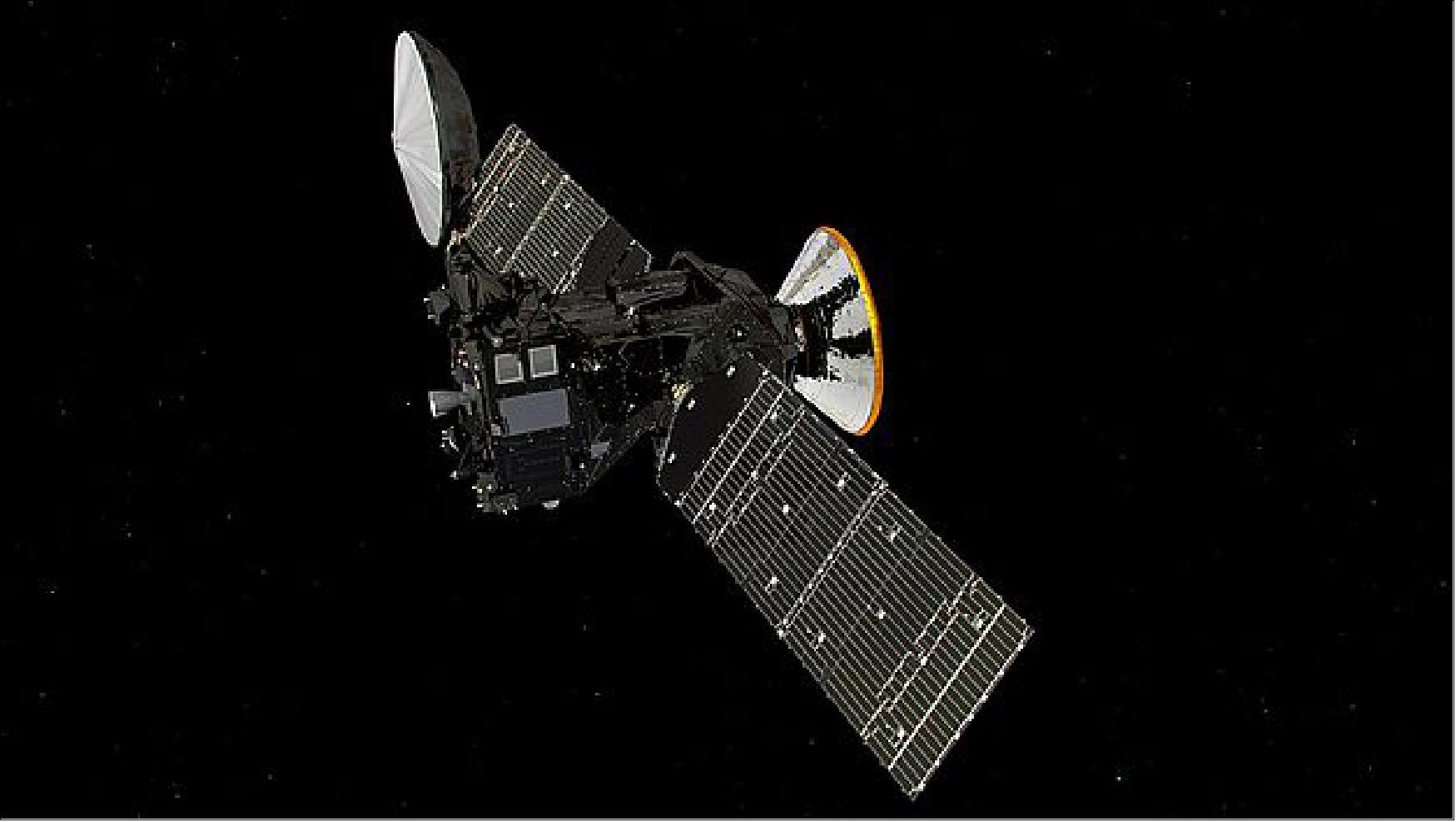
• June 22, 2016: With just over half of the journey to Mars completed, the Schiaparelli entry, descent and landing module has carried out its mid-cruise checkout. DREAMS and DECA have called home to report that they are in good health. The Schiaparelli module, launched with the ExoMars Trace Gas Orbiter on 14 March, is a demonstrator to test key technologies in preparation for ESA’s contributions to subsequent missions to Mars. 116)
- During the mid-cruise checkout of DREAMS that was run on 16 and 17 June, the sensors measured the environmental conditions inside the ExoMars entry descent and landing module, both in the warm compartment where the electronics are housed and in the central area of the module where the sensors are situated.
- The measurements are all perfectly in line with what is expected, according to DREAMS Principal Investigator, Francesca Esposito, from INAF - Osservatorio Astronomico di Capodimonte, Naples, Italy. "During this check-out we have looked at how the DREAMS sensors are responding inside the module as well as making some science measurements," she explains. "These tests are used to monitor the health of the sensors and to compare their behavior in space with that in the laboratory. We also use these tests to set the zero point for some of our sensors – this is important for when we are operating on Mars because we need to be sure that our sensors are all well calibrated."
- The small descent camera, DECA, was also tested during this mid-cruise checkout. DECA, which is the flight spare of the Herschel visual monitoring camera, will take 15 images at 1.5 s intervals shortly after the front shield of Schiaparelli has been jettisoned, from an altitude of a few kilometers.
- During these recent tests DE CA cycled through its image acquisition sequence to obtain 15 pictures of the dark interior of the module. These are used to check the health of the camera and to calibrate it. "DECA operates autonomously while taking the 15 images during descent," explains Detlef Koschny, Team Leader of DECA, from ESA's Scientific Support Office at ESTEC . "These checkout tests are very important as they allow us to monitor the status of the camera during flight and to calibrate it so that we can make the most of the 15 images that we will get."
- In addition to DREAMS and DECA, Schiaparelli carries the COMARS+ package to characterize the heat shield response during descent; supports an investigation into atmospheric studies with AMELIA, using engineering sensors; and carries a retroreflector, called INRRI.
• June 16, 2016: ExoMars captured its first images of Mars this week as part of its preparations for arriving at the Red Planet in October. The ExoMars TGO (Trace Gas Orbiter) acquired its first image of Mars on 13 June 2016 as part of its extensive instrument commissioning en route to the Red Planet. The line-of-sight distance to Mars on 13 June was 41 million km, giving an image resolution of 460 km/pixel. The planet is roughly 34 arcseconds in diameter at this distance. The Tharsis region of Mars, home to the planet’s largest volcanoes, faces the spacecraft in this view. 117)
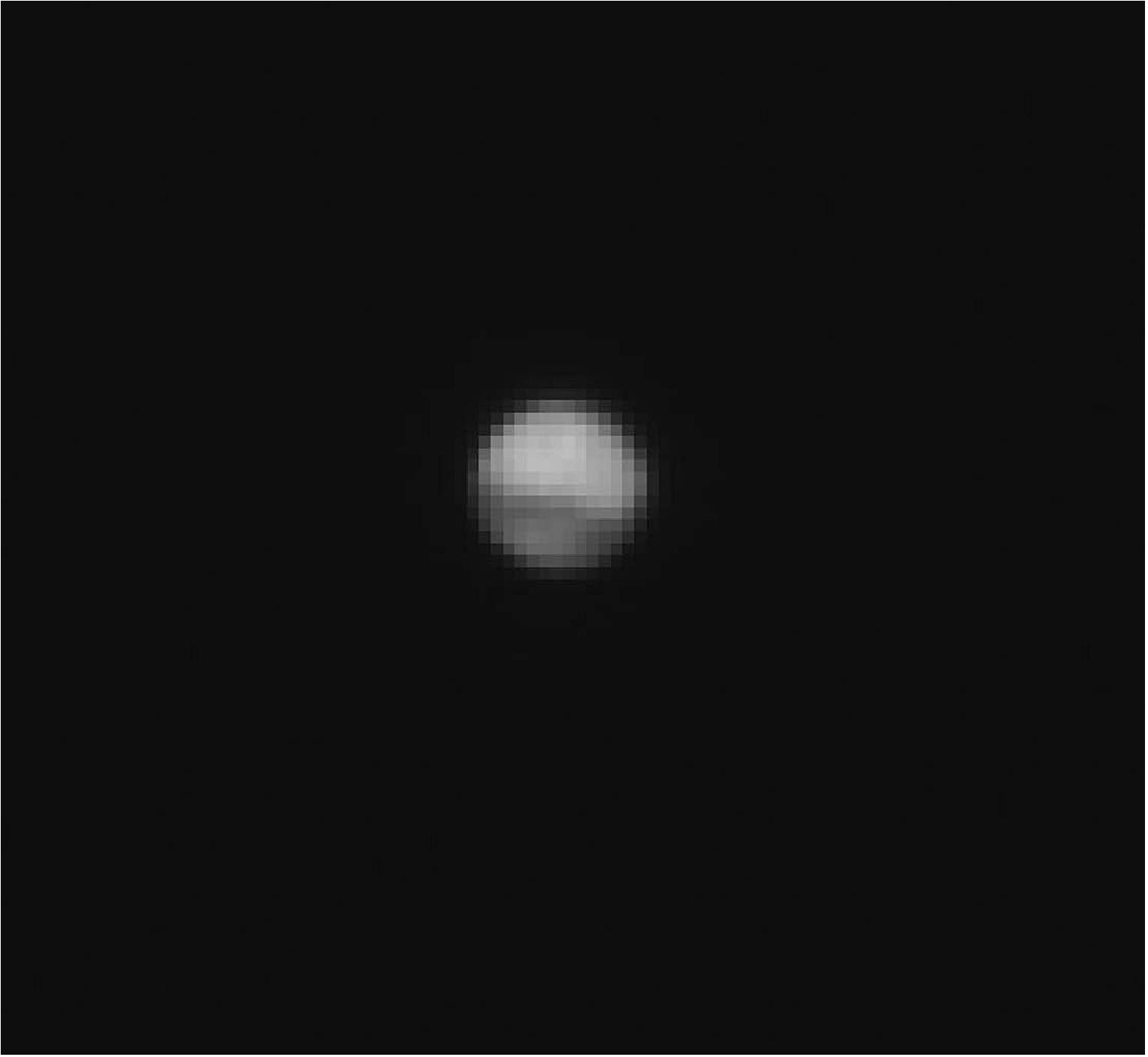
• May 23, 2016: The ExoMars spacecraft, built by TAS-I (Thales Alenia Space-Italy) as prime contractor for ESA (European Space Agency ) has successfully completed its IOCR (In-Orbit Commissioning Review). 118)
- TAS has analyzed the results of the LEOP (Launch and Early Orbit Phase) and commissioning operations to draw up a report submitted to ESA. The report confirms the full functionality of the spacecraft’s two constituent modules: EDM (Entry and Descent Module) and TGO (Trace Gas Orbiter). Tests on the TGO during the LEOP phase confirmed that the satellite’s temperatures are within operational limits; the propulsion subsystem (Reaction Control System RCS) is operating as expected and energy consumption is nominal. The electrical parameters (voltage and current) remain stable in relation to the results of tests on Earth.
• April 14, 2016: The ESA–Roscosmos ExoMars spacecraft TGO and Schiaparelli are in excellent health following launch last month, with the orbiter sending back its first test image of a starry view taken en route to the Red Planet. In the weeks following liftoff on 14 March, mission operators and scientists have been intensively checking the TGO (Trace Gas Orbiter) and the Schiaparelli entry, descent, and landing demonstrator to ensure they will be ready for Mars in October. 119)
- TGO’s control, navigation and communication systems have been set up, the 2.2 m diameter high-gain dish is already providing a 2 Mbit/s link with Earth, and the science instruments have undergone initial checks.
- Once orbiting Mars, TGO will embark on a mission to measure the abundance and distribution of rare gases in the atmosphere with its sophisticated sensors. Of particular interest is methane, which could point to active geological or biological processes on the planet.
- “All systems have been activated and checked out, including power, communications, startrackers, guidance and navigation, all payloads and Schiaparelli, while the flight control team have become more comfortable operating this new and sophisticated spacecraft,” says Peter Schmitz, ESA’s Spacecraft Operations Manager.
- On 7 April, TGO’s high-resolution camera was switched on for the first time, acquiring its first images of space.
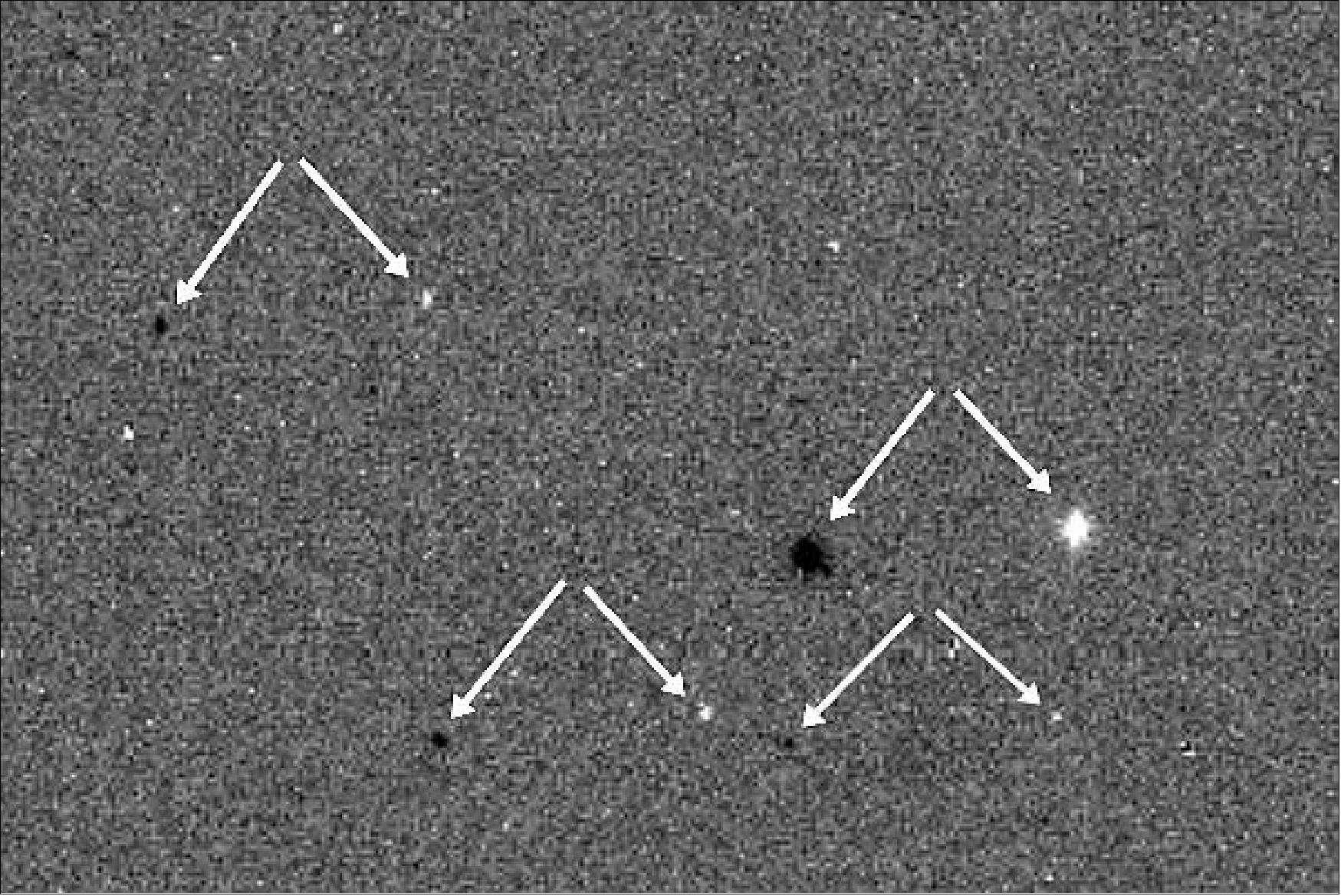
Legend to Figure 130: The picture shows the result of taking one CaSSIS frame, turning the camera’s rotation mechanism, and then taking another. By subtracting the two frames, a series of bright and dark spots are seen, all equally offset from each other, demonstrating that these are positive and negative images of the same stars. The FOV (Field of View) is 0.2º in the horizontal direction, and is a subset of a larger image, extracted for this purpose to show the stars at a reasonable size. The arrows indicate the offset star positions. 120)
In operation at Mars, about 400 km above the planet, CaSSIS will sweep out a swath as TGO approaches it, then turn the rotation mechanism by 180º and image the same swath as it recedes. By doing so, CaSSIS will make stereo images of the surface.
• March 23, 2016: After the critical first few days in space, TGO is performing flawlessly. Over the next two weeks the ExoMars team will continue to check and commission its systems, including the power, communications, star trackers, and the guidance and navigation system. Schiaparelli, which is hitching a ride to Mars with TGO, will also be thoroughly checked in the coming weeks. 121)
- On March 17, the mission control team had declared the LEOP (Launch and Early Orbit Phase) complete.
- In June, the science control center at ESAC (European Space Astronomy Center) near Madrid, Spain, will start working with the instrument teams at their various institutes, and the Roscosmos science operations center, to perform a mid-cruise checkout of TGO’s instruments.
•Some 12 hours after launch, and after a very precise orbital delivery from the Russian Proton–Breeze rocket, ground stations in Africa, Spain and Australia began receiving the spacecraft’s initial signals, confirming that TGO was alive and well, and had started its automatic sequence, switching itself on, orienting its antenna towards Earth and deploying the solar wings.
• The Breeze-M upper stage, with ExoMars attached, then completed a series of four burns before the spacecraft was released at 20:13 GMT.
• Following separation of Proton’s first and second stages, the payload fairing was released. The third stage separated nearly 10 minutes after liftoff.
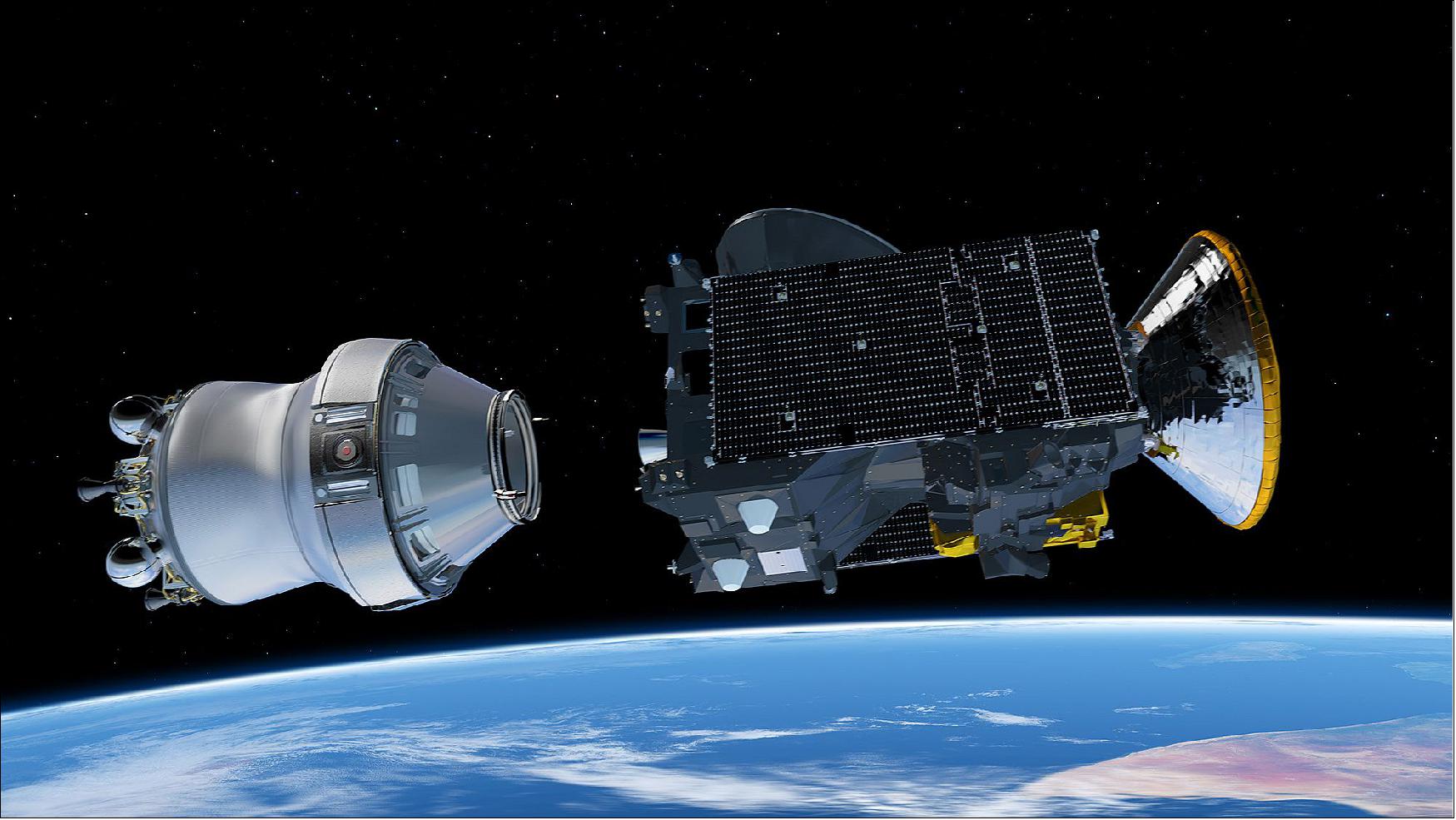
Launch | 14 March 2016 |
Schiaparelli – Trace Gas Orbiter separation | 16 October 2016 |
Trace Gas Orbiter insertion into Mars orbit | 19 October 2016 |
Schiaparelli enters Martian atmosphere and lands on the target site | 19 October 2016 |
Schiaparelli science operations begin | 19 October 2016 |
TGO (Trace Gas Orbiter) changes inclination to science orbit (74°) | December 2016 |
Apocenter reduction maneuvers (from the initial 4-sol orbit to a 1-sol orbit) | December 2016 |
Aerobraking phase (Trace Gas Orbiter lowers its altitude to 400 km circular orbit) | January 2017 - November 2017 |
TGO science operations begin. (In parallel, TGO will start data relay operations to support NASA landers on Mars.) | December 2017 |
Superior solar conjunction (critical operations are paused while the Sun is between Earth and Mars) | 11 July - 11 August 2017 |
Start of the TGO data relay operations to support communications for the rover mission and for the surface science platform | 15 January 2019 |
End of Trace Gas Orbiter mission | December 2022 |
Sensor Complement (TGO)
With a science payload of four instruments , the TGO will investigate trace gases – those gases that are present in small concentrations in the atmosphere, making up less than 1 per cent of it. There will be particular focus on hydrocarbons and sulphur species, some of which could be signatures of active biological or geological processes, at present or in the past.
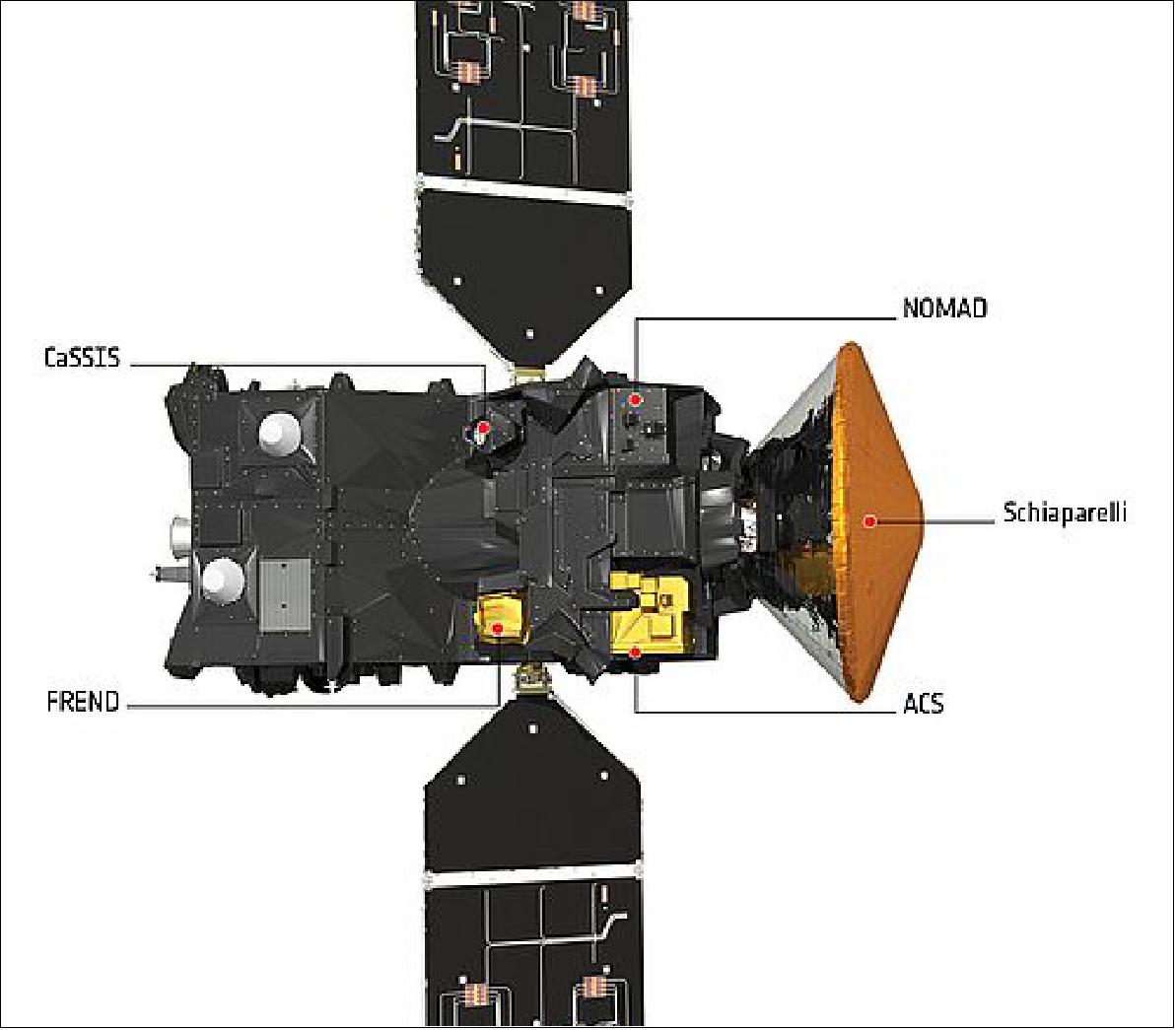
ACS (Atmospheric Chemistry Suite)
ACS is a suite of three infrared spectrometers to investigate the chemistry, aerosols, and structure of the atmosphere. The package is part of the Russian contribution to the ExoMars ESA-Roscosmos mission. ACS will complement NOMAD by extending the coverage at infrared wavelengths. PI (Principal Investigator): Oleg Korablev, Space Research Institute (IKI), Moscow, Russia. Next to IKI, the following institutions are collaborating on ACS: Moscow Institute of Physics and Technology;Main Astronomical Observatory, Kyiv, Ukraine; and the National Research Institute for Physical-technical and Radiotechnical Measurements (VNIIFTRI), Moscow Region. 123) 124) 125) 126) 127)
ACS is the set of three spectrometers (NIR, MIR, TIRVIM), covering in total range of 0.7-17 µm developed by IKI. Its design capitalizes on the previous developments of high-technology readiness: two instruments built for the unsuccessful Phobos-Grunt project and one instrument flown on the ISS (International Space Station) in the timeframe 2009–2012.12. Some components/subsystems were contributed by the DLR German Aerospace Center) Institut für Planetenforschung and by LATMOS (CNRS) in France.
The three ACS spectrometers share common mechanical, thermal, and electrical interfaces. The ACS architecture and its concept design are shown in Figure 133. ACS has several optical openings allowing observations in nadir (-Y in the spacecraft coordinate system), and in solar occultation, at 67º from -Y to -X in the XY plane, and possibly on the limb (using nadir apertures). The accuracy of spacecraft attitude control is ±1 mrad. The main opening of NIR is pointed to the nadir direction (-Y). The auxiliary solar port of NIR and the only opening of MIR (Mid-Infrared) are pointed to the sun. The thermal infrared channel (TIRVIM) is equipped with a one-dimensional (1D) scanner/positioner rotating its FOV (Field of View) in the XY plane from +X to almost -X. It allows us to observe nadir, internal blackbodies, and the open space, which are necessary for absolute calibration of TIRVIM in the IR. TIRVIM has also a separate solar occultation port.
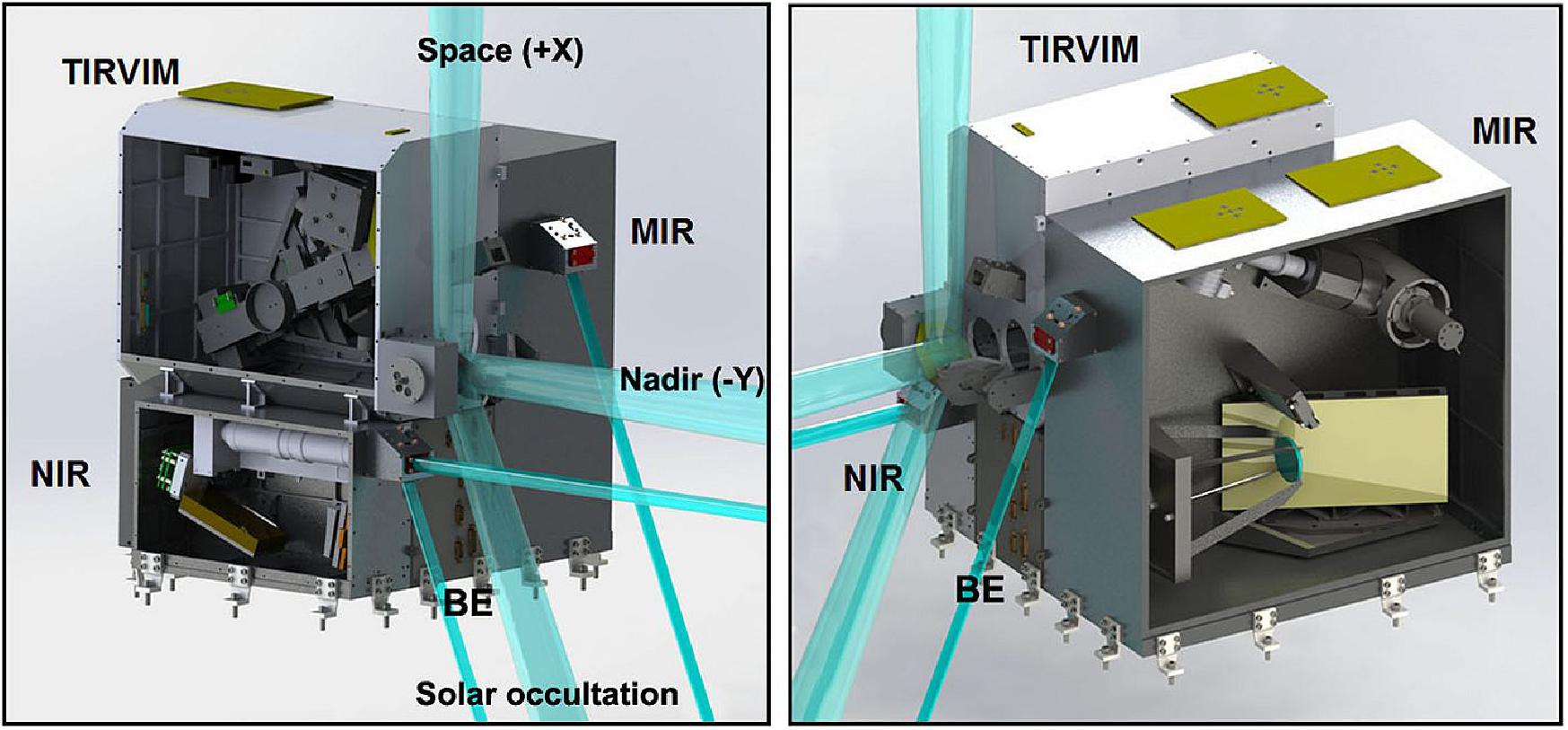
The ACS block diagram is shown in Figure 134. The common BE (Electronic Block) serves as a single electrical interface of the ACS to the spacecraft in terms of power, commands, and data. The power interface includes the main power switch, power conditioning, and the specific switches for each scientific channel. The final power distribution is done in the channels using regulated voltage lines from the BE. The command and data interfaces to TGO are MIL1553 and SpaceWire, respectively. The fully redundant BE electronics feature an FPGA (Field-Programmable Gate Array) and include a 32 GB of flash memory. The control electronics units of each channel are redundant as well. The data and command interfaces between the BE and the scientific channels are of the type low-voltage differential signaling.
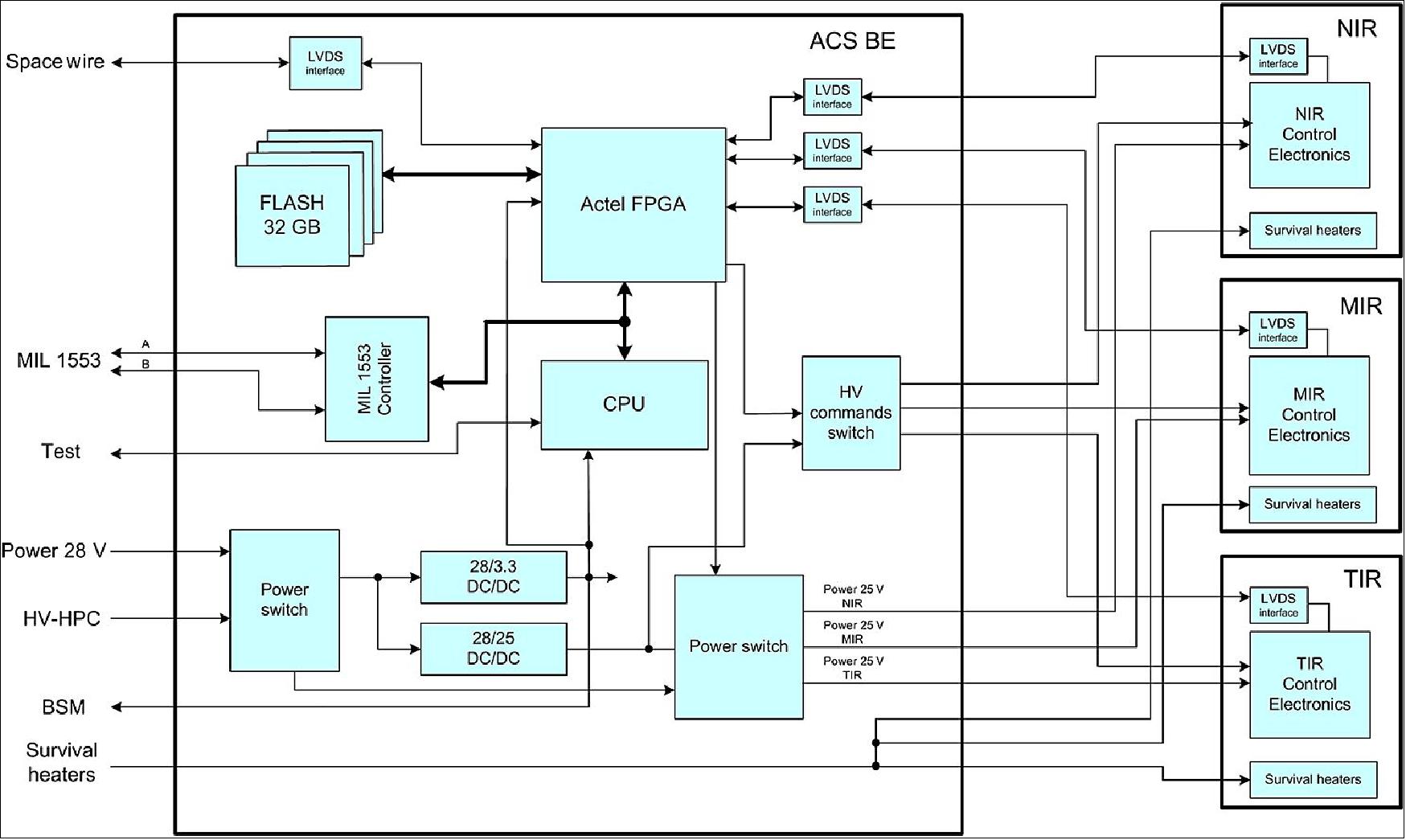
General measurement and interface parameters of ACS are summarized in Table 7. ACS consists of four blocks bolted together and sharing a single mechanical interface to the spacecraft. Roughly two-thirds of its mass allocation of 33.5 kg is dedicated to the larger channels, MIR and TIRVIM. The remaining mass is shared between the smaller NIR channel, the BE, the mechanical structure, and the thermal regulation system.
Following the spacecraft requirements, the ACS suite regulates its thermal characteristics, minimizing thermal flux to the spacecraft. The thermal control is provided by several radiators placed at the upper plane of TIRVIM and MIR channels, and a radiator at the right surface of IR (as in Figure 133; +X and -Z axes of the spacecraft, respectively), as well as by independent operational and survival thermal control systems. During the cruise/aerobraking phases of flight, the BE is off and the regulation of survival heaters is provided by dedicated subsystems.
Parameter | NIR | MIR | TIRVIM | ACS |
Operation modes | Nadir (dayside and nightside), SO | SO (Solar Occultation) | Nadir (dayside and nightside), SO | Nadir, SO, limb |
FOV (Field of View) | 2º x 0.02º | 10 x 0.5 arcmin | 3º full solar disk in SO |
|
Spectral range | 0.73-1.6 µm | 2.3-4.3 µm 7 photometers (TBC) 0.2-0.9 µm | 2-17 µm, 1.7 µm nadir CH4 | 0.25–17 µm full |
Instantaneous spectral range | 50 x 100 cm-1 | 7 x (0.28-0.32 µm) ex. | Full range |
|
Time to measure one spectrum | 1 s nadir 50 ms SO | 0.5-1 s | 4 s nadir 10 s nadir CH4 2 s SO |
|
No of spectra/measurement | ≤ 10 | 1 or 2 | 1 or 2 |
|
Spectral resolution/resolving power | λ/Δλ ≥ 20,000 | λ/Δλ ≥ 50,000 | 1.6 cm nadir |
|
Mass (preliminary) | 3.3 kg | 12.2 kg | 11.6 kg | 33.5 kg |
Power (preliminary) | 15 W | 30 W | 28 W | 39–85 W, survival 22 W |
Volume | 12 x 35 x 25 cm3 | 20 x 50 x 60 cm3 | 20 x 44 x 30 cm3 | 52 x 60 x 47 cm3 |
Data rate (preliminary) | 0.1 Gbit/day | 0.7 Gbit/day | 0.7 Gbit/day | 1.5 Gbit/day |
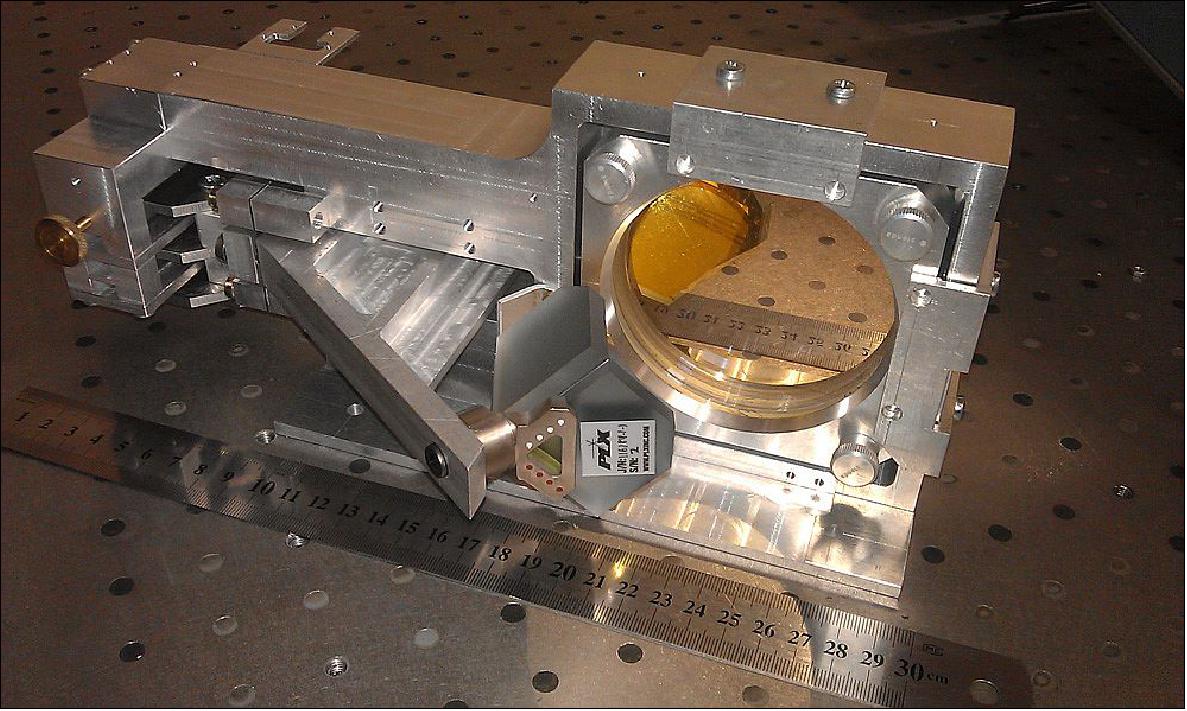
• ACS-NIR is an Echelle AOTF (Acousto-Optic Tuneable Filter) spectrometer, which will operate in nadir, limb and solar occultation modes, detecting infrared light in the wavelength range from 0.7 µm - 1.7 µm. 128)
• ACS-MIR is an Echelle spectrometer, which will operate in solar occultation mode, covering the range from 2.3 µm - 4.6 µm.
• ACS-TIR is a Fourier spectrometer with two channels, one covering 1.7 µm - 17 µm that will operate in nadir and solar occultation modes, and another covering 1.7 µm - 4 µm (optimized for 3.3 µm) that will operate in nadir mode.
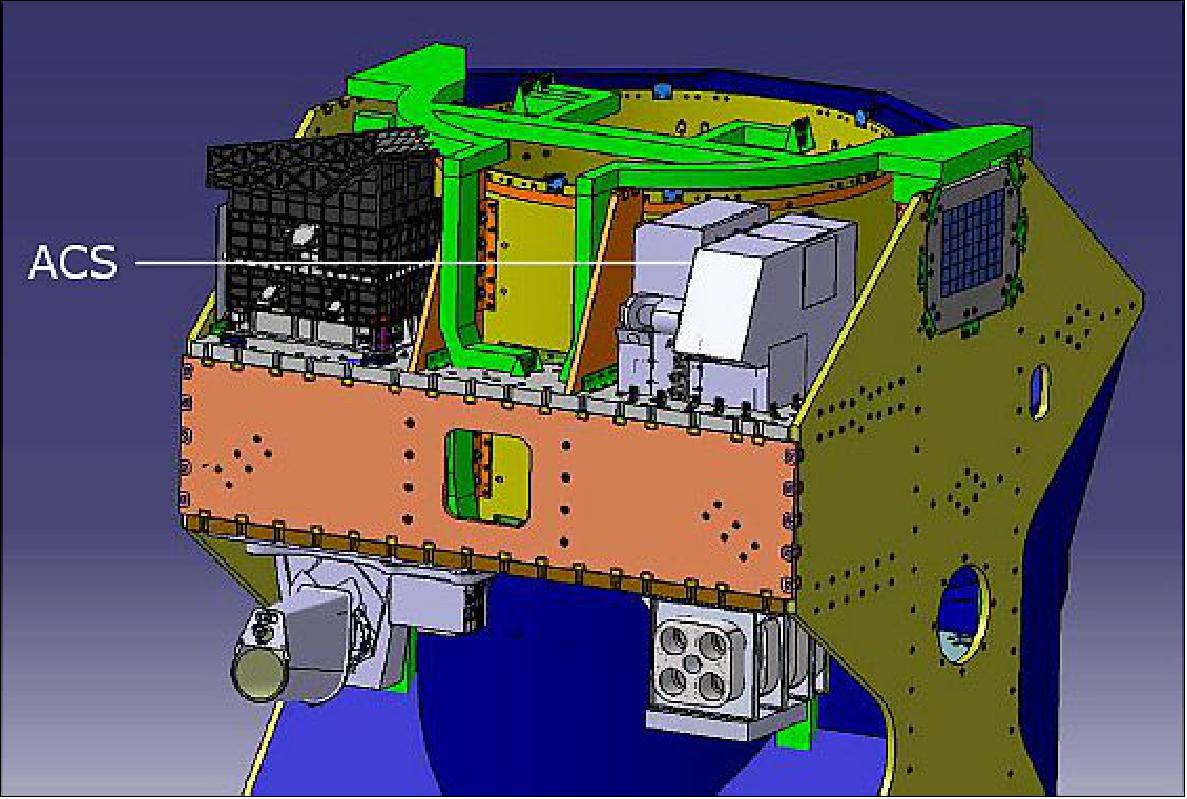
CaSSIS (Color and Stereo Surface Imaging System)
This high-resolution camera (5 m/pixel) will obtain color and stereo images of the surface covering a wide swath. It will provide the geological and dynamic context for sources of trace gases detected by NOMAD and ACS. PI: Nicolas Thomas, University of Bern, Switzerland. 129) 130)
CaSSIS will characterize sites that have been identified as potential sources of trace gases and investigate dynamic surface processes – for example, sublimation, erosional processes and volcanism – which may contribute to the atmospheric gas inventory. The instrument will also be used to certify potential landing sites by characterizing local slopes, rocks and other possible hazards.
By acquiring color and stereoscopic images of surface features, CaSSIS will allow scientists to investigate whether specific types of geological processes might be associated with trace gas sources and sinks. The NOMAD and ACS instruments, also being carried by the orbiter, will identify sources of trace gases that could be evidence for biological or geological activity. The CaSSIS imaging system will have a horizontal scale of about five meters per pixel; stereoscopic reconstruction will enable a vertical resolution of about six meters.
CaSSIS will be located on the Mars-surface-facing side of the orbiter. The orbiter science payload will be primarily nadir pointing to keep the Martian surface in constant view. The orbiter will rotate about an axis that will maintain its solar panels oriented towards the Sun while avoiding solar illumination of its thermal radiators. CaSSIS can compensate for the spacecraft's yaw rotation using a drive mechanism, but during nominal stereoscopic imaging the orbiter will pause its yaw-rotation to maximize the paired-image accuracy. The rotation mechanism will be able to turn the entire telescope system by 180º while its support structure remains fixed.
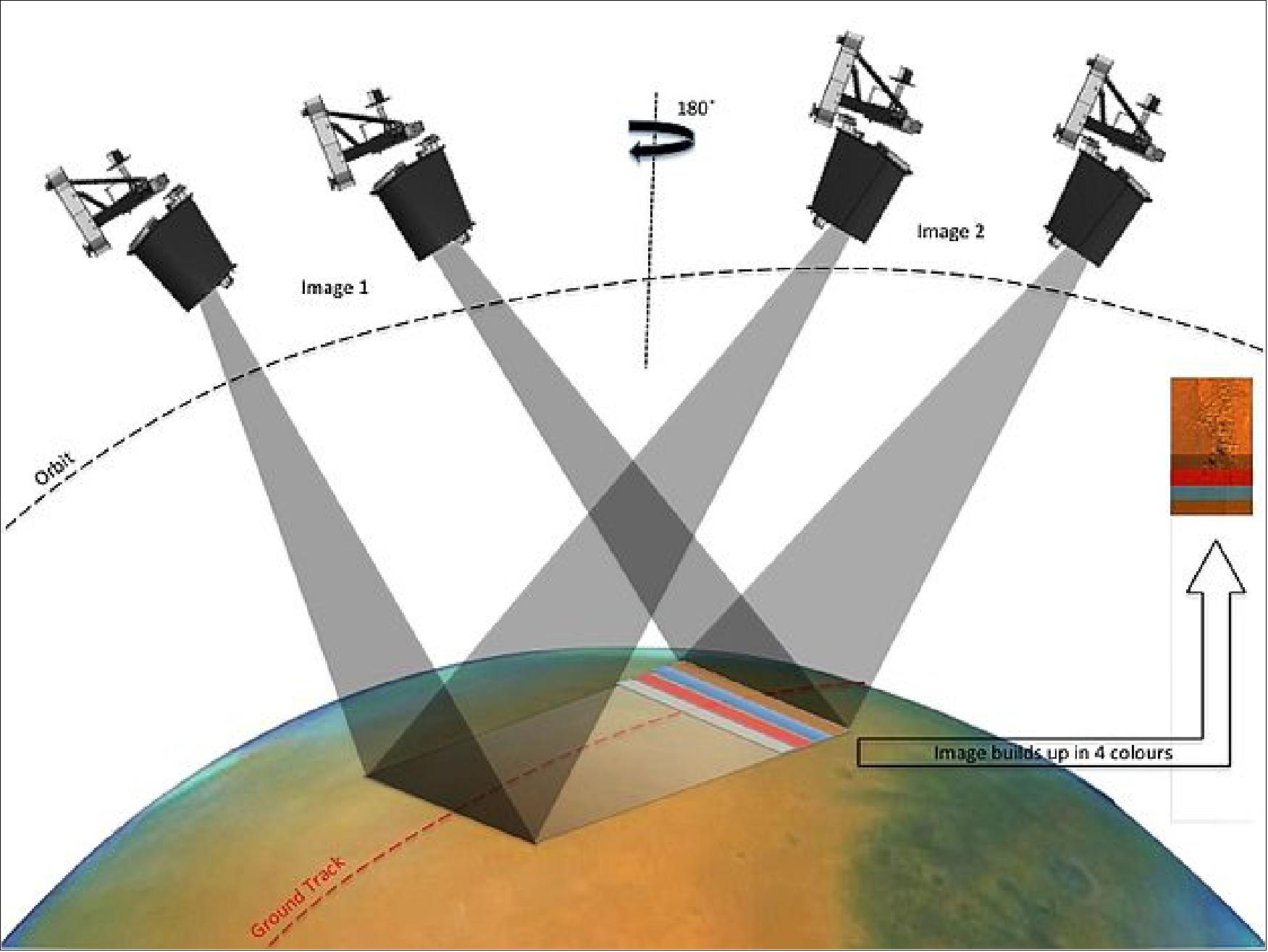
This rotation system will also enable the camera to acquire stereo images with only one telescope and focal plane assembly. A stereo image pair will be acquired by first rotating the telescope to point 10º ahead of the spacecraft track to acquire the first image, then rotating it 180º to point 10º behind for the second stereo image. Optimal correlation of the stereo signals will be ensured as there will be identical illumination conditions every time a stereo image pair is acquired.
CaSSIS is a high-resolution camera system capable of acquiring color stereo images of surface features possibly associated with trace gas sources and sinks in order to better understand the range of processes that might be related to trace gas emission. The NOMAD and ACS instruments, also being carried by the orbiter, will identify sources of trace gases that could be evidence for biological or geological activity.
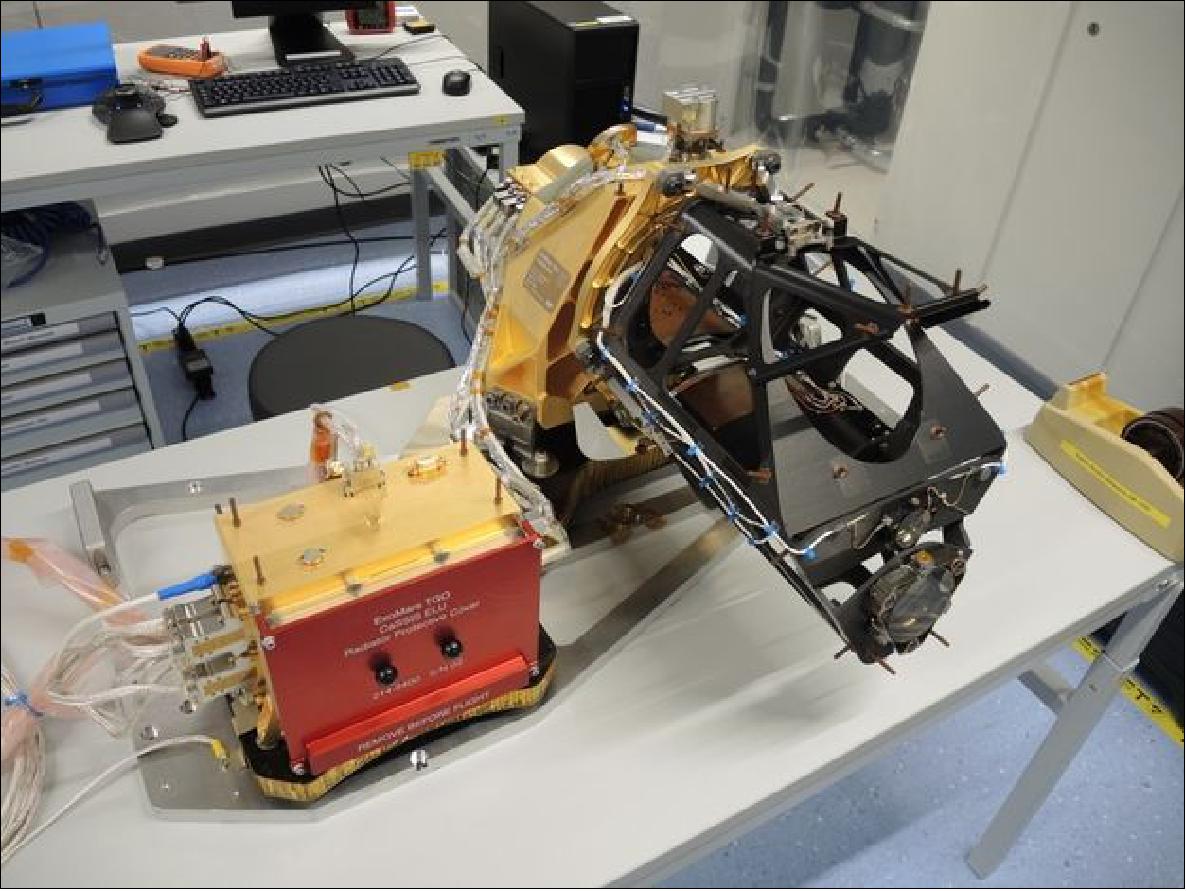
The camera consists of a three-mirror off-axis telescope with an additional slightly powered folding mirror, which will project an image onto the focal plane. The instrument electronics unit will be mounted separately on the spacecraft deck, next to the telescope. The imager will cover an eight-kilometer-wide swath of the planet's surface in four different wavelength ranges.
Telescope type | TMA (Three-Mirror Anastigmat) |
Focal length, aperture, angular scale | 880 mm, 135 mm diameter, 5 µrad/pixel |
FOV (Field of View) | 1.34º x 0.88º |
Filter wavelengths (bandwidths) | Pan 650 nm (250 nm) |
FREND (Fine Resolution Epithermal Neutron Detector)
This neutron detector will map hydrogen on the surface down to a meter deep, revealing deposits of water-ice near the surface. FREND’s mapping of shallow subsurface water-ice will be up to 10 times better than existing measurements. PI: Igor Mitrofanov, Space Research Institute (IKI), Moscow, Russia. 131)
FREND is a neutron detector with a collimation module that significantly narrows the field of view of the instrument, thus allowing the creation of higher-resolution maps of hydrogen-abundant regions on Mars. FREND will measure the flux of neutrons from the Martian surface; these are produced by the continuous cosmic ray bombardment interacting with the first few meters of rock and regolith. The cosmic rays are sufficiently energetic to break apart atoms in the top 1-2 m of the planetary surface, releasing high-energy neutrons that are then slowed down and absorbed by the nuclei of elements in the surrounding material. Not all the neutrons are captured – many escape, creating a leakage flux of neutrons that the FREND instrument will observe. 132)
The distribution of neutron velocities, which depends upon how much they were slowed down before escaping, can reveal much about the surface material since it depends on the composition of that material – primarily on its hydrogen content. Even small quantities of hydrogen are known to cause a measurable change in the neutron velocity distribution from the surface of celestial bodies with thin or no atmospheres. This measured hydrogen content can be related to the presence of water.
Epithermal neutrons with energies in the 0.4 eV - 500 keV range will be detected by 3He counters, while neutrons with energies from 0.5 MeV - 10 MeV will be detected using a stylbene scintillator crystal.
FREND also contains a dosimeter module to monitor the local radiation environment. This helps to increase the accuracy of the neutron measurements by providing information about other radiation fluctuations (including space weather driven by the Sun) that can have an impact on the signals from the 3He and stylbene detectors.
FREND is Designed to
• perform high spatial resolution mapping of epithermal and fast neutron fluxes from the Martian surface
• monitor neutrons and charged particle fluxes over broad energy ranges during periods of quiet Sun and during solar particle events
• provide maps of hydrogen concentration in the Martian soil at high spatial resolution
• allow comparison of orbital and ground data as measured by FREND on TGO, the DAN (Dynamic Albedo of Neutrons) instrument on the MSL (Mars Science Laboratory), also known as Curiosity, and the Adron instrument on the ExoMars 2018 Rover
• search for temporal changes in neutron fluxes related to the seasonal Martian water cycle and galactic cosmic ray variations.
FREND builds on previous and current flight heritage, most notably the HEND (High Energy Neutron Detector) on Mars Odyssey; the LEND (Lunar Exploration Neutron Detector) on the LRO (Lunar Reconnaissance Orbiter); the Mercury Gamma and Neutron Spectrometer on BepiColombo; and DAN on MSL.
To map with high spatial resolution the fluxes of neutrons (epithermal, thermal, and fast ones) and, thereafter, hydrogen distribution, FREND is equipped with a set of four 3He detectors and one stilbene-based scintillation crystal. The 3He detectors are proportional counters filled with helium-3 under the pressure of 6 atmospheres and placed inside four openings of the collimator. Each of them counts neutrons independently, so that count statistics is higher (and, thus, maps are statistically more reliable) and instrument is more resistant to failures.
These detectors measure neutrons with energies from 0.4 to 500 keV. The scintillation counter, which uses a stilbene crystal, measures fast neutrons with energies 0.5–10 MeV. It is also placed inside the collimator. The scintillation module includes anti-coincidence shielding, to discriminate between signals from high-energy charged particles and neutrons.
FREND's collimation module is a passive element, encasing all five detectors. The collimator consists of two layers, the outer one made of high-density polyethylene, the inner one of enriched boron powder (B10). The neutrons, hitting the collimator's sides, are slowed down by polyethylene, with a large number of hydrogen atoms. So thermalized neutrons then pass through and get into the B10 layer, which absorbs them.
The collimator's opening angle narrows the FOV of the detectors to the spot with diameter of 40 km on the Martian surface, when seen from the circular orbit with 400 km altitude, allocated for TGO. Thus, the spatial resolution of the neutron maps of Mars will be enhanced 7.5 times compared to the maps of the HEND instrument.
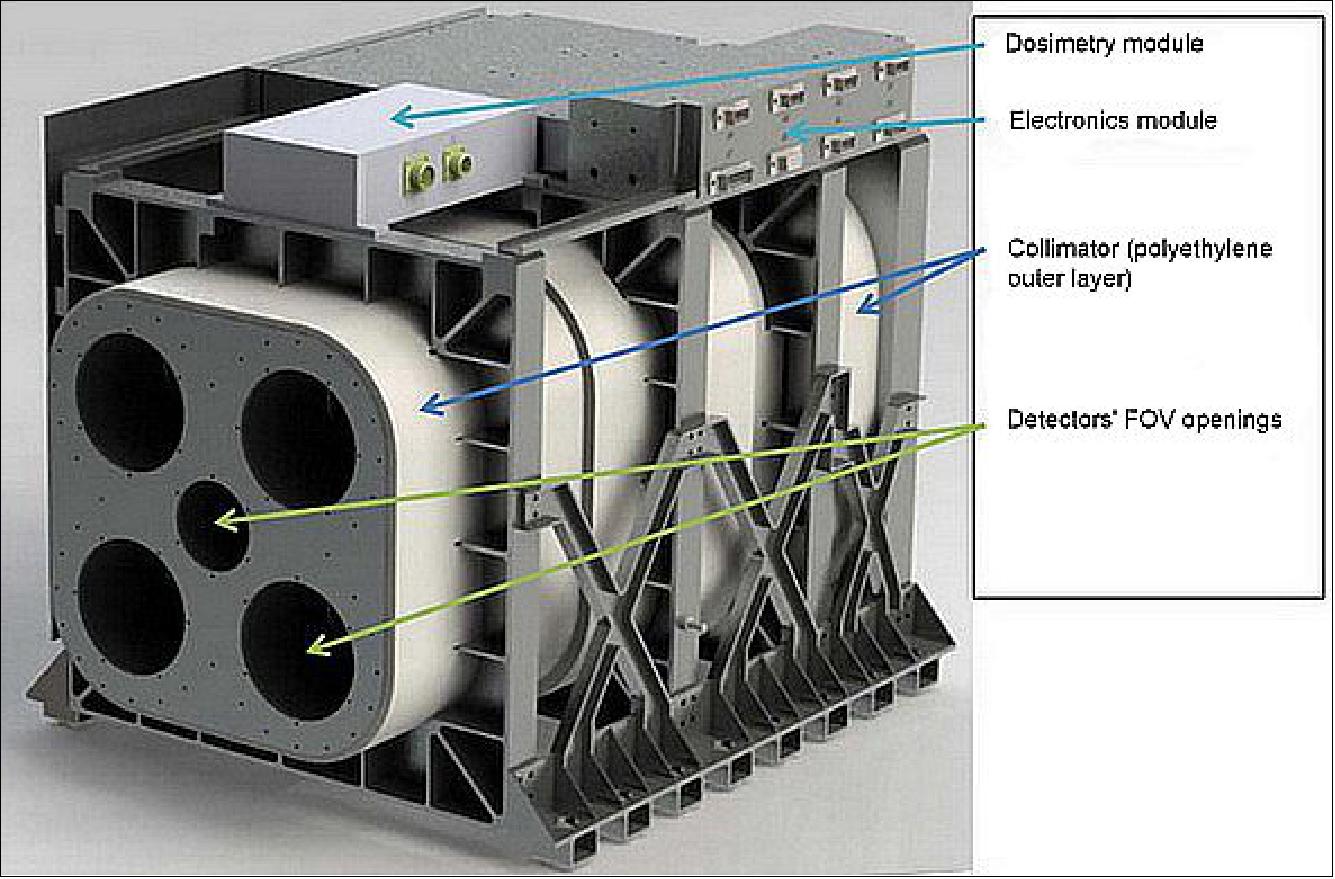
The FREND instrument consists of electronics and dosimetry modules (located separately, in the upper part of Figure 139), collimator module (several composite sections), which shield the detectors from radiation coming from outside the nadir direction, and five detectors (not seen in the figure).
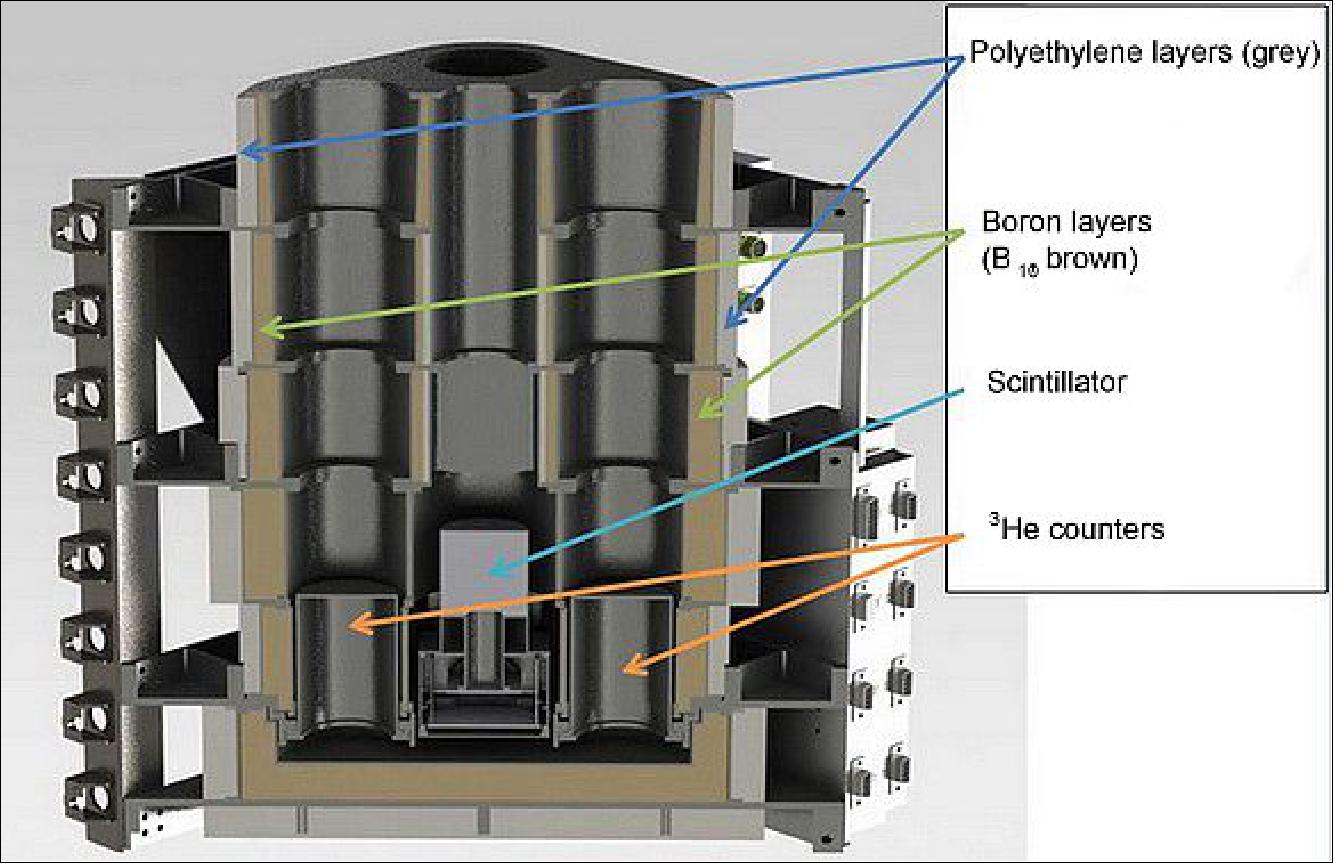
Mass, power consumption, size | 36 kg, 14 W, 465 x 380 x 370 mm |
Energy range | 0.4–500 keV (neutrons); 0.5–10 MeV (charged particles) |
Time resolution | from 1 second |
Surface resolution, depth resolution | ~40 m, ~ 1 m |
Telemetry rate | 50 Mbit/day |
NOMAD (Nadir and Occultation for Mars Discovery)
NOMAD combines three spectrometers, two infrared and one ultraviolet, to perform high-sensitivity orbital identification of atmospheric components, including methane and many other species, via both solar occultation and direct reflected-light nadir observations. PI: Ann Carine Vandaele, BIRA-IASB (Belgian Institute for Space Aeronomy), Brussels, Belgium. The countries contributing to NOMAD are: Spain, Italy ,United Kingdom, United States of America, Canada. The NOMAD infrared channels were built upon the expertise of BIRA-IASB’s successful SOIR (Solar Occultation in the Infra-Red) instrument which is on-board ESA’s VEX (Venus Express) mission.
The NOMAD spectrometer suite on the ExoMars Trace Gas Orbiter will map the composition and distribution of Mars' atmospheric trace species in unprecedented detail, fulfilling many of the scientific objectives of the joint ESA-Roscosmos ExoMars Trace Gas Orbiter mission. 133)
NOMAD is a spectrometer suite that can measure the spectrum of sunlight across a wide range of wavelengths (infrared, ultraviolet and visible). This broad coverage of the instrument enables the detection of the components of the Martian atmosphere, even in low concentrations. In addition to identifying the constituents of the Martian atmosphere, NOMAD will also map their locations. 134) 135) 136) 137)
The measurements will be carried out in solar occultation, i.e. the instrument points toward the Sun when the Orbiter moves at the dark side of Mars, as well as in nadir mode, i.e. looking directly at the sunlight reflected from the surface and atmosphere of Mars. The inclination of the Orbiter has been chosen to optimize the science that can be done with the instrument suite.
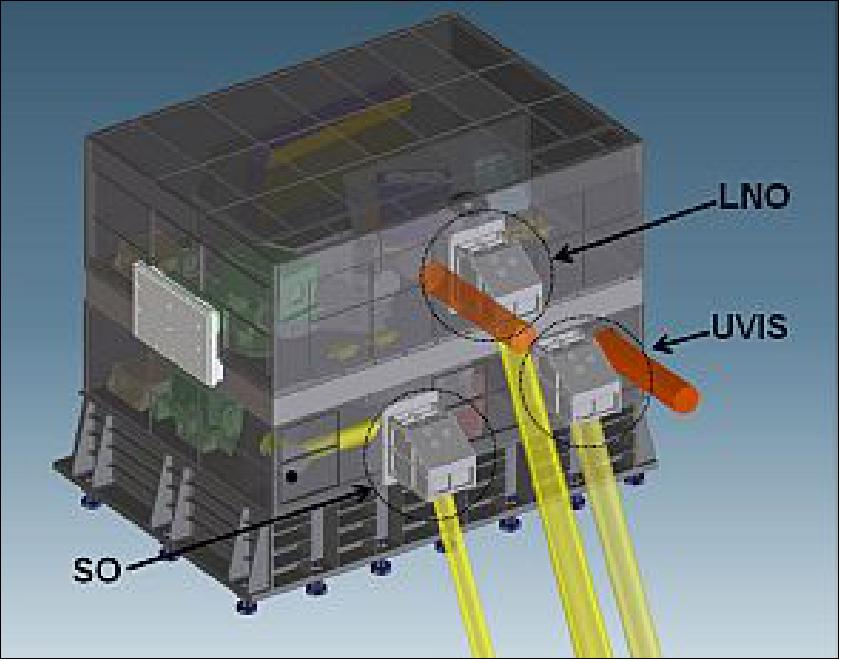
NOMAD covers the infrared (2.2-4.3 µm) and the ultraviolet-visible (0.2-0.65 µm) spectral regions, using the following three operational modes:
• SO (Solar Occultation) mode: The SO operates by observing up to six small slices of the full spectral range each second. This allows observing several different target molecules that absorb at different wavelengths, whilst maximizing the SNR (Signal-to-Noise Ratio) for each. During a solar occultation, which lasts about 5 minutes, 300 spectra at each wavelength can be taken providing a profile of the atmospheric composition from the top of the atmosphere down to almost the surface, depending on dust levels.
• LNO (Limb, Nadir and Occultation) mode: The LNO is sensitive to the lower light levels during nadir observations on Mars. The nadir coverage will facilitate the study of the atmospheric composition in addition to examining Martian surface features, such as ice and frost. This measurement will be carried out on average every 3 to 4 sols (a solar day on Mars, or sol, is 24 hours and 39 minutes) with varying local times across the planet.
• UVIS (Ultraviolet and Visible) mode: The UVIS will image the wavelength domain between 200 and 650 nm, every second, covering and providing more information about several interesting molecules, such as ozone, sulphuric acid and aerosols in the atmosphere.
The SO spectrometer channel will perform occultation measurements, operating between 2.2 and 4.3 µm at a resolution of ~0.15 cm-1, with 180 to 1000 m vertical spatial sampling. LNO will perform limb scanning, nadir and occultation measurements, operating between 2.2 and 3.8 µm at a resolution of ~0.3 cm-1. In nadir, global coverage will extend between ± 74º latitude with an IFOV (Instantaneous Field of View) of 0.5 x 17 km on the surface. This channel can also make occultation measurements should the SO channel fail. UVIS will make limb, nadir and occultation measurements between 200 and 650 nm, at a resolution of 1.5 nm. It will achieve 300 m vertical sampling with a 1 km vertical resolution during occultation and 5 x 60 km ground resolution during 15 s nadir observations (IFOV of 5 x 5 km).
An order-of-magnitude increase in spectral resolution over previous instruments will allow NOMAD to map previously unresolvable gas species, such as important trace gases and isotopes. CO, CO2, H2O, C2H2, C2H4, C2H6, H2CO, CH4 SO2, H2S, HCl, O3 and several isotopologues of methane and water will be detectable, providing crucial measurements of the Martian D/H ratios. It will also be possible to map the sources and sinks of these gases, such as regions of surface volcanism/outgassing and atmospheric production, over the course of an entire Martian year, to further constrain atmospheric dynamics and climatology. NOMAD will also continue to monitor the Martian water, carbon, ozone and dust cycles, extending existing data sets made by successive space missions in the past decades, from which surface UV radiation levels will be determined. Using SO and LNO in combination with UVIS, aerosol properties such as optical depth, composition and size distribution can be derived for atmospheric particles and for distinguishing dust from ice aerosols, as demonstrated on Venus by the analysis of the SPICAV-UV, IR and SOIR data.
Wavelength λ, Wavenumber | 2.3-4.3 µm, 4250–2320 cm-1 |
Instrument line profile (ILP), ILP for CH4 | 0.22 cm-1, 0.15 cm-1 |
Pixel sampling FWHM (Full Width Half Maximum) | ≥2 |
Polarization | linear, parallel to slit |
Resolving power λ/Δλ | 20,000 |
Slit width in object space, Slit length in object space | 2 arcmin, 30 arcmin |
FOV (Field of View) | 2 x 30 arcmin |
Spatial sampling, vertical sampling | 1 arcmin, ≤1 km |
SNR | ≥900 |
Mass ((including all NOMAD electronics) | 13.5 kg |
Dimensions (without periscope) | 490.5 x 353 x 208 mm3 |
General | |
Wavelength λ, Wavenumber | 2.3-3.8 µm, 4250–2630 cm-1 |
Instrument line profile (ILP) | 0.5 cm-1 |
Pixel sampling FWHM (Full Width Half Maximum) | ≥2 |
Polarization | linear, parallel to slit |
Resolving power λ/Δλ | 10,000 |
Slit width in object space, Slit length in object space | 4 arcmin, 150 arcmin |
FOV (Field of View) | 4 x 150 arcmin |
Spatial sampling | 1 arcmin |
Entrance aperture diameter | 29.5 x 24 mm2 |
Mass | 9.4 kg |
Dimensions (without periscope) | 445 x 327 x 182 mm3 |
SO (Solar Occultation) | |
Vertical sampling, SNR | ≤1 km, ≥900 |
Nadir footprint (400 km orbit) | 60 x 0.3 arcmin2 |
SNR, SNR for CH4 | ≥400, ≥1000 |
Parameter | SO (Solar Occultation) | Nadir Observation |
Volume, mass | 128 mm x 152 mm x 89 mm, 950 g | |
Spectral range, spectral resolution | 200-650 nm, 1.5 nm | |
Numerical aperture of the fiber | 0.22 | |
F-number | 2.15 | 2.18 |
FOV, IFOV | 2 arcmin, 1 km | 43 arcmin, 5 km x 5 km |
Typical observation binning, observation time | 8 rows, 0.2 s | 64 rows, 15 s |
Footprint of nadir channel during a typical 15 s observation |
| 60 km x 5 km |
Vertical sampling | < 300 m (Δz at limb) |
|
SNR (specification requirement) | 230-450 nm: SNR≥1000 | 230-450 nm: SNR≥500 |
Detector e2V back-thinned CCD30-11 | 2D 1024 x 256 pixel CCD | |
The mass of NOMAD is 28.86 kg including margins. From this, the SO and LNO optical bench masses are 13.35 kg (including all NOMAD electronics) respective 9.4 kg. The remaining mass is attributed to UVIS (940 g) and harnessing, MLI (Multilayer Insulation), and instrument-to-spacecraft mounting hardware (3.7 kg).
Sensor Complement (Schiaparelli)
Science investigations to be carried on Schiaparelli, the ExoMars entry, descent and landing demonstration module (EDM), were selected in June 2011 following an announcement of opportunity released by ESA and NASA. 138)
The selected investigations consist of a surface payload, called DREAMS, which will operate on the surface of Mars for 2–8 sols, and an investigation known as AMELIA, for entry and descent science investigations using the spacecraft engineering sensors.
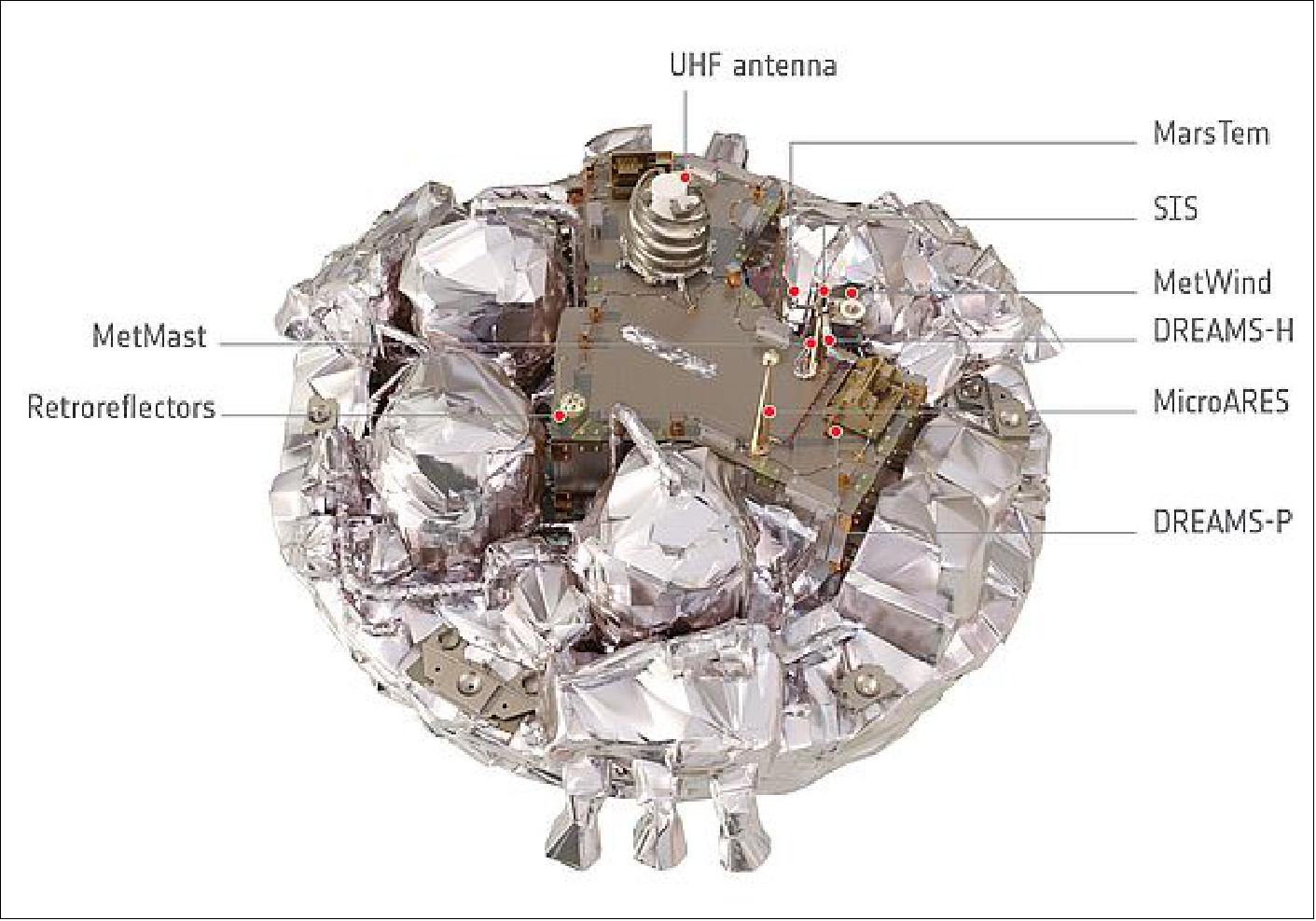
DREAMS (Dust Characterization, Risk Assessment, and Environment Analyzer on the Martian Surface)
The surface payload, consisting of a suite of sensors to measure local wind speed and direction (MetWind), humidity (DREAMS-H), pressure (DREAMS-P), atmospheric temperature close to the surface (MarsTem), transparency of the atmosphere (Solar Irradiance Sensor, SIS), and atmospheric electric fields (Atmospheric Radiation and Electricity Sensor, MicroARES). PI: Francesca Esposito, INAF – Osservatorio Astronomico di Capodimonte, Naples, Italy; Co-PI: Stefano Debei, CISAS –Università di Padova, Italy.
DREAMS will provide the first measurements of electric fields on the surface of Mars (with MicroARES). Combined with measurements (from SIS) of the concentration of atmospheric dust, DREAMS will provide new insights into the role of electric forces on dust lifting, the mechanism that initiates dust storms.
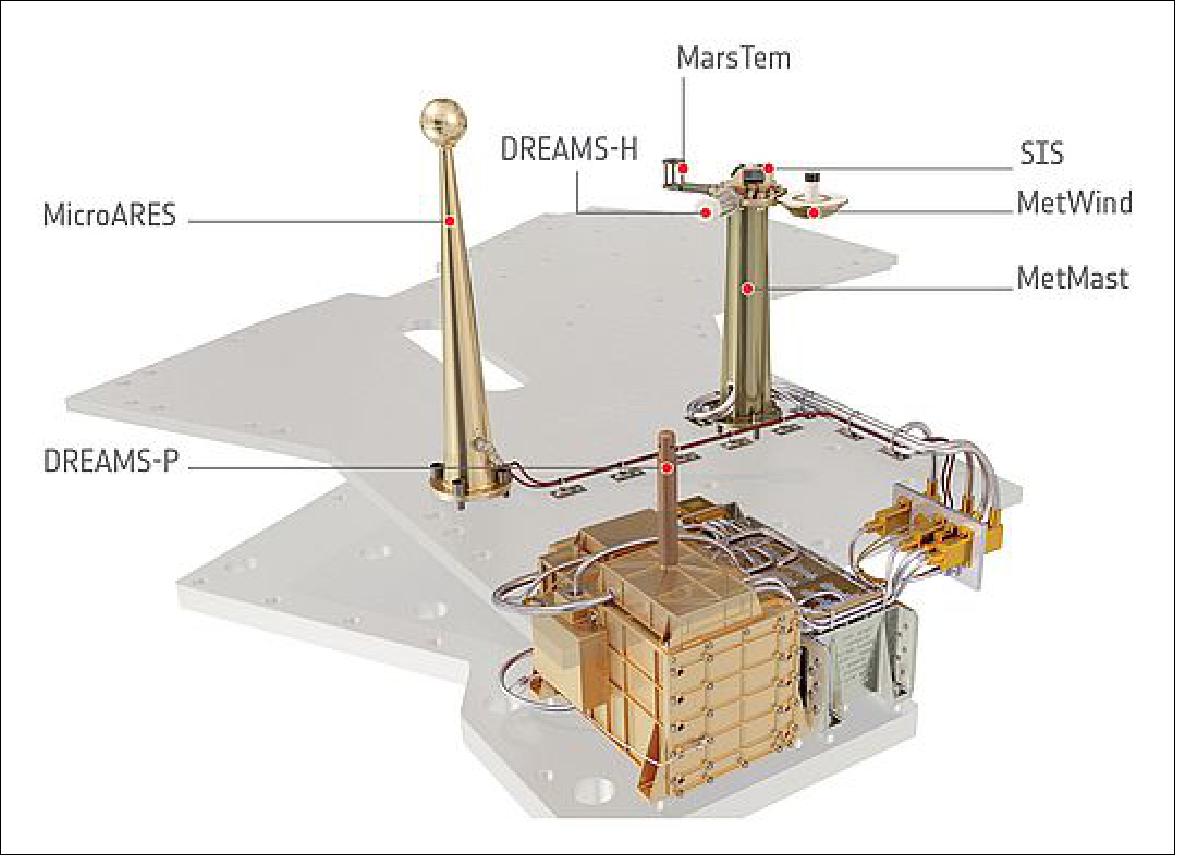
AMELIA (Atmospheric Mars Entry and Landing Investigation and Analysis)
The objective of AMELIA is to collect entry and descent science data using the spacecraft engineering sensors. PI: Francesca Ferri, Università degli Studi di Padova, Italy. The engineering data is used to reconstruct Schipiarelli's trajectory and determine atmospheric conditions, such as density and wind, from a high altitude to the surface. These measurements are key to improving models of the Martian atmosphere.
COMARS+ (Combined Aerothermal and Radiometer Sensors Instrumentation Package)
The objective of COMARS+ is to measure aerothermal parameters on the exterior of Schiaparelli as it passes through the atmosphere. Team leader: Ali Gülhan, DLR, Cologne, Germany. Determining what happens to Schiaparelli's external surface as it penetrates the Martian atmosphere and descends to the surface is essential in order to understand the engineering and physics required to make entry, descent, and landing on Mars a success. COMARS+, which is installed on the back cover of Schiaparelli will gather the data to study this. 141)
COMARS+ consists of three combined sensors (COMARS) spaced equally across the back cover of Schiaparelli, one broadband radiometer, and an electronic box (inside the module). The entire package has a mass of 1.73 kg and draws 4.5 W of power. The sensors, located on the back cover of the module, will measure the pressure, the temperature of the module's surface, the rate at which heat energy is transferred to the surface (total heat flux rate), and the amount of radiated heat from the hot gas to the back cover (radiative heat flux).
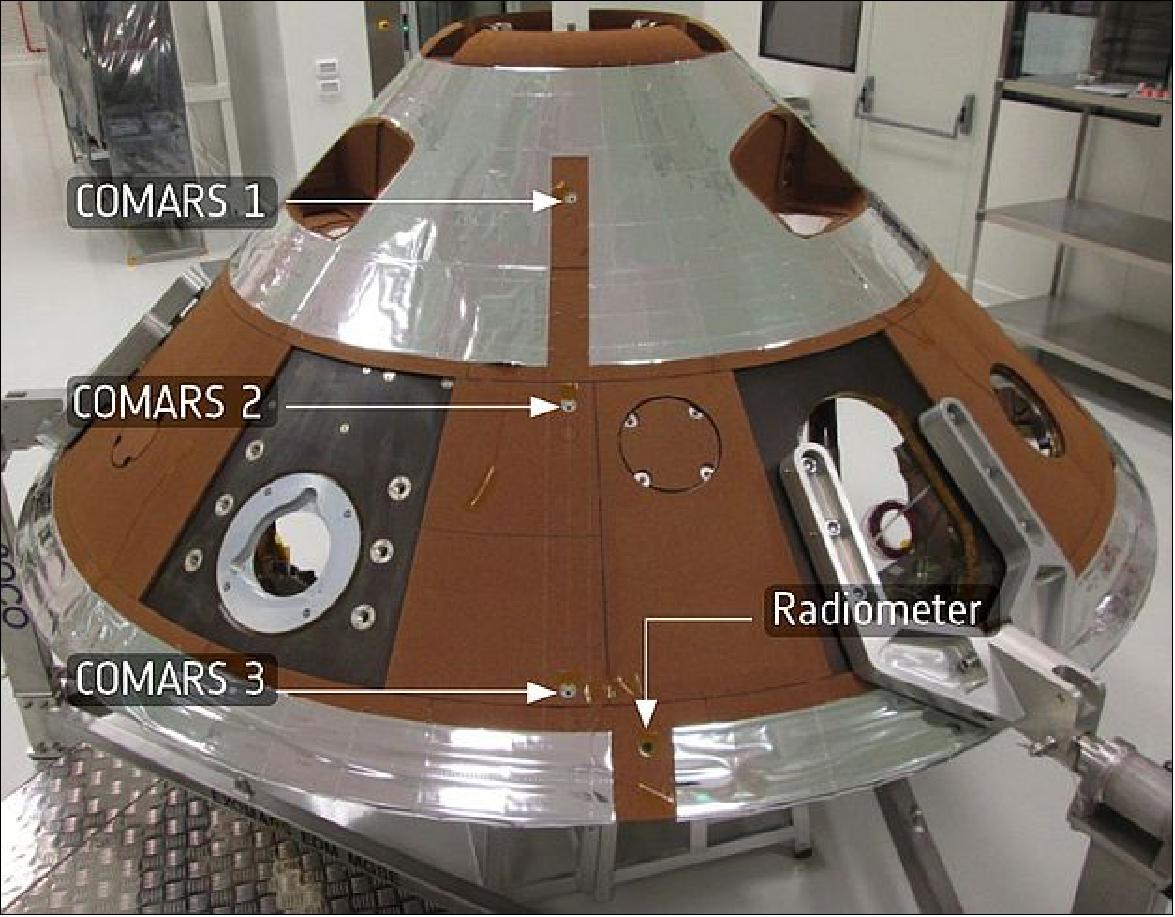
Two so-called ICOTOM narrow band radiometers in each COMARS sensor are provided by CNES. In addition, a broadband radiometer provided by DLR is integrated close to the COMARS 3 sensor. The data produced from this instrument package will provide essential input for the improved design of future missions landing on Mars. The COMARS+ package is provided by the German Aerospace Center (DLR).
Unit name | Description |
Multiplexing Signal Conditioner (MSC) | Electronic box |
COMARS1 (COM 1) | Combined static pressure, total heat-flux, |
COMARS2 (COM 2) | |
COMARS3 (COM 3) | |
Radiometer (RAD) | Broadband radiometer |
Payload harness | Harness connecting the sensors to the electronic box |
The locations of the three COMARS sensors and the broadband radiometer on the Schiaparelli back cover are shown in Figure 144. The mechanical design of the COMARS sensor is shown in Figure 145 with main dimensions in millimeters and denominations of the different sensor parts. The sensor was mounted to inserts in the honeycomb structure of the Schiaparelli back cover using four M4 screws. Adjustable spacers between titanium holder and honeycomb insert ensured that the sensor front end was mounted flush with the TPS surface. The connection to the electronic box was done using a D-Sub connector.
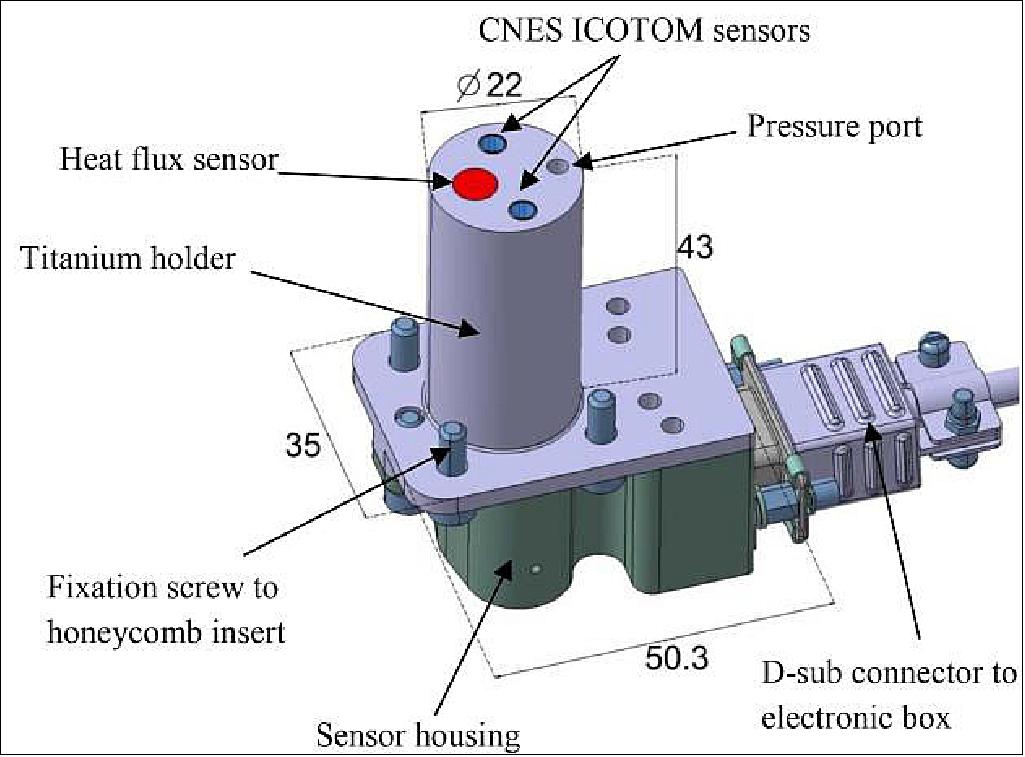
Figure 146 shows the layout of the broadband radiometer. Diameter, length and fixation points were identical to the COMARS sensor, so that the same honeycomb insert could be used. The actual thermopile sensor was located at the lower end of the conical borehole. A four pin LEMO connector was used for the connection to the electronic box.
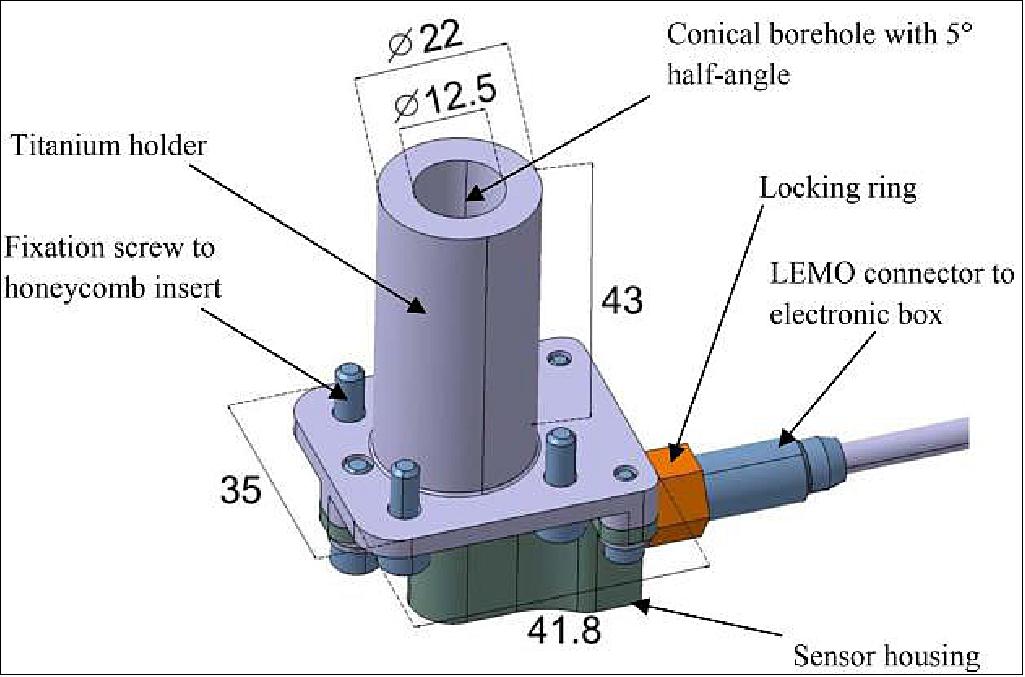
Results
Although the landing of Schiaparelli failed, part of the flight data during the entry phase was transmitted to the orbiter at a low sampling rate. All COMARS+ sensors delivered useful data with respect to total heat flux rate, radiative heat flux rate, surface temperature and surface pressure from the atmospheric entry point until parachute deployment with the exception of the plasma blackout phase. The main results of the COMARS+ in-flight measurements can be summarized as follows (Ref. 141):
• The radiative heat flux on the back cover near the vehicle shoulder was measured successfully. At the first trajectory point after communication blackout the measured radiative heat flux is 9.0 kW/m2, or 61% of the total heat flux. This value decreases to 33% for the trajectory point 10 seconds later. These results confirm an important radiative contribution to the total heating on the back cover.
• The highest ratio of the measured total heat flux rate to the calculated front cover stagnation point heat flux rate occurred close to the vehicle shoulder (COMARS3) immediately after the communication blackout with a value of approximately 0.11. This ratio decreases for later trajectory points. At the two sensors COMARS2 and COMARS1, which are located at larger distances from the vehicle shoulder, the ratio directly after communication blackout is approximately 0.086.
• Pressure measured at three back cover locations showed almost no dependence on measurement location, as the pressures were very similar in magnitude and temporal behavior. This finding is believed to be the result of separated aftbody flowfield at the measurement locations. An unexpected pressure increase was measured late in the entry trajectory after peak dynamic pressure. Possible explanations for this behavior could be a change of the wake flow from laminar to turbulent regime or a variation in angle of attack which influences the wake flow field.
• Measured back cover total heat fluxes are below the sizing total heat flux level of the back cover TPS. This very important result suggests that the design margins of the back cover TPS design can be reduced.
INRRI (INstrument for Landing-Roving Laser Retroreflector Investigations)
The INRRI instrument is developed by ASI together with INFN (Italian National Institute for Nuclear Physics). Team leader: Simone Dell'Agnello, INFN/LNF National Laboratories of Frascati), Frascati, Italy. INRRI will be the first passive laser reflector on the surface of Mars and the first to go further than the Moon. 143)
INRRI for Mars Rovers is a new enabling technology for planetary exploration because: it will provide accurate Rover georeferencing during its exploration activity, recording its positions where significant geological measurements have been made by Rover instruments as reference for future exploratory missions. Example of the latter: future sample return mission targeting an INRRI-georeferenced position explored/surveyed by the Rover of particularly high interest to NASA/ESA/ASI long-term goals for Mars exploration (outstanding astrobiologically relevant sites, potential biosignature locations). 144)
INRRI is a laser retroreflector micropayload of about 50 gr weight and about 55 mm x 20 mm size. It will be laser tracked by Mars orbiters capable of laser ranging and/or laser altimetry, like for example LOLA (Lunar Orbiter Laser Altimeter) on LRO (Lunar Reconnaissance Orbiter) and/or laser communication, like for example LLCD (Lunar Laser Comm demo) on LADEE (Lunar Atmosphere and Dust Environment Explorer), or OPALS (Optical PAyload for Lasercomm Science) on the ISS.
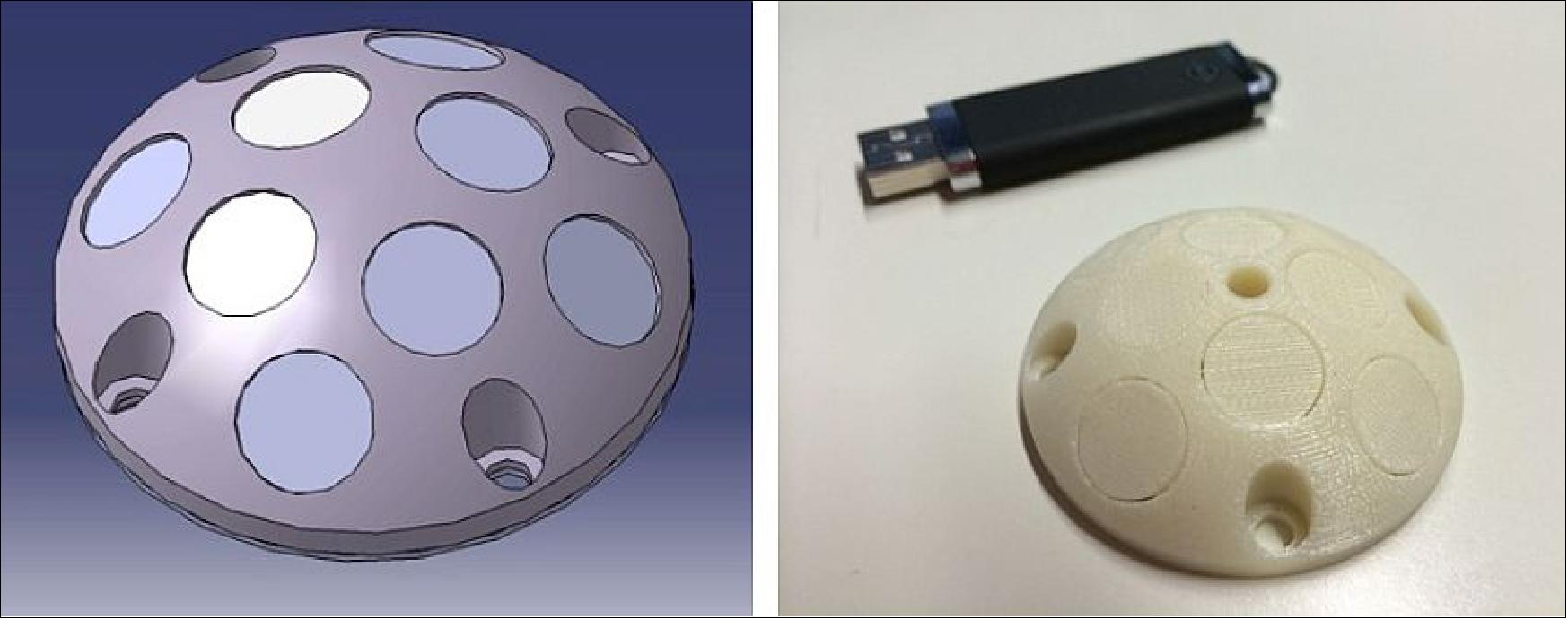
INRRI for Mars Rovers is a new, wavelength-independent, enabling technology to test, validate, and locally diagnose, on Mars, certain aspects related to transmitter and receiver subsystems for future laser-communication from Mars orbiters to Earth, an activity that is a long-term interest for future Mars missions. This will be also applied to future laser-comm between Mars orbiters and Mars surface (future Rovers and distributed installations).
DECA (Descent Camera)
Will record several images during descent, but will not be able to take any images of the surface after landing. Team leader: Detlef Koschny, ESA Science Support Office. 145)
DECA is the flight spare of the VMC (Visual Monitoring Camera), which flew on the Herschel spacecraft. It will be used to perform high-resolution imaging of the Schiaparelli landing site, to determine the transparency of the martian atmosphere, and to support the generation of a 3-D topography model of the surface of the landing region.
DECA was designed and built by OIP (Optique et Instruments de Précision) in Belgium for ESA.The camera has a mass of 0.6 kg and dimensions of about 9 cm x 9 cm x 9 cm.
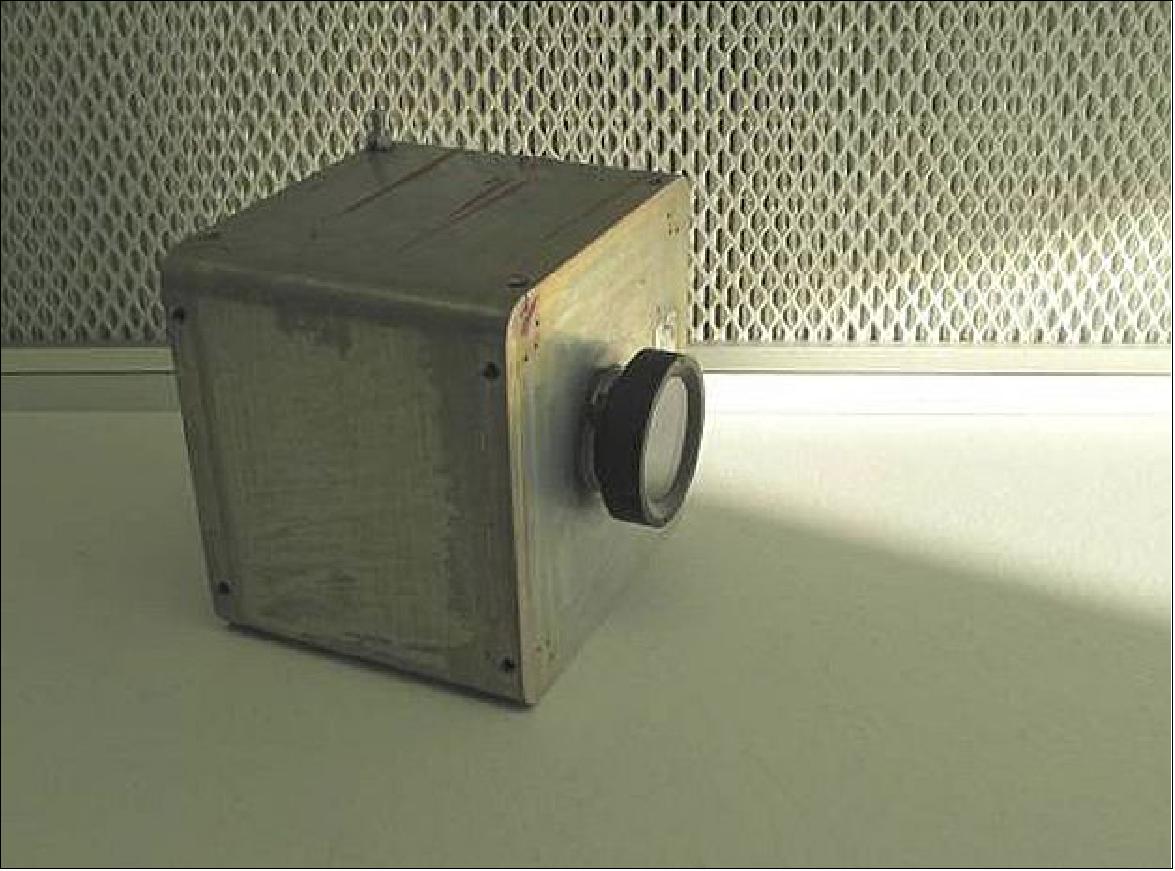
DECA will start taking images after the front-shield of Schiaparelli has been jettisoned during the journey through the martian atmosphere to the planet's surface. It will take 15 images at 1.5 s intervals. These images will be stored in local memory. To avoid electrostatic discharges affecting the instrument, there will be a delay of several minutes after Schiaparelli has landed on the surface of Mars, before the data are read out by Schiaparelli's computer and subsequently downlinked to Earth.
Arriving at Mars
Although designed to demonstrate entry, descent and landing technologies, Schiaparelli also offers limited, but useful, science capabilities. It will deliver a science package that will operate on the surface of Mars for a short duration after landing, planned to last approximately 2-4 sols (martian days). 146)
• Three days before reaching the atmosphere of Mars, Schiaparelli will separate from the Orbiter.
• The module will then coast to Mars during which phase it will remain in hibernation mode in order to reduce its power consumption.
• Schiaparelli will be activated a few hours before entering the atmosphere of Mars, at an altitude of 122.5 km and a speed of approximately 21,000 km/h.
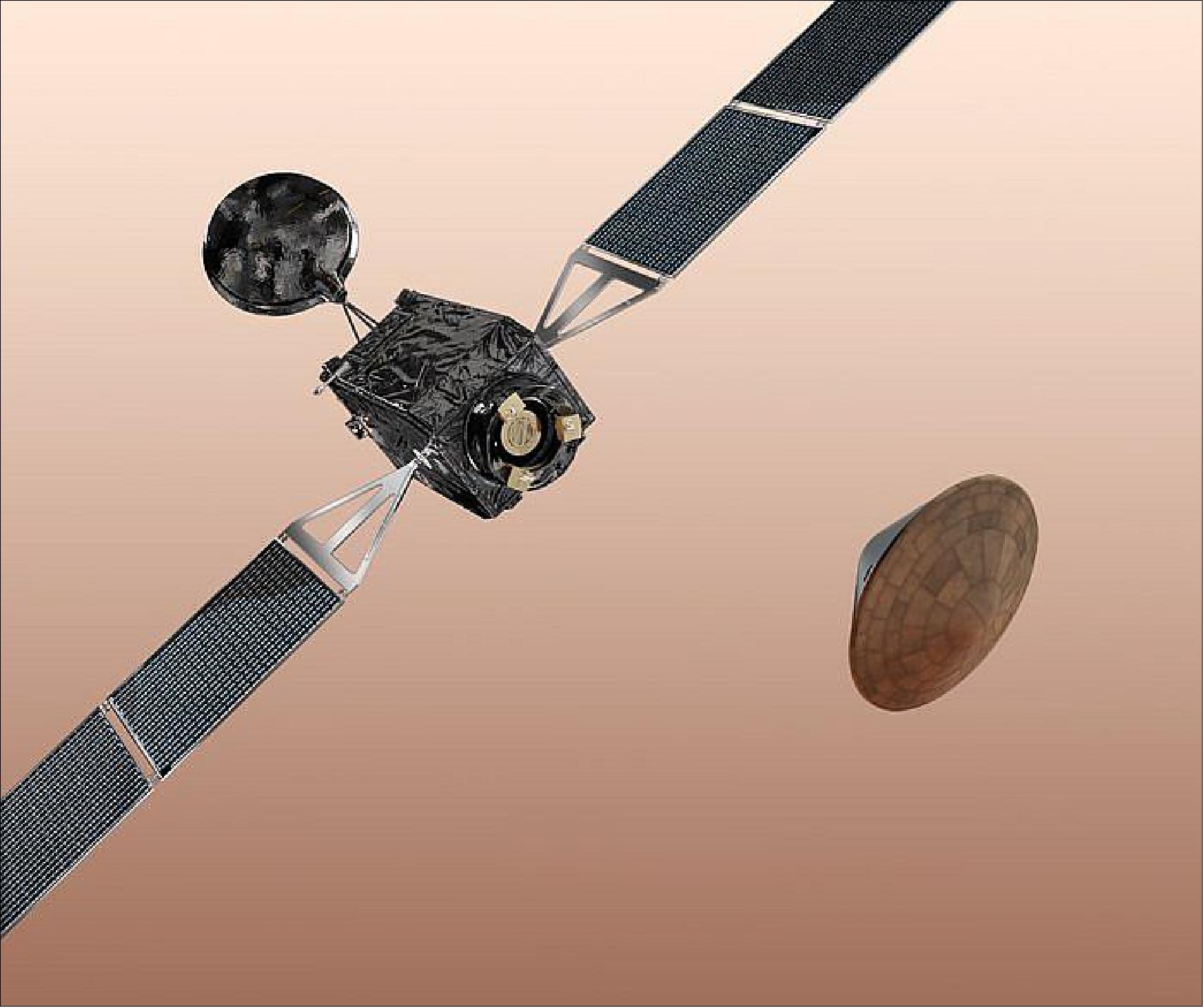
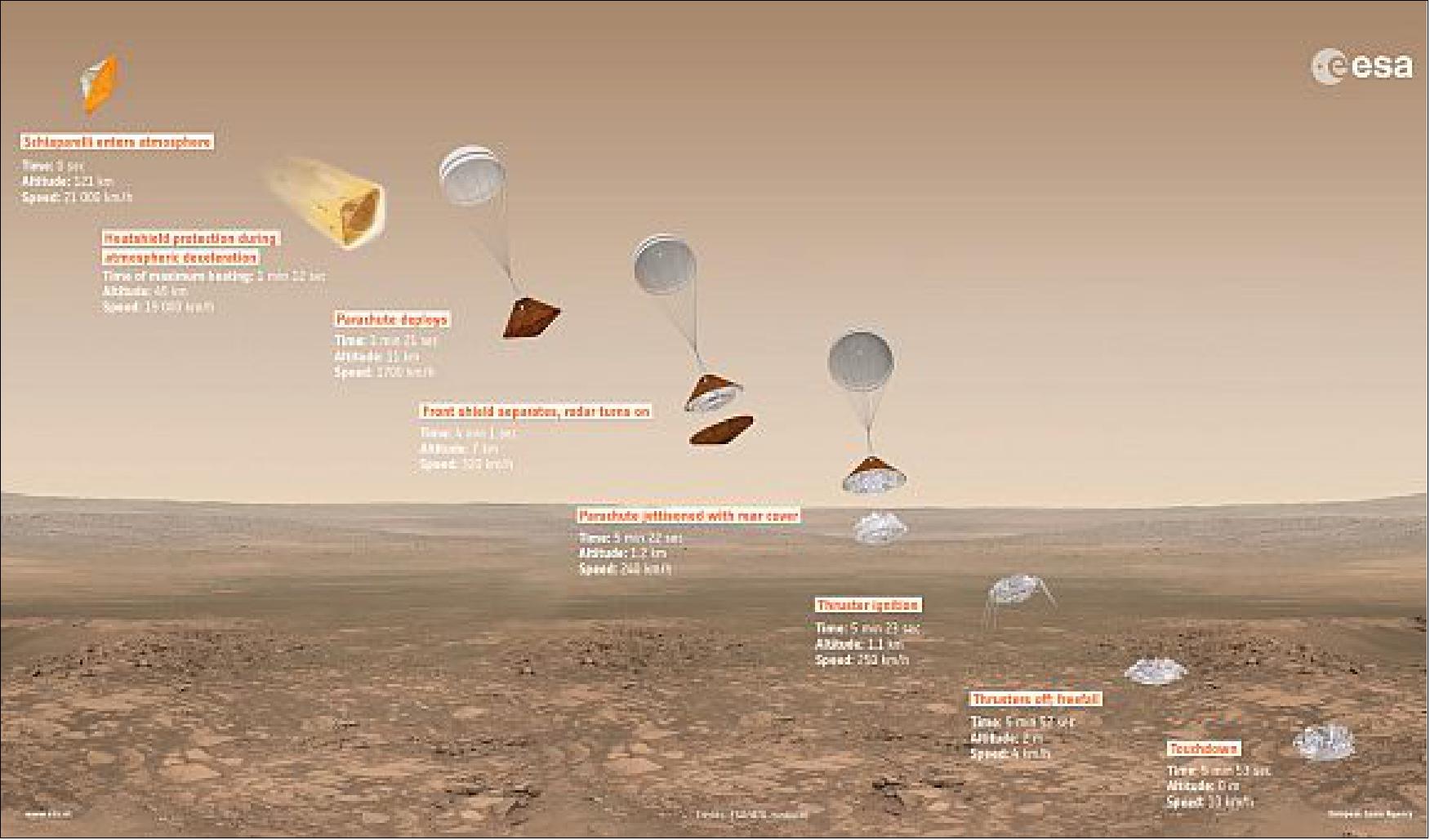
• Entry: An aerodynamic heatshield will protect Schiaparelli from the severe heat flux and deceleration, so that at an altitude of about 11 km, when the parachute is deployed, it will be travelling at around 1650 km/h.
• Descent: The module will first release the front heatshield and then the rear heatshield will also be jettisoned.
- Schiaparelli will turn on its Doppler radar altimeter and velocimeter to locate its position with respect to the Martian surface.
• Landing: The liquid propulsion system will be activated to reduce the speed to less than 7 km/h when it is 2m above the ground. At that moment the engines will the switched off and the lander will drop to the ground.
- As Schiaparelli lands, the final shock will be cushioned by a crushable structure built into module.
- The primary landing site has been identified: it is a plain known as Meridiani Planum, a plain located 2 degrees south of Mars' equator in the westernmost portion of Terra Meridiani. This area interests scientists because it contains an ancient layer of hematite, an iron oxide that, on Earth, almost always forms in an environment containing liquid water.
A communication link between Schiaparelli and the TGO (Trace Gas Orbiter) will facilitate the realtime transmission of the most important data measured by the module. The complete set of data acquired will be transmitted to the Orbiter within 8 sols after the landing (a solar day on Mars, or sol, is 24 hours and 37 minutes). The Schiaparelli mission then comes to an end.
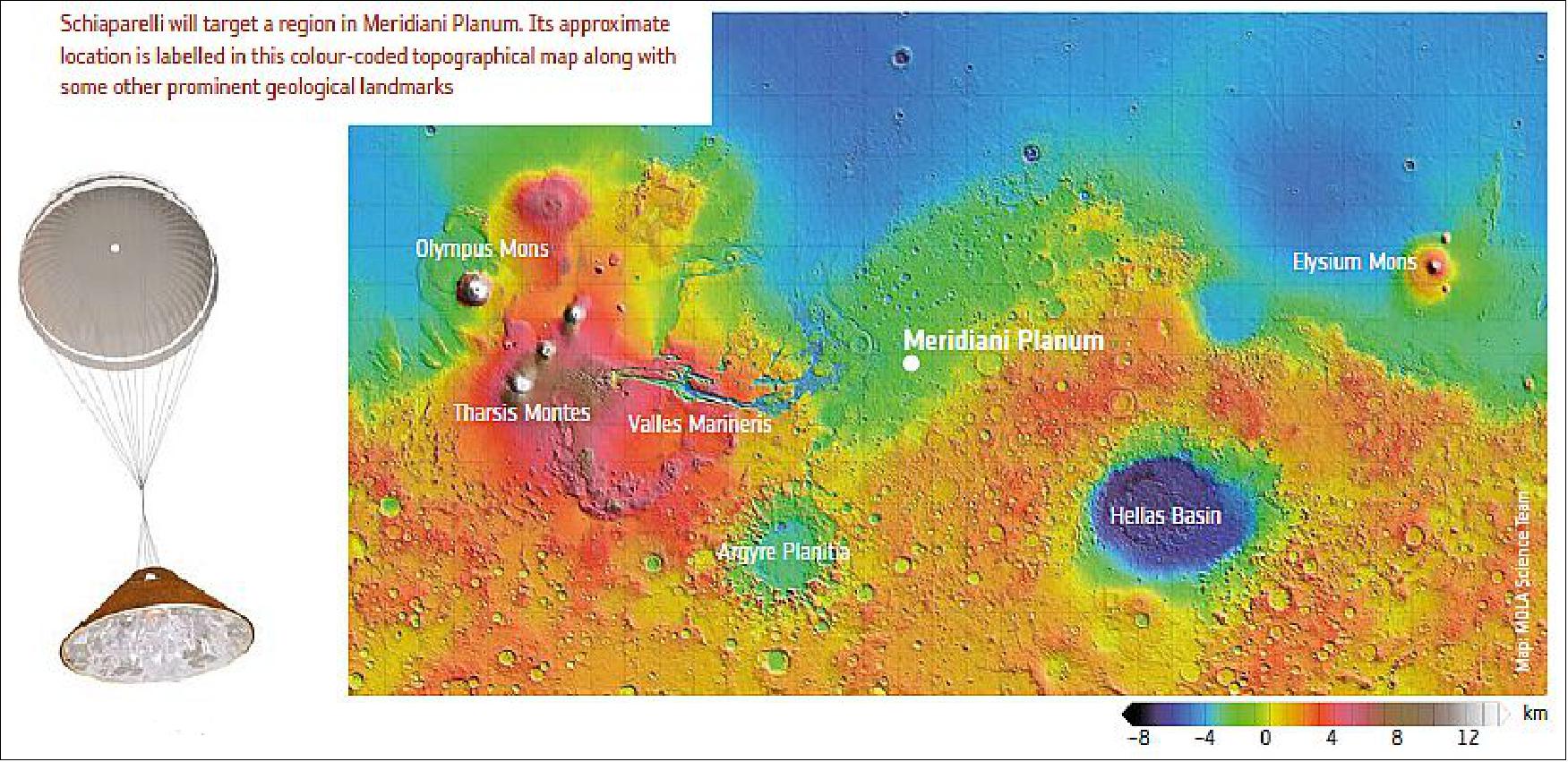
References
1) ”ExoMars - Science Management Plan,” ESA, Version 6.0, Jan. 31, 2014, URL: http://exploration.esa.int/science-e/www/object/doc.cfm?fobjectid=46850
2) The agreement between the European Space Agency and the Federal Space Agency (the Russian Federation) concerning cooperation on robotic exploration of Mars and other bodies in the Solar System, was signed 14 March 2013.
3) ”Second ExoMars mission moves to next launch opportunity in 2020,” ESA, May 2, 2016, URL: http://www.esa.int/Our_Activities/Space_Science/ExoMars/
Second_ExoMars_mission_moves_to_next_launch_opportunity_in_2020
4) ”ExoMars Lander module named Schiaparelli,” ESA, Nov. 8, 2013, URL: http://www.esa.int/Our_Activities/Space_Science/ExoMars_lander_module_named_Schiaparelli
5) ”ExoMars Mission (2018),” ESA, Oct. 28, 2015, URL: http://exploration.esa.int
/mars/48088-mission-overview/
6) E. Baldwin, EJR-Quartz, ”ExoMars 2016 - Europe's new era of Mars exploration,” ESA,BR-327 November 2015, URL: http://esamultimedia.esa.int/multimedia/publications/BR-327/offline/download.pdf
7) ”ExoMars Trace Gas Orbiter and Schiaparelli Mission (2016),” ESA, Feb. 23, 2016, URL: http://exploration.esa.int/mars/46124-mission-overview/
8) Maurizio Capuano, Gianluca Passarelli, Stefano Portigliotti, Diana Margheritis, Oliver Bayle, Thierry Blancquaert, ”ExoMars 2016 Mission EDL Demonstrator Module Technologies, Science Opportunity and Planetary Protection Implementation,” Proceedings of the 66th International Astronautical Congress (IAC 2015), Jerusalem, Israel, Oct.12-16, 2015, paper: IAC-15-A3.3A.2
9) ”NASA's Participation in ESA's 2016 ExoMars Orbiter Mission,” NASA, March 14, 2016, URL: http://mars.nasa.gov/programmissions/missions/future/exomarsorbiter2016/
10) ”TGO Electra radios,” ESA, March 3, 2016, URL: http://www.esa.int/spaceinimages/Images/2016/03/TGO_Electra_radios
11) R. Lescouzères, M. Wolf, B. Wollenhaupt, S. Goodburn, M. Peukert, T. Biehler, M. Abele, M. Pastorino, T. Walloschek, ”Propulsion System Development and Verification Activities for the 2016 ExoMars Trace Gas Orbiter,” Space Propulsion Conference 2014, Cologne, Germany, May 19-22, 2014, URL: http://www.ecosimpro.com/wp-content/uploads/2015/02/SP2014_2968951_Wolf.pdf
12) ”Busy in Baikonur: a look back at the first few weeks for ExoMars 2016 at the Cosmodrome,” ESA, Jan. 22, 2016, URL: http://exploration.esa.int/mars/
57228-busy-in-baikonur-a-look-back-at-the-first-few-weeks-for-exomars-2016-at-the-cosmodrome/
13) ”United they stand – Trace Gas Orbiter and Schiaparelli are joined,” ESA, Feb. 16, 2016, URL: http://exploration.esa.int/mars/57387-united-they-stand-trace-gas-orbiter-and-schiaparelli-are-joined/
14) ”Fuelled for Mars,” ESA space science image of the week, Feb. 23, 2016, URL: http://www.esa.int/spaceinimages/Images/2016/02/Fuelling_the_Trace_Gas_Orbiter
15) ”The ExoMars 2016 spacecraft and Breeze upper stage ready for encapsulation,” ESA, March 3, 2016, URL: http://exploration.esa.int/mars/
57524-the-exomars-2016-spacecraft-and-breeze-upper-stage-ready-for-encapsulation/
16) ”ExoMars 2016 spacecraft encapsulated within launcher fairing,” ESA, March 3, 2016, URL: http://exploration.esa.int/mars/57517-exomars-2016-spacecraft-encapsulated-within-launcher-fairing/
17) ”ExoMars 2016 at the launch pad,” ESA, March 11, 2016, URL: http://exploration.esa.int
/mars/57588-exomars-2016-at-the-launch-pad/
18) ”ExoMars on its way to solve the Red Planet's mysteries,” ESA March 14, 2016, URL: http://www.esa.int/Our_Activities/Space_Science/ExoMars/
ExoMars_on_its_way_to_solve_the_Red_Planet_s_mysteries
19) ”ExoMars 2016: launch to Mars,” ESA, Feb. 17, 2014, URL: http://www.esa.int/spaceinvideos/Videos/2016/02/ExoMars_2016_launch_to_Mars
20) ”Mars mission heralds start of UK’s search for life on red planet,” UKSA, March 14, 2016, URL: https://www.gov.uk/government/news/mars-launch-heralds-start-of-uks-search-for-life-on-red-planet
21) ”The devil’s in the detail,” ESA Science & Exploration, 11 February 2022, URL: https://www.esa.int/ESA_Multimedia/Images/2022/02/The_devil_s_in_the_detail
22) ”Crater tree rings,” ESA Science & Exploration, 28 January 2022, URL: https://www.esa.int/ESA_Multimedia/Images/2022/01/Crater_tree_rings
23) ”Rolling stones on Mars,” ESA Science & Exploration, 14 January 2022, URL: https://www.esa.int/ESA_Multimedia/Images/2022/01/Rolling_stones_on_Mars
24) ”Red velvet Mars,” ESA Science&Exploration, 24 December 2021, URL: https://www.esa.int/ESA_Multimedia/Images/2021/12/Red_velvet_Mars
25) ”ExoMars discovers hidden water in Mars’ Grand Canyon,” ESA Science & Exploration, 15 December 2021, URL: https://www.esa.int/Science_Exploration/Human_and_Robotic_Exploration
/Exploration/ExoMars/ExoMars_discovers_hidden_water_in_Mars_Grand_Canyon
26) ”Groovy crater,” ESA Science & Exploration, 3 December 2021, URL: https://www.esa.int/About_Us/Week_in_images/Week_in_images_29_November_-_3_December_2021
27) ”Icy cliff,” ESA Science & Exploration, 19 November 2021, URL: https://www.esa.int/About_Us/Week_in_images/Week_in_images_15_-_19_November_2021
28) ”Double strike,” ESA Science & Exploration, 05 November 2021, URL: https://www.esa.int/About_Us/Week_in_images/Week_in_images_01_-_05_November_2021
29) ”Swirling deposits in a giant impact basin,” ESA Science & Exploration, 22 October 2021, URL: https://www.esa.int/About_Us/Week_in_images/Week_in_images_18_-_22_October_2021
30) ”Layered history,” ESA Science & Exploration, 24 September 2021, URL: https://www.esa.int/ESA_Multimedia/Images/2021/09/Layered_history
31) ”Volcanic trenches on Mars,” ESA Science & Exploration, 10 September 2021, URL: https://www.esa.int/ESA_Multimedia/Images/2021/09/Volcanic_trenches_on_Mars
32) ”Crater landslide,” ESA Science & Exploration, 25 August 2021, URL: https://www.esa.int/ESA_Multimedia/Images/2021/08/Crater_landslide
33) ”Crater Trio,” ESA Science & Exploration, 6 August 2021, URL: https://www.esa.int/ESA_Multimedia/Images/2021/08/Crater_trio
34) ”ExoMars orbiter continues hunt for key signs of life on Mars,” ESA Science & Exploration, 20 July 2021, URL: https://www.esa.int/Science_Exploration/Human_and_Robotic_Exploration/
Exploration/ExoMars/ExoMars_orbiter_continues_hunt_for_key_signs_of_life_on_Mars
35) F. Montmessin, O. I. Korablev, A. Trokhimovskiy, F. Lefèvre, A. A. Fedorova, L. Baggio, A. Irbah, G. Lacombe, K. S. Olsen, A. S. Braude, D. A. Belyaev, J. Alday, F. Forget, F. Daerden, J. Pla-Garcia, S. Rafkin, C. F. Wilson, A. Patrakeev, A. Shakun and J. L. Bertaux, ”A stringent upper limit of 20 pptv for methane on Mars and constraints on its dispersion outside Gale crater,” Astronomie & Astrophysics, Volume 650, June 2021, Section: Planets and planetary systems, https://doi.org/10.1051/0004-6361/202140389
36) Elise W. Knutsen, Geronimo L.Villanueva, Giuliano Liuzzia, Matteo M.J. Crismani, Michael J. Mumma, Michael D. Smith, Ann Carine Vandaele, Shohei Aok,Ian R. Thomas, Frank Daerden, Sébastien Viscardy, Justin T. Erwin, , Loic Trompet, Lori Neary,Bojan Ristic, Miguel Angel Lopez-Valverde, Jose Juan Lopez-Moreno, Manish R. Patel, Ozgur Karatekin, Giancarlo Bellucci, ”Comprehensive investigation of Mars methane and organics with ExoMars/NOMAD,” Icarus, Volume 357, 15 March 2021, 114266, https://doi.org/10.1016/j.icarus.2020.114266
37) K. S. Olsen, A. Trokhimovskiy, A. S. Braude, O. I. Korablev, A. A. Fedorova, C. F. Wilson, M. R. Patel, P. G. J. Irwin, F. Montmessin, F. Lefèvre, L. Baggio, J. Alday, D. A. Belyaev, A. Patrakeev and A. Shakun, ”Upper limits for phosphine (PH3) in the atmosphere of Mars,” Astronomy & Astrophysics, Volume 649, May 2021, https://doi.org/10.1051/0004-6361/202140868
38) ”Dynamic dunes,” ESA Science & Exploration, 15 March, 2021, URL: https://www.esa.int/ESA_Multimedia/Images/2021/03/Dynamic_dunes
39) ”ExoMars orbiter images Perseverance landing site,” ESA Science & Exploration, 25 February 2021, URL: https://www.esa.int/ESA_Multimedia/Images/2021/02/ExoMars_orbiter_images_Perseverance_landing_site
40) ”Mars dust devils in action,” ESA Science & Exploration, 22 February 2021, URL: https://www.esa.int/ESA_Multimedia/Images/2021/02/Mars_dust_devils_in_action
41) ”Jezero landing ellipse,” ESA Science & Exploration, 16 February 2021, URL: https://www.esa.int/ESA_Multimedia/Images/2021/02/Jezero_landing_ellipse
42) ”In the Jezero neighborhood,” ESA Science & Exploration, 16 February 2021, URL: https://www.esa.int/ESA_Multimedia/Images/2021/02/In_the_Jezero_neighbourhood
43) ”ExoMars discovers new gas and traces water loss on Mars,” ESA Science & Exploration, 10 February 2021, URL: https://www.esa.int/Science_Exploration/Human_and_Robotic_Exploration
/Exploration/ExoMars/ExoMars_discovers_new_gas_and_traces_water_loss_on_Mars
44) Oleg Korablev, Kevin S. Olsen, Alexander Trokhimovskiy, Franck Lefèvre, Franck Montmessin, Anna A. Fedorova, Michael J. Toplis, Juan Alday, Denis A. Belyaev, Andrey Patrakeev, Nikolay I. Ignatiev, Alexey V. Shakun, V. Grigoriev, Lucio Baggio, Irbah Abdenour, Gaetan Lacombe, Yury S. Ivanov, Shohei Aoki, Ian R. Thomas, Frank Daerden, Bojan Ristic, Justin T. Erwin, Manish Patel, Giancarlo Bellucci, Jose-Juan Lopez-Moreno and Ann C. Vandaele, ”Transient HCl in the atmosphere of Mars,” Science Advances, 10 Feb 2021: Vol. 7, No. 7, eabe4386, DOI: 10.1126/sciadv.abe4386, https://advances.sciencemag.org/content/7/7/eabe4386.full
45) Geronimo L. Villanueva, Giuliano Liuzzi, Matteo M. J. Crismani, Shohei Aoki, Ann Carine Vandaele, Frank Daerden, Michael D. Smith, Michael J. Mumma, Elise W. Knutsen, Lori Neary, Sebastien Viscardy, Ian R. Thomas, Miguel Angel Lopez-Valverde, Bojan Ristic, Manish R. Patel, James A. Holmes, Giancarlo Bellucci, Jose Juan Lopez-Moreno, NOMAD team, ”Water heavily fractionated as it ascends on Mars as revealed by ExoMars/NOMAD,” Science Advances, 10 Feb 2021: Vol. 7, No. 7, eabc8843, DOI: 10.1126/sciadv.abc8843, https://advances.sciencemag.org/content/7/7/eabc8843
46) At the rim of a crater,” ESA Science & Exploration, 10 February 2021, URL: https://www.esa.int/ESA_Multimedia/Images/2021/02/At_the_rim_of_a_crater
47) ”Inside a martian canyon,” ESA Science & Exploration, 4 February 2021, URL: https://www.esa.int/ESA_Multimedia/Images/2021/02/Inside_a_martian_canyon
48) ”ExoMars orbiter's 20000th image,” ESA Science & Exploration, 28 January 2021, URL: https://www.esa.int/ESA_Multimedia/Images/2021/01/ExoMars_orbiter_s_20000th_image
49) ”Frosty scenes in martian summer,” ESA Science & Exploration, 6 January 2021, URL: https://www.esa.int/ESA_Multimedia/Images/2021/01/Frosty_scenes_in_martian_summer
50) ”ExoMars captures spring in martian craters,” ESA Science & Exploration, 4 August 2020, URL: https://www.esa.int/Science_Exploration/Human_and_Robotic_Exploration
/Exploration/ExoMars/ExoMars_captures_spring_in_martian_craters
51) ”ExoMars finds new gas signatures in the martian atmosphere,” ESA Science & Exploration, 27 July 2020, URL: https://www.esa.int/Science_Exploration/Human_and_Robotic_Exploration/Exploration/
ExoMars/ExoMars_finds_new_gas_signatures_in_the_martian_atmosphere
52) K. S. Olsen, F. Lefèvre, F. Montmessin, A. Trokhimovskiy, L. Baggio, A. Fedorova, J. Alday, A. Lomakin, D. A. Belyaev, A. Patrakeev, A. Shakun and O. Korablev, ”First detection of ozone in the mid-infrared at Mars: implications for methane detection,” Astronomy & Astrophysics, Volume 639, Article No A141, Published online: 27 July 2020, https://doi.org/10.1051/0004-6361/202038125, URL: https://www.aanda.org/articles/aa/pdf/2020/07/aa38125-20.pdf
53) A. Trokhimovskiy, V. Perevalov, O. Korablev, A. F. Fedorova, K. S. Olsen, J.-L. Bertaux, A. Patrakeev, A. Shakun, F. Montmessin, F. Lefèvre and A. Lukashevskaya, ”First observation of the magnetic dipole CO2 absorption band at 3.3 µm in the atmosphere of Mars by the ExoMars Trace Gas Orbiter ACS instrument,” Astronomy & Astrophysics, Volume 639, Article No A142, Published online: 27 July 2020, https://doi.org/10.1051/0004-6361/202038134, URL: https://doi.org/10.1051/0004-6361/202038134
54) ”ExoMars spots unique green glow at the Red Planet,” ESA Science & Exploration, 15 June 2020, URL: http://www.esa.int/Science_Exploration/Human_and_Robotic_Exploration/
Exploration/ExoMars/ExoMars_spots_unique_green_glow_at_the_Red_Planet
55) J.-C. Gérard, S. Aoki, Y. Willame, L. Gkouvelis, C. Depiesse, I. R. Thomas, B. Ristic, A. C. Vandaele, F. Daerden, B. Hubert, J. Mason, M. R. Patel, J.-J. López-Moreno, G. Bellucci, M. A. López-Valverde & B. Beeckman, ”Detection of green line emission in the dayside atmosphere of Mars from NOMAD-TGO observations,” Nature Astronomy Letter, Published: 15 June 2020, https://doi.org
/10.1038/s41550-020-1123-2
56) Anna A. Fedorova, Franck Montmessin, Oleg Korablev, Mikhail Luginin, Alexander Trokhimovskiy, Denis A. Belyaev, Nikolay I. Ignatiev, Franck Lefèvre, Juan Alday, Patrick G. J. Irwin, Kevin S. Olsen, Jean-Loup Bertaux, Ehouarn Millour, Anni Määttänen, Alexey Shakun, Alexey V. Grigoriev, Andrey Patrakeev, Svyatoslav Korsa, Nikita Kokonkov, Lucio Baggio, Francois Forget, Colin F. Wilson, ”Stormy water on Mars: The distribution and saturation of atmospheric water during the dusty season,” Science, Vol. 367, Issue 6475, pp. 297-300, 17 January 2020, URL: https://science.sciencemag.org/content/367/6475/297
57) Jeremie Lasue, Nicolas Mangold, Ernst Hauber, Steve Clifford, William Feldman, Olivier Gasnault, Cyril Grima, Sylvestre Maurice & Olivier Mousis, ”Quantitative Assessments of the Martian Hydrosphere,” Space Science Reviews, Volume 174, pp: 155-212, https://doi.org/10.1007/s11214-012-9946-5 , January 2013
58) O. Korablev, F. Montmessin, A. Trokhimovskiy, A. A. Fedorova, A. V. Shakun, A. V. Grigoriev, B. E. Moshkin, N. I. Ignatiev, F. Forget, F. Lefèvre, K. Anufreychik, I. Dzuban, Y. S. Ivanov, Y. K. Kalinnikov, T. O. Kozlova, A. Kungurov, V. Makarov, F. Martynovich, I. Maslov, D. Merzlyakov, P. P. Moiseev, Y. Nikolskiy, A. Patrakeev, D. Patsaev, A. Santos-Skripko, O. Sazonov, N. Semena, A. Semenov, V. Shashkin, A. Sidorov, A. V. Stepanov, I. Stupin, D. Timonin, A. Y. Titov, A. Viktorov, A. Zharkov, F. Altieri, G. Arnold, D. A. Belyaev, J. L. Bertaux, D. S. Betsis, N. Duxbury, T. Encrenaz, T. Fouchet, J.-C. Gérard, D. Grassi, S. Guerlet, P. Hartogh, Y. Kasaba, I. Khatuntsev, V. A. Krasnopolsky, R. O. Kuzmin, E. Lellouch, M. A. Lopez-Valverde, M. Luginin, A. Määttänen, E. Marcq, J. Martin Torres, A. S. Medvedev, E. Millour, K. S. Olsen, M. R. Patel, C. Quantin-Nataf, A. V. Rodin, V. I. Shematovich, I. Thomas, N. Thomas, L. Vazquez, M. Vincendon, V. Wilquet, C. F. Wilson, L. V. Zasova, L. M. Zelenyi, M. P. Zorzano, ”The Atmospheric Chemistry Suite (ACS) of three spectrometers for the ExoMars 2016 Trace Gas Orbiter,” Space Science Review, Volume 214, Issue 7, February 2018,, https://doi.org/10.1007/s11214-017-0437-6, URL: https://link.springer.com/content/pdf/10.1007%2Fs11214-017-0437-6.pdf
59) ”Receding ice,”ESA Science & Exploration, 20 December 2019, URL: http://www.esa.int/ESA_Multimedia/Images/2019/12/Receding_ice
60) ”Permanent ice,” ESA Science and Exploration, 20 December 2019, URL: http://www.esa.int/ESA_Multimedia/Images/2019/12/Permanent_ice
61) ”Ice-filled crater,” ESA Science & Exploration, 20 December 2019, URL: http://www.esa.int/ESA_Multimedia/Images/2019/12/Ice-filled_crater
62) ”North polar dunes on Mars,” ESA, Space Science Image of the Week: Bursts of gas from defrosting ice creates the dark patches in this martian dune field , 16 September 2019, URL: http://www.esa.int/spaceinimages/Images/2019/09/North_polar_dunes_on_Mars
63) ”ExoMars orbiter prepares for Rosalind Franklin,” ESA, 30 May 2019, URL: http://www.esa.int/Our_Activities/Operations/ExoMars_orbiter_prepares_for_Rosalind_Franklin
64) ”A European mission control for the martian rover,” ESA, 30 May 2019, URL: http://www.esa.int/Our_Activities/Human_and_Robotic_Exploration/
Exploration/ExoMars/A_European_mission_control_for_the_martian_rover
65) ”Aarhus Mars Simulation Wind Tunnel,” ESA, 29 May 2019, URL: http://www.esa.int/spaceinimages/Images/2019/05/Aarhus_Mars_Simulation_Wind_Tunnel
66) ”ExoMars rover science laboratory fitted,” ESA, 28 May 2019, URL: http://www.esa.int/spaceinvideos/Videos/2019/05/ExoMars_rover_science_laboratory_fitted
67) ”Martian ovens,” ESA, 28 May 2019, URL: http://www.esa.int/spaceinimages/Images/2019/05/Martian_ovens
68) ”First results from the ExoMars Trace Gas Orbiter,” ESA, 10 April 2019, URL: http://m.esa.int/Our_Activities/Human_and_Robotic_Exploration/
Exploration/ExoMars/First_results_from_the_ExoMars_Trace_Gas_Orbiter
69) Oleg Korablev, Ann Carine Vandaele, [....] & The ACS and NOMAD Science Teams, ”No detection of methane on Mars from early ExoMars Trace Gas Orbiter observations,”Nature Letter, Published: 10 April 2019, https://doi.org/10.1038/s41586-019-1096-4
70) Ann Carine Vandaele, Oleg Korablev, [...] & ACS Science Team, ”Martian dust storm impact on atmospheric H2O and D/H observed by ExoMars Trace Gas Orbiter,” Nature Letter, Published 10 April 2019, https://doi.org/10.1038/s41586-019-1097-3
71) ”Dust devil detail,” Space Science Image of the Week: ExoMars orbiter captures the details of intense dust devil activity on Mars, ESA, 8 April 2019, URL: http://m.esa.int/spaceinimages/Images/2019/04/Dust_devil_detail
72) ”Mars image bounty, Showcase of the ExoMars or biter's imaging capabilities,” ESA, 14 March 2019, URL: http://m.esa.int/Our_Activities/Human_and_Robotic_Exploration/
Exploration/ExoMars/InSight_lander_among_latest_ExoMars_image_bounty
73) ”Eberswalde crater delta,” ESA, Space Science Image of the Week: Dive into a river delta on Mars – in 3D, 04 February 2019, URL: http://m.esa.int/spaceinimages/Images/2019/02/Eberswalde_crater_delta
74) ”ESA’s orbiting spacecraft awaits signals from new Martian resident,” ESA, 29 November 2018, URL: http://m.esa.int/spaceinimages/Images/2018/11/
ESA_s_orbiting_spacecraft_awaits_signals_from_new_Martian_resident
75) ”Extended life for ESA's science missions,” ESA Science & Technology, 14 November 2018, URL: http://sci.esa.int/director-desk/60943-extended-life-for-esas-science-missions/
76) ”Layered mound in Juventae Chasma,” ESA, 25 October 2018, URL: http://m.esa.int/spaceinimages/Images/2018/10/Layered_mound_in_Juventae_Chasma
77) ”ExoMars highlights radiation risk for Mars astronauts, and watches as dust storm subsides,” ESA, 19 September 2018, URL: http://m.esa.int/Our_Activities/Space_Science/ExoMars/
ExoMars_highlights_radiation_risk_for_Mars_astronauts_and_watches_as_dust_storm_subsides
78) ”Frosty crater on Mars,” Space Science Image of the Week, 17 September 2018, URL: http://m.esa.int/spaceinimages/Images/2018/09/Frosty_crater_on_Mars
79) ”Dunes near Ulyxis Rupes,” ESA, 24 August 2018, URL: http://m.esa.int/spaceinimages/Images/2018/08/Dunes_near_Ulyxis_Rupes
80) Space Zone VIPs - UK Prime Minister Theresa May in Spacezone, FIA (Farnborough International Airshow) 2018, ESA, 16 July 2018, URL: http://m.esa.int/spaceinimages/Images/2018/
07/UK_PM_Theresa_May_with_ESA_Exomars_Rover_at_Farnborough_Airshow_2018
81) ”Uzboi Vallis,” ESA, 27 June 2018, URL: http://m.esa.int/spaceinimages/Images/2018/06/Uzboi_Vallis
82) ”Layered deposits at the south pole of Mars,” ESA, 04 June 2018, URL: http://m.esa.int/spaceinimages/Images/2018/06/Layered_deposits_at_the_south_pole_of_Mars
83) ”ExoMars returns first images from new orbit,” ESA, 26 April 2018, URL: http://m.esa.int/Our_Activities/Space_Science/ExoMars/ExoMars_returns_first_images_from_new_orbit
84) ”ExoMars poised to start science mission,” ESA, 9 April 2018, URL: http://m.esa.int/Our_Activities/Space_Science/ExoMars/ExoMars_poised_to_start_science_mission
85) ”Surfing complete,” ESA, 21 Feb. 2018, URL: http://m.esa.int/Our_Activities/Operations/Surfing_complete
86) Daniel Scuka, ”Aerobraking down, down,” ESA, 1 February 2018, URL: http://blogs.esa.int/rocketscience/2018/02/01/aerobraking-down-down/
87) ”European-Russian space mission steps up the search for life on Mars,” Phys.Org, January 24, 2018, URL: https://phys.org/news/2018-01-european-russian-space-mission-life-mars.html
88) ”Clouds over lava flows on Mars,” ESA Space Science Image of the Week, 10 Oct. 2017, URL: http://m.esa.int/spaceinimages/Images/2017/10/Clouds_over_lava_flows_on_Mars
89) ”Schiaparelli landing investigation completed,” ESA, 24 May 2017, URL: http://m.esa.int/Our_Activities/Space_Science/ExoMars/Schiaparelli_landing_investigation_completed
90) Toni Tolker-Nielsen, ”EXOMARS 2016 - Schiaparelli Anomaly Inquiry,” ESA, 18 May 2017, URL: http://exploration.esa.int/science-e/www/object/doc.cfm?fobjectid=59175
91) ”Schiaparelli in color,” NASA/JPL-Caltech/University of Arizona, released Nov. 3, 2016, URL: http://m.esa.int/spaceinimages/Images/2016/11/Schiaparelli_in_colour
92) ”Final two ExoMars landing sites chosen,” ESA, March 28, 2017, URL: http://m.esa.int/Our_Activities/Space_Science/ExoMars/Final_two_ExoMars_landing_sites_chosen
93) ”ExoMars rover,” ESA, March 27, 2017, URL: http://m.esa.int/spaceinimages/Images/2017/03/ExoMars_rover
94) ”ExoMars: science checkout completed and aerobraking begins,” ESA, 16 March 2017, URL: http://m.esa.int/Our_Activities/Space_Science/ExoMars/
ExoMars_science_checkout_completed_and_aerobraking_begins
95) ”Noctis Labyrinthus stereo pair,” ESA Space Science Image of the Week, March 13, 2017, URL: http://m.esa.int/spaceinimages/Images/2017/03/Noctis_Labyrinthus_stereo_pair
96) ”Angling up for Mars science,” ESA, Feb. 7, 2017, URL: http://m.esa.int/Our_Activities/Operations/Angling_up_for_Mars_science
97) ”Full go-ahead for building ExoMars 2020,” ESA, Dec. 16, 2016, URL: http://m.esa.int/Our_Activities/Space_Science/ExoMars/Full_go-ahead_for_building_ExoMars_2020
98) ”EXOMARS 2020 Thales Alenia Space signs contract with ESA to complete activities for the 2020 mission to search for life on the Red Planet,” Thales Alenia Space, Dec. 16, 2016, URL: https://www.thalesgroup.com/en/worldwide/space/press-release
/exomars-2020-thales-alenia-space-signs-contract-esa-complete
99) ”Skimming an alien atmosphere,” ESA, Dec. 16, 2016, URL: http://m.esa.int/Our_Activities/Operations/Skimming_an_alien_atmosphere
100) ”ExoMars orbiter images Phobos,” ESA, Dec. 6, 2016: URL: http://m.esa.int/Our_Activities/Space_Science/ExoMars/ExoMars_orbiter_images_Phobos
101) ”NASA Radio on Europe's New Mars Orbiter Aces Relay Test,” NASA/JPL, Nov. 29, 2016, URL: http://www.jpl.nasa.gov/news/news.php?feature=6685
102) ”Strengthening the Mars Telecommunications Network,” URL: http://mars.jpl.nasa.gov/msl/news/whatsnew/index.cfm?FuseAction=ShowNews&NewsID=1953
103) ”First views of Mars show potential for ESA’s new orbiter,” ESA, Nov. 29, 2016, URL: http://m.esa.int/Our_Activities/Space_Science/ExoMars/
First_views_of_Mars_show_potential_for_ESA_s_new_orbiter
104) ”NOMAD's first view of the Martian atmosphere,” BIRA-IASB (Royal Belgian Institute for Space Aeronomy), Press Release, Nov. 29, 2016, URL: http://aeronomie.be
/en/news-press/2016-11-28-nomad-first-results.htm
105) ”ESA’s new Mars orbiter prepares for first science,” ESA, Nov. 18, 2016, URL: http://m.esa.int
/Our_Activities/Space_Science/ExoMars/ESA_s_new_Mars_orbiter_prepares_for_first_science
106) ”Schiaparelli crash site in color,” ESA, Nov. 3, 2016, URL: http://m.esa.int/Our_Activities/Space_Science/ExoMars/Schiaparelli_crash_site_in_colour
107) Thumbs up,” ESA, Oct. 27, 2016, URL: http://m.esa.int/spaceinimages/Images/2016/10/Thumbs_up
108) ”Further Clues to Fate of Mars Lander, Seen From Orbit,” NASA/JPL. October 27, 2016, URL: http://www.jpl.nasa.gov/news/news.php?feature=6663&utm_source=iContact&
utm_medium=email&utm_campaign=NASAJPL&utm_content=weekly20161028-5
109) ”Closer Look at Schiaparelli Impact Site on Mars,” NASA/JPL, October 27, 2016, URL: http://www.jpl.nasa.gov/spaceimages/details.php?id=PIA21131
110) Elizabeth Gibney, ”Computing glitch may have doomed Mars lander,” Nature Vol. 538, pp: 435–436, 27 October 2016), doi:10.1038/nature.2016.20861, URL: http://www.nature.com
/news/computing-glitch-may-have-doomed-mars-lander-1.20861
111) Jane J. Lee, ”Mars lander’s potential crash site spotted,” Nature Communication, Oct. 21, 2016, URL: http://www.nature.com/news/mars-lander-s-potential-crash-site-spotted-1.20860
112) ”ESA Euronews: ExoMars at Mars,” ESA/Euronews, Oct. 24, 2016, URL: http://m.esa.int/spaceinvideos/Videos/2016/10/ESA_Euronews_ExoMars_at_Mars
113) ”ExoMars Trace Gas Orbiter Gains Elliptical Orbit Around Mars — Concerns Over No Word Regarding The Schiaparelli Lander,” Satnews Daily, Oct. 20, 2016, URL: http://spacenews.com
/story.php?number=963632991
114) ”What to expect from Schiaparelli’s camera,” ESA, Oct. 12, 2016, URL: http://m.esa.int/Our_Activities/Space_Science/ExoMars/What_to_expect_from_Schiaparelli_s_camera
115) ”Engine burn gives Mars mission a kick,” ESA, July 28, 2016, URL: http://exploration.esa.int/mars/58121-engine-burn-gives-mars-mission-a-kick/
116) ”Schiaparelli delivers mid-term report,” ESA, June 22, 2016: URL: http://exploration.esa.int
/mars/57987-schiaparelli-delivers-mid-term-report/
117) ”ExoMars sets sights on the Red Planet,” ESA, June 16, 2016, URL: http://m.esa.int/Our_Activities/Space_Science/ExoMars/ExoMars_sets_sights_on_the_Red_Planet
118) ”Thales Alenia Space-built ExoMars spacecraft completes functionality analysis. All is nominal on board,” TAS, May 23, 2016, URL: https://www.thalesgroup.com/en/worldwide/
space/press-release/thales-alenia-space-built-exomars-spacecraft-completes-functionality
119) ”First light for ExoMars,” ESA, April 14, 2016, URL: http://www.esa.int/Our_Activities/Space_Science/ExoMars/First_light_for_ExoMars
120) ExoMars first light - annotated,” ESA, April 14, 2016, URL: http://www.esa.int/spaceinimages/Images/2016/04/ExoMars_first_light_-_annotated
121) ”ExoMars performing flawlessly,” ESA, March 23, 2016, URL: http://www.esa.int/Our_Activities/Operations/ExoMars_performing_flawlessly
122) ”ExoMars Trace Gas Orbiter and Schiaparelli Mission (2016),” ESA, March 14, 2016, URL: http://exploration.esa.int/mars/46124-mission-overview/
123) Oleg Korablev, Alexei V. Grigoriev, Alexander Trokhimovsky, Yurii S. Ivanov, Boris Moshkin, Alexei Shakun, Ilia Dziuban, Yurii K. Kalinnikov, Franck Montmessin ”Atmospheric chemistry suite (ACS): a set of infrared spectrometers for atmospheric measurements on board ExoMars trace gas orbiter,” Proceedings of SPIE, Vol. 8867, 'Infrared Remote Sensing and Instrumentation XXI,' Editors: Marija Strojnik Scholl; Gonzalo Páez, San Diego, CA, USA, August 25, 2013
124) Alexander Trokhimovskiy, Oleg Korablev, Alexei Grigoriev, Anna Fedorova, Alexei Shakun, Nikolay Ignatiev, Ludmila Zasova, Boris Moshkin, Ilia Dziuban, Svetlana Guslyakova, Konstantin Anufreychik, Alexander Stepanov, Andrey Titov, ”Atmospheric Chemistry Suite (ACS): Aset of infrared spacetrometers for atmospheric measurements onboard ExoMars Trace Gas Orbiter,” 2014, URL:
http://www-mars.lmd.jussieu.fr/oxford2014/abstracts/trokhimovskiy_oxford2014.pdf
125) Oleg Korablev, Alexander Trokhimovsky, Alexei V. Grigoriev, Alexei Shakun, Yuriy S. Ivanov, Boris Moshkin, Konstantin Anufreychik, Denis Timonin, Ilia Dziuban, Yurii K. Kalinnikov, Franck Montmessin, ”Three infrared spectrometers, an atmospheric chemistry suite for the ExoMars 2016 trace gas orbiter,” Journal of Applied Remote Sensing, Vol. 8, 2014, URL: https://mipt.ru/dasr/upload/ispavr/Korablev__Three_IR_spectrometrs_JARS_8_1_084983_2014.pdf
126) O. I. Korablev, F. Montmessin, A. A. Fedorova, N. I. Ignatiev, A. V. Shakun, A. V. Trokhimovskiy, A. V. Grigoriev, K. A. Anufreichik, T. O. Kozlova, ”ACS experiment for atmospheric studies on “ExoMars-2016” Orbiter,” Solar System Research, December 2015, Volume 49, Issue 7, pp 529-537
127) O. Korablev, F. Montmessin, A. Trokhimovskiy, A. A. Fedorova, A. V. Shakun, A. V. Grigoriev, B. E. Moshkin, N. I. Ignatiev, F. Forget, F. Lefèvre, K. Anufreychik, I. Dzuban, Y. S. Ivanov, Y. K. Kalinnikov, T. O. Kozlova, A. Kungurov, V. Makarov, F. Martynovich, I. Maslov, D. Merzlyakov, P. P. Moiseev, Y. Nikolskiy, A. Patrakeev, D. Patsaev, A. Santos-Skripko, O. Sazonov, N. Semena, A. Semenov, V. Shashkin, A. Sidorov, A. V. Stepanov, I. Stupin, D. Timonin, A. Y. Titov, A. Viktorov, A. Zharkov, F. Altieri, G. Arnold, D. A. Belyaev, J. L. Bertaux, D. S. Betsis, N. Duxbury, T. Encrenaz, T. Fouchet, J.-C. Gérard, D. Grassi, S. Guerlet, P. Hartogh, Y. Kasaba, I. Khatuntsev, V. A. Krasnopolsky, R. O. Kuzmin, E. Lellouch, M. A. Lopez-Valverde, M. Luginin, A. Määttänen, E. Marcq, J. Martin Torres, A. S. Medvedev, E. Millour, K. S. Olsen, M. R. Patel, C. Quantin-Nataf, A. V. Rodin, V. I. Shematovich, I. Thomas, N. Thomas, L. Vazquez, M. Vincendon, V. Wilquet, C. F. Wilson, L. V. Zasova, L. M. Zelenyi, M. P. Zorzano, ”The Atmospheric Chemistry Suite (ACS) of Three Spectrometers for the ExoMars 2016 Trace Gas Orbiter,” Space Science Reviews, Vol. 214, 7, Feb. 2018, https://doi.org/10.1007/s11214-017-0437-6 URL: https://link.springer.com/content/pdf/10.1007%2Fs11214-017-0437-6.pdf, First Online: 30 November 2017
128) ”ExoMars Trace Gas Orbiter Instruments ACS - Atmospheric Chemistry Suite,” ESA, Feb. 23, 2016, URL: http://exploration.esa.int/mars/48523-trace-gas-orbiter-instruments/?fbodylongid=2216
129) ”ExoMars Trace Gas Orbiter Instruments CaSSIS - Color and Stereo Surface Imaging System,” ESA, Feb. 23, 2016, URL: http://exploration.esa.int/mars/48523-trace-gas-orbiter-instruments/?fbodylongid=2210
130) L. Gambicorti, D. Piazza, A. Pommerol, V. Roloff, M. Gerber, R. Ziethe, M.R. El-Maarry, T. Weigel, M. Johnson, D. Vernani, E. Pelo, V. Da Deppo; G.Cremonese, I. Ficai Veltroni, N. Thomas,”First light of CaSSIS - the stereo surface imaging system onboard the ExoMars TGO,” Proceedings of the ICSO 2016 (International Conference on Space Optics), Biarritz, France, 18-21 October, 2016, URL: http://esaconferencebureau.com/custom/icso/2016/index.htm
131) ”FREND: Fine-Resolution Epithermal Neutron Detector for ExoMars Project,” IKI, URL: http://l503.iki.rssi.ru/FREND-en.html
132) ”ExoMars Trace Gas Orbiter Instruments FREND - Fine Resolution Epithermal Neutron Detector,” ESA, Feb. 23, 2016, URL: http://exploration.esa.int/mars/48523-trace-gas-orbiter-instruments/?fbodylongid=2217
133) A. C. Vandaele, E. Neefs, R. Drummond, I. R. Thomas, F. Daerden, J.-J. Lopez-Moreno, J. Rodriguez, M.R.Patel, G.Bellucci, M.Allen, F. Altieri, D.Bolsée, T. Clancy, S. Delanoye , C.Depiesse, E.Cloutis, A. Fedorova, V. Formisano, B. Funke, D. Fussen, A. Geminale, J.-C. Gérard, M. Giuranna, N. Ignatiev, J. Kaminski, O. Karatekin, F. Lefèvre, M. López-Puertas, M. López-Valverde, A. Mahieux, J. McConnell, M. Mummam, L. Neary, E. Renotte, B. Ristic, S. Robert, M. Smith, S. Trokhimovsky, J. Vander Auwera, G. Villanueva, J. Whiteway, V. Wilquet, M.Wolff, and the NOMAD Team, ”Science objectives and performances of NOMAD,a spectrometer suite for the ExoMars TGO mission,” Planetary and Space Science, Vol. 119, 2015, pp: 233–249, URL: http://mars.aeronomie.be/multimedia/pdf/Vandaele_15c.pdf
134) ”ExoMars Trace Gas Orbiter Instruments NOMAD - Nadir and Occultation for MArs Discovery,” ESA, Feb. 23, 2016, URL: http://exploration.esa.int/mars/48523-trace-gas-orbiter-instruments/?fbodylongid=2187
135) ”The NOMAD instrument: 3 channels,” BIRA, Dec. 14, 2015, URL: http://mars.aeronomie.be/en/exomars/nomadchannels.htm
136) Ann C. Vandaele, Yannick Willame, Cédric Depiesse, Ian R. Thomas, Séverine Robert, David Bolsée, Manish R. Patel, Jon P. Mason, Mark Leese, Stefan Lesschaeve, Philippe Antoine, Frank Daerden, Sofie Delanoye, Rachel Drummond, Eddy Neefs, Bojan Ristic, José-Juan Lopez-Moreno, Giancarlo Bellucci, and theNOMAD Team, ”Optical and radiometric models of the NOMAD instrument part I: the UVIS channel,” Optics Express, Vol. 23, No 23, Nov. 16, 2015, URL: http://mars.aeronomie.be/multimedia/pdf/Vandaele_15d.pdf
137) Eddy Neefs, Ann Carine Vandele, Rachel Drummond, Ian R. Thomas, Sophie Berkenbosch, Roland Clairquin, Sofie Delanoye, Bojan Ristic, Jeroen Maes, Sabrina Bonnewijn, Gerry Pieck, Eddy Equeter, Cedric Depiesse, Frank Daerden, Emiel van Ransbeeck, Dennis Nevejans, Julio Rodriguez-Gomez, Jose-Juan Lopez-Moreno, Rosario Sanz, Rafael Morales, Gian Paolo Candini, M. Carmen Pastor-Morales, Beatriz Aparicio del Moral, Jose-Maria Jeronimo-Zafra, Juan Manuel Gomez-Lopez, Gustavo Alonso-Rodrigo, Isabel Perez-Grande, Javier Cubas, Alejandro M. Gomez-Sanjuan, Fermin Navarro-Medina, Tanguy Thibert, Manish R. Patel, Giancarlo Bellucci, Lieve de Vos, Stefan Lesschaeve, Nico van Vooren, Wouter Moelans, Ludovic Ababella, Stijn Glorieux, Ann Baeke, Dave Kendall, Jurgen de Neef, Alexander Soenen, Pierre-Yves Puech, Jon Ward, Jean.Francois Jamoye, David Diez, Ana Vicario-Arroyo, Michel Jankowski, ”NOMAD spectrometer on the ExoMars trace gas orbiter mission: part 1—design, manufacturing and testing of the infrared channels,” Applied Optics, Vol. 54, No. 28, October 1, 2015, URL: http://mars.aeronomie.be/multimedia/pdf/Neefs_15.pdf
138) ”Schiaparelli science package and science investigations,” ESA, Feb. 17, 2016, URL: http://exploration.esa.int/mars/48898-edm-science-payload/
139) ”Schiaparelli - without heat shield and back cover,” ESA, Oct. 28, 2015, URL: http://exploration.esa.int/mars/56726-schiaparelli-without-heat-shield-and-back-cover/
140) ”Artist's impression of DREAMS,” ESA, Oct. 19, 2015, URL: http://exploration.esa.int/mars/56674-artist-s-impression-of-dreams/
141) Ali Guelhan, Thomas Thiele, Frank Siebe, Thorn Schleutker, ”COMARS+ Instrumentation Package of the ExoMars Schiaparelli Lander and its Flight Performance,” Proceedings of the 69th IAC (International Astronautical Congress) Bremen, Germany, 1-5 October 2018, paper: IAC-18.A3.3B.11, URL: https://iafastro.directory/iac/proceedings/IAC-18/IAC-18/A3/3B/manuscripts/IAC-18,A3,3B,11,x42992.pdf
142) ”COMARS+ sensors on Schiaparelli,” ESA, Feb. 17, 2016, URL: http://exploration.esa.int
/mars/57377-comars-sensors-on-schiaparelli/
143) ”An Italian instrument by ASI AND INFN on board ExoMars,” INFN Newsletter 16, October 2015, URL: http://home.infn.it/newsletter-eu/pdf/NEWSLETTER_INFN_16_inglese_pag4.pdf
144) S. Dell’Agnello, G. Delle Monache, R. Vittori, A. Boni, C. Cantone, E. Ciocci, M. Martini, G. Patrizi, M. Tibuzzi, G. Bianco, D. Currie, N. Intaglietta, L. Salvatori, C. Lops, S. Contessa, L. Porcelli, C. Mondaini, P. Tuscano, M. Maiello, ” Advanced Laser Retroreflectors for Astrophysics and Space Science,” Journal of Applied Mathematics and Physics, Feb.2015, 3, pp: 218-227, URL: http://www.scirp.org/journal/PaperDownload.aspx?paperID=53683
145) ”DECA – the descent camera on Schiaparelli,” ESA, July 11, 2014, URL: http://exploration.esa.int/mars/54333-deca-the-descent-camera-on-schiaparelli/
146) ”Schiaparelli: the ExoMars Entry, Descent and Landing Demonstrator Module,” ESA, URL: http://exploration.esa.int/mars/47852-entry-descent-and-landing-demonstrator-module/
The information compiled and edited in this article was provided by Herbert J. Kramer from his documentation of: ”Observation of the Earth and Its Environment: Survey of Missions and Sensors” (Springer Verlag) as well as many other sources after the publication of the 4th edition in 2002. - Comments and corrections to this article are always welcome for further updates (eoportal@symbios.space).
Spacecraft Launch Mission Status Sensor Complement Arriving At Mars References Back to top